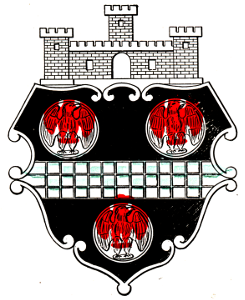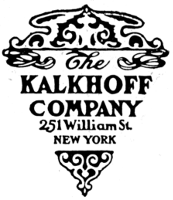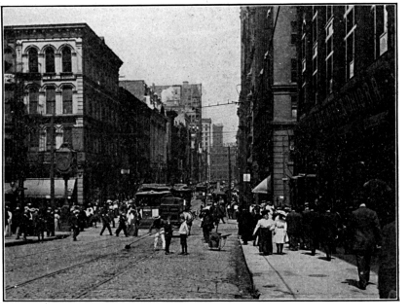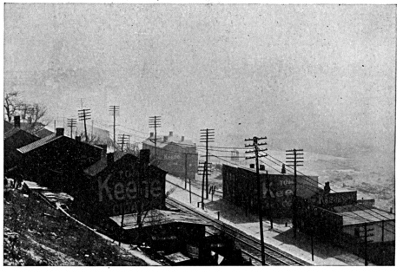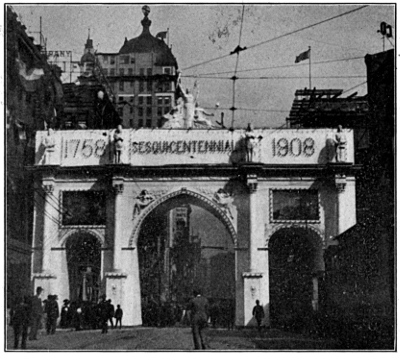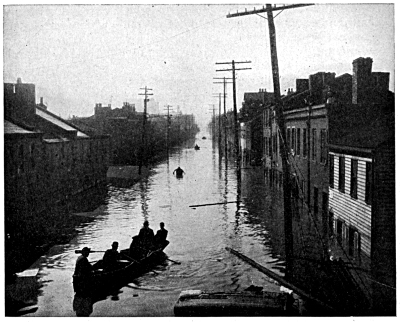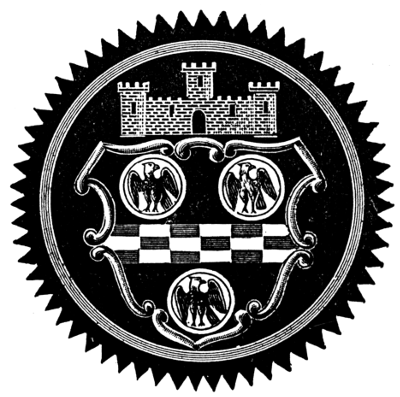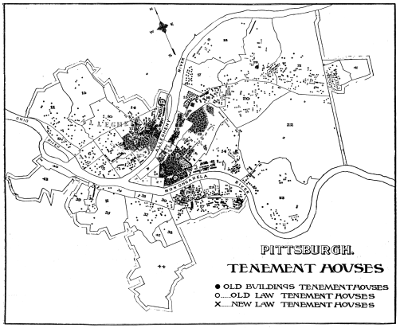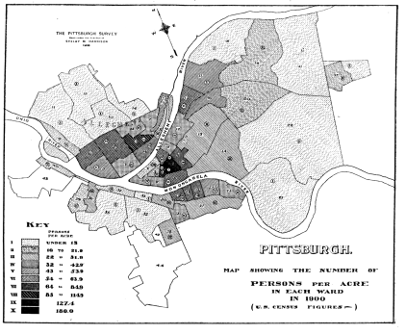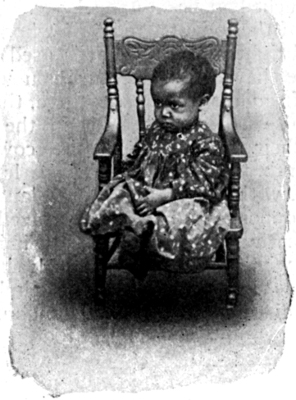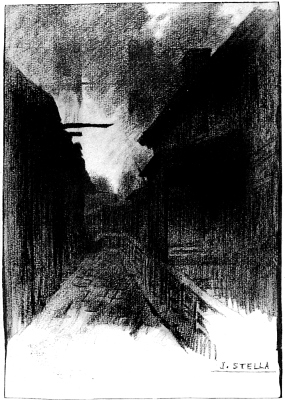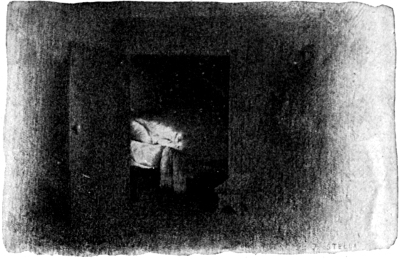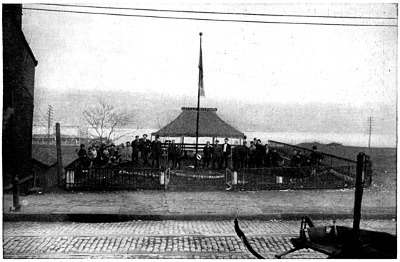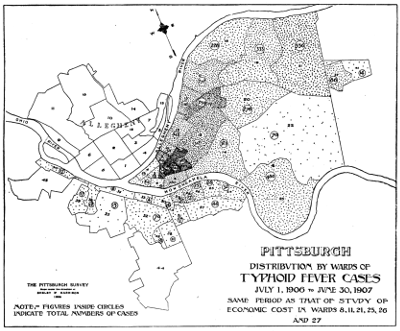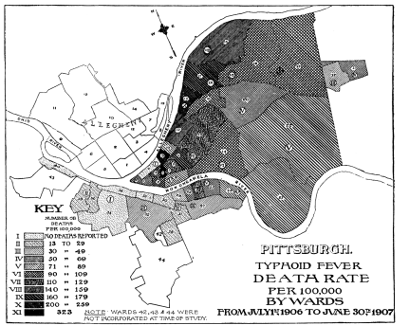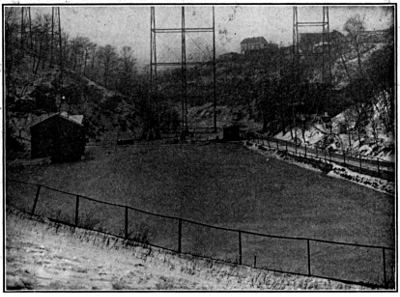The Project Gutenberg EBook of Charities and the Commons: The Pittsburgh
Survey, Part II: The Place, by Various
This eBook is for the use of anyone anywhere at no cost and with
almost no restrictions whatsoever. You may copy it, give it away or
re-use it under the terms of the Project Gutenberg License included
with this eBook or online at www.gutenberg.org/license
Title: Charities and the Commons: The Pittsburgh Survey, Part II: The Place
Author: Various
Release Date: June 18, 2014 [EBook #46025]
Language: English
Character set encoding: ISO-8859-1
*** START OF THIS PROJECT GUTENBERG EBOOK CHARITIES AND THE COMMONS ***
Produced by Richard Tonsing, Barbara Tozier, Bill Tozier
and the Online Distributed Proofreading Team at
http://www.pgdp.net
VOL. XXI FEBRUARY 6, 1909 NO. 19
CHARITIES
AND THE COMMONS
THE PITTSBURGH SURVEY
II. THE PLACE AND ITS SOCIAL FORCES
A JOURNAL OF CONSTRUCTIVE PHILANTHROPY
PUBLISHED BY
THE CHARITY ORGANIZATION SOCIETY OF THE CITY OF NEW YORK
Robert W. deForest, President; Otto T. Bannard,
Vice-President; J. P. Morgan, Treasurer; Edward T.
Devine, General Secretary
105 EAST TWENTY-SECOND STREET, NEW YORK 174 ADAMS STREET, CHICAGO
THIS ISSUE TWENTY-FIVE CENTS TWO DOLLARS A YEAR
ENTERED AT THE POST OFFICE, NEW YORK, AS SECOND CLASS MATTER
[Contents Added by Transcriber]
THE COMMON WELFARE
PITTSBURGH SURVEY
PITTSBURGH
A CITY COMING TO ITSELF
EFFECT OF FORESTS ON ECONOMIC CONDITIONS IN THE PITTSBURGH DISTRICT
THE TRANSIT SITUATION IN PITTSBURGH
THE ALDERMEN AND THEIR COURTS
THE CHARITIES OF PITTSBURGH
PITTSBURGH'S HOUSING LAWS
PAINTER'S ROW
PAINTER'S ROW
THE MILL TOWN COURTS AND THEIR LODGERS
THIRTY-FIVE YEARS OF TYPHOID
PITTSBURGH'S FOREGONE ASSET, THE PUBLIC HEALTH
|
{ 1646 }
Telephones { } Stuyvesant
{ 1647 }
Millard & Company
Stationers and Printers
12 East 16th Street
(Bet. Fifth Ave. & Union Square)
New York
ENGRAVING
LITHOGRAPHING
BLANK BOOK MAKING
CATALOG AND PAMPHLET WORK
AT REASONABLE PRICES
|
The....
Sheltering Arms
William R. Peters President
92 William Street
Herman C. Von Post Secretary
32 West 57th Street
Charles W. Maury Treasurer
504 West 129th Street
OBJECTS OF THE ASSOCIATION
"The Sheltering Arms" was opened October 6th, 1864, and
receives children between six and ten years of age, for whom no other
institution provides.
Children placed at "The Sheltering Arms" are not surrendered
to the Institution, but are held subject to the order of parents or
guardians.
The children attend the neighboring public school. The older boys and
girls are trained to household and other work.
Application for admission should be addressed to Miss
Richmond, at "The Sheltering Arms," 129th Street, corner
Amsterdam Avenue.
|
|
Wm. F. Fell Co.
PRINTERS
1220 Sansom Street
PHILADELPHIA
Book and Mercantile Printing
Specialists in Medical, Technical
and Educational Work
Illustrated Catalogues, Reports
and Booklets
Machine Composition, Electrotyping
and Binding
|
Trade Marks
have been used from time immemorial by manufacturers, emblems by
societies, seals by kings, artists and printers.
Their works are known to be excellent or poor. Their mark impresses the
quality on the mind.
The Kalkhoff Company
251 William Street, New York
Printers of the Inserts Herein
|
Please mention Charities and The Commons when writing to
advertisers.
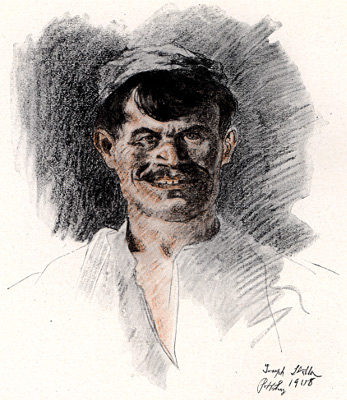
Drawn by Joseph Stella.
AS MEN SEE AMERICA. II.
THE SECOND OF THREE FRONTISPIECES.
Charities
AND The Commons
[Pg 769]
THE BILL FOR A CHILDREN'S BUREAU
An unusually well managed and effective hearing before the House of
Representatives committee on expenditures in the Interior Department
was held in Washington on January 27, following the White House
Conference on Dependent Children. No happier practical expression of
the unanimous conclusions of the conference could have been conceived
than this gathering of nearly all the conference leaders, representing
every section of the country and all shades of opinion in dealing with
childhood's problems.
Many persons listened to the unanimous plea that the federal government
should heed the cry of the child and espouse its cause at least to
the extent of providing a children's bureau manned by experts in such
questions as the causes and treatment of orphanage, illegitimacy,
juvenile delinquency, infant mortality, child labor, physical
degeneracy, accidents, and diseases of children, to whom those engaged
in dealing with these problems could direct inquiries for information
based on adequate and authoritative research. The gathering of such
information and its dissemination in bulletins easily understood by
the common people, the making available for all parts of the country
the results of the experience and suggestions of the most favored
parts and of any foreign experience in dealing with problems similar
to our own,—in short just such service as the government now renders
so cheerfully to the farmer though the scientific work of the bureaus
of its well equipped Department of Agriculture is all that the bill
for the children's bureau asks. Upon the question of the propriety,
constitutionality and expediency of the federal government doing this
work there was not and cannot well be a single objection made. For
the first year an appropriation of $51,820 is asked. As was carefully
pointed out by several speakers, much of the work to be done is
partially undertaken and could be done more adequately by existing
governmental agencies such as the Census Bureau whose work would not
be duplicated if we make it the sole business of some one bureau to
bring together in one place and focus on the problems of childhood
the information desired by child helping agencies and to find out
what is needed to stimulate greater efficiency in work for children.
No administrative powers or duties of inspection with respect to
children's institutions or work are proposed or intended to be given to
the federal children's bureau. Therefore only those whose deeds will[Pg 770]
not stand the light of publicity need fear the operations of the bureau
or expect anything but help and stimulus in the better performance of
their service to the public.
All these points were made with singular unanimity and earnestness by
many speakers who were heard by the committee and were seconded by the
still larger number who recorded their names and the societies they
represented as favoring the bureau. The judges of the leading juvenile
courts were present in person, including Judge Lindsey of Denver,
Judge Mack of Chicago, Judge DeLacy of Washington and Judge Feagin
of Montgomery, Ala. Herbert Parsons, who introduced the bill in the
House, and Secretary Lovejoy of the National Child Labor Committee,
which stands sponsor for the bill, conducted the hearing jointly. Miss
Lillian D. Wald, who originally suggested to the National Child Labor
Committee the advisability of such a bureau, made the opening address,
giving in substance the very clear and able argument for its creation
which she had presented the previous evening at the banquet of the
children's conference. She pointed out the universal demand for it in
the following language:
And not only have the twenty-five thousand clergymen and their
congregations shown their desire to participate in furthering
this bill, but organizations of many diverse kinds have assumed
a degree of sponsorship that indicates indisputably how
universal has been its call to enlightened mind and heart. The
national organizations of women's clubs, the consumers' leagues
throughout the country, college and school alumnæ associations,
societies for the promotion of special interests of children,
the various state child labor committees, representing in their
membership and executive committee education, labor, law,
medicine and business, have officially given endorsement. The
press, in literally every section of the country, has given
the measure serious editorial discussion and approval. Not one
dissenting voice has it been possible to discover.
THE NEED AND THE OPPORTUNITY
In speaking of the work which the bureau would do, we quote again from
Miss Wald:
The children's bureau would not merely collect and classify
information but it would be prepared to furnish to every
community in the land information that was needed, diffuse
knowledge that had come through expert study of facts valuable
to the child and to the community. Many extraordinarily
valuable methods have originated in America and have been
seized by communities other than our own as valuable social
discoveries. Other communities have had more or less haphazard
legislation and there is abundant evidence of the desire to
have judicial construction to harmonize and comprehend them.
As matters now are within the United States, many communities
are retarded or hampered by the lack of just such information
and knowledge, which, if the bureau existed, could be readily
available. Some communities within the United States have
been placed in most advantageous positions as regards their
children, because of the accident of the presence of public
spirited individuals in their midst who have grasped the
meaning of the nation's true relation to the children, and
have been responsible for the creation of a public sentiment
which makes high demands. But nowhere in the country does the
government as such, provide information concerning vitally
necessary measures for the children. Evils that are unknown or
that are underestimated have the best chance for undisturbed
existence and extension, and where light is most needed there
is still darkness. Ours is, for instance, the only great nation
which does not know how many children are born and how many die
in each year within its borders; still less do we know how many
die in infancy of preventable diseases; how many blind children
might have seen the light, for one-fourth of the totally blind
need not have been so had the science that has proved this been
made known in even the remotest sections of the country.
At least fifteen states and the District of Columbia were represented
at the hearing. Among the speakers were Edward T. Devine, editor of
Charities and The Commons, who pointed out the scope and
importance of the inquiries the bureau would undertake; Dr. Samuel
McCune Lindsay, who drew the bill for the national committee and
explained its fiscal features and the plan for the organization of the
work of the bureau; Jane Addams, who showed the real service the bureau
would render the practical worker; Florence Kelley, who pointed out
the extent of our present ignorance on the questions with which the
bureau would deal; Homer Folks, who emphasized the unanimous demand
for the bureau by the widely representative Conference on Dependent
Children; Congressman Bennett of New York, who[Pg 771] showed the service it
would render in dealing with the peculiar problems of the children of
immigrants; Bernard Flexner of Louisville, Hugh F. Fox of the State
Charities Aid Association of New Jersey, Judge Mack, Judge Lindsey,
and Judge Feagin, who all pointed out the service it would render
the courts in dealing with children; Mrs. Ellen Spencer Mussey, who
represented the General Federation of Women's Clubs; Thomas F. Walsh
of Denver, Dr. L. B. Bernstein of New York, William H. Baldwin of
Washington, D. C.; Secretary A. J. McKelway, and General Secretary Owen
R. Lovejoy of the National Child Labor Committee. The House committee
was deeply impressed and it is believed will report the bill favorably.
LOCAL PLAN FOR A CHILDREN'S BUREAU
Realizing that its 20,000 children between the ages of four and
fourteen are its chief asset,—that children are, in fact, as important
as its playgrounds or its streets or any of its other community
problems,—the city of Hartford, Conn., has taken steps towards the
appointment of a juvenile commission which shall relate the work of
schools and playgrounds and manual training and homes and give them
a balance and unity which come only from the consideration of such a
question as a whole. Each of these agencies has an influence on the
child for a part of its life, but each falls short of its possibilities
for lack of such a comprehensive oversight and continuity of purpose as
is promised by the commission.
The measure presented to the Legislature for the creation of a juvenile
commission is based upon the following arguments:
1. Industrial cities are producing a class of children whose
parents cannot, from the very nature of things, do much more
than supply them with food, clothing and a home.
2. The environment of these children, is such, both in the home
and in the neighborhood, that one-sixth die before they are a
year old and one-fourth before they are seven.
3. The parents cannot as individuals provide playgrounds or
adequate discipline.
4. Every child has a right to a reasonable opportunity for
life, health and advantages needed for development.
5. To protect the child's right to a reasonable chance for
healthy development is a special work which should be done by
a commission created for the purpose to supplement the work of
parent and school.
The suggestion for the commission came from George A. Parker,
commissioner of parks, Hartford, and grew out of a meeting of the
Consumers' League, followed by a talk by Dr. Hastings H. Hart. Mr.
Parker's idea met with immediate endorsement from many sources and as a
result the bill now before the Connecticut Legislature has influential
and widespread support.
It is proposed that the Court of Common Council shall refer to the
commission all questions relating to minors and await its report before
taking final action. The commission is to have power to investigate all
questions relating to the welfare of children, to collect and compile
statistics and to recommend legislation. None of its actions is to be
taken in a way to lessen the parents' responsibility and no child is to
be taken from its parent except in extreme cases of danger to life or
limb. The commission as proposed will consist in part of city officials
and in part of citizens who do not hold public office, the members to
serve three years each without salary, but the expenses to be borne by
the city.
EDUCATION AND THE PREVENTION OF DISEASE
The past few years have witnessed an advance in the evolution of
medicine which has been radical and comprehensive.
It was only a decade ago that the efforts of centuries devoted to
empirical treatment of the individual found room for research into the
causes of disease; and it has only been within recent years that such
knowledge has been sufficiently comprehensive to justify its extensive
application in the practical field of disease suppression.
The attempt which Columbia University is making to establish a School
of Sanitary Science and Public Health is prompted by the realization of
the fact that most diseases are preventable with[Pg 772] our present knowledge
of their causes; that the knowledge which we now possess in regard to
their causes is not properly and extensively enough applied for their
prevention; and that this knowledge is best transmitted to the people
by means of educational methods.
Probably the most recent advance in the doctrine of preventive medicine
is due to the fact that many diseases are recognized to have not only
medical, but social and moral causes as well; and that their prevention
is best accomplished by the enlistment of judicious co-operation of
effort in these various fields. For example, a large part of the
disease of the human race is directly traceable to the damaging effects
of alcohol and syphilis, yet these diseases cannot be eradicated until
the underlying social and moral factors are recognized and remedied.
It is not difficult to appreciate the wonderful results which are
capable of accomplishment, with our present scientific knowledge, by
the conjoined application of scientific and social with educational
methods, when we realize that smallpox could be wiped out by education
of the masses on the efficacy of vaccination. The fields of preventable
accidents, dangerous trades, child labor and improvement of working
conditions offer opportunities for the reduction of suffering which are
great almost beyond conception. Blindness could be diminished one-half
by the spread of a simple, well known doctrine; typhoid, cholera,
malaria and yellow fever depart as enlightenment on principles of
sanitary administration creep in, and tuberculosis has resolved itself
largely into a "social" disease.
The problem resolves itself distinctly and emphatically into one of
education; and it is to instruct the teachers of the people in methods
of health preservation,—be they officers of health, with the care of
thousands, or mothers with the care of one, in their keeping,—that
Columbia University is striving to put its school into operation.
Pending such a beginning, a series of university lectures on Sanitary
Science and Public Health by the most eminent authorities of the
country is being given to prepare the way for the next much desired
move,—a permanent, fully-endowed institution of instruction in the
principles of public health preservation and the prevention of disease.
Courses of a similar nature have been organized at Cornell, Wisconsin
and Illinois universities.
The subjects, to be discussed by experts, include water supply and
sewage disposal, health and death rates in cities, public health
problems of municipalities, state and nation, milk supply and infant
mortality, school hygiene, street cleaning, tenement house sanitation,
personal and industrial hygiene and diseases of animals transmissible
to man. The course, which was started on February 1 with a lecture by
Professor Sedgwick of the Massachusetts Institute of Technology on The
Rise and Significance of the Public Health Movement, will be continued
until April 28. The lectures will be open to the public up to the
capacity of the hall.
CLEANING UP THE KANSAS PENITENTIARY
The newspapers of January 31 contained a dispatch describing an unusual
special train that left Lansing, Kansas, bound for McAlester, Vinita
and Atoka, Oklahoma. The 344 passengers, sixteen of them women, were
handcuffed together in pairs and groups and as the train pulled out of
the station, the dispatch states that "a great cheer arose from the
convicts as they saw the last of the state penitentiary."
This special train was carrying away the "boarded out" convicts whom
Oklahoma has been shipping to Kansas since the establishment of its
territorial government. Criminals were aplenty in the old frontier
days and the contract with Kansas was highly agreeable to the settlers
who were glad to free Oklahoma of its "bad men." The territory paid
the state forty cents a day for the maintenance of each convict kept
in the Lansing penitentiary and adding to this the amount that the
prisoners earned, Kansas received about forty-eight cents a day for[Pg 773]
each Oklahoma prisoner. The cost of food was about ten cents a day each.
From time to time stories drifted across the border about the treatment
of prisoners, but not until last year when the territory became a state
and when Kate Barnard became its first commissioner of charities, was
anything done toward cleaning things up in Kansas. In August the new
commissioner went to Lansing as a private citizen of Guthrie, Oklahoma,
and inspected the prison with other visitors. Then she presented her
official card and after considerable protest was allowed to inspect the
jail as commissioner of charities of Oklahoma and the newest state in
the Union proceeded to show her forty-eight-year-old sister what was
going on in the Kansas penitentiary.
Miss Barnard found 562 men and thirteen women prisoners from Oklahoma.
She spent a day crawling through the coal mines where the "props
and supports of the roof were bent low under the weight of the dirt
ceiling." She found that every prisoner who is put to work in the mines
must dig three cars of coal a day or be punished for idleness. Three
cars of coal a day is a good day's work for a strong man. Miss Barnard
found seventeen-year-old boys who were unable to do their "stunt," as
they called it, chained to the walls of their dark cells. She found
"one Oklahoma boy shackled up to the iron wall of the dungeon. The lad
was pale-faced, slender, boyish, and frail in appearance. I said: 'What
are you doing here? Why don't you mind the authorities?' He answered:
'I don't know much about digging coal. I work as hard as I can; but
sometimes the coal is so hard, or there is a cave-in, and it takes time
to build up the walls, and then I just can't get the three cars of
coal. I got over two cars the day they threw me in here.'"
The coal that is taken from the prison mines is used to supply the
Kansas institutions, it is said. About 1,500 tons are mined a day. As
there are some dozen institutions to be supplied, this makes over 100
tons a day for each of the state institutions.
In the prison twine factories the contractors are allowed to say just
how much shall constitute a day's work, and as all men are not equally
skillful, the inferior prisoner is pushed to the limit by fear of
punishment, while the more capable ones fare much better.
Miss Barnard found that the "water cure" is in regular use; that the
"water hole," "where they throw us in and pump water on us" is in
operation; that the "crib" where refractory prisoners are kept with
hands and feet shackled and drawn together at the back, was doing
active service. She found unprintable immoralities existing in some
parts of the mines and she found that since August, 1905, sixty boys
from Oklahoma have been imprisoned with the men in the Lansing prison.
Miss Barnard's report seemed incredible to Governor Haskell. He sent
another investigator who came back to Guthrie with new stories of the
Lansing prison to add to Miss Barnard's.
And then the governor appointed a commission to make a thorough
investigation of the institution and ex-Governor Hoch named a Kansas
commission to co-operate. The latter body made its investigation before
the Oklahoma delegation arrived. It made eighteen recommendations
changing the whole prison management, but declared Miss Barnard's
report true "only in minor details." The Oklahoma commission found that
her report was true to fact and that the Lansing prison was not fit for
a murderer, much less for a sixteen-year-old boy.
There is no state penitentiary in Oklahoma and the prisoners must
be kept in the county jails for the present. This is another strong
argument for the passage of the bill now before the Oklahoma
Legislature for the establishment of a reformatory. It may be possible
to arrange with the Department of Justice to transfer the prisoners to
the United States Penitentiary at Leavenworth.
KOWALIGA SCHOOL DESTROYED BY FIRE
On the afternoon of January 30, the Kowaliga School for Negroes,
located in the high pine lands of Elmore county, Alabama, was destroyed
by fire.[Pg 774] Only two buildings remain of that unique industrial
settlement which has been successfully working among the Negroes of
the surrounding community for thirteen years. The school was started
by William E. Benson, a son of a former slave who had returned to
the Alabama plantation after the war and become one of the South's
most successful Negro farmers. Young Benson was graduated from Howard
University and returning to his father's plantation saw the real
need for a good school for the Negro children of the community. From
Patron's Hall, built by the combined efforts of "the neighbors,"
Kowaliga School was started.
When the five buildings were burned there were 280 pupils and twelve
teachers in attendance. The loss will be about $20,000 with practically
no insurance owing to the extreme difficulty that Negroes always
experience in the South in getting their property covered against loss.
The Kowaliga School is distinct in the service it is rendering to the
community. Its aim is not to train skilled workmen or highly educated
leaders, but rather to properly fit the Negro boys and girls of the
community to live better in that community. The "book work" is carried
as far as the eighth grade. The boys are taught agriculture and manual
training and the girls are trained in the home life which they will
probably take up on leaving school. As the school grew, Mr. Benson
felt that it was not enough to train these boys and girls without
giving them some opportunity to put their training to practical use.
Consequently in 1900 the Dixie Industrial Company was founded "to
improve the economic condition and social environment of the farm
tenants of the South by establishing seasonal industries and furnishing
them with steady employment the year round; to build better homes and
help them to avoid the oppressions of the old system of mortgaging
crops." The company now owns about 10,000 acres of farm and timber
lands, operates a saw-mill, a turpentine still, cotton ginnery,
cotton-seed and fertilizer mill, a store and forty farms, affording
homes and employment for 300 people. It has a paid-up capital of
$66,000, a surplus of $12,000, is earning eight per cent annually, and
paying four per cent annual dividends.
The industrial company provides work the year round for the rural
population and thus fills in the time of the seasonal workers who
before were busy only about half the year.
The fire will not directly affect the Dixie Industrial Company. It will
temporarily cripple the school and until funds are forthcoming that
work must be discontinued. "It means beginning all over again after
thirteen years' work," said Mr. Benson, who was in New York at the time
of the fire; "but I am going back this week and make another start."
REVISING CHICAGO'S CIVIL SERVICE SYSTEM
A complete revision of the civil service system for Chicago is promised
by Elton Lower, president of the City Civil Service Commission. After
eight years' connection with the city departments the commissioner
devoted himself for over a year mainly to studying the working of the
civil service in Boston, New York, Washington and Chicago and to the
examination of the promotional methods used by railway, manufacturing
and other corporations. Securing requisite support from the city
administration, he now announces a complete reversal of the form and
revision of the rules under which the merit system has been operated in
the city.
The distinctive features of the new plan are grading by duties,
descriptive titles, defining the duties of the grades, uniformity of
compensation within each grade, advancement from grade to grade only by
competitive examination, and a greater degree of unity and independence
in the departmental administration of efficiency tests and promotional
procedure within its own bounds. Examinations in all departments and
grades are to subordinate scholastic to practical tests, and to give
greater importance to physical conditions and the investigation of
character in order to meet the requirements of service, rather than
require knowledge of facts. It is hoped to raise the standard of
efficiency and promotion by taking[Pg 775] the tests in each department from
its own system of keeping records and accounts. As the departments
will be held individually responsible for the way they keep these, the
inevitable comparison and contrasts between them will tend to level
their standards up to the highest.
Salaries may be raised only for an entire rank and not for individuals
within the rank. Provision for grouping employes within the grades is
made on the basis of efficiency, seniority or time required by service.
The passing mark will be the only test of physical fitness. A similar
flat-grading is proposed for work requiring skill and experience.
Testing the applicant's qualifications in these respects, as is done
for New York and Boston by the trade schools, is preferred for Chicago.
A free transfer permits employes to pass from one department to another
for promotional examinations, the original entrance examination thus
giving a city employe a slight advantage over outsiders in competing
for grades. Identification tests include finger prints.
The civil service commission began to institute these features
among the employes of its own office some time ago. It first
secured proper quarters and modern sanitary facilities, and then
began training employes for its own work for which experienced
applicants were lacking. Mr. Lower maintains that if such a system is
firmly established and built up it will be likely to withstand lax
administration because "it will take as much study and thought to tear
it down as to construct it." Whatever wrong things may be introduced
into it, he thinks, "will make conditions no worse than they have been
under the system that has hitherto prevailed."
The Chicago Public Library will profit as much by the re-classification
of its force and by this scheme of promotion as any other city
administration, since its work has suffered more for the lack of
finer tests of efficiency within more specialized grades, and also
from being under the same regulations as other departments with whose
requirements its service has little or nothing in common. To have a
civil, self-regulating service system virtually its own, will free its
directors, the librarian and his staff for that initiative which will
give to this fourth largest library in the United States the leadership
which may be rightly demanded for it.
ANOTHER ATTEMPT FOR A NEW CHICAGO CHARTER
The Chicago Charter Convention reassembled last week at its own
initiative to renew its attempt to prepare a city charter that the
Legislature will adopt and the people will accept at the polls. Its
first laborious effort was so ruthlessly made over by the contending
party factions in the Legislature two years ago that the measure suited
no one. Many members of the convention repudiated it and the people
overwhelmingly rejected it at the polls. To conserve their hard and
fundamental work, the convention ventured to reassemble last autumn and
appointed a committee to revise its own bill in the light of its fate
at the capitol and the polls. In so doing the amendments made by the
Legislature have been carefully considered and most of them eliminated.
The measure thus nearly restored to its original form has been changed
to conform to suggestions prompted by the criticisms and discussions
through which the bill and act passed. This revision is now to come
before the convention which faces many interesting and strenuously
contested issues. Among them are the limiting of the city's bonded
indebtedness to four per cent, the assumption by the city of ten per
cent more of the cost of public improvements, municipal suffrage for
women, stringent provisions against corrupt practices, the retention
of the party circle on the ballot, the local regulation of the liquor
traffic and the Sunday closing of saloons, the centralizing of school
management, and the consolidation of four park boards.
Preliminary to all these issues the question is to be decided whether
the convention will supersede itself by proposing to the Legislature
either to authorize the election of a new charter commission by the
people, or to call a constitutional convention. These proposals are
not likely to interfere with[Pg 776] the procedure of the present convention
to complete its own charter bill. Notwithstanding the fierce factional
fight that now absorbs the energies of the Legislature so that it has
not yet attempted to attend to public business, one of the prominent
members of the House of Representatives assured the convention that
if it agreed upon a measure and rallied to its support the public
sentiment of Chicago, it would be enacted and referred to the
referendum vote of the people.
THE SCIENCE OF BETTER BIRTH
The scientific foundations for the slowly rising science of "eugenics"
grow apace in the research laboratories of our universities. Some of
their most authoritative representatives demonstrated this fact at
the recent joint meeting of the Physicians' Club of Chicago and the
Chicago Medical Society. In strictly scientific spirit and phrase, with
interesting stereopticon illustrations of their biological experiments,
four professors brought their facts to bear upon the doctors for their
inferences as to the analogy between the heredity in animal and plant
life, and the development of human kind. Two professors of zoology,
Dr. Castle of Harvard and Dr. Tower of the University of Chicago gave
respectively "an experimental study of heredity," and "experiments
and observations on the modification and the control of inheritance."
A beautiful parallel was presented by Dr. Gates, professor of botany
at the University of Chicago, in studies of inheritance in the
evening primrose. Dean Davenport of the College of Agriculture at the
University of Illinois ventured the most direct application of the
suggestions from scientific experimentations to the propagation of the
human race. Drawing the lessons to be learned from the breeding of
animals, he said that the question preliminary to any consideration
of the subject is "whether the end of our breeding is to be the
production of a few superior individuals, or the general elevation of
the race. If it is the first, we must proceed as in the breeding of
thoroughbred race horses; if it is the second, as in the production of
good fat stock for the farm." Preferential mating, he thinks, produces
in the long run, persons of exceptional talent. "Like mates with
like, and people with exceptional ability in any line are naturally
thrown together by their common tastes and thus uniting bring forth
phenomenal individuals in all lines." The solution of the problem of
the deterioration of the stock lies, he thinks, not so much in stricter
marriage laws, as in the absolute prevention of reproduction among "the
culls, human as well as animal." To colonize other classes of the unfit
as strictly as we do the insane is the only way he sees of doing this.
"Let a man be taken into court and his ancestor record investigated.
If we find his parents were dominantly bad, it means that he is fifty
per cent bad. If his grand parents were also bad, he is twenty-five
per cent more bad. When he gets to ninety per cent bad, it is certain
that he must be colonized. There is a strict mathematical law that runs
through it all."
Whatever may be thought of such definite suggestions, it is too true
as the secretary of the Physicians' Club affirms, that "man is at a
distinct disadvantage when compared with domestic animals in being
denied 'good' breeding. He is the child of chance and so to speak is
born, not bred." Surely, however slowly, the science of improving the
propagation of the human race will receive its recognition as having
place among the hierarchy of the sciences and will be practically
applied by those who respect themselves and have any regard for their
posterity.
CONFERENCE ON DENTAL HYGIENE
The Conference on Oral and Dental Hygiene held in Boston recently
brought out, perhaps more than anything else, the relation between, the
physical condition of the teeth and the general health of the body,
and the great necessity for lay intelligence in the matter. Prof.
Irving Fisher of Yale, the opening speaker, dwelt on these points,
and declared that civilized man tries to avoid mastication by the use
of pulverized,[Pg 777] liquified and pappified foods; that civilization has
brought about a pressure of time with the result that we eat by the
quick lunch counter and the clock, whereas the animal eats his meal in
peace; that we eat too fast, to the injury of our teeth, as shown by
the fact that those who do masticate food thoroughly have better teeth;
and that experience shows thorough mastication results in better health
and greater efficiency. Prof. Timothy Leary of Tufts College said
that proper mastication does away with an important source of supply
of putrefactive bacteria, and eliminates conditions favoring gastric
cancer.
Dr. Samuel A. Hopkins believes that the solution of many of the
difficulties lies in seeking out the educators and in working through
them and through the various settlements and the workers in public and
charitable institutions. Of particular importance are all those who
work with children. William H. Allen of New York lays to the ignorance
and the indifference and the carelessness of the public a great many of
the difficulties. He believes that
if hospitals ever refuse to give bed treatment for twelve
weeks to a man suffering from jaw trouble when the dentist
could give "ambulant" treatment while the man supports himself
and his family; if physicians ever stop spending time, money,
medicine and hospital space on tubercular patients who reinfect
themselves whenever food, medicine or saliva pass over their
diseased teeth and gums; if dentists are ever generally added
to the attending, visiting and consulting staffs of hospitals;
if education of dentists for profit ever gives way to education
for health and training; if the dental profession is ever
given the rank with other specialties and society given the
corresponding protection, it will be because laymen intervene.
Dr. Horace Fletcher declared that it is definitely known that the flow
of gastric juices is started in the stomach by psychic stimuli. If the
food is taken without enjoyment the juices are not secreted and the
food remains undigested. "Any dispute at the table, an angry word, a
discussion over a bill, or a sharp retort, are sufficient to stop this
digestive process," he said.
Dr. David D. Scannell of the Boston School Committee made the startling
statement that fully seventy-five per cent of Boston school children
have dental disease, which means that there are about 75,000 school
children in Boston needing attention. Dr. Scannell bases his statement
upon investigations made in Brookline, New York, and through the
district nursing associations. Dr. Scannell said that the present
dental work in schools is done with good intention but it is sporadic.
Money should be set aside for examination and treatment of all school
children, conducted through an out-patient dental department on the
same basis as the eye and ear departments of free treatment.
Dr. Walter B. Cannon of the Harvard Medical School showed the dangers
lurking in school drinking cups. His statements were supplemented in
the exhibit provided by the Dental Hygiene Council of Massachusetts
by pictures showing a filthy vagrant using a public drinking cup,
immediately followed by a mother who gave her little girl a drink from
the same cup.
The exhibit is the only one in existence in this country. It was taken
in part from the tuberculosis exhibit, but has been greatly increased
and supplemented by an exhibit from Strasbourg.
In the closing session, President Eliot of Harvard pointed out
the relation between defective physical conditions and defective
government. "The bad physical condition of our people is due largely
to the unhealthy conditions under which the men do their ordinary
work and the women pursue their domestic employments. To improve the
public health we must have better regulations and laws. We cannot
create and improve the public playgrounds which are open air parlors
without honest and efficient city and town government," he said. Dr.
Eliot thinks that the medical profession is the most altruistic of all
occupations, with the possible exception of the ministry.
INSURANCE AND BUILDING LOANS
One of the defects of the building and loan societies, long recognized
in some quarters, has been the probable loss of the[Pg 778] home to the family
of the member who dies before payment has been completed. At the time
when the widow most needs the home for her children, the payments
cannot be met and the association is reluctantly obliged to foreclose
the mortgage.
A plan to meet this situation, frequent in the aggregate, has been
devised and practised in New England, by requiring the borrower to take
out an insurance policy on the least expensive straight-life plan,
to an amount equal to the mortgage. The insurance premium is payable
monthly with the payment on the loan, the association turning it over
to the insurance company, and undertaking to adjust the payments if
the latter's premium periods do not coincide. The face of the policy
is made payable to the loan association which, in case of death, takes
from the insurance money the amount remaining unpaid on the mortgage,
and gives the widow the balance with a deed for an unencumbered home.
In the great majority of cases where the borrower lives to complete
his payments, the policy is surrendered to him when his mortgage is
cancelled, to be continued or dropped as he pleases.
The plan was described at the annual banquet of the Metropolitan League
of Co-operative Savings and Loan Associations, New York, by J. Q. A.
Brackett, former governor of Massachusetts, who is urging it on a
national scale as a necessary adjunct to what, in his native state, is
termed the co-operative bank.
More than two hundred men attended the banquet, representing
ninety-five constituent companies with 35,129 depositors, and
controlling assets of sixteen million dollars. One who attended
could not fail to be impressed with the evident feeling of these men
that their paramount duty is not to make money for their particular
organizations, but to help the average member buy a home. Ninety per
cent of them are unsalaried. One association, it was reported, has
reduced its interest rate without request of its borrowers. In the
words of the president, the main desire of building loan associations
should be "the encouragement of the habit of saving without irritating
penalties and restrictions and with equitable provision for the mishaps
possible to those undertaking a contract for specific saving extending
over a long period of years."
THE SIGHTLESS AND THEIR WORK
The wonderful gains made by the blind in overcoming their heavy
handicap was brought strikingly to public attention at the second
annual sale and exhibition of the New York Association for the
Blind. Women were at work on small hand looms, on linen looms, and
on carpet-weaving looms. A blind girl operated a power machine.
Stenographers sat at their work, fingering ordinary typewriters, and
transcribing notes from phonographic dictation. There were all the
usual, simpler displays of chair caning, basket weaving and broom
making and there was music, both vocal and instrumental. The guests
were told interesting stories of many of the workers. One was of a
man who applied to the association for help when first stricken blind
and most despondent, thinking that all avenues of usefulness had been
closed to him. As a result of the instruction given to him, he is now
able to earn a good salary and to support his family.
The work of the association has so increased during the past year,
that besides the building on Fifty-ninth street and the workshop on
Forty-second street, the special committee for the prevention of
blindness has an office in the Kennedy Building at 289 Fourth avenue.
In co-operation with the State Department of Health the committee is
working particularly toward the prevention of ophthalmia neonatorum.
Following are the members of the committee: P. Tecumseh Sherman,
chairman, Dr. Eugene H. Porter, Dr. Thomas Darlington, Dr. F. Park
Lewis, Dr. J. Clifton Edgar, Thomas M. Mulry, Dr. John I. Middleton,
Miss Louisa L. Schuyler, Mrs. William B. Rice, Mrs. Edward R. Hewitt,
Miss Winifred Holt, Miss Lillian D. Wald and George A. Hubbell,
executive secretary.
[Pg 779]
BERLIN'S SCHOOL OF PHILANTHROPY
Europe, and especially Germany, follow very closely every new
experiment along social lines, undertaken by American cities or
individuals. One imitation of American methods was the establishment of
separate courts for children, though neither detention homes nor the
splendidly equipped schools for delinquent boys and girls, which the
most progressive states of the Union have, are found in Germany. The
state governments in most cases do not take the initiative; private
citizens study the question and urge the necessity for a change, until
public opinion, thoroughly aroused comes out so strongly in favor of
a new measure, that the authorities are forced to yield. In October,
1908, a social school for women opened its doors in Berlin with the
help of different societies and in co-operation with private citizens,
of whom Dr. Munsterberg is the best known to the readers of this
magazine. A close study of the methods of the New York and Chicago
Schools of Philanthropy had been made and some of their features
successfully copied. The aim of the school is to give German women new
chances for service whether they wish to devote some of their time as
volunteers or desire to become paid officers of philanthropic agencies.
Field practice will show how the same problems, which confront social
workers, repeat themselves only in a smaller way in the families and
individual. To the training in both theory and practice two years are
devoted. The theoretical work in pedagogy, social questions, economics
and domestic science, is supplemented in the first year by kindergarten
and day nursery work, and in the second year by a special training
gained through working at different social agencies, like the Bureau of
Charity, juvenile court committees, relief and aid societies. All these
agencies hope to get a staff of experienced helpers and workers through
their co-operation with the school. The state's schools, through which
the girls have to pass prior to their admission, have very little of
the modern spirit. In contrast too with the great variety of courses
in the state lyzeums, the courses are restricted in number and
carefully selected. They are however most appropriate for women, since
they present not only a picture of the development of modern society,
but emphasize particularly woman's position.
The director, Dr. Alice Salomon, is one of the most able and
conservative leaders of German women. There is a good attendance at the
new school.
THE RUDOWITZ CASE
GRAHAM TAYLOR
The decision of Secretary Root to deny the demand of the Russian
government for the extradition of Christian Rudowitz is a great relief
to all true Americans, and thousands of their foreign born fellow
citizens all over the land. The right of asylum for political refugees
was at stake in the case of this Lutheran Protestant peasant. The
extradition was demanded on the ground that he had been identified
as one of a band of twelve or fifteen marauders who were guilty of
three homicides, arson and robbery in the village of Beren, Courland,
in January, 1906. The defendant denied the charges of personal
participation in the alleged crimes and submitted proof that Courland
was then in a state of temporarily successful insurrection, and that
the killing was ordered by the revolutionary party then in control, as
an execution of spies who had betrayed many of their own people into
the hands of the military authorities by whom they were summarily shot.
The evidence upon which the whole case hinged was in the form of
depositions taken in Russia and submitted by the government to the
United States commissioner at Chicago. So well grounded were the
suspicions with which it was regarded, that the whole record of the
testimony was submitted to John H. Wigmore, dean of the Northwestern
University Law School, one of the highest legal authorities in America,
and author of one of the principal American text books on evidence.
His careful analysis of the voluminous record[Pg 780] in the case led him
to conclude that while Rudowitz was a member of the revolutionary
committee and voted for the execution of the spies, the evidence
identifying him as one of the party charged with the killing "is too
slight to be of any value"; that "there is no evidence of marauding
or neighborhood feuds or common depredation on the part of this or
any other band in any part of the evidence for the prosecution"; that
there is conclusive evidence of a temporarily successful revolution
"giving the military forces of the national government under their
system certain rights of summary execution, and correspondingly giving
such rights to the revolutionists, so as to fix upon their acts of
summary force, if duly authorized by their officers, as revolutionary
acts of force." These facts justified Dean Wigmore in concluding that
"the killing was a purely political act, the arson was also ordered
politically, being a customary incident similar to the existing
government's own punitive practice in such cases."
The suspicions based upon such facts in this and other cases, aroused
the American spirit against the apparent attempt of the Russian
government to secure the extradition of many political refugees on
poorly substantiated charges of being common criminals. Hundreds of men
and women faced the possibility of being forced to change their names
and hide themselves. Great mass meetings were held in the principal
cities to protest not only against the extradition of Rudowitz, but
against the continuation of the present treaty with Russia under which
it was asked. Conservative citizens, to the American manor born, such
as President Cyrus Northrup of the University of Minnesota, W. H.
Huestis of Minneapolis, Charles Cheney Hyde, professor of International
Law at Northwestern University, Councillor W. J. Calhoun of Chicago,
joined their protests with those of recently arrived refugees and such
friends of theirs as Jane Addams, Jenkin Lloyd Jones and Dr. Emil G.
Hirsch. But beneath the value set upon this popular agitation for the
defense of the right of asylum in America, was the confidence that
there was good law under the case for Rudowitz, which would surely
determine the decision of so good a lawyer as the secretary of state.
Now that this confidence has been confirmed, the question is being
validly raised by the press whether the qualifications exacted of
those appointed to United States commissionerships are as high as
was originally demanded for the delicate and difficult duties of
that office. It is pointed out that when in 1793 Congress first
authorized such appointments by the circuit courts, it defined the
qualifications of those eligible as "discreet persons, learned in the
law." Later acts, however, dropped the requirement that they should
be "learned in the law" and continued the reference to "discreet
persons." In substituting "United States commissioners" appointed by
the district courts for the commissioners of the circuit courts in
1896, Congress provided only that no United States marshal, bailiff
or janitor of a building, or certain other federal employes should
hold the office. Some of the most eminent lawyers, who publicly joined
in protesting against the extradition of Rudowitz, took occasion to
criticise the appointment to this office of men not trained in the
law, and inexperienced in the sifting of evidence, whose decisions,
involving the liberty and life of men, must be based entirely upon the
knowledge of the laws of evidence. Certainly this case should lead
either to stricter definition of the qualifications for United States
commissionerships or to far greater care in the appointments to that
important office. Moreover, the injustice of putting upon a political
refugee the burden of proof that he is such has been made manifest in
this case. For to do so Rudowitz would have been compelled not only to
bring his evidence from Russia, but also to expose to certain death
those whom he would have been compelled to name as his compatriots in
the struggle for liberty.
[Pg 781]
SAVINGS BANK LEGISLATION:
WHAT IS NEEDED?
JAMES H. HAMILTON[1]
Headworker of the University Settlement
"Everything speaks for and nothing against the post office savings
bank," writes Professor J. Conrad of the University of Halle. This is
strong testimony from a German economist who is a careful student in
the field of social economics, and who lives in a country which has a
splendid system of municipal savings banks. But if one looks beyond
Prussia and Saxony into the province of Posen he sees great stretches
of neglected territory. And in this country if one looks beyond
Massachusetts, with its much praised trustee savings system, into New
York and Pennsylvania he sees much to be desired,—and if he looks
still further west he finds a sadder neglect than the neglect of free
popular education in darkest Russia.
If we fully comprehend the fact that the savings bank is an
educational, and not a commercial institution we will see at once that
the law of supply and demand cannot properly regulate its growth. We
will see on the contrary that if left to local initiative by either
municipalities or trustees, the banks will likely appear where they are
least needed and fail to appear where they are most needed, and the
need of a general federal system, or a postal system, which will leave
no neglected spots becomes perfectly clear. "Everything speaks for the
post office savings bank."
Postmaster General Meyer, in his article in the August number of the
North American Review, presents this country's need of a postal
savings system in a very attractive and convincing way. I think,
however, that the educational aspects merit more emphasis and more
extended treatment. The public, I think, needs to recognize this
institution not alone as the often successful rival of the saloon,
the enemy of dissipating and destructive spending, but it needs also
to recognize its relationship to the strong type of citizen, with
resisting power against the petty immediate wants in the interest of
greater economic security, the type that can save against the rainy
day, the week of sickness, and the declining powers of the later years
of life.
In my own judgment the highest function of the savings bank is to
lead the workman back to the ownership of his tools, or since that is
not literally possible, to a share in the ownership of the productive
forces of society. The workman may not recognize in the share of stock,
the bond, the equity in a title to real estate, the successor to the
tools his forefather kept stored in his cottage. When he has been
brought to see it and to make such ownership the goal of his ambition,
his tribute of devotion to his wife and children, he will be a stronger
and a better man in every respect, and the multiplication of this kind
of citizen is as worthy an object of education as the spread of a
rudimentary knowledge of letters. Universal proprietorship is no less
desirable, from the social point of view, than universal education. The
purpose of the savings bank is therefore not so much to instill the
idea of hoarding for future spending, but of investing to increase the
permanent income.
Having this in mind the provision of the English postal savings system
for investing in government stocks for the depositor on his request is
fully warranted, and even more so the French provision for investment
of the excess of deposits over the legal maximum in government stocks
without request. The deposit account itself represents investment,—by
trustees on behalf of the depositors. But the depositor should
eventually become a conscious owner on his own account. It would seem
most proper that he be supplied with information which would enable him
to form an independent judgment as to different securities, and the
savings bank might very well act for him in making his first investment.
The one departure from precedent in Mr. Meyer's bill is in the
investment of funds. It contemplates a system of loans to the local
banks with a view to "keeping the money at home." The departure from
the practice of investing in government securities may be good for
the object[Pg 782] intended, which relates to the incidents rather than the
primary object of savings bank administration. It seems to me most
unfortunate that Mr. Meyer should have selected a form of investment
that would tend to defeat the primary object of savings banks in
the necessarily low rate of interest. I think he must fail to fully
realize that the savings bank is to educate the propertyless to become
proprietors, to appreciate the need of supplementing the earnings
of labor by income from accumulated capital, and not to serve as a
mere place for hoarding. It is the interest rate that tickles this
dormant sense into life. It seems to me a pity that he did not see in
the example of the municipal savings banks in Germany and of our own
trustee banks, which invest chiefly in real estate mortgages, a way
of reaching the one object without injury to the other. This would be
a departure from the general practice of postal savings systems which
would at once "keep the money at home," and insure a higher rate of
interest than the yield of government securities. Money thus invested
would get back into the channels of trade as readily as if it were
loaned to the local banks, and with much less objection, and the rate
of interest would probably be about double. The yield should be four
per cent against the two per cent proposed by the postmaster general's
measure.
It is certainly most refreshing and encouraging to listen to the
promise of legislation that extends its benefits immediately to the
common people, which contains the hope of more social solidarity. A
comparison of our policies with those of old world countries in this
respect is not comforting to our patriotic pride. It seems time that we
were less laggard and that we should have more courage to experiment.
The promise made by all political parties of a postal savings bank
is probably the most encouraging sign we have had. It would be much
more encouraging if the measure that is promised contained more of
the results of bold experiment in other countries and contained
more of an original and experimental nature that promises a more
pronounced application of the true principle of savings banks, and
that fosters a clearer popular understanding of that principle. It is
equally important that the principle be brought out in clear relief
from the point of view of the administration and of the patrons. The
administration needs clearly to understand that it is not conducting
a banking business but giving education in thrift, and the youthful
and other patrons need to understand that they are being led in the
direction of economic independence.
SOCIAL EDUCATION[2]
Reviewed by HELEN F. GREENE
It is a long look forward and a wide one that Dr. Colin A. Scott takes
in Social Education and one that social workers other than the teachers
for whom the book was primarily written, will find themselves enriched
by sharing.
The school as a special organ of a constantly changing social order,
must itself be easily capable of change. Instead of the uniformity on
which the clan and early religions insisted must come the great variety
of characters and capacities which the modern highly differentiated
state demands.
How shall the school, called into existence by society for its own
service and protection, most effectively educate the formers of the
"New Society"?
Turning to real life for an answer we find that "society at its best
organizes itself in groups in which each individual in the various
groups to which he may belong finds himself in contact with others
whose weakness he supplements or whose greater powers he depends upon."
"If the school is to prepare for society as it is, it would be natural
to expect that some such form of social activity, however embryonic,
should be found as a necessary feature of its life." "The group must be
capable of going to pieces, a thing it cannot do if it is to depend on
the authoritative backing or constraint of the teacher. Indeed it is
only when it can go to pieces that there is any reality in the effort
to hold it together." "True responsibility and even obedience [Pg 783]of the
highest type is felt only when the group is free."
The positive view of liberty and independence is urged, not
the negative one which teachers,—and he might have added club
leaders,—are too prone to take. "If children are to be trained
socially, they must feel the full effects of social causes,—not merely
of society at large, but especially those of the embryonic society
of child life to which they belong. They must study these effects
practically, and must see to what extent, as social beings, they are
real causes themselves. It is on a basis of experience of this kind
that they can best interpret the larger and more complex life of adult
society and the state."
Declaring social serviceableness and the highest development of
personality "to be the aims of the school, he urges that there shall be
some test of its success in securing these." "This test can be found
only in the extent to which pupils, when freed from the oversight and
benevolent coercion of the teacher, can use the knowledge and carry out
the habits and ideals which it is the aim of the school to foster and
protect."
In the three succeeding chapters, three types of school in which the
social spirit has been specially manifest are criticized according to
this test. The schools are: (1) Abbotsholme, the "monarchy," under the
principalship of Dr. Cecil Reddie; (2) The George Junior Republic; (3)
The Dewey School.
In each he finds "elements of a high degree of social value, and an
approximate solution of the problem of educative social organization."
But it is in the two following chapters on Organized Group Work,
fragments of which appeared in the Social Education Quarterly of
March, 1907, that Dr. Scott makes his own most valuable contribution
to the problem. It is an attempt to show how it is possible, "even
with crowded classes and without special equipment, to obtain in the
people's schools, those co-operative and self-sustaining motives which
are worthy of democracy and best able to measure the teachers' work."
The experiences which he describes he calls "experiments simply in the
sense that all life is experimental, and they were devised with the
view that the development of intention and resourcefulness on the part
of the pupil is the greatest and most undeniable duty of any form of
education."
The method was as follows: Each teacher said to her class: "If you had
time given to you for something that you enjoy doing, and that you
think worth while, what should you choose to do?
"When you have decided how you would spend the time, come and tell me
about your plan. You may come all together, or in groups, or each by
himself; but whatever you say you want to do, you must tell the length
of time you will need to finish it, and how you expect to do it."
A most varied and interesting set of plans resulted. A printing group;
cooking groups; groups for bookbinding; many for the writing and giving
of plays, suggestive of the festival work of the Ethical Culture
School, which has already been so helpful to club leaders.
The history of these groups, their human and humorous experiences:—of
the child who was "bossy" and the way in which the group handled
her,—are given in delightful detail and carry conviction with them as
to the worth of the method.
To one judging socially and not pedagogically the closing chapter on
The Education of the Conscience is disappointing. It seems to keep
too much to the idea of personal morality as an end rather than as a
means to the more vital and individually inspiring and healthful social
morality; and to admit of the implication that the moral side of school
life is a thing at least a little apart, rather than finding, when
given a teacher with the right spirit, that, to quote Dr. Dewey, "every
incident of school life is pregnant with ethical life."
[Pg 784]
This second Pittsburgh issue deals with certain physical necessities of
a wage earning population. It shows a city struggling for the things
which primitive men have ready to hand,—clear air, clean water, pure
foods, shelter and a foothold of earth. Thus we have in Pittsburgh a
smoke campaign, a typhoid movement and the administrative problems of
the Bureau of Health in milk and meat inspection; thus we have the
necessity for sanitary regulation of dwellings wherever people live
dense or deep, whether squatters' shanties such as those of Skunk
Hollow or company houses such as those of Painter's Row, whether
city tenements or mill-town lodgings; and the necessity further for
increased numbers of low-cost dwellings. Similarly, flood prevention,
traction development, bridge building and the like are so many efforts
to expand, or conquer the difficulties of, the town's corrugated floor.
The first issue of this series, that of January 2, pointed out
that with the moving into Pittsburgh of new and immigrant peoples,
the spirit of the frontier and of the mining camp possessed the
wage-earning population. This spirit has characterized civic
development. Wherever there has been profit in public service, private
enterprises have staked their claims to perform it. While the biggest
men of the community have made steel, other men have built water
companies, thrown bridges across the rivers, erected inclines and laid
sectional car lines. To bring system and larger public utility out of
these heterogeneous units, has become the present governmental problem
of the city.
In a sense, this situation is repeated with respect to the institutions
transplanted into Pittsburgh, or initiated there, to meet the cultural
and social needs of the community. Thus we have local alderman's
courts, unco-ordinated charitable enterprises, and a ward system
of schools. The trend of the decade here, too, is obviously toward
system,—toward a municipalization of lower courts, an expansion of the
health service, an association of charities, a city system as against
a vestry system of schools, a civic improvement commission that will
focalize public sentiment in all movements for municipal improvement.
In the third and final issue of the series, that of March 2, the
emphasis will be transferred from the civic to the industrial
well-being of the wage-earning population,—the vital and irrepressible
issues of hours, wages, factory inspection, accidents and the cost of
living.
A supplementary group of studies,—of the libraries, schools,
playgrounds and children's institutions of Pittsburgh,—will also be
published in the issue of March 2.
PITTSBURGH
THE PLACE AND ITS SOCIAL FORCES.
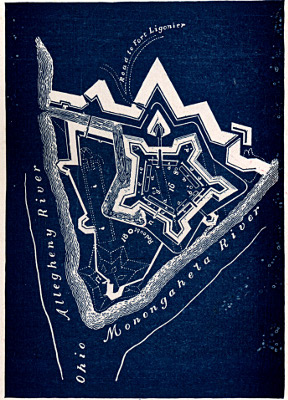
FORT PITT IN 1759.
The first town plan of the Point of Pittsburgh.
The second of three special issues of Charities and The Commons,
presenting the gist of the findings of the Pittsburgh Survey, as to
conditions of life and labor among the wage-earning population of the
Pennsylvania Steel District.
I. JANUARY 2-THE PEOPLE. II. FEBRUARY 6-THE PLACE. III. MARCH 2-THE WORK.
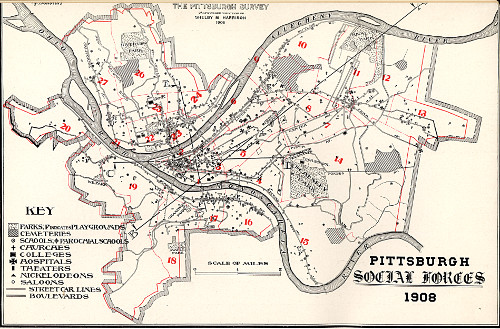
PITTSBURGH SOCIAL FORCES 1908
For profiles, lines A.-B.; C.-D.; and E.-F.—see pages 834 and 835.
ROBERT A. WOODS
HEAD OF SOUTH END HOUSE, BOSTON
[Pg 785]
The capacity for being seen with the eye in the large, which New
York in her sky scrapers has purchased at so great a price, is the
birthright of Pittsburgh. Where from so many different points one sees
the involved panorama of the rivers, the various long ascents and steep
bluffs, the visible signs everywhere of movement, of immense forces at
work,—the pillars of smoke by day, and at night the pillars of fire
against the background of hillsides strewn with jets of light,—one
comes to have the convincing sense of a city which in its ensemble is
quite as real a thing as are the separate forces which go to make it up.
The Allegheny River, providing a broad, open space up and down and
across which much of this drama of modern world industry may be viewed,
has at last come to mean not separation but identity of the population
on either side of it. If the banks of the river were improved, it
might easily be sentimentally as well as economically one of the most
important common possessions of the old and the new sections of Greater
Pittsburgh.
This tendency of cities to reach out and include their present
suburbs, and even the territory where their future suburbs are to
be,—a tendency which a few years ago was mocked at,—is in these
days seen to be normal and wise. The proper planning of the city's
layout, the proper adjustment of civic stress upon the different
types of people in a great urban community, demand the inclusion of
the suburbs. Greater Pittsburgh is less satisfactory than Greater New
York and Greater Chicago, only because it is less inclusive than they.
Some important suburbs of old Pittsburgh are not included, and the
suburbs of Allegheny are nearly all outside. The latter omission is
particularly unfortunate as it is doubtful whether Allegheny by itself
will raise the average civic and moral standard of the greater city.
It is regrettable too that Allegheny continues to show reluctance in
making common cause with her larger neighbor. The toll bridges and the
many obstacles against making them free, seem to typify the difficulty
of intercommunication. The two towns, however, so clearly belong
together that this feeling of clan cannot long survive. From nearly
every commercial point of view that is worth considering Allegheny is
dependent upon Pittsburgh. In the few exceptional instances, as in the
case of two or three large stores, Pittsburgh recognizes a measure of
dependence upon Allegheny. It is interesting that those of the old
families connected with Pittsburgh industries who still insist on
having town houses, reside on the Allegheny parks or commons.
A strong sense of corporate individuality comes to any community that
is arrested by the challenge of great tasks. One of the influences
leading to the creation of the greater city was the widening of the
territory administered industrially from Pittsburgh. The best oil wells
are now south rather than north of Pittsburgh, and the center of the
coal regions is fast passing from the southeast to southwest and on
into West Virginia. The necessity of easy transfer of iron ore from
the Superior region is bringing up insistently the proposal of a canal
to Lake Erie, so as to match some of Cleveland's special advantages.
The nine-foot channel for the whole length of the Ohio will enable
Pittsburgh's long arm to reach out and touch that of Cincinnati.
That the expansion of Pittsburgh was preceded and to some extent
directed by a reform administration, has tended greatly to re-enforce
the belief that Pittsburgh is moving organically toward the better
day in her public affairs. This is the first successful movement for
municipal reform in a generation. As I pointed out in my first article,
it got its immediate stimulus out of the impudent interference of the
state machine in[Pg 786] unseating a mayor who had been elected by an opposing
local faction, and setting up a "recorder" in his place. Carried out
under the forms of legislation, this act stung Pittsburgh people into
a new feeling of municipal self-respect and led to their electing on
a Democratic ticket George W. Guthrie, who had been for many years
actively interested in the cause of municipal reform. Mr. Guthrie's
family, like the Quincys of Boston, has been represented for three
generations in the office of mayor.
Mayor Guthrie has made thorough application of the principles of civil
service reform. He has introduced business methods in the awarding
of all contracts, including the banking of the city's funds. In a
city where only a few years ago perpetual franchises were given to a
street railway covering every section, Mayor Guthrie has, so far as
the situation allowed, put in force the strictest new conception of
the public interest in relation to public service corporations. He
compelled the Pennsylvania Railroad to cease moving its trains through
the middle of what is potentially the best downtown street in the city.
The street railway company was required for the first time to clean and
repair the streets, to meet the cost of changes required by the work of
city departments, and to pay bridge tolls. Loose and costly business
methods in the city departments were radically checked, and accounts
with long arrearages involving heavy interest losses to the city, were
brought up to date. The cost of electric lighting to the city has been
reduced from ninety-six to seventy-two dollars a lamp. Economies have
been effected through having the city do some of its own asphalt paving
and water-pipe laying.
Along with economical departmental service have gone the intelligent
and effective efforts, which will be explained in other survey reports,
for improving the water supply, abating the smoke nuisance, combating
typhoid fever and tuberculosis by wholesale inroads upon almost
unbelievable sanitary evils, and for restraining and punishing the
exploiters of prostitution.
Not all American reform administrations can report a decline of two
mills in the rate of taxation. Had Pittsburgh not been compelled to
shoulder a special burden in including Allegheny's large municipal
costs accompanied with low property valuation, Mayor Guthrie would have
held the rate at this low point.
Under the new charter the mayor cannot succeed himself; so that the
question whether Mayor Guthrie could be successful with the enlarged
electorate is a theoretical one. Even if the machine should be
successful, a standard has been set which the citizens will remember
and return to.
Under the determined leadership of A. Leo Weihl, a Voters' League has
employed such methods for keeping proper standards before the voters
as have been successful in Chicago, Boston and other cities. Within
a few weeks, after a year or more of clever and determined pursuit,
seven members of councils and two bank officials have been arrested on
a charge of bribery. The officers of the league state that this step
is but the beginning. It is not claimed that this means anything more
than the highly public-spirited activity of a few citizens, and it may
be, as is currently reported, that such activity became possible in
that certain great financial interests decided to change their policy
as to dealing with city officials. However it became possible it meant
exposure and disgrace to a system which was rooted in traditions in
Pittsburgh. Just as this tradition was broken once in the election of
Mayor Guthrie as a result of a bitter sting to the self-respect of the
city; so now there is a cheering prospect that this poisoned goad will
rouse and mobilize an instinct for carrying moral reforms to the limit
which is very powerful in Pittsburgh when a situation forces the issue.
The present phase of political chicanery touches the banks, and the
reaction against it will be re-enforced by the growing concern of the
community in the face of bank defalcations amounting altogether to not
less than five million dollars within the past four years, some if not
all of which involved mysterious political complications.
[Pg 787]

GEORGE W. GUTHRIE.
Mayor of Pittsburgh.
Such an extreme outbreak of crime is related to the transition stage
through which the city is passing. Along with the intoxicating
accumulation and expenditure of wealth, the old type of dominating,
watchful, industrial and financial leader has disappeared,—that
which is typified by Mr. Carnegie, B. F. Jones,—whose firm continues
the largest independent steel concern in Pittsburgh,—the Parks, the
Moorheads, the Olivers, the Laughlins. The large industrial interests
are in the main turned into bureaucracies whose plans in detail are
decided in New York, and whose officials must guide their public
actions so as to serve the corporations' interests. The merchants
and professional men of the city who have always deferred to the
manufacturers,[Pg 788] have only recently begun to assert themselves. It is
perhaps natural that civic co-operation should make a more effective
appeal to the merchants than the manufacturers, the merchants'
constituency and scene of action being very largely local. Mayor
Guthrie's election was a result of this new organized element in the
life of the city. His work has in the nature of the case been largely
the lopping off of old evils and the piecing together of a system of
administration which shall embody standards of honesty and business
efficiency.
Will the people of Pittsburgh be ready for the further stage of sound
reconstruction, for the unified, organic development of the city
as a thing in itself; for the application to the common welfare of
those coherent, adventurous principles which have made possible the
magnificent prosperity of the few? The proper answer to this inquiry
must regard the time perspective. A strong momentum of public spirit
and social service from out of the past, Pittsburgh, in becoming a
great population center, did not possess. But in the last ten years
the progress of this community, to one who can test it in varied and
intimate ways, has proved in such matters highly significant and
promising.
There are significant results, for instance, of the collective action
of business men for the enhancement of the general interests of the
city. Such effort leads first indirectly and then directly to the
improvement of the city as a place in which to live.
Two considerable changes in the layout of the downtown part of the city
have been brought about by special branches of trade. The wholesale
grocers and the wholesale provision men have been for generations
located on Liberty and Penn avenues west of the Union Station.
Recently the latter have taken possession of a territory beginning a
few blocks farther east and reaching for a quarter of a mile along
Penn avenue, and through to the Allegheny River. A large number of
the meanest tenement houses have been swept away by this process,
and facilities provided for receiving and distributing fruits and
vegetables, a distinct gain toward a hygienic urban commissariat.
The wholesale grocers have cleaned up an equally large and equally
unsanitary tenement area on the South Side, and have built vast
subdivided warehouses under a single general management. Perhaps the
most important aspect of these great co-operative improvement plans
is the suggestion they give of the capacity of Pittsburgh citizens
for making other broad modifications in the structure of the city,
such as the improvement of its river fronts, the proper planning of
its thoroughfares and public centers, and above all the sanitary and
adequate housing of its industrial population.
It is indeed by its bold pioneering in such directions as these that
the Pittsburgh Chamber of Commerce, chiefly under the leadership
of H. D. W. English, has come to have an ever-growing authority in
Pittsburgh, and a rather unique reputation and influence in other
parts of the country. Greater Pittsburgh, as it is, with the provision
for further expansion from time to time, is largely the result of
the chamber's persistent effort. The improvement of the Ohio River
which is to be undertaken at once by the national government, and the
organization of a company to build the canal to Lake Erie, are also
results of its initiative. The reduction of the smoke nuisance, the
provision of a proper system of sewage disposal, the study of plans for
protection against floods, and, most noteworthy of all, the inclusion
of the hygienic housing of the people in the list of the city's chief
economic problems, are among the statesmanlike undertakings which
the chamber has been effectively promoting. The Chamber of Commerce
is reinforced by local boards of trade covering the chief outlying
sections of the city and including in their membership not only
representatives of business carried on locally, but downtown business
men who reside in the district. The boards of trade have been infected
by the broad spirit of the Chamber of Commerce, and are in essence
district improvement societies whose activities are focussed and
forwarded by their business-like motive and methods.
It can hardly be that any city has ever had so great re-enforcement
of its finer[Pg 789] life from the beneficence of a private citizen as has
Pittsburgh. Under the general title of Carnegie Institute are included
a public library, a museum, an art gallery, and a music hall. These,
under one roof, cover an area of five acres. At a little distance are
the Carnegie Technical Schools with grounds covering thirty-six acres.
The total sum which Mr. Carnegie has given these different objects is
upwards of $11,000,000.
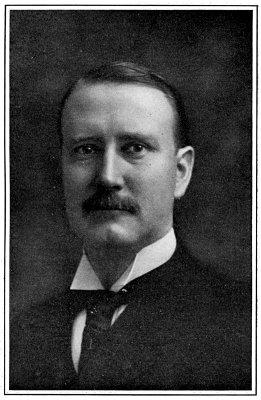
H. D. W. ENGLISH.
Chairman, Civic Improvement Commission, Pittsburgh.
The library contains 300,000 volumes. The annual circulation is
nearly three times this number. The service rendered by the library
is greatly increased by aggressive and ingenious missionary[Pg 790] work.
There are six well-equipped branch libraries with 170 distributing
stations throughout the city. Half of these are in the shape of little
reading clubs and home libraries for children, conducted by the library
management itself. This branch of the library's work has grown so much
as to justify the establishment of a school for children's librarians.
The fact that the library exists to discover and elicit new demands is
made clear in the establishment of a "telephone reference," through
which any person may have a subject looked up for him and a report
quickly made. There are indeed more than sentimental reasons for the
cherished feeling in Pittsburgh that this is the bright particular
exemplar of all the Carnegie libraries.
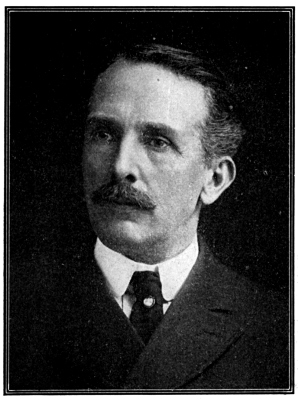
LEE S. SMITH.
President, Pittsburgh Chamber of Commerce, Member Civic Improvement
Commission.
The art gallery, some parts of which are of exceeding beauty, includes
permanent exhibits of painting, sculpture and architecture. Its chief
service to art thus far has consisted in a regular annual international
exhibition of paintings. A very suggestive plan is followed for
interesting school children in the galleries and in pictures generally.
A set of photographs of the entire permanent collection is placed in
one school after another for periods of two weeks each. It is expected
that a continuous circuit will be kept up in this way requiring two
years on each round.
The museum stands among the four chief institutions of its kind in this
country. It is under expert and enterprising management. A considerable
part of its collections have been gathered by its own expeditions. Like
the art gallery, it appeals directly to the public schools by sending
out circulating collections, conducting prize essay contests, and by
carrying on a young naturalists' club.
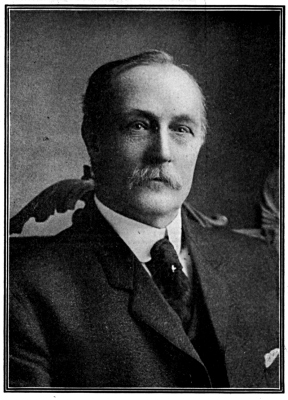
O. H. ALLERTON, JR.
President, Pittsburgh Board of Trade, Member Civic Improvement
Commission.
The music hall represents among this noble group of cultural agencies
the one which simply continues the results of a significant phase of
the city's inherent growth; for since 1879 Pittsburgh has had some
sort of worthy musical festival every year. The weekly free organ
recitals are a commendable transfer to America of a well recognized
form of municipal service in English cities. It is unfortunate for this
purpose that the hall should not be more accessible to[Pg 791] great numbers
of people. The symphony concerts of the Pittsburgh Orchestra, whose
seasons have continued during the past twelve years, are given partly
in this hall and partly (in certain years) in the Exposition Building
near the Point.
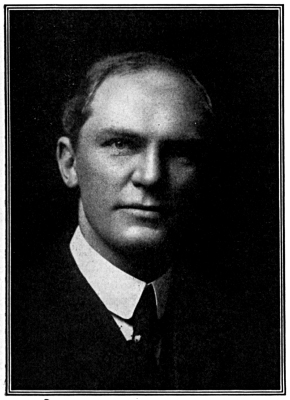
T. E. BILLQUIST.
Architect, Member Civic Improvement Commission.
The Carnegie Technical Schools represent the farthest steps yet taken
in this country in providing vocational training for those entering
non-professional callings. Considering that the greatest weakness of
the whole American scheme of education is precisely at this point, the
progress of the Carnegie Schools is being watched with keen attention,
on both the educational and the economic side, from all parts of the
country. Thus far schools of applied design and of applied science,
a special vocational school for women, and a school for apprentices
and journeymen, have made a strikingly successful beginning. All the
schools are open day and evening. The present enrollment includes
2,000 students representing every state in the Union and many foreign
countries. It can be said of the administration of the schools that
it is worthy of its opportunity. The staff of instructors shows a rare
spirit of fresh initiative, of quick and varied flexibility of mind,
and of thoroughgoing achievement.
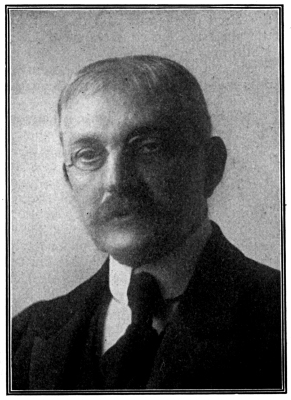
JOHN W. BEATTY.
Director of Fine Arts, Carnegie Institute, Member Civic Improvement
Commission.
The University of Pittsburgh, is new in name but has in reality
existed for more than a century. The institution has, however, not
found Pittsburgh conditions conducive to academical development. Its
engineering department has, somewhat to the regret of the university
authorities, been by far its most important feature. A strong effort
is now being made to build it up into a university worthy of a great
city. A new site has been purchased and an exceptionally interesting
plan for the various buildings has been accepted. When completed these
structures will describe a circle up and down a hillside looking out
over Schenley Park, with an administration building modelled after the
Parthenon as a crowning effect.
The presence of all these educational institutions at the entrance of
Schenley[Pg 792] Park, with its 420 acres, situated within twenty minutes'
ride by electric cars from the heart of the city and on the way to
the chief residential sections of Greater Pittsburgh, creates a civic
center with a condensed attractiveness and resourcefulness that is
already definitely re-enforcing the public imagination.
All this cluster of enlightened agencies, however, to the discerning
eye points by contrast to the ultimate, close analysis of economic
as well as moral conditions among the people in all the less-favored
sections of the city and in all the satellite industrial towns.
The conception of a direct community of interest between employer
and workman, particularly if the workman is a leader in his craft,
begins to be visible as in a few streaks of dawn. But the mass of
the unintelligible Hungarians and Slavs must be reached by the more
generous and democratic sense of responsibility on the part of
employers and the more prosperous classes generally. The work of the
next decade is to bring them on a really large scale into the circle of
American citizenship and up to the essential standards of American home
life.
The touchstone of progress and success in this great enterprise lies
first of all with the public schools. The public school system of
Pittsburgh is in very many respects behind accepted standards. Its
chief defects come out of the faulty system of administration. Every
ward has its local school board with the power of levying taxes,
erecting buildings, and appointing teachers. This means that in some
wards there is a good quality of instruction and properly developed
curriculum, while other wards fall far short. It happens from this
condition of things that in the working-class wards there is little or
no provision for manual training; and in general the points of greatest
need are the most poorly supplied. Objectionable political methods
on the part of the local boards are pretty clearly in evidence; and
such tendencies are by no means absent from the central board. Signs
of progress are, however, becoming apparent here and there throughout
the school system. The Carnegie Technical Schools are having a
powerful influence in this direction. In the South Side, under direct
encouragement from this source, and with the co-operation of local
manufacturers, an evening trade school has been opened. There have been
experiments in the direction of medical inspection and school nursing.
There is an active agitation among the teachers for a parental school.
In general the whole problem of public school administration has been
thrown open for debate by the appointment of a capable state commission
to report upon the subject. It is thought that for one thing it will
recommend the practical abolition of the power of the local boards, so
that they become simply visiting committees.
The high school in Pittsburgh is and always has been an important
educational influence. In popular sentiment, it occupies a place
somewhat analogous to that of the College of the City of New York. In
order to make its service as general as possible the present director
sends to the parents of all children graduating from the grammar school
an interesting printed statement of the concrete objects and value of
the high school. The pressure of the demands of industry as against
the attraction of general studies is of course keenly felt. An evening
high school with a definitely vocational trend has recently made an
encouraging beginning.
The Pennsylvania method of combining public subsidy with private
initiative is followed in connection with the kindergartens. A private
association has supervision of all the kindergartens in the public
schools as well as of some carried on in private institutions. There
are altogether eighty-one kindergartens in this system. It is felt
that, at least in the early stages, this method of control brings
better standards of teaching and assures such collateral work as
visiting in the children's homes and conducting mothers' meetings. It
is needless to say, however, that in the long run such a division of
responsibility will be injurious in point of effective service and of a
proper sense of responsibility in the public administrative officers.
This sort of apprehension is all that qualifies in the least one's
impression of[Pg 793] the admirable work of the Pittsburgh Playground
Association. Its activity began twelve years ago, and now,—with
an off-shoot in Allegheny,—includes the administration of six
well-equipped recreation parks, twenty-four vacation schools held in
school buildings, and a number of small playgrounds. The center of the
system is the site of an old arsenal, thirty acres in extent, in the
midst of a great working class district. At every point in all this
work, discriminating effort is made to achieve positive educational
results as well as to bring healthful enjoyment to the largest possible
number of persons. In this respect, as well as in the definite prospect
of appropriations sufficient to provide every now neglected section of
the city with an ample playground, Pittsburgh stands at the forefront
in this most vital phase of educational and civic advance.
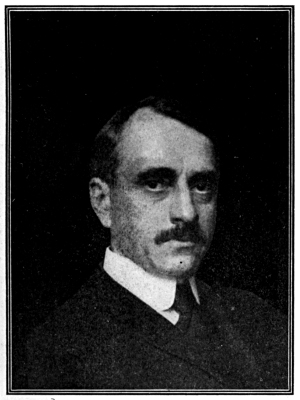
JOSEPH BUFFINGTON.
Judge United States Circuit Court and one of the first citizens of
Pittsburgh.
Like Chicago and other typical American cities where men are deeply
absorbed in business, women have contributed a particularly important
share to public betterment work. The Civic Club of Allegheny County,
in which women have for the most part been the active spirits, and
various women's organizations, particularly the Twentieth Century
Club and the Council of Jewish Women, have accomplished many telling
results in this direction. The Civic Club has the direct management
of two people's bath houses; but its main service consists not in
work of administration but rather in initiating enterprises to meet
new problems as they arise, and then setting them loose to develop
permanent organizations on their own account. In this way the club
started the playground association, a municipal hospital for contagious
diseases, manual training in the public schools, a legal aid society,
an open-air tuberculosis camp, and a child labor association, beside
having an active share in the creation of the juvenile court and the
securing of progressive tenement-house legislation.
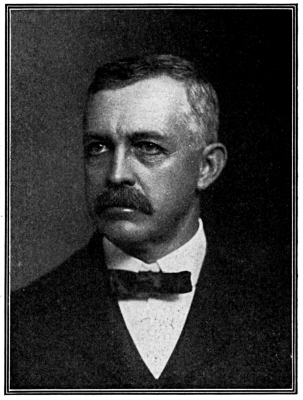
WILLIAM M. KENNEDY.
President, Civic Club of Allegheny County.
In the field of charity and philanthropy Pittsburgh shows a very
substantial degree of activity and earnest motive. Very much is needed,
however, both in the way[Pg 794] of more enlightened specific and local
execution and of broader co-operation for economy and completeness in
each type of social service. The staff of the Pittsburgh Survey has
had the privilege of submitting to many institutions and agencies the
accredited results of recent experience in other cities and countries.
Such suggestions have been cordially received and in some instances at
once acted upon. The Pittsburgh Associated Charities, which has been
organized within the year, has secured the support of nearly every
phase of charitable endeavor in the city. It represents the immediate
advantage which Pittsburgh, under the spur of organizations like the
Civic Club, has taken of the Survey's presentation of the practical
conclusions of scientific charity. The Associated Charities is so new
that nothing can be said about results in the ordinary sense; but in
contrast to the confusion which existed until a year ago, its clear
cogent platform covering both remedies and reforms, its straight appeal
to the practical men, its strong representative board, and its fit and
well convinced executive officer, are achievements of the first order.
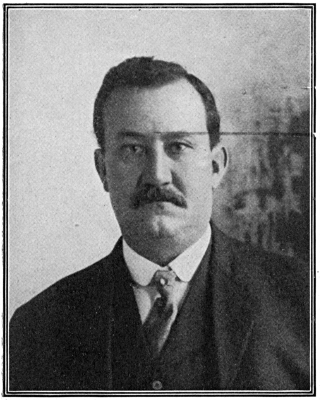
D. P. BLACK.
President Real Estate Trust Company, Member Civic Improvement
Commission.
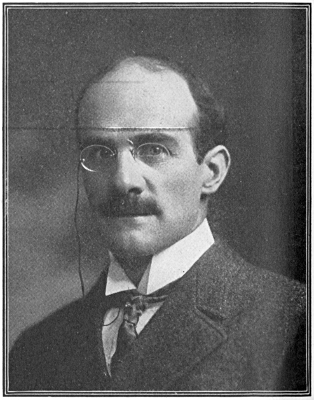
HENRY L. KREUSLER.
(Building Construction), Member Civic Improvement Commission.
The development of the great filtration project has naturally
stimulated other movements for the improvement of the public health.
In this direction the municipal health department is a broadly and
consistently helpful influence. The fight against tuberculosis is
carried on effectively by both public and private agencies. The special
commission of experts appointed by the mayor and aided financially by
the Sage Foundation for tracing causes of typhoid fever aside from the
water supply, will render a most important service to Pittsburgh as
well as to the whole country. The successful record of the filtration
plant in greatly reducing the amount of typhoid in the city, gives
added point to this scientific effort to rid out the last lurking
places of infection. In general, however, it must be said that the
self-forgetful abandon with which many medical men in other American
cities are bringing their priceless knowledge to bear upon public
unsanitary conditions and unhygienic ways of life,—a type of effort
which both in motive and result may almost be taken as the test
of a city's progressive civilization,—has hardly as yet reached
Pittsburgh.[Pg 795] The exceptions,—notable ones,—are of the sort that prove
the rule.
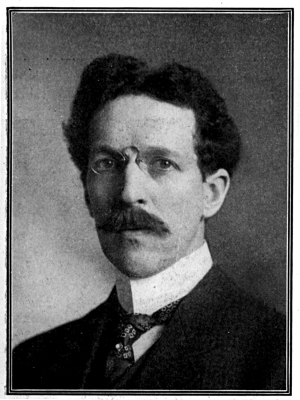
CHARLES F. WELLER.
Secretary of the new Associated Charities, Pittsburgh; member
Pittsburgh Civic Improvement Commission; former secretary
Washington Associated Charities and President's Homes
Commission.
The co-ordination of charitable effort, both in its different kinds
and in its different localities, is a step which needs now to be
followed by the federation of agencies for social upbuilding. The
playgrounds which are fast becoming the headquarters of a kind of
neighborhood guild, will furnish a substantial part of the material
for this comprehensive social formation. In such enterprise, organized
local citizenship, especially as seen in the boards of trade, will
undoubtedly afford valuable re-enforcement to the distinctively
philanthropic motive. The settlement houses of which there are several,
might naturally take the lead. Such a federation would ensure to
each local agency information about the results of experience at
every other; it would bring the momentum of concrete local knowledge
to bear upon the public school system and other parts of the public
administration; it would draw into the work of constructive local
betterment many resourceful new individuals and new agencies, thus
spreading throughout the city the new point of view in citizenship;
it would bring forward from the congested sections of the city those
rear detachments of citizenship without which municipal reform must
continue to be shallow and casual. In the development and extension
of local social organization lies much of the promise of widespread
growth of public spirit in Pittsburgh. The people have a distinct
capacity for the invaluable village type of loyalty. This can in due
time with expanding experience be made into the most enduring type of
city loyalty,—that based on neighborly co-operation gradually extended
and writ large but carrying with it always that sense of reality, that
nearness to the soil, in which it began.
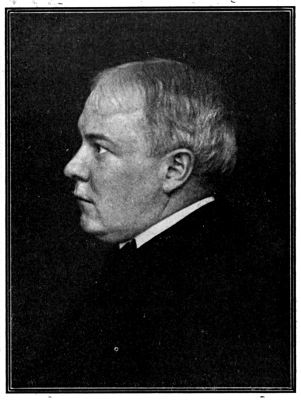
FRANCIS J. TORRANCE.
President Pennsylvania Board of Public Charities.
Kingsley House was founded in 1894 by Rev. George Hodges, now dean of
the Episcopal Theological School, Cambridge, Mass., but for twelve
years a strong influence for realistic Christianity in Pittsburgh. It
has grown to be an important center for progressive social[Pg 796] service,
and from its commanding position on a hill looking over the business
section of the city it exercises an influence for social morality far
beyond its immediate constituency. Its regularly organized work is
gathered up into two large composite clubs, one having a membership of
600 boys and young men, the other about as many girls and young women.
An average of half the total membership appears at the house daily for
gymnastic training, games, industrial classes, discussions, music,
etc. The tenement problem and the whole hygienic aspect of life among
working people receive penetrating and persistent attention, and the
importance of the service of the house in this direction is recognized
throughout the city. Closely involved with such a campaign is the large
country holiday work of this settlement, whereby some 4,000 persons
are each summer provided for at a specially built and finely equipped
vacation house.
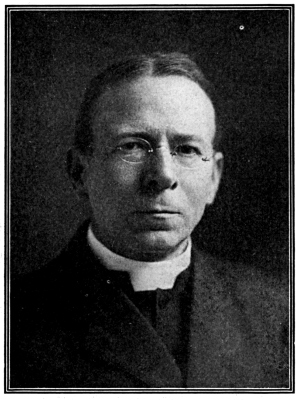
REV. GEORGE HODGES.
Dean of the Episcopal Theological School, Cambridge, Mass.; founder of
Kingsley House, Pittsburgh.
The Columbian School and Settlement which is farther up in the "Hill
District," is supported by public-spirited Jewish citizens. The usual
variety of clubs and classes is provided, and their opportunities
are received with even more than the usual eagerness by the children
of recent Russian immigrants. Much attention is given to education
in hygiene by means of a gymnasium, baths, and instructive district
nursing, as well as through securing the enforcement of sanitary laws.
This settlement has given special attention to the very useful function
of serving as pacemaker to the public schools, in the matter of evening
industrial schools, recreative centers and vacation schools.
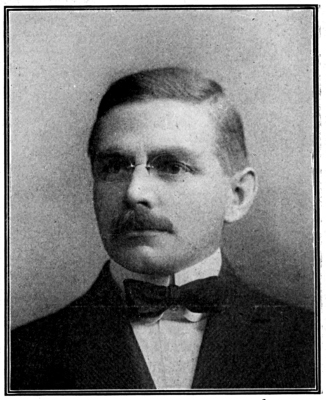
WILLIAM H. MATTHEWS.
Head worker, Kingsley House, Pittsburgh; a forceful leader in the
housing campaign, Member Civic Improvement Commission.
The Soho Baths Settlement adjoins a new bath house just erected by the
Civic Club, and designs to supplement its service through personal
influence in the homes of the neighborhood. The Woods Run House in
Allegheny has taken a new start since separating its relief work from
its work of neighborhood organization. Covode House, also in Allegheny,
is substantially the "industrial betterment" phase of the Heinz pickle
factory.
The churches of Pittsburgh, which,[Pg 797] now with a few exceptions seem to
regard as a secular intrusion the introduction of broad civic interests
into their counsels, and thereby often appear shamefully indifferent in
matters of public morality, could be led to take part in a campaign for
a better home and neighborhood life, and would soon learn practically
the close bearing of all human facts upon character and spirit. Those
ministers who preside over the costly and surprisingly numerous stone
edifices throughout the East End, would thus be able to meet their most
serious problem, that of bringing up young people with some practical
sense of their responsibilities to the less favored. The downtown
ministers, who are deep in gloom as to the future of their own parishes
if not of the church in general, would begin to see how to touch and to
serve the indifferent newcomers, and would make an effective claim on
the suburban churches for assistance.
The churches of Pittsburgh constitute an exceptionally important
possibility in the direction of social reconstruction. Our canvass of
the Protestant churches showed that a large proportion of them at least
recognize the need of new forms of helpfulness and are making some
effort to meet it. A large number of pastors are already organizing
their congregations for a somewhat broader social service. The Catholic
churches are under the care of a noble-minded bishop who is doing his
utmost to make the existing system of the church provide for its vast
inarticulate constituency. Many of the immigrant priests are sincere
and sagacious men. The more progressive Jewish congregations do their
full share in sustaining and advancing the public moral standards of
the city and in promoting sound philanthropy.
Yet among all the costly ecclesiastical structures,—the city is said
to have $17,000,000 invested in church buildings,—there are only
three or four which have any adequate equipment for the promotion
of human service or friendly association. The responsibility of the
rich congregations for re-enforcing the poorer ones in their struggle
against adverse conditions is scarcely recognized.
The problem is as in other cities. In the most crowded sections, the
normal constituency of the Protestant churches has been swept away
by the immigrant tide. In somewhat better conditioned neighborhoods,
families have moved away and the homeless, neighborless lodger has
taken their place. That is, the fundamental conditions which have
created and directed the churches have disappeared; and only a broadly
organized, well financed campaign can provide the fresh force,
equipment, intelligence, which are indispensable to the revolutionized
situation.
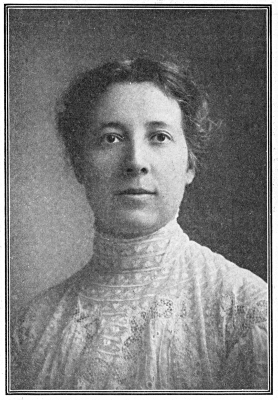
ADDIE S. WEIHL.
Head worker, Columbian Settlement, Pittsburgh.
The suburban churches side-step the present crisis. They are sincere
but other-worldly. One minister who is genuinely interested in foreign
missions feels it much on his conscience to make his people care less
about the Orient and more about the East End. A few preachers deal with
a present-day, near-home kingdom of God. Some presented the results of
the Survey to their people; more entered into solemn account of stock[Pg 798]
at the time of the bribery arrests. The following of the churches is
large, devout, loyal; but, on the whole, the church is a hospitable
garrison to defend the faith, not a conquering army of righteousness.
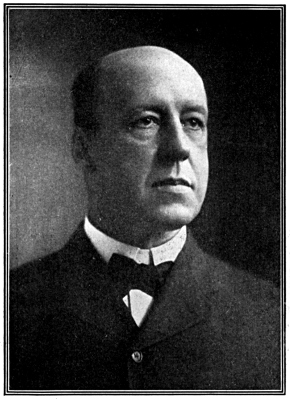
JULIAN KENNEDY.
Consulting engineer, Member Civic Improvement Commission.
Religion as being one-half the ingenuity and adventure of diversified
personal service in every kind of neighborly and civic fellowship;
the truth which Dr. Parkhurst long ago voiced, that the congregation
is not the minister's field but his force,—this is what has produced
Pittsburgh's small but heroic group of present civic leaders. A
widespread contagion of it is what Pittsburgh needs more than
anything else. In this the city must find its chief resource for
bringing about and continuing a better order. The response of the
churches to the sickening series of breaches of trust, to bribe
giving and bribe-taking, to the overwork that means debauchery, to
the mill-owners' Sabbath-breaking that breaks the mill-worker's body
and soul,—must be a bold relaxing from tradition and letting their
dynamic go free. The outcome would be a new synthesis which would
overcome the weakness and shame of sectarianism, and give a broad,
strong front to the city's renascent moral life.
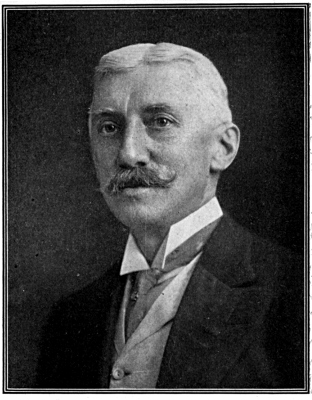
JOSEPH W. MARSH.
Vice-president and general manager, Standard Underground Cable Company,
Member Civic Improvement Commission.
Along with the detailed, patient, comprehensive work that is needed
to build up a moralized democracy, the industrial and commercial
leaders of the community, including those who are the responsible
representatives of absentee capitalists and landlords, must rise
to a far more generous, not to say discerning, conception of their
opportunity. Big men of a generation ago said, "After us the
deluge,"—they cut the forests off the Alleghenies, and Pittsburgh
literally suffers the curse in destructive floods once or twice
every year. The way of life in the local communities about many of
the great steel plants is infallibly preparing for the near future a
worse form of deluge in a mass of unfit, under-vitalized, unproductive
citizenship. It is but fair to say that the really big men of to-day
in[Pg 799] Pittsburgh are passing beyond the attitude of indifference to
the human problem that confronts the captain of the industrial army.
Indeed, the past few years have brought about a distinctly receptive
point of view. The lesson to be learned and aggressively applied during
the coming decade is that a great city's industrial supremacy, no less
than its moral well-being, depends largely upon the proper provisioning
and sheltering of the industrial rank and file, along with training in
capacity for citizenship and for associated self-help.
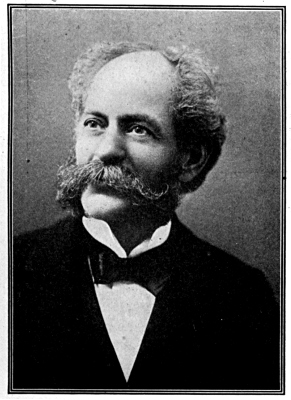
H. J. HEINZ.
President H. J. Heinz Company, Member Civic Improvement Commission.
There have been stirring instances in the development of city life in
this and other countries where a city deeply engaged in laying its
material foundations, and suddenly finding itself not up to its own
standard in other vital respects, has, by throwing a due share of
its accumulated energy and resource into the new channels, been able
to overleap intermediate stages which had been toilsomely worked out
elsewhere. Such a magical achievement for the refinements of life
has been made once in Pittsburgh through the surpassing initiative
of a single citizen. It now needs to be repeated and outdone by the
main action of the body of responsible citizens, carrying with them
representatives of every grade and type of the people, in the united,
elated march of a great civic and human welfare movement. Strange as
it may sound, this is the sort of social phenomenon that American city
life is next going to present; and it may be that Pittsburgh will lead
the way.

J. W. KINNEAR.
Attorney-at-Law, Member Pittsburgh Civic Improvement Commission.
There are elemental changes coming in the life of Pittsburgh. The new
immigrants will within a short generation be rising into social and
political power, and their standards will in large part fix the moral
and even the economic prospects of the city. The special resources
of western Pennsylvania in raw material will necessarily grow less,
and its need of a more developed labor force become insistent. In
any case immigration cannot indefinitely recruit the labor ranks;
Pittsburgh must learn to pay as it goes in[Pg 800] terms of men as of money.
The ninety per cent pure iron which Mr. Carnegie found in the waste
of his competitor and secured by a long contract, is the analogue of
what Pittsburgh must begin to discover in the native capacity of the
children of its crude toilers. The protective tariff which for the past
two decades has been like an evil divinity to intensify the haste to
be rich, and to confuse and baffle all local public issues, is on an
uncertain footing as never before. Already there are new American steel
centers which will dispute for the market supremacy. Every one of these
things will compel a moral reckoning, will constrain the city to the
saving and enhancing of individual and collective human power.
The historic sense newly awakened by the recent sesquicentennial
celebration of the origin of the town; the downright, ingenuous pride
of the people in its unexampled achievements; the inquiring attitude
of an ever increasing number of citizens; their inner assurance that
the city will match its prosperity with civic well-being; a beginning
on the part of the moral reserve force of the city, on the one hand,
and its practical organizing power, on the other, to seek a new common
outlet; these provide momentum, amid many counter-currents, for an
ample hope.
It is of special significance that, for the first time in this country,
Pittsburgh secures the advantage of several carefully devised and
closely related undertakings in the new science and art of social
upbuilding. The welcome extended to the staff of the Survey by
leading citizens at the beginning, and their willingness from first
to last to listen to its hard sayings, have given the Survey much
of its essential driving power. The joint meeting in Pittsburgh of
the National Municipal League and the American Civic Association,
resulting in a happy co-ordination of higher methods and higher aims
of city administration, especially in the session devoted to the
Survey,—distinctly helped strengthen and confirm the beginnings of
that new public consciousness which includes the greatness both of the
city's needs and of its opportunity. The civic exhibit which went with
this national gathering, displayed under perfect conditions in the
Carnegie Gallery, and setting forth as its chief feature the results
of the Survey in the graphic, instantaneous, inescapable language of
the workshop, established its lessons in the minds and imaginations of
many thousands of those who in every rank go to make up Pittsburgh's
industrial forces. And now the appointment by Mayor Guthrie of a
strong, representative civic commission, with Mr. English as chairman,
and such exceptionably capable and responsible men as are summoned in a
great public emergency, to lead committees on public hygiene, housing
problems, rapid transit, municipal efficiency, industrial casualties
and overstrain, education, police courts, charitable institutions,
neighborhood and district improvement agencies, and city planning,—can
hardly be construed otherwise than as the final precipitant of a new
epoch of masterful humanism in the evolution of America's distinctive
industrial metropolis.
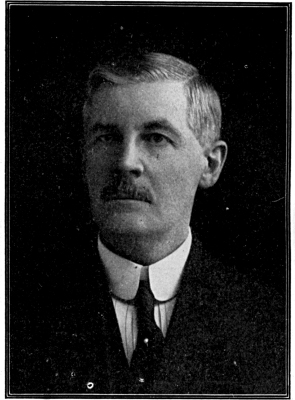
A. J. KELLEY, JR.
President Commonwealth Real Estate Trust Company, Member Civic
Improvement Commission.
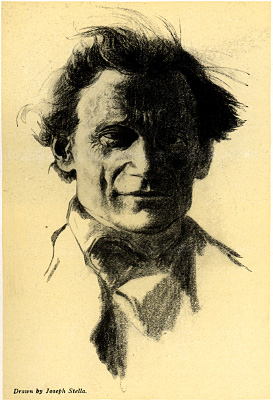
Drawn by Joseph Stella.
PITTSBURGH TYPES. ITALIAN LEADER.
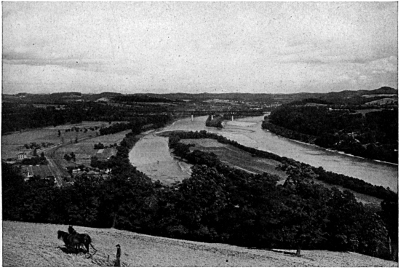
THE ALLEGHENY RIVER VALLEY.
CIVIC IMPROVEMENT POSSIBILITIES OF PITTSBURGH
CHARLES MULFORD ROBINSON
AUTHOR OF MODERN CIVIC ART, ETC.
[Pg 801]
In studying the civic improvement possibilities of Pittsburgh, one is
impressed by a curious mingling of antagonistic conditions. A wonderful
natural picturesqueness is contrasted with the utmost industrial
defilement, smoke and grime and refuse pervading one of the finest city
sites in the world. Similarly great wealth and great squalor are side
by side. Nation-wide business is done on very narrow streets. A royal
munificence in public benefaction goes with a niggardliness that as yet
denies to many children a decent playspace. Immense private houses,
with the amplest grounds to be found perhaps in any great city, abut
on meanly proportioned streets. One is impressed first by the hugeness
of the city and then by its lack of coherence. It has been built up as
an aggregation of integers, mighty, resourceful, pushing; but lacking
as yet in unity. That power, which is the keynote of the city, is not
civic. It is not communal power but a dynamic individualism.
But still steep hillsides close with magnificent self-assertion the
vistas of business streets, still the mighty rivers, polluted with
refuse though they be, flow in great streams to meet at the "Point";
still from heights there are views of surpassing interest; and in
the rolling country that encompasses the city with ravine and wooded
slope, there still remain gentle loveliness and restfulness in
impressive contrast with the throbbing industry of the town. Thus, in
spite of itself, picturesqueness such as even Edinburgh, the "queen
city of Europe," might envy is thrust upon Pittsburgh, and there is a
surrounding beauty that Florence might covet.
[Pg 802]
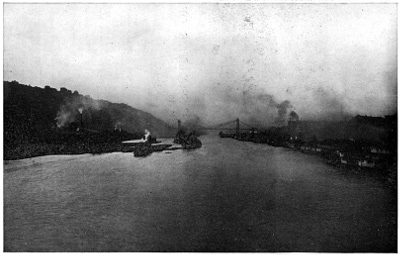
NATURAL BEAUTY vs. INDUSTRIAL ODDS.
[Pg 803]
In the midst of this strange mingling of opposites, of great
opportunities and fearful handicaps, of vast needs and vast
resources there appears the gradual stirring of a new ideal. A
civic consciousness is awaking and that social conscience which has
heretofore operated in individuals merely is becoming popularly active.
At this wonderfully interesting juncture, the serious study of civic
improvement in Pittsburgh is to be made. What Pittsburgh wants, what
she has done and dreamed, what she must do, as a community, for her
improvement,—these are the questions for the citizens of Greater
Pittsburgh if "greater" is to have all its true significance.
In discussing them let us follow these most obvious divisions of the
subject:
First, the congested business district of Pittsburgh proper, that
is, the peninsula: its needs and its possibilities. Second, the slum
district,—a band of varying width that, regardless of intervening
rivers, surrounds the business section. Third, the manufacturing area,
very widely extended and therefore affecting the whole city. Fourth,
the homes of wealth, typified by the East End, and the educational and
cultural center that is building there. Fifth, the suburban district.
Sixth, the park requirements of the Greater City. Seventh, the
community as a whole.
I.
The business district of Pittsburgh is as restricted as that of an old
world city bound in by compressing fortifications. But its boundaries
are not to be readily moved like the works of men. They are the broad
rivers and the obstructing hill. The district extending from the
"Point," where the rivers join, to the "Hump," is approximately an
equilateral triangle, of which the sides are less than half a mile in
length. Into this small area is crowded the business of an enormous
manufacturing center. Here the railroads and boats bring their
passengers; here the trolley roads of the whole district converge;
here reach the bridges with their continual traffic. The condition is
similar to that of Manhattan, except that in Pittsburgh the space in
proportion to the business is even smaller.
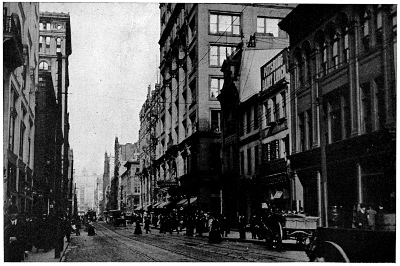
SMITHFIELD STREET FROM FOURTH AVENUE.
The pressure in such a restricted area is of a double character. There
is a pressure for traffic room, and an equally insistent pressure for
building sites. One [Pg 804]
[Pg 805]demand is as legitimate as the other. Therefore,
although the streets are too narrow, relief must be sought rather by
increasing their carrying efficiency than by changing their dimensions
or adding to their number. To accomplish this three plans have been
under consideration.
One, and an obvious one, is to increase the area of the business
district by leveling the low hill (the "Hump") that bounds it on the
east. This plan seems now to have been abandoned. It would involve
great cost, and it would not certainly better conditions in the most
crowded area. Furthermore, business has about climbed to the top of the
hill already.
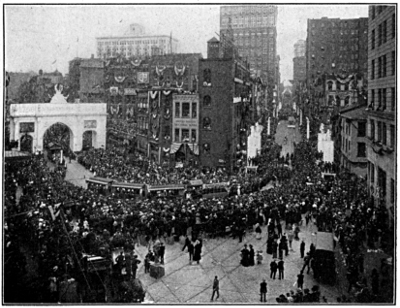
SESQUI-CENTENNIAL PARADE.
The other plans have to do with the trolley cars that come here from
all sections of the city. As most of the cars do not pass through the
district, but go out as they came in, there are numberless "loops",
each of the various lines making a turn around two or three blocks,
with the result that loop overlaps loop, and the cars interfere with
one another as well as with general traffic. One plan would put many of
the cars underground, in a subway, in the business district; the other,
while permitting them to traverse the district, would carry them on
into Allegheny to make their loops.
It were better, however, that there should be no loops at all; that the
cars should not "go out as they came in." By the substitution of long
through lines for the loops which are only a survival of other times
and conditions, all the advantages would be gained with none of the
drawbacks of transferring the loops across the river.
In the plans for a downtown subway loop, it is proposed that all the
stations be located on private property, so putting no additional
burden on the streets, and furthermore that the loop be open to the
cars of all companies. This would give much relief; and as subways
have proved too successful in other cities to be regarded any longer
as experimental, it seems that one here, properly constructed and
authorized with equal regard for financial and municipal interests, is
a civic improvement necessary for Pittsburgh's business district.
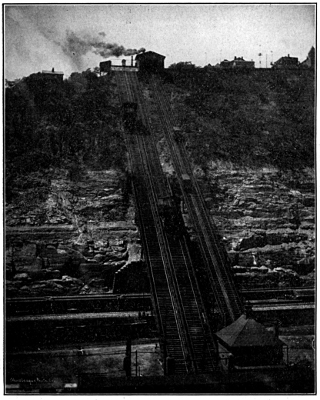
ONE OF THE INCLINES WHICH SCALE THE PITTSBURGH HILLS.
[Pg 806]
As it would take some years to construct the subway; and as the relief
to the streets afforded by straightening out the surface car routes
might be overbalanced by a rapid increase in the number of cars, it is
necessary to consider other immediate measures for traffic relief. A
rounding of curb corners even at alleys, and the substitution of a well
laid grooved rail for the present T-rail may be here suggested. With
the grooved rail there is less temptation for teamsters to use the car
tracks, the tracks can be turned out more readily and the whole width
of roadway is made available, instead of being divided as now into
longitudinal sections.
Costly as is the widening of streets, or the opening of new ones,
such heroic measures are already being adopted for short distances
in the peninsular district. For instance, the city is completing
the widening of Sixth street, from Grant to Forbes, an improvement
tending to facilitate a further eastward march of business. Of even
more importance is the discussed and much needed provision of a better
outlet for Grant boulevard. This comparatively new boulevard was
designed to afford pleasant access to the East End on a thoroughfare
free of car tracks, for those who drive or who ride in motor cars. But
the boulevard itself can now be approached from the business district
only by Seventh street, which is crowded with freight traffic, or by
an ill paved narrow alley. The plan is to widen and repave the alley
and thus carry the boulevard to Sixth street, which is slightly less
crowded. Another interesting proposal is to give the boulevard, by
means of a curving [Pg 807]
[Pg 808]bridge over the Pennsylvania tracks, direct access
to the Union Station, which can now be reached only by a detour. These
may be called local improvements, but they have a relation to the whole
district, and are likely to be worth their considerable cost.
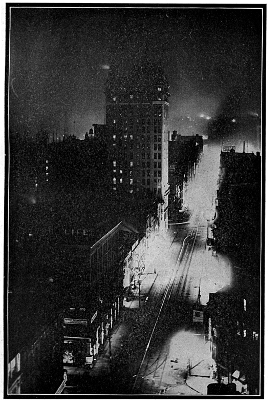
The Industry Printing Company
NIGHT SCENE IN DOWNTOWN PITTSBURGH.
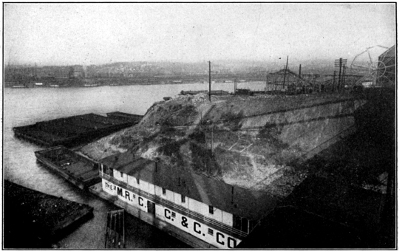
THE "POINT" OF PITTSBURGH AS IT STANDS TO-DAY.
A new retail shopping district is building up in the East End, and by
the erection of great warehouses to the north along Penn avenue, and
across the river on the South Side, a great part of the heavy wholesale
trade has been removed from the "Point." Nevertheless it is clear that
the little triangle, which is the business heart of Pittsburgh, will
remain crowded; and that with all these measures taken, the normal
growth of a few busy years will produce a congestion demanding some
radical measure of relief. Ultimately this might take the form of an
elevated structure, or a second street-story for the tapering western
end of the plat. The area thus to be raised, and so given double
capacity, is not very large, and the merest glance at the topography
shows that the bridge near the "Point", which strikes Pittsburgh
proper well above the street grade, is about on a level with the top
of the "Hump". To build a second story over the intervening streets,
reserving the lower story for heavy, slow moving traffic, giving to the
abutting buildings two street floors—and thereby increasing their rent
productiveness, would present no insurmountable difficulties either
from the engineering or the financial point of view. It is a long look
ahead, and perhaps not entirely desirable; but it would be a typically
Pittsburghian thing to do.
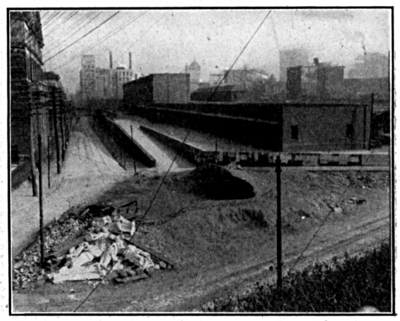
A TRIANGLE WHICH COULD BE MADE AN APPROACH TO THE
"POINT".
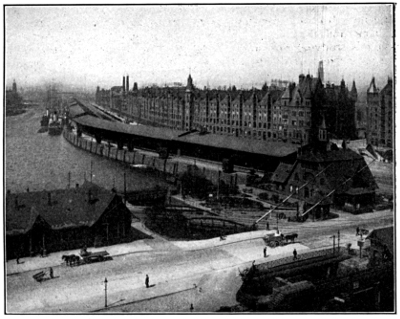
THE HAMBURG WATER FRONT.
A suggestion for Pittsburgh.
In the limited space available, there can be no consideration of the
commercial and industrial aspects of the waterfront; nor can there be
a discussion of the project for a deep waterway from Pittsburgh to
New Orleans on the one hand, and from Pittsburgh to the Great Lakes
and, via the barge canal, to New York on the other. These projects
are mentioned only to emphasize the city's need for safeguarding and
developing in some useful way every foot of river frontage that it
possesses. They would justify a careful and elaborate study of this
problem, even were the present river traffic less important than it is,
and were the need of breathing spots less urgent.
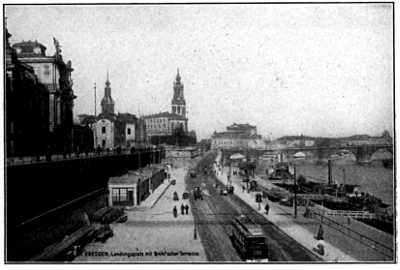
THE BANK OF THE ELBE, DRESDEN, SHOWING PROMENADE, STREET
AND SHIPPING.
As regards the traffic, slips might with[Pg 809] advantage be substituted for
the present sloping bank and floating docks. One commission is studying
this subject, and another the problem of floods. The reports of these
commissions may be awaited with confidence that their recommendations
will mean improvement. Sociologically and aesthetically, the gains will
be indirect.
As to breathing spaces, however, these gains would be direct, and
the step to be taken is yet more obvious. A great deal of river
frontage,—as along the Allegheny, under the elevated tracks,—is
not now utilized. If would be nothing derogatory to the commercial
greatness of Pittsburgh to turn this space into a park. Nobody thought
London commercially decadent when the Thames embankment was built.
Unused, waste space, in fact, reflects more seriously upon a city's
business enterprise than does the humanitarian or aesthetic use of it;
and there is no better place for a park designed as a breathing space
for shut-in workers, than a river bank with its inevitable current of
air.
The crowding of Pittsburgh's business district has resulted in
exceedingly high land values. In the whole downtown section no open
space, save the plaza before the Union Station, has been preserved for
the use of the people. Public buildings have been constructed flush
with the walk, and the streets are cramped and narrow. No sumptuous
effect is offered anywhere. One of the buildings, however, the county
court house, is the best work of H. H. Richardson. It stands on the
"Hump," at the eastern edge of the business district, overlooking to
the north a tract that is not yet improved. Two other buildings, the
city hall and post office, are so out of date that new structures must
soon take their places. Thus the opportunity has offered for a civic
center group, and there are citizens who have dared to dream and plan.
Unfortunately, however, the post office site has now been chosen at
a place where it cannot be brought into a civic center scheme. When
the choice was pending, the architects, in whose hands the matter
mainly rested, were not ready with a sufficiently definite plan. This
failure has spurred them on, and they will not be caught napping again.
A committee of the Pittsburgh Chapter of the American Institute of
Architects has now worked out a civic center plan that is not merely
spectacular, but which aims in practical ways to provide sufficiently
wide, through avenues for the transportation lines to the business
district. The plan will be best understood from the accompanying
diagram.
[Pg 810]
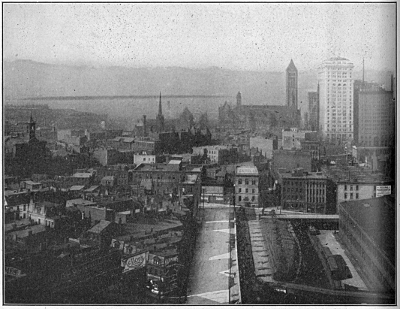
THE SITE OF THE PROPOSED CIVIC CENTER.
The tower of the court house is to the left of the Frick Building.
[Pg 811]
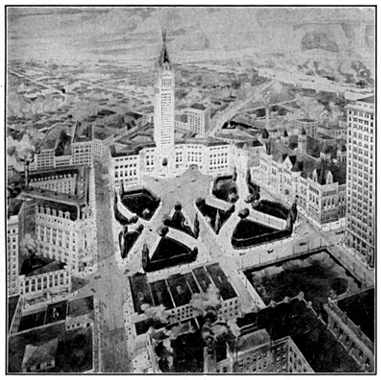
SKETCH OF CIVIC CENTER AS PROPOSED BY PITTSBURGH
ARCHITECTS.
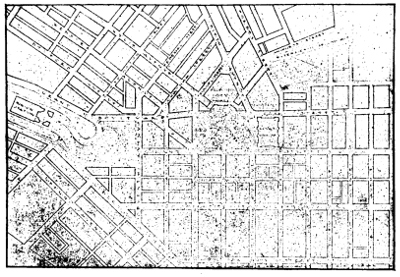
PLAN OF PROPOSED CIVIC CENTER.
[Pg 812]
It would substitute for a mean and shabby portion of the city an
ensemble beautiful and effective, and it would bring a large open
space to the very edge of a poor tenement section. Owing to the local
topography, the proximity of the improvement would not change the
character of a large portion of that section; but it would bring civic
art almost to the doors of the residents of the neighborhood. My
judgment is that the plan does not go far enough. I shall reserve my
supplementary suggestion, however, for more appropriate consideration
at another point in this paper.
One more comment might be made upon the aesthetic possibilities of
the business section before we pass to the tenement district. It is
the universal experience of towns that the first streets parallel the
water courses. As the business portion of Pittsburgh is located on
that tapering point of land where the rivers draw together at an acute
angle, it follows that streets must meet at similar angles, and the
cross streets multiply them. Very often at these intersections, small
triangles are formed, which might have been preserved as open spaces
at slight expense before the demand for building room became so great.
Although that opportunity has passed, the sharp building lot corners,
with the conspicuousness given by a directly approaching street, still
offer to architects an opportunity that is rare in American cities.
Little advantage is taken of this opportunity. The Wabash Station is
one illustration of how much more interesting from an architectural
standpoint business Pittsburgh may some day be made.
[Pg 813]

ONE OF THE MANY PITTSBURGH TRIANGLES WHICH WOULD LEND
THEMSELVES TO ARCHITECTURAL TREATMENT.
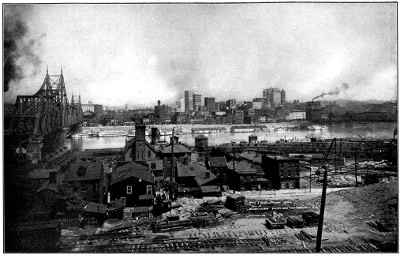
PITTSBURGH FROM THE SOUTH SIDE—A CITY OF CONTRASTS.
[Pg 814]
II.
Completely surrounding the business district of Pittsburgh, in a belt
of varying width that disregards the intercepting river, is a section
of mean streets, of crowded housing conditions, and if not of genuine
poverty, at least of the discomforts which poverty elsewhere brings.
This juxtaposition is a familiar phenomenon in urban development, for
it is based on the social necessity that the least paid wage earners
live within walking distance of their work; on the willingness, and
even desire, of the well-to-do to live at a distance from the noise and
smoke of business sections; and on the attraction which the constant
stimulus of "city" life exerts on those who have few other sources of
entertainment. That the river sides do not relieve and break up this
belt, is due in part to the local topography. Across the Allegheny, the
land is low and subject to flood; across the Monongahela, there is
only a narrow strip between the river and the highlands that, rising
steeply, offer sites with purer air and wider outlook but that must be
reached by riding. Neither river is itself attractive as an outlook for
residences.
The civic improvement needs of this poorer and crowded district may be
grouped under five general heads. These are: (a) municipal,—as the
matter of street improvement; (b) housing,—with which this discussion
does not attempt to deal; (c) playspace and opportunity for children;
(d) park provision,—which may best be considered in connection
with the similar needs of the whole community; and (e) bathing
facilities,—which here can be no more than mentioned.
(a) Municipal. The primary municipal need, in so far at least as the
region adjacent to the Allegheny is concerned, is flood prevention.
That is a city matter plus a good deal else, which will be considered
elsewhere in this issue.
The street needs are many and pressing. Conditions in this matter are
absolutely disgraceful. Narrow streets are the rule in old Pittsburgh,
and smooth pavements cannot be expected upon steep streets. But with
all possible allowance [Pg 815]for these facts, there is much that might
be undone. The streets are not all steep. Steep streets can be kept
clean,—more easily, indeed, than others. Cobblestone pavements can be
banished.
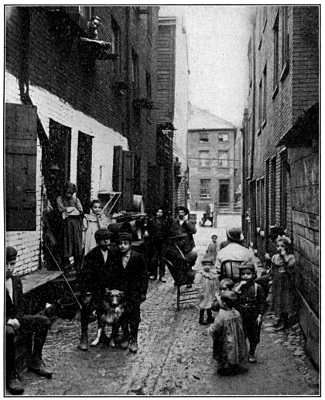
AN ITALIAN COURT IN THE HILL DISTRICT.
Well laid brick pavements, or asphalt, or smooth wood blocks where
practicable,—and all frequently flushed, are a necessity for this
region. Cleanliness, too, should be the rule in the streets and alleys
of the poorer sections; and it is here especially that the standard of
municipal administration in Pittsburgh needs raising. Only within the
past year has the public removal of rubbish been adopted as a municipal
function.
It may be profitably reflected that in no other area of the Pittsburgh
District would an equal amount of improvement affect so many
residents. With original paving costs a general tax, with sanitation in
this section a matter of prime importance outside the locality itself,
and with the borrowing capacity of the city very large, there ought
to be a pretty general reconstruction of the street surface of this
district on modern lines. Such improvement ought not to be difficult
and, incidentally, should appeal to the pride of Pittsburgh. The
stranger, arriving at any of the railroad stations, finds little to
admire in the business district. And when he leaves that, in whatsoever
direction he goes,—whether to the fashionable East End, to the
Carnegie Institute, to any of the parks, to the pleasant[Pg 816] old-fashioned
homes in Allegheny, or to the heights beyond the Monongahela, he must
pass through this dreary belt of municipal neglect. It is here that
unfavorable first impressions become fixed. These regions give a bad
character to the whole city.
The necessity for playgrounds is pressing, so pressing that an earnest,
self-sacrificing effort has been made to meet it. The work of the
modern playground gives benefit in three directions: physical, social
and educational. This is recognized by the Pittsburgh Playground
Association, an incorporated body which receives appropriations from
the municipality, supplements these with private donations, and
with the volunteer work of individuals and clubs. In recognition of
the threefold aspect of what is sweepingly called the "playground"
movement, the association conducts "recreation parks" and vacation
schools, as well as mere playgrounds. It holds the theory that "there
should be three kinds of recreation centers: first, the school-yard
for small children who cannot go more than a few squares from home;
then the larger playground with apparatus and facilities for healthy
play for all the boys and girls of a neighborhood; third, the athletic
field, where teams may meet and where the interest of the community
may center." It is clear from this that the lack of play facilities
arises from insufficient material provision rather than from inadequate
ideals. These provisions are gradually increasing but they have far
to go before they will be complete. Thirty square feet of playground
space for each child is the minimum provision recommended in Washington
and London, and in a bill lately introduced in the Massachusetts
Legislature. If the allowance seems too liberal, translate the
"thirty square feet" into six feet by five,—the size of a desk! Rich
Pittsburgh falls woefully short of this figure. Her need is for more,
and more adequately fitted, playgrounds. The poorer districts need them
most and the first provision should be made there. This is said with
due regard to the limitation of a playground's scope. The sore need for
parks located more conveniently to the immense working population, than
the present parks of Pittsburgh are, and developed more appropriately
to their needs, has not been confused with the community's need
for children's play-spaces and recreation grounds. The latter is a
separate, urgent and co-existent want, concerned, as is park provision,
with the very structure of the city, involving similarly its social
welfare, and making a strong appeal in the name of the children. Such
a survey of available sites (without buildings or with buildings of
little value) as that undertaken by the playground association the
past summer should be made the basis for the reservation of sites in
congested neighborhoods and outlying districts.
III.
The manufacturing area will not detain us long. It is no one region.
Industry is evident everywhere. Pittsburgh is held inescapably beneath
its thraldom. Two matters in particular present themselves in noting
the relation of the manufacturing plants to the improvement of the
city. One deals with their own surroundings and grounds; the other is
the smoke.
With a few encouraging exceptions, there has been little attempt to
beautify factory surroundings. The exceptions prove what can be done,
but it should be recollected that in the Pittsburgh District the
handicaps to such ameliorations are particularly great. The ground is
mostly clay and shale; smoke and ore dust are very trying to vegetation
under the most favorable conditions, work is done at tremendous
pressure, the products are heavy, and as a rule the manufacturing plots
are no larger than necessary, for actual manufacture, storage, and
shipping. Yet it would seem that the Chamber of Commerce might properly
add to its committees one that would foster this kind of improvement.
As to the smoke, Pittsburgh's most famous because most obvious
drawback, the subject has in the last two years been tackled bravely by
the Chamber of Commerce. Its campaign resulted in the appointment of
a chief smoke inspector and three deputies, attached, significantly,
to the Bureau of Health. Large powers are given to these inspectors.
The undue[Pg 817] emission of smoke is declared a "public nuisance" for
which "the owner, agent, lessee or occupant" of the building, and the
"general manager and superintendent, or firemen" are held accountable.
In support of the ordinance, two hundred business men went in a body to
the council's chamber, vigorously resisting the attacks made upon it.
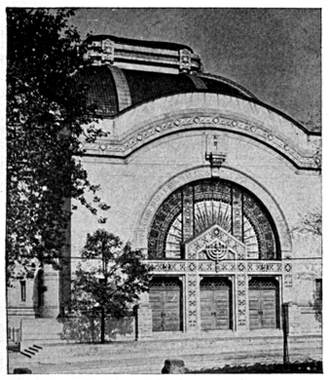
RODELPH SHALOM: JEWISH SYNAGOG.
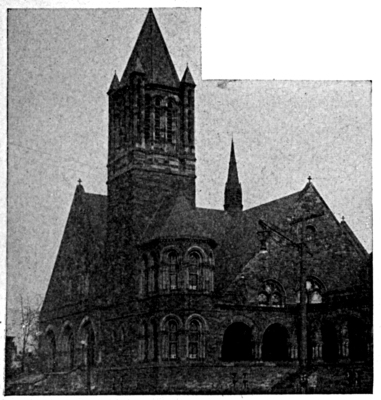
SIXTH UNITED PRESBYTERIAN CHURCH.
IV.
The East End I can best discuss under three heads: a. The residential
section. b. The educational and cultural center, which is building at
its portal. c. The approach from the business section.
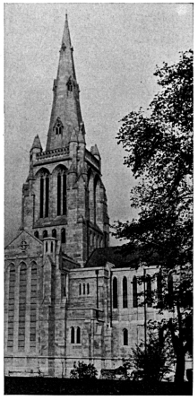
CALVARY CHURCH. Designed by Cram.
As a section of beautiful homes, the East End is at once disappointing
and satisfying. If there is the usual conglomeration of architectural
styles and if occasional atrocities in domestic construction and
landscape design for private grounds are to be found here as in other
cities,—and they certainly are,—yet the general average of the
domestic architecture and of the garden, or lawn planting, is unusually
high. This can be asserted without regard to the money expended,—since
good taste is happily not dependent on high cost. The expenditure
for both houses and grounds is certainly well above the average, but
this only increases the danger. It is to the credit of Pittsburgh's
architects and gardeners, and to that of the well-to-do citizens who
are[Pg 818] so likely to demand their own way in the creation of their homes,
that the results are so excellent. Significant in this respect is the
fact that several of the churches are of great merit; and if it be said
that the irregularity of topography readily lends itself to unusual and
charming effects in house location and lawn development, there should
be recollection of the balancing handicaps of poor soil and grimy air.
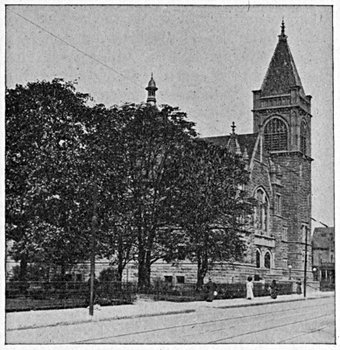
EMORY METHODIST EPISCOPAL CHURCH.
But if private work is, as a whole, of a high order, the municipal work
with the exception of some fine schools is mean, unimaginative and
weak. Here surely in street work was the place for boldness, splendor,
and large conception. Here liberal outlay was justifiable and would
probably have been popular; here, in this comparatively new territory,
obviously to be the home of the well-to-do of Pittsburgh, there was a
chance to plan for the city beautiful, to design in accordance with
modern artistic principles.
Think of what ought to be here,—the broad avenues, with wide strips
of parking at side or center; the well-built roads; the interesting
vistas; the occasional bridle paths; the rapid transit facilities,
in a reserved right of way partially planted out, where cars could
make quick time without peril to other traffic; the round points at
important intersections of avenues; and all the other beauties and
conveniences known to the modern art of city building. But see what we
actually find! The narrow streets persist. The heavy cars go rattling
and roaring along the middle of the road on protruding and dangerous
T-rails, the tracks taking a good half of the total space. The strip of
parking between walk and curb, if there be any, is hopelessly narrow.
Gaunt telegraph poles, burdened with a mesh of wires, stand where the
trees should be. Here and there billboards and lettered fences flaunt
commercialism and burlesque art in the face of beautiful homes and of
the Carnegie Institute itself. Of course, there are exceptions. There
are some short streets and semi-private ways that are good. But the
general impression of Pittsburgh's East End has been described.
If it be not too late, if the rich of Pittsburgh are willing to
contemplate a generous expenditure for the better setting of their
homes, they should secure a plan for the recasting on noble and
comprehensive lines of the whole section.
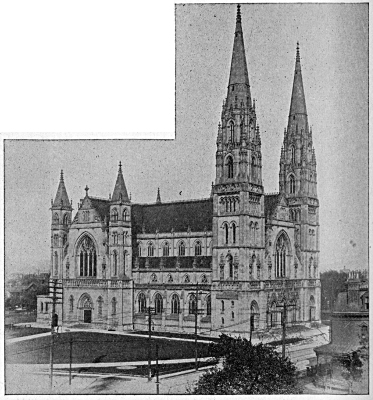
ST. PAUL'S CATHEDRAL. (Roman Catholic).
[Pg 819]
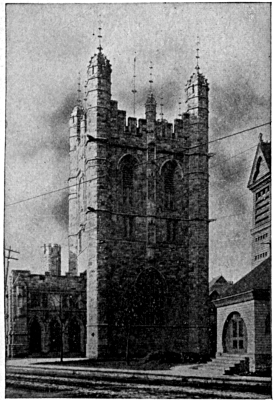
Because a few such men, who command the means to make their ideas
effective, have had public spirit, generous impulses and broad ideals,
a very interesting educational and cultural center is developing at
the portal of the East End. It is one of the few examples in this
country of consciously directed growth, though it should be added that
it has its limitations in the fact that as yet that growth has not
had professional direction, and seems still vague and uncertain as
to the general scheme. Take, for descriptive purposes, the Carnegie
Institute as the center of the scheme. We find directly west of it
the entrance,—yet to be formally developed,—of Schenley Park. On
the edge of the park and still back of the institute, the great group
of Technical schools is building. On the other, or north side of
the institute, is a valuable tract as yet vacant. A bit to the east
of this, and a couple of blocks north of the institute, is the new
cathedral, with no adequate setting and at an unfortunate angle with
the institute, but inevitably a unit of the general scheme. In the
same neighborhood the new high school is to rise. On the other, or
west side, of the vacant property is the Schenley Hotel in spacious
grounds; further north is the War Memorial Building and across from it
are the sites of the University and Athletic clubs. Then comes the new
property of the University of Pittsburgh, which is built with ampleness
of design. Back of all, reaching over a hill that will frame the
picture in this direction, lies the Schenley Farms property,—a large
tract, held at high prices for expensive development, and capable of a
picturesque and beautiful treatment,—if only that costly, commonplace
checkerboard development can be foregone, which consists of cutting
straight streets into the hills, at vast expense, to the destruction of
what is picturesque, and at the sacrifice of building area. This tract,
owing to its elevation, is so conspicuous a feature that its proper
treatment is essential to the artistic success of the whole scheme. The
architects, who, at the exhibit of 1907, displayed a plan for a civic
center, put forward also a plan for a rearrangement of the streets in
this region, for a widening of public spaces, and a tying together of
the various separated units.
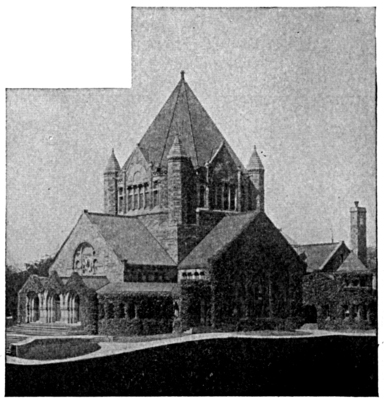
CHRIST METHODIST EPISCOPAL CHURCH.
There is need only to add that the site of this center is strategic
from the civic improvement standpoint. It not only lies at the portal
of the East End, but on the west and north the highways to the business
portion, including Grant boulevard, make it a focal point. There may be
criticism of its choice as an educational center, especially for the
Technical Schools, on the ground that it is far from the population
to whom the proffered facilities would be most helpful. But it is
approximately at the Pittsburgh District's geographical center, and
there is convergence of street car lines to within a quarter-mile's
park walk. The city itself gave the site.
[Pg 820]
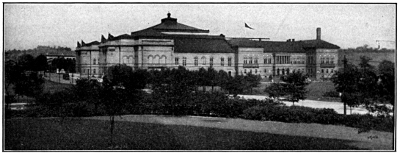
CARNEGIE INSTITUTE.
Library to Right.
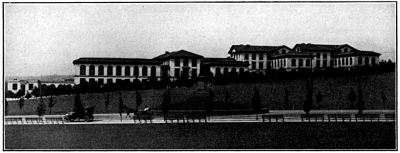
CARNEGIE TECHNICAL SCHOOL.
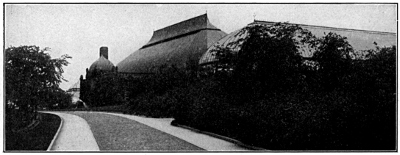
PHIPPS CONSERVATORIES IN SCHENLEY PARK.
[Pg 821]
In speaking of the civic center scheme for the business district,
earlier in this article, I held that it should be supplemented by a
larger one. This larger plan would provide a fitting approach to the
East End, and could be made to join the two great improvement projects.
Owing to the interruption offered by Herron Hill, the usual approaches
now to the East End are by Forbes street or Fifth avenue,—two mean and
crowded thoroughfares, a block apart, that parallel the Monongahela
and carry street car traffic by the shortest route to the Carnegie
Institute region and the section beyond; by Wylie and Centre avenues
(half over the hills), or in a roundabout way, by Liberty street or
Penn avenue,—again relatively narrow and crowded thoroughfares, and
for the most part meanly built up; or, finally, by Grant boulevard. The
latter, beginning near the Union Station and cut out of a hill at much
expense, was an attempt to provide a pleasant approach. Like the drives
and viaducts serving the outer park reservations, it shows imagination
and engineering skill. It is indirect, however, is too narrow to
carry the bulk of the vehicle traffic, and with its cuttings, vacant
property, sunny stretches and aggressive billboards, it is not yet
inviting but it could be made attractive by terracing and parking. The
need, however, aesthetically and practically is for an approach that
shall be better than any of these.
Forbes street and Fifth avenue run east from the jail and court house
in perfectly straight lines. They are at approximately even grades for
a mile, separated from each other by only a short block. At Seneca
street the grade changes, and from there on any joint improvement would
involve a viaduct or other device, until the streets grow parallel,
and close together again for the final half mile to Schenley Park.
Suppose the two streets thrown together in one broad and splendid
way, from the jail straight eastward for the first mile. None of the
property here is expensively built up; most of it is exceedingly
poor and shabby. There are, for the whole distance, the two streets
and an alley, a total width for the whole distance of probably at
least 140 feet that is now public property. At short intervals there
are cross streets, to the number of about a dozen; these also are
public property. And there is a school in the area to be used. Thus,
altogether, the municipality already owns, one may confidently say,
more than half of the land that would be required. The only question
is concerning its wisest utilization. It may be admitted that to buy
the intervening private plats, unifying the public property and making
it available for a single scheme, would involve large cost. But there
would be much on the other side of the ledger. Think of the noble
thoroughfare, with its special lanes for high speeding surface cars,
its quadruple roadways, one for fast moving and one for slow moving
vehicles in each direction, its lines of trees and shaded walks; think
of its convenience, its directness, its capacity, its spectacular
sufficiency; think of the increase in the value of the abutting
property. Under the Pennsylvania Law of Excess Condemnation part at
least of this value would accrue to the city, as in the case of the
great London improvements. Even in the matter of absolute (initial)
outlay, the expenditure would probably not be greater than for the
subway now proposed, while it would grant practically equivalent
facilities for transit, as far as rapidity is concerned, with many
other advantages.
Instead of expending a vast sum to give setting to a group of public
buildings, in the proposed civic center, this parkway could be made to
give the adequate setting incidentally. Certain ones would be placed
along its margin at the western end. Further, the improvement, instead
of redeeming one small space, would redeem two streets for a mile at
least. It could even be extended farther [Pg 822]
[Pg 823]by means of a viaduct or
some other device, and ultimately carried clear out to Schenley Park.
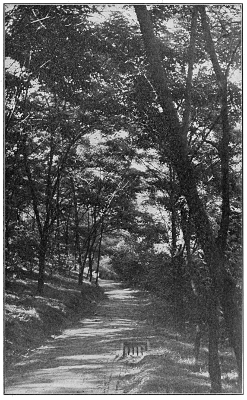
There is no opportunity in this discussion to go into the project with
detail. Even the Eastern terminus of the improvement must be left for
later consideration. But it is plain that should the avenue stop at the
mile, that much would be worth doing and would immensely increase the
comfort and decrease the delay of getting to the East End. Further, the
splendid avenue would be democratic in its benefit, since the trolleys
would have their place in it. The wage earner would go bowling home or
to business as well encompassed as the motorist. The social benefit of
that, and of the ceaseless entertainment which the traffic of the gay
avenue would offer, is to be esteemed. There is no park so popular as a
great street.
V.
Pittsburgh's built-up suburban district is varied and far scattered. It
lies along the rivers, as at Sharpsburg, in industrial towns; it lies
among the hills, as at Sewickley, in purely residential areas. It is
reached in some places by steam cars, and everywhere by trolley. It is
the home of the millionaire and of the moderate wage earner. At times
it is beautiful, and at other times it shows hardly the beginnings of
aesthetic aspiration or social consciousness. No brief discussion of
it is possible, for each separate suburban community would have to
be taken by itself. But in a general way this can be said: As nature
has given to Pittsburgh one of the most picturesque city sites in the
world, so she has done what she could to circle the city with lovely
suburbs. With sane and artistic planning, popular co-operation, and a
degree of patience, the beautiful suburb with winding roads, entrancing
views, individual privacy and communal neighborliness, might have been
secured much oftener than it has been and it might have been brought
within the financial reach of much greater numbers.
For suburbs rapid transit is essential; and that as yet has had nothing
like the development one would expect near Pittsburgh. The subway
plan involves the radiation from the loop of long, straight roads
furnishing to certain outlying sections a transportation much more
rapid than at present offered. With low fares, this should mean much
to crowded Pittsburgh. But the time to improve suburbs is before,
not after, the rush thither begins. The suburbs must act as quickly
as must the East End, the playground supporters, the designers of an
educational center, and the builders of an adequate East End approach.
In all that Pittsburgh is to do for civic improvement she must act at
once, generously and with comprehensive grasp.
VI.
With the exception of occasional ornamental spaces, and a few parks
so small that they have only neighborhood importance, the parks
of the Pittsburgh district may be said to consist of four public
reservations. These are Schenley and Highland, in the East End;
Riverview in Allegheny; and, in the older portion of Allegheny, the
reservation,—once a great hollow square,—like a New England common;
now in part relinquished to the railroads. Neither in total acreage,
nor in distribution, nor in manner of development, are these parks what
Pittsburgh ought to have.
Perhaps, of its kind, the old park in Allegheny is the most satisfying.
Located close to the homes of a very large population from whom the
country is far removed, it offers long, level stretches of greensward
where good trees cast grateful shadows, with walks that one may use
even when on business, with numberless benches that are never empty
on summer days and evenings, a little lake at one place and now and
again a fountain where the splash of cool water gives ceaseless
entertainment. It is a pity that this park was deprived of nearly half
its former area, that the railroad might have a convenient path.
Highland and Schenley, over in Pittsburgh's East End, are elaborately
and expensively "improved." You get into Highland through a monumental
entrance; costly beds of annuals confront you; from the reservoir
heights there is a superb view; in a lower corner there is a Zoo, which
is remarkably well set; and there are some charming retreats. It is
a pretty good park of its kind,—a[Pg 824] very costly, luxurious kind; and
though it is located in an expensive residential neighborhood five
miles from the city hall, a good many people get to it on holidays. It
does some social work although far from the amount desired. Schenley
does very little. The Phipps Conservatories, happily located near
the entrance, are much visited when "a show" is on; somewhere in the
inner recesses of the park there is a driving circuit, of which the
crude old grand stand looms on the landscape like a combination of
lumber yard and weatherbeaten country barn, and somewhere else there
are golf links, maintained by a private club, where you may play if
properly introduced! On the Fourth of July, fire works bring a crowd
to the park. But it is significant that while there are costly bridges
and many drives, there are no paths or walks. The cars touch only one
projecting corner, and there are no park carriages. He who has not
his own horses, or his own motor car, need not enter the East End's
Schenley Park. For it is, typically, the East End's park, adapted
fairly well to its neighborhood, but not at all serving the democratic
needs of Greater Pittsburgh.
Here is a great industrial city. The scores of thousands of people whom
the parks should serve are many of them foreigners, and the mass of
them are workers over a single piece. Practically all of them work amid
smoke and grime. The beauty of nature may be a new thought to these
people. They should be helped to appreciate it, but they must be given
first what they do understand and enjoy,—entertainment, vivacity,
and brilliancy. If Schenley Park is little visited; a trolley park
far away, where swings and boats, slides and ponies, keep something
going all the time, is crowded day by day; and when, in the moonlight,
shadows lie on the hills of Schenley, and the stars look down on
deserted though free acres, other parks that are garish with a blaze of
electric lights are thronged with people who have gladly paid a fee for
admittance. There they find something to see and to do.
Industrial Pittsburgh ought to take pride in developing the special
kind of park facilities that its population needs, and in setting
an example to other cities. A comprehensive system of children's
playgrounds would do something toward this; the proposed mall or
parkway approach to the East End, where some thousands of the
relatively poor would find, almost at their doors, a mile long open
space with its ceaseless urban entertainment, would do something more;
a system of small open spaces or outdoor social centers, where a man
could smoke his pipe and chat with his neighbors, his wife at his side
and his children at hand, would make further contribution; and the
riverside park proposed for the business district, still further. But
there should be two or three well-distributed and readily accessible
large parks that would be real municipal pleasure grounds. Here
should be ample athletic fields, a swimming pool, and a large field
house; a band playing at frequent intervals; swings and boats; cheap
conveyances that would make the whole space available; illuminations
and song festivals; and refectory accommodations, with tables placed
attractively out of doors, and wholesome food and drink at low
prices. Tired workers, going to this free public park, should find
entertainment. Little by little, and incidentally, they might learn
there the more tranquil pleasure of contemplating nature.
There are various places in Pittsburgh where such parks could be
established. One, that seems to be singularly adaptable is Brunot's
Island. There is Maple Park on the South Side. For a neighborhood park,
which by mere convenience of location and inherent interest should
invite the Pittsburgh workman out of doors, the steep bank that rises
across the Monongahela offers a site very distinctive and appropriate.
Day and night the interest of its outlook would not cease. It would
require little development. Inclined roads already scale the cliff,
and midway stations would make any terrace available. And whatever
landscape improvements were made would be visible and enjoyable from
the business streets themselves. In Allegheny such a park site is
already owned on Monument Hill.
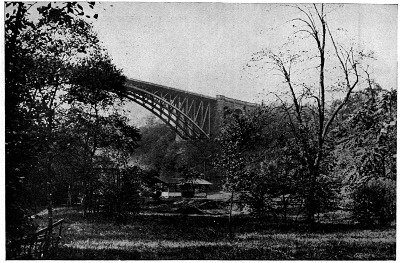
PANTHER HOLLOW.
Schenley Park.
The site of the penitentiary may some day become another available park
site, for a penitentiary in the heart of a city is undesirable. Another
wonderful park [Pg 825]
[Pg 826]site, so wonderful that it is difficult to perceive
why it has been so long neglected since track elevation has made it
available, is the tip of the "Point." To-day it is a dumping ground.
Aside from the historical and natural charm of this location, should
be noted the breadth of outlook it offers, its free currents of air,
its proximity to a large working population and the possibility of its
attractive connection with a yet larger area by means of the suggested
embankments which would practically form a riverside promenade and
parkway to it.
With the acquisition of more parks it would be possible to arrange an
interesting connecting system of boulevards and parkways. It is not
enough simply to designate an existing street a boulevard. Calling it
so does not make it so. And when Pittsburgh awakes to her greatness,
and appreciates the surpassing beauty that might be hers, there is
no reason to doubt that among other things she will commission the
planning of an excellent system of drives.
There are naturally beautiful runs, now despoiled with mean dwellings
and made little better than open sewers, that might be transformed
into parkways; and there are hills and stretches of fair country that
could be had now for a song for an outlying park system. It is true
that all this will demand money, but there are no improvements that by
long term bonds can be so justly made a mortgage on the distant future
as those for parks. School houses, fire houses, public buildings,
deteriorate with the lapse of time, but parks and boulevards become
yearly of greater value.
VII.
The final word, which has to do with the needs of the whole community,
hardly requires saying. It is a plea for comprehensive planning.
Surely, if ever a city needed the definite plan that an outside
commission could make for it, it is Pittsburgh. In most cities the
"improvement" problem is largely aesthetic. In Pittsburgh, it is also
economic and social. Its correct solution is something more than a
desideratum; it is a need.
[Pg 827]
W. W. ASHE
U. S. FOREST SERVICE
Three rivers determined the location of Pittsburgh. They have been
important factors in creating its industrial position; they are now
important agents affecting the health and earnings of thousands of its
citizens. The two score of iron and coal towns which are known as the
Pittsburgh District, fringe the banks of these rivers. Mine, factory
and furnace alternate with the residence settlements of the laborers,
and they and the railroads compete with the streams themselves for
ownership of the narrow strip of land between low water and flood
crest. With every recession of the floods, man crowds the streams, only
to be driven back when they reassert their suzerainty. Whatever can be
done therefore, to tame their caprices, to equalize their flow, either
by lowering the flood crests or increasing the low water stages, adds
to the well-being and prosperity of men who work at forge and furnace,
or go with the barges,—men whose living is from day to day, and to
whom the idle day brings want.
The flood is the open expression of the rivers' authority. But they
have another and more subtle influence. It is less direct, but it has
a wider relation to the well being of the city, not only affecting
the laborer who lives on the lowlands, but affecting all citizens
alike. The rivers and their tributaries near which Pittsburgh and the
surrounding towns are situated, furnish these in most instances with
their water supply. The character of this water affects the health of
the users, and their working efficiency.
All the drinking water used in the Pittsburgh District, except that
from artesian wells or similar primarily pure sources, has been
contaminated by the sewage of towns and villages higher up the rivers.
Through such contaminated water typhoid fever and other zymotic
intestinal diseases are widely disseminated. Scarcely a town in the
steel and coal district has not been devastated by an outbreak of this
dread scourge. The condition of Wilkinsburg is typical, its water
supply being contaminated by the sewage of more than twenty towns. The
new filtration plant for Greater Pittsburgh delivers to most of the
city a drink much superior in quality to the highly polluted waters
generally used. But filtration is only a first step toward purity, and
toward decreasing typhoid fever and the other water-borne diseases.
Filtration removes a high percentage of the pathogenic bacteria by
which these diseases[Pg 828] are transmitted; but a highly contaminated
water, such as that of the Allegheny River, purified even by the best
methods of sand filtration, is not pure water. Intelligent users must
at length realize this and demand for their own health not a purified
water merely, but a primarily pure supply, safeguarded by sedimentation
and filtration against occasional contamination. Within easy reach of
Pittsburgh and nearly every one of its satellite towns, lie abundant
sources of primarily pure supply, in the forest-protected mountain
streams.
Hitherto the cost of purchasing a forested watershed and holding it as
unproductive property has deterred cities from seeking such sources.
That difficulty no longer exists. Forest lands have now a recognized
and constantly increasing earning power. If a watershed is purchased
at a reasonable price and is well managed, it will become, as stumpage
further appreciates in worth, a valuable municipal asset. Or if a town
is small and unwilling to assume the responsibility of such management;
it can well co-operate with the state in developing a system which will
secure to it pure water, and at the same time preserve to the state the
earning power of its forests which are among its most valuable natural
resources.
Domestic water supply, however, is largely a matter local to each town
or each group of towns. But the wage earners of the whole Pittsburgh
section are yearly vitally affected by the rivers in a different way.
The earnings and even the lives of thousands, especially of those
living in the low districts of the larger cities, are threatened by
the winter and spring floods. These floods frequently result in losses
to wage earners aggregating several million dollars a year. In the
flood of March, 1907, it is estimated that more than 2,000 families
in the river districts of Pittsburgh, and an equal number in the low
lying sections of nearby cities, were forced from their homes or their
stores by high water. Quantities of personal effects were injured or
destroyed; lives were lost; and much suffering followed the winter
exposure. The effect of the flood in increasing certain kinds of
disease is shown by a comparison of the pneumonia and typhoid records
in the flooded wards of Pittsburgh. Dr. Beaty of the Pittsburgh Bureau
of Health gives us the number of cases of these two diseases in certain
wards on the North Side, which are largely tenanted by laborers, and
were partly inundated.
In March and April, 1906, when there was no flood, there were fourteen
cases of pneumonia and forty-eight of typhoid fever.
In March and April, 1907, when the flood had a height of thirty-six
feet, there were forty cases of pneumonia and 118 cases of typhoid
fever, more than twice the number of the preceding year.
During the flood the water and dwellings in these districts became
badly contaminated by human waste, since the flooding of toilets and
sewers prevented their use. At the same time many families usually
dependent upon street hydrants for domestic water had to make use
of this extremely impure river water. This affected large numbers
of people, many of them recently arrived foreigners unacquainted
with methods of securing ready relief. But a more general suffering
was occasioned by the loss in wages through the closing of large
establishments whose plants were flooded. It was estimated at the
time by one of the local newspapers that more than 100,000 people in
the Pittsburgh District were idle for an average period of a week on
account of the March flood of 1907. A typical example is the National
Tube Works, where different departments were closed from ten to
fourteen days, throwing about 10,000 men out of regular work. About
4,000 of these were employed for three days as laborers, cleaning up
after the water subsided. The same thing is yearly repeated in many
other large factories as well as on the railroads. It is no exceptional
occurrence. A similar, though less severe flood occurred two months
earlier the same year and another in March, 1908. It is indeed an
exceptional spring when there is not a flood. The losses to laborers by
curtailment of wages from this cause are seldom so excessive as they
were in the flood of March, 1907,[Pg 829] but they amount annually to more
than $100,000. Moreover, this loss takes place in the winter, when the
wage earner can least afford it.
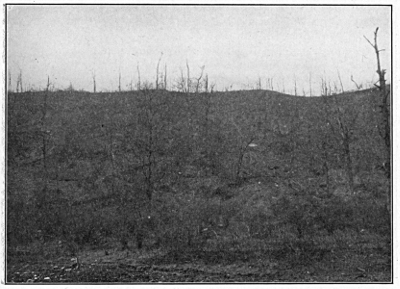
DENUDED LAND DEVOID OF HUMUS, ON THE MOUNTAINS; LARGELY
RESPONSIBLE FOR FLOODS ON THE MONONGAHELA RIVER.
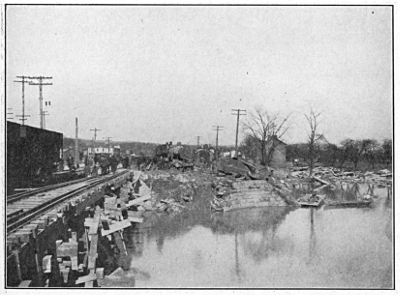
RAILROAD BRIDGE DESTROYED BY FRESHET. THREE MEN WERE
KILLED IN THE WRECK WHICH FOLLOWED.
[Pg 830]
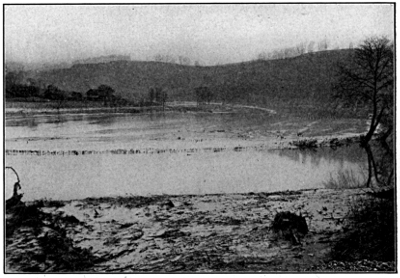
FARMING LAND DESTROYED BY FLOODS. MONONGAHELA RIVER.
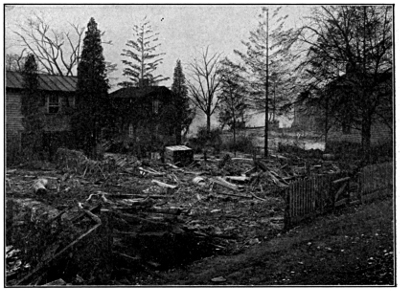
WAGE-EARNERS' HOMES ABANDONED ON ACCOUNT OF FRESHET.
[Pg 831]
The river floods cannot be prevented by local effort. Their damage is
by no means confined to Pittsburgh; it extends the entire course of the
Ohio River and its most important tributaries; its causes originate
in other states besides Pennsylvania. Although the state and even the
cities might well co-operate in certain ways, the prevention of these
floods is a problem for the Federal government to consider.
The cause of a flood lies partly in natural conditions. The run-off
of the Allegheny and Monongahela Rivers is naturally concentrated and
the highest floods occur when a deep snow on a frozen soil is suddenly
melted by heavy warm rain. But their height has been accentuated by
human agency; and this points to the two necessary phases of river
flood control work. One is the re-establishment of normal forest
conditions. This means not so much a great extension of the forest
area, although there are many steep slopes now cleared which should be
re-wooded; but it means the restocking as densely as possible of lands
which have been cut or badly burned and are thinly or partially wooded.
This is a means to an end. The forest produces a deep mat of leaves
and mould, the humus which not only has a high water storage capacity
itself but determines largely the porousness and absorptive power of
the underlying soil. This function of the forest is not incompatible
with the use of its timber. The most rapid growth of timber is secured
by maintaining the deepest humus; but the cutting of it must be
adjusted under skilled direction in order not to jeopardize the water
storage function of the soil.
Furthermore, there is need of more evergreen forests. The pine and
hemlock have been largely removed from the mountain sources of
the Ohio. But these trees prolong the melting of deep snows, even
under warm rains, for several days longer than deciduous trees. The
re-establishment of forests of conifers will therefore contribute to
lowering the crests of floods by distributing the flow over five or six
days instead of two or three. This is one phase of the work of river
control.
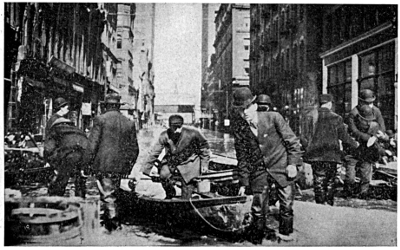
FEDERAL STREET DURING FLOOD OF MARCH 14, 1907.
On account, however, of the large areas of open farm-land that lie on
the watershed of the Ohio and that cannot be reforested, additional
means are necessary for storing the surplus storm water. There should
be storage reservoirs such [Pg 832]as are now being used at the head of the
Mississippi River for regulating the flow of the river above St. Paul.
These reservoirs must be on wooded watersheds; otherwise they will
silt up and they will hold back some of the storm water and lower the
height of floods, they will have an additional value for they can be
used as reservoirs for domestic water supply. They can also be made to
increase the dry season flow of the streams, thus furnishing a stable
water power for industrial use and permitting steady navigation during
summer and autumn when the water stage is frequently too low even for
coal barges. Thus, by means of the forests will be secured not only a
reduction in floods but also a greater earning capacity to the region
through the development of the latent power of its streams.
The rivers, then, are at once the making and the menace of Pittsburgh.
It is through the forests and by reservoirs that the menace can be
removed and the highest utility of the streams established. The purity
of the water for drinking purposes can thus be assured. This involves
a betterment in the health of the community and an increase in the
efficiency of the laborer. The equalization of the river flow can also
be thus attained. And this involves, first, the lessening of flood
losses, and, second, the increasing of the power of the streams to meet
the exacting requirements of water power development. The lowering of
the floods secures also a further betterment in health by improving
the sanitary condition of the districts subject to inundations, and
a betterment of economic conditions, both by giving the laborer more
steady work during flood and low flow periods, and by opening to him,
through the creation of new industries, a wider field of employment.
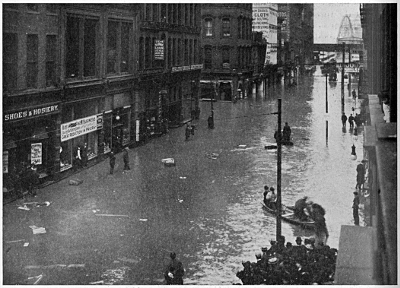
A MILE OF WATER ON PENN AVENUE DURING PITTSBURGH'S
RECORD FLOOD, MARCH, 1907.
JOHN P. FOX
SECRETARY TRANSIT COMMITTEE, CITY CLUB OF NEW YORK; MEMBER TRAMWAYS AND
LIGHT RAILWAYS' ASSOCIATION OF GREAT BRITAIN
[Pg 833]
Transit has a place in the study of living conditions in an industrial
city like Pittsburgh. Many of the workers are dependent on street cars
to take them to and from home, about their occupations, and to places
of recreation. Cheap and efficient transit can enable families living
under crowded and unhealthy conditions to move to larger, healthier,
and less expensive quarters, and still to reach their work. Low fares
and good service bring the operators in a suburban mill town in touch
with the full resources of the labor supply in the central city,
and also effect a large and direct pay roll economy for carpenters,
plumbers, painters, and other city trades whose employes move from
point to point during working hours. Again, in no place are people
packed together more closely than in the cars, under more conditions
favorable to the spread of disease and especially of tuberculosis. And
among accidents, few are more numerous, more costly to corporation and
community, and more unnecessary, than those caused by street cars.
The street railway system of Pittsburgh is a surface electric system,
under the management of the Pittsburgh Railways Company. This company
is the consolidation of many other companies, different groups of
which had previously combined. The Pittsburgh Railways Company, again,
is under the management of the Philadelphia Company, which largely
dominates the gas and electricity supply. The Philadelphia Company is
said to be controlled by nonresident investors. The present owners and
local managers may well be without personal responsibility for the acts
or omissions of their predecessors, and yet be crippled by exorbitant
obligations to them. Their legal responsibility as to the performance
of public service is, however, clear cut.
All the available through thoroughfares leading to the heart of the
city from the South Side, North Side, and East End are occupied by the
Pittsburgh Railways Company under franchises granted to its subsidiary
companies, and as a practical proposition it is impossible to construct
additional surface lines or extend surface transit facilities to new
areas providing for the growth of the city, except in subordination to
these strategic lines. This restriction of course does not apply to
rapid transit lines,—subway or elevated.
The principal franchises to these streets held by the original
companies appear to be indeterminate in duration, as in Massachusetts,
the city having reserved the right to revoke a franchise at any
time that a company failed to comply with all the conditions of the
agreement. The terms of the original franchises (the Second avenue line
being the exception to many of these points) provide for an annual
compensation to the city, either a car tax and a percentage of the net
profits or a fixed rental in place of one or both of the former. The
streets must always be kept in good repair, and in certain cases, at
least, clean (either from curb to curb, or along the car tracks). The
city sometimes retained the power to alter the conditions, and notably
reserved the right to purchase any road after twenty years, at a price
to be fixed by five disinterested appraisers. Important provisions
of these original franchises are not being observed by the existing
company. These facts must be borne in mind in discussing both the
equipment of the present system to meet the social needs of Pittsburgh,
and ways open to the public to effect improvement.
Though the steam roads have played an important part in the past,
the growth of Pittsburgh is now chiefly along electric car lines.
The radiation of surface lines from the business center out over the
district seems quite complete, especially considering the topography
of the city and the suburbs. Large areas of vacant land available
for single[Pg 834] houses, can be reached for five cents from the business
district.
While the radiation of surface lines may be satisfactory, the equipment
and operation are exceedingly unsatisfactory, as every practical man in
the railway company will admit. The present system has its base located
on the point between the Allegheny and Monongahela Rivers. Most of the
lines begin as loops through these business streets, operating without
transfers between the different lines and without through cars.
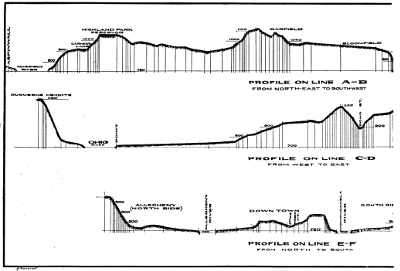
FOR PROFILE LINES AND CAR ROUTES, SEE MAP FACING PAGE
784.
A five-cent fare carries one varying distances from this business
center, before a second fare is charged. The longest ride for one fare
is about eight miles; while a continuous ride of fourteen miles on
another route, costs fifteen cents. Passengers cannot change cars in
the business center without paying two fares, and a ride across the
city and suburbs may cost as much as twenty-five cents. Free transfers,
are given between many lines before they enter the downtown district;
but no transfers are issued after 11:30 P. M., and none on
holidays such as the Fourth of July, when travel is heaviest.
The cars till recently have had no cross seats, longitudinal seats
having been used, according to the company, "to allow an extra large
capacity," viz., standing capacity. Trailers are run at the rush hours.
A line of express cars runs east from the business center to East
Liberty, through Liberty avenue, making few stops, though the speed on
sample runs was found to be sometimes slower than that of cars on the
parallel Penn avenue. The speed of the cars is fast enough for surface
operation, except when the power is poor, on steep grades or in the
congested district. The service is very unsatisfactory both as to the
few cars run and as to the amount of standing, which is inexcusably
large. The rails are of the girder type, one obsolete in first-class
systems; and are in very bad shape everywhere. The property is very
much run down, except for a few new pay-as-you enter cars. The only
real rapid transit in Pittsburgh is furnished by the Pennsylvania
and other steam railroads, the common time[Pg 835] scheduled from the Union
Station to East Liberty being ten minutes by train, against thirty
minutes by surface express cars.
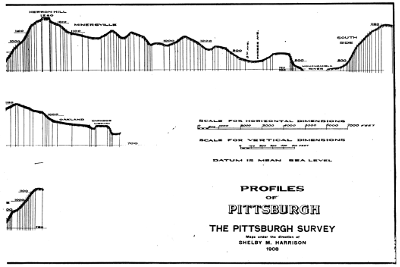
Before taking up in detail the discussion of improvements on existing
lines, it may be well to touch on the financial condition of the
Pittsburgh Railways Company, and to consider whether the property can
afford to make such improvements; for one hears the excuse for bad
conditions that the company is not earning a dividend and was forced
even to reduce the service. The Boston Elevated Railway Company, which
operates all the surface, elevated and subway lines about Boston, is
regarded as a very prosperous concern, paying dividends of from six to
eight per cent. the net earnings per car mile after paying taxes being
6.54 cents. The Pittsburgh Railways Company, according to its last
public report, had net earnings, after paying taxes, of 12.55 cents
per car mile, about double the amount of the Boston company. This is
a most remarkable financial showing, and at once raises the question,
where does the money all go to and why cannot more of the excessive
profits be diverted to better service and equipment? The Boston company
is operating to-day three subways and one elevated line, besides
having contracted to build two more subways and another elevated. It
is obvious that the Pittsburgh Railways Company could not only give a
first class service on existing lines, but could also assume the fixed
charges of a real rapid transit system, if profits were not diverted
to pay excessive rentals and other fixed charges on the many companies
consolidated at different times. Some way must be found to cut down
these exorbitant charges, for the present management can hardly expect
the public to endure existing conditions much longer, when the earnings
are so vast. People in other cities, when really aroused, have found
ways to bring the most intrenched monopolies to terms.
The congestion of cars in the business district of Pittsburgh is a
very curious phenomenon. Most people, seeing the frequent blockades at
street junctions in the rush hours, would say that there[Pg 836] were already
too many cars on the streets, and that the overcrowding is a necessity,
only to be remedied by building a rapid transit line. Others, however,
see that the terminal loops cause much of the congestion, and that by
rearranging or abolishing these, even more cars could easily be handled
in and out of the crowded center. As a matter of fact, at no place
in Pittsburgh does the number of cars passing hourly reach even half
the maximum number found possible in other cities; 43 cars in thirty
minutes was the largest number counted by the writer, against 128
cars in Berlin. The maximum Pittsburgh hourly rate on a single track
would be 86 cars; Boston has scheduled 220 an hour; Berlin runs as
many as 256; while Brooklyn handles over 300. At the busiest junction
in Pittsburgh, the writer found a rate of 276 cars an hour in all
directions, against 557 in Berlin, where there were many more vehicles
besides.
The overcrowding of the Pittsburgh cars is either intentional or due
to bad operating methods. The seating capacity of the present surface
lines has been far from reached. Take Fifth avenue at Smithfield
street, for example. In one half-hour in the evening from 5 to 5:30
P. M. about 2,290 passengers were carried east one night in
forty-three cars, thirty-two being motor cars and eleven trailers. If
every motor car had hauled a trailer, and four additional pairs of
cars been run, every passenger could have been seated, whereas 785
were obliged to stand, or more than fifty per cent of those seated.
The total number of cars in one hour would only be 144 against 256
in Berlin. If the company had cross seats in all the cars, merely
seventeen more trailers on Fifth avenue, added to the present number of
motor cars, would have seated all the passengers, with a total of only
120 cars an hour. In Berlin the street railway company provides as many
as 3,116 seats in half an hour, and the London County Council as many
as 3,538 seats, against the 1,504 in Pittsburgh.
It may be wondered how it is possible to get so many cars past as in
Berlin. It is done by fine traffic regulation by the police, who use
careful judgment, and do not hold up traffic too long in any one
direction, as is common in other cities, even in London, the home
of street regulation. Again, the Berlin tracks are so good and the
motormen so careful, that the latter operate cars over switches and
junctions at speeds which are never seen in Pittsburgh, car following
car with amazing rapidity. And the Berlin manager proposes to run even
more cars.
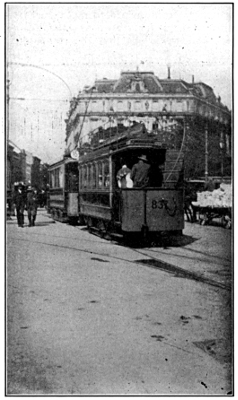
MOTOR CAR AND DOUBLE-DECK TRAILER CROSSING POTSDAMER
PLATZ, BERLIN. 557 CARS AN HOUR AGAINST 276 IN PITTSBURGH.
In no city does the writer recall so much standing required of
passengers as in Pittsburgh. It would appear to be the company's object
to run few enough cars to make people stand on every trip throughout
the day, and as nearly the whole length of each line as possible.
There is little relief during the slack hours, as every car, sooner
or later, [Pg 837]seems to have its standing load. In other cities of the
country, a marked change of policy towards the public has shown itself
in the largely increased number of seats furnished. It is a question
whether it is a good policy for any public service corporation, no
matter how securely intrenched, to continue the policies of the past.
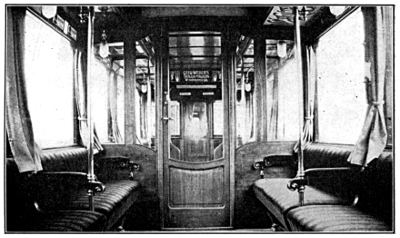
SECOND CLASS BERLIN ELEVATED AND SUBWAY CAR. FARE
3½ CENTS. SOFT LIGHTING; NO STRAPS; DESIGNED BY ONE OF THE FIRST
ARCHITECTS OF BERLIN.
It is one thing to allow a few persons who like it to stand on the car
platform; it is another to require it of mothers, overworked girls,
the tired, the ill, the infirm. No one knows how much disease is
spread through such crowding. In no place are conditions more ripe for
infection,—with the extreme of personal contact, the mixture of every
class, the constant rubbing against one another and the holding of
dirty strap. Under such conditions, when a consumptive coughs, who is
safe?
The seating capacity of a city car line seems hardly to have a final
limit, for some new way is constantly found to squeeze in more or
larger cars. To get some figures by which to judge Pittsburgh, let us
take the 256 cars run hourly on a single track in Berlin, or call it
250. If double-deck cars were run in Pittsburgh, of the same length and
width as the largest cars now in use, each could easily seat as many
as 120 passengers. This would allow a perfectly feasible capacity of
30,000 seats an hour, against a rate of 3,008 actually found on Fifth
avenue.
Why double-deck cars are not run in this country is a mystery to every
English manager and to not a few Americans. They nearly treble the
seating capacity, and yet weigh no more than our wastefully heavy
rolling stock. They give passengers decent room and air space. They
are far more economical even than trailers. Roofs on these cars are
now enclosed, and smoking is made possible all the year round. They
can climb and descend hills more quickly and safely than single-deck
cars of equal capacity, because more weight can be concentrated on
the wheels. Two types have been designed for Pittsburgh of the same
length and width as existing cars, both having an enclosed roof
adapted for winter. The higher one would have 120 seats. The other
type, low enough to go under existing railroad bridges, would furnish
ninety-eight seats on one car, with four entrances each side. If such
cars had been used on Fifth avenue the night when 2,290 passengers were
counted in half an hour, they could have furnished seats for every
person, with seven per cent excess. Only twenty-five cars instead of
forty-three would[Pg 838] have been needed, which would have required fifty
men against the seventy-five actually employed for the 1,508 seats.
To furnish more seats with trailers would cost more than the present
system; but double-deck cars would cut thirty-three per cent off the
operating expense, and the company would gain more than the immense
monetary saving. They would lose less fares, have the good will of the
public, and fewer accidents. The new pay-as-you-enter cars are the
most expensive thing with which to furnish seats, and they take twice
as long to load as a double-deck car, the introduction of which would
appear to be the wisest move the company could make, as well as the
best thing for the public.
One of the most objectionable features of the Pittsburgh railway system
is the looping back of all cars in the business district, without
either through cars or free transfers between the north, south, east,
and west sides of the city. In the expensive days of horse cars, there
was more excuse for short hauls and double fares; but for the wealthy
Pittsburgh electric system, there is no excuse for not serving the
entire district, at least within the city limits, for a five cent fare.
Boston has had through cars across the city for about twenty years,
and for ten years the company has had no higher fare than five cents
for the entire Metropolitan district of a dozen cities and towns. The
longest ride is at least sixteen miles, with free transfers given at
about forty points. Berlin has the most complete system of through
cars, connecting every part of the city for a single fare, allowing a
ride of thirteen miles or two hours for two and one-half cents.
It seems very doubtful if the present restricted plan of operation
pays nearly as well as would through cars and single fares for the
entire city. The loops tie up many cars and men in the business
district, because of the long stops at a few points and the slowness of
switching. But one thing is certain, and that is the gross injustice of
a ten cent fare across the city. Its tendency to isolate such public
institutions as the Carnegie Institute, the Technical Schools, the
University of Pittsburgh, is a very serious matter. An apprentice who
attends the evening courses at the Technical Schools three nights a
week, pays $5 a year for his tuition. If he has to ride each way, it
costs him about $7.80 a year from only the nearest part of the city,
$15.60 from the rest. Is this good public policy toward the ambitious
workman who is unfortunate enough not to live within the favored zone?
Is it good sense that the railway company shall charge twenty cents
a round trip to so many who appreciate the free advantages of the
Carnegie Institute, and thus bar many of the poorest from ever reaching
its doors? The company may reply that all such public institutions
should be located in the business district, where all lines center.
But the city must grow beyond that congested triangle, and why should
not the company's policy grow as well? The same question might be
asked in connection with the company's refusal to give transfers after
11:30 P. M., and on the holidays when travel is heaviest.
Altogether, it is not a matter for wonder that the public is a unit
against the railway.
The whole fare system of Pittsburgh needs careful scrutiny. Should
workmen's fares be introduced, to give every family a chance to live
where it can find the best house, the most congenial neighbors, and
the desirable surroundings, and yet get to work without exorbitant car
fares? The London County Council, from its workmen's homes, seven miles
out in the suburbs, gives a ride to the city, with a seat for every
passenger, for two cents at the rush hour. One London steam road gives
workmen an eleven mile ride for two cents each way. English managers
say that American companies throw away large profits by maintaining too
high fares. The question of public policy to consider about workmen's
fares is not whether more people could be carried or whether they would
pay, for foreign experience has settled these points, but whether more
riding is necessary and desirable, that is, whether satisfactory living
conditions can be provided within walking distance of where people work.
A feature of transit requiring more attention is the matter of car
ventilation.[Pg 839] The Pittsburgh company is said to be trying a method of
artificial ventilation for its cars. For such densely packed spaces,
a constant supply of fresh air is an urgent necessity. A downward
movement of warm air, if found practicable, would be the most hygienic
and economical. The car transoms should have handles attached to make
proper opening and shutting easy. At the present time, there is often
too much cold air blowing into the cars, because there is no easy way
for the conductor to close the ventilators. The coal stoves should be
banished from the interiors.
While there are spitting signs in the cars for the instruction of
passengers, some of the employes appear to be the subjects who need
most attention. The constant expectoration of motormen through
vestibule doors, and the fouling of front steps, are practices that are
not conducive to health or happiness.
To reduce the wear and tear on the nerves of the community the noise
from car operation ought to be much less. Excessive gong ringing is far
too common in Pittsburgh. Ninety-four blows in a minute is a ridiculous
frequency. One sound from a good gong is enough to inform a vehicle
that it is in the way. Too much pounding simply exasperates a teamster.
There should be very little need of gong ringing anyway. A properly
trained motorman slows down for pedestrians and obstructions, and does
not rely on the gong to get them off the track before he is too near
for safety. For the car gearing, the London mixture of sawdust and oil
should be tried in the gear cases. The London cars almost startle one
with their quietness. They are kept in perfect order, with no loose
parts to rattle, no bad rails to pound over. While the Pittsburgh rail
joints are often quiet, the tracks at junctions are in a condition
most injurious to the cars, and a cause of excessive noise, there
being actual gaps in the rail heads over which the cars must jump.
Bad track maintenance has allowed much corrugation to creep in, viz.,
little waves along the heads of the rails, which are both noisy and
expensive. The unfortunate supplanting of magnetic brakes by air brakes
will increase the flat wheel nuisance. Worn trolley wheels cause
unnecessary noise overhead. Rails on curves should be greased.
The Pittsburgh Railways Company, in its latest reports, gives no
figures for the cost and number of street car accidents. Such omission
invites close scrutiny, and there are many dangerous features about the
cars and the operation. One excellent thing in use by the company is
the magnetic brake[3], which, however jerky and sudden may be the type
in use in Pittsburgh, is in its latest form far safer than air brakes
in every respect. Unfortunately, the company is not using this latest
type, but is adopting air brakes on new cars. Air brakes are one thing
on steam roads, where rails are seldom slippery and where there is
usually plenty [Pg 840]of time to stop; but for city streets and Pittsburgh
grades, they are an added source of danger. The magnetic brake can
now stop a car in one-third of the distance that air can, and cannot
skid the wheels up to speeds of thirty-two miles an hour. It is little
affected by a greasy rail, and its tremendous reserve power makes
it almost impossible for a motorman to have an accident,—the hand
attachment providing safety in case of an electrical breakdown. The
best test of brakes yet made, which has just been completed in England,
has settled these points beyond all question.
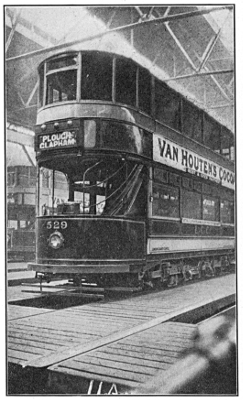
LONDON COUNTY COUNCIL CAR WITH SEVENTY-TWO SEATS. THE
SAFEST TYPE IN THE WORLD, WITH THE LATEST MAGNETIC BRAKES AND AUTOMATIC
WHEEL GUARDS.
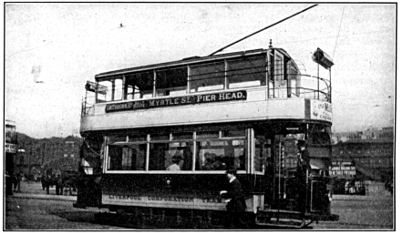
LIVERPOOL DOUBLE-DECK CAR, WHICH CANNOT RUN OVER ANYONE.
SIXTY-FOUR SEATS WHERE PITTSBURGH WOULD HAVE TWENTY-EIGHT.
With the best magnetic brakes, projecting fenders ought to be
unnecessary. Such fenders are prohibited in Europe, as doing more harm
than good. A perfect wheel guard seems really the only thing needed,
and such has been found by the city of Liverpool, which has had in use
for seven years the noted plow guard, which has pushed 415 persons off
the track and absolutely saved people from being run over. It should
be applied in some form at once on all the Pittsburgh cars. Many
Pittsburgh cars have no wheel guard at all.
To take up a few more danger points: Dim headlights, due to
insufficient power, are another source of risk. Gong ringing by hand,
the practice in Pittsburgh, is an antiquated method especially
objectionable with the magnetic brake, where the motorman must both
brake and ring with the same hand. There are no power brakes on the
trail cars,—a serious omission. Single truck cars are not safe on many
of the sharp curves, as between Forbes street and Homestead. When rails
are dirty, they should be cleaned, not sanded. The car sanders are of
a type that is useless on curves. The carrying of jacks on every car
is an excellent thing, which the Pittsburgh company was the first in
the country to adopt. But there should also be an emergency lantern, an
emergency lamp inside the cars, blocks to hold a car up, a saw, etc.,
as in Berlin. The storing of cars out-of-doors, as at Highland Park,
results in icy steps on winter mornings, and is a shiftless practice.
The Pittsburgh rule to descend dangerous grades with wheel brakes on,
instead of magnetic brakes, is exactly the most dangerous thing, as has
been shown again and again in England. The type of rail in use and the
method of laying are very unsatisfactory, and Philadelphia standards
are greatly needed. The Pittsburgh rails and their condition are
certainly an anomaly in the steel center of the world.
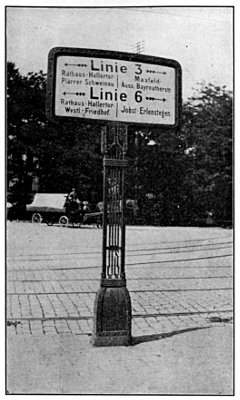
SIGN AT FREE TRANSFER STATION, NUREMBERG, SHOWING WHERE
EACH CAR-LINE GOES.
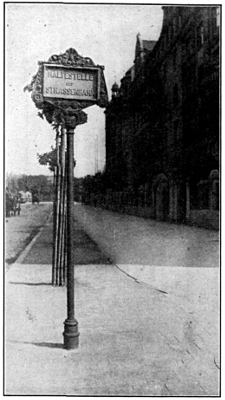
DECORATED STOPPING POST IN NUREMBERG.
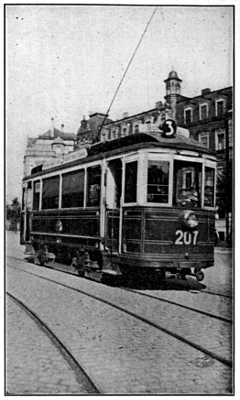
NUREMBERG MUNICIPAL CAR, SHOWING ILLUMINATED ROUTE
NUMBER USED FOR EACH LINE.
There are other matters about the system besides those affecting health
and safety which need improvement. It is very hard for strangers to
find their way [Pg 841]
[Pg 842]around. There are seldom signs on the street to show
just where cars stop, whereas in Europe every stopping place has a
printed sign. The signs on the cars are often too dim to read, and half
the time show only where the car came from, not where it is going to.
The routes of the cars are seldom given as they should be. The Berlin
sign system with its route numbers instead of confusing colors, and
such completeness that no stranger need ask a question to find his way
about is urgently needed. Every stopping place in Pittsburgh needs to
be called out, as in Boston.
The car lights should be placed over the seats, and the glare of bare
filaments avoided. If the company cannot furnish a decent voltage on
all the routes, then electricity should be abandoned for lighting
cars, in favor of the brighter incandescent gas or acetylene used on
steam roads. Windows do not open wide enough for coolness in summer,
especially on the newest cars, and they are not always well washed.
English cars are cleaned every night from top to bottom, and go out as
bright as new every morning. Even the trucks are daily cleaned with
oil. Dirty city air or passengers are regarded in England as no excuse
for dirty cars.
The immediate transit needs of Pittsburgh, then, are evidently:
First, the running of enough cars throughout the day to furnish
sufficient seats at all times and stop the dangerous overcrowding.
Second, the substitution of through routes for loops with universal
free transfers and a five cent fare at least within the city limits.
Third, the improvement of equipment and operation, so that there
shall be more healthful conditions, more safety, less noise and more
convenience.
Fourth, besides these, there should be a thorough study of present
conditions, the city's growth and needs, to determine a transit policy
for the future.

BERLIN CAR TRACKS, LAID IN GRASSY LAWNS, WITH FLOWER
BEDS EACH SIDE. THE COMPANY'S PREFERENCE.
[Pg 843]
Before taking up the rapid transit question, however, let us consider
how the improvements necessary to the existing surface system may be
obtained. Throughout his administration the present mayor of Pittsburgh
has tried to get things done. Vain attempts have been made to get
sufficient cars run and to abolish the downtown loops, with their
inconvenience to passengers, unjust fares and street congestion. Where
new lines have been needed in unserved districts, the company has
refused to make extensions except on the unreasonable and impossible
condition of perpetual franchises without compensation to the city.
Under the different franchises, large sums are due the city for car
taxes, rentals and the cost of neglected paving and street cleaning,
the total claimed by the city amounting to about a million dollars.
The present company, while meeting some obligations the past year, has
refused to pay any of these old debts, though admitting its liability
for at least a part of them, and the city has brought lawsuits to
recover the money. It would have been easy for Mayor Guthrie to have
resorted to grandstand plays. But more important than that, he has
held the company in statu quo until legal complications have been
developed and are now in shape for the city to enforce its rights.
An examination of the original franchises opens up some surprising
possibilities for the city. These grants were for different routes
and conferred no running powers over other lines. In fact, the
franchise of the Pittsburgh, Allegheny and Manchester Passenger Railway
Company contains the express provision that the ordinance should not
be construed to grant or confer upon any other company the right
to traverse the streets. As the different companies consolidated,
they neglected to obtain from the city the right to run cars over
one another's lines, and to-day the Pittsburgh Railways Company is
operating its whole system in a way which has been declared illegal in
a recent court decision. In the Erie decision, the Supreme Court of
Pennsylvania held that, under the state constitution, no street railway
company had a right to run over the tracks of another company without
express municipal consent, a city having the power to impose reasonable
regulations for the operation of lines under an ordinance.
If the Pittsburgh Railways Company intends to obey the laws of the
state, it must either break up its system into the original car lines
and operate them separately, or else it must apply to the city for a
permit to legalize its present methods of operation. In giving its
permission, the city could dictate its own terms, as long as they were
reasonable and constitutional; and it would certainly seem reasonable
to require sufficient cars and seats, the abolition of the loops,
and the universal five-cent fare as in other cities. If the company
would not accept a reasonable ordinance, it might threaten to break
up the system, and charge the public a separate fare for each line.
It would seem doubtful, however, if the courts would permit any
such burden on the public, and the company would hardly attempt to
abandon the unity of its system pending litigation. If it tried to do
so, after any decision favorable to the city, on the ground that it
could not afford to meet the city's requirements, then the courts,
on injunction proceedings brought by the city, would be in position
to probe the street railway finances, determine the real value of
the properties and what would be a fair return on the money actually
invested. This would bring out the immense net earnings of the system,
absorbed in the charges on an inflated capital, and might lead to a
complete reorganization of the companies, on a proper capitalization.
The city appears to have just the opportunity needed to bring about
the improvement of the whole transit situation, and the people of
Pittsburgh should see that the desired results are gained and that no
false move is made. The rights of company and investor would be looked
after by the courts, while the public might not only get the long
needed improvements, but also see a surplus income from their fares
available for a real rapid transit system. Such an outcome would put
the Pittsburgh surface system on a sound basis, and the company might
be the gainer in the end.
The city has a further hold on the situation, in the fact that some
of the most important franchises can be revoked for non-fulfillment
of conditions. Five, at least, of the ordinances provide that any
failure to comply with any of the terms may, at the option of the city
councils, be held to work a revocation of the privileges granted.
The failure to pay the agreed car taxes, percentage of receipts, or
rentals, and to pave and clean the streets properly makes it possible
for the city to declare forfeited these franchises so vital to the
company. The latter would then have to apply for new privileges[Pg 844] and
the city could dictate the terms.
Further, apart, from this possible right of forfeiture, the city is
secure in its right to purchase some of these railways which have been
in existence twenty years or more. By exercising this option, the city
would not be committed to municipal operation any more than Boston or
New York, where upwards of fifty million dollars have been invested by
those cities in rapid transit lines. Pittsburgh would simply own the
tracks and could lease them to the present company or another company,
too, if competition were desirable, and make terms which would forever
prevent neglect of the public interests. The cost of purchase should
not be great, as it would be fixed by appraisers appointed by the
courts. The physical property would not be very valuable after the
franchises had been revoked, for the tracks are all in bad condition.
After purchase, the city could maintain the tracks itself, laying
modern rails, and keeping the pavement repaired and clean, the rentals
paying the expense.
It seems to be the consensus of opinion of eminent legal authorities
that all grants of franchises for public utilities are made upon the
implied condition that the corporation receiving them will properly
perform its obligations by furnishing reasonable accommodations to the
public; and that when a corporation has committed its property to a
public use, the public has a right to require proper performance of
such duties under penalty of forfeiture of the franchise.
What has been said as to the city's expressly reserved powers on
certain grants may be illustrated by a summary of two franchises.
The consent of the city for the construction, maintenance and operation
of the lines of the Citizens' Passenger Railway Company was given upon
the following conditions, among other things:
First, to pay into the city treasury "for each car run over
its road," twenty dollars per annum, for the first five years;
thirty dollars per annum for the second five years and forty
dollars per annum for each year thereafter.
Second, to pay into the city treasury annually three per cent
of the net profits of said company for the first five years,
and five per cent of the net profits of said company for each
year thereafter.
Third, to keep the streets over which the road passed in good
repair from curb to curb.
The ordinance further provided:
First, that "any failure to comply with" these conditions
should be held to work a revocation of the franchise.
Second, that the city should have the right at the end of
twenty years, by giving the company one year's notice of its
intention, to acquire the road and stock by paying for the same
at a rate to be fixed by five disinterested appraisers.
This term has elapsed.
The franchise of the Pittsburgh, Oakland and East Liberty Railway
Company was conferred upon the following conditions, among others:
First, the payment of an annual sum upon each car run on the
road.
Second, the payment of an annual sum of $200 for each year
during the first five years, and $400 annually thereafter, in
lieu of a percentage of profits.
Third, that the company shall keep clean and in good repair
from curb to curb that portion of the streets on which the road
was constructed.
The ordinance further provided:
First, any failure to comply with any of its terms might, at
the option of the city councils, be held to work the revocation
of the privileges herein granted; and Second, that at any time
after the end of twenty years, the city shall have the right by
giving one year's notice, to purchase the road at a price to
be fixed by five disinterested appraisers, to be appointed by
the president judge of the Quarter Sessions Court of Allegheny
county.
This term has elapsed.
In considering the transit needs of the future, the first question
to ask is, perhaps, does Pittsburgh really need more rapid transit?
For the immediate present, if the railway company were to bring the
surface system up to modern standards as suggested, it would seem as
though the existing lines might be satisfactory for some time to come.
A number of other large American cities are getting along without
fast service, such as St. Louis, Baltimore, Cleveland, Buffalo, San
Francisco, etc. A radial city, with all its disadvantages, does allow a
short journey home, compared with a[Pg 845] badly developed longitudinal city,
like New York. And a considerable length of time can be spent daily
in travelling without harm, if conditions are agreeable, as on many
suburban lines.
At the same time, the growth of Pittsburgh needs to be directed
according to the best public requirements, and not left to the traction
company and real estate owners to work out as they see fit. Some of
the broad questions that need to be considered will be discussed
later,—such as the relative location of houses to business and
manufacturing; the extent to which walking should be provided for; the
directions in which Pittsburgh should grow. Of the more specifically
transit questions, the chief ones to settle are the routes of rapid
transit lines; the type of construction; and the best way to get lines
built and operated.
The suggestion has been made in two quarters that a highly desirable
change in the business district would be effected if the streets
could be built up to a higher level, leaving the present streets
either for pipes and wires, or for heavy and slow moving traffic.
Such an improvement would be of great benefit in case of the highest
floods; but from a rapid transit standpoint, it would give little,
if any, relief, because cars and vehicles would still be on the same
level. If two traffic levels were maintained, there might have to be
numerous inclines, which would be awkward with such narrow streets.
Still, Pittsburgh may some time have to consider the problem of cross
traffic at street junctions, and how best to abolish grade crossings of
vehicles. Chicago is trying freight tunnels; New York is considering
them; London has planned bridges at congested points, the cost of a
single one of which has been figured as high as $3,500,000. Pittsburgh
is fortunate in having so many railroad lines along the water fronts,
which must reduce the trucking through the streets.
The writer has previously advocated the running of more surface cars in
the business district. Not that more cars are desirable on the streets;
they are simply a necessity, until at least a rapid transit line can
be built, or double-deck cars be brought into use, with their great
reduction in number. The ultimately desirable thing is to remove all
cars from city streets which have become too congested for safety or
speed. The best example of such removal is of course in Boston, with
Tremont and Boylston streets. London not long since opened a subway for
surface cars under Kingsway, the new avenue across the city from north
to south, with no tracks on the street above.
While as yet Pittsburgh hardly needs for rapid transit purposes the
removal of all surface cars downtown, still it would obviously be a
great advantage in reducing accidents and giving vehicles more room.
To thus relieve the streets has been one of the stated aims of the
Pittsburgh Subway Company.
The plans of this company appear to provide for a subway system
for surface cars, consisting of a downtown terminal loop a mile in
circumference, under Oliver avenue, Liberty street, Ferry street,
Third avenue, and Grant street; a main tunnel to the east, passing in
a straight line under Herron Hill to Junction Hollow; and two branch
tunnels extending south from the main line to Brady street and Boquet
street. The company has charters for several surface lines in the East
End, to feed the subway and its branches. The main subway, sooner or
later, would be continued east under Center avenue and Frankstown
avenue to a portal at Fifth avenue. A branch tunnel is also provided
from the downtown loop, north under the Allegheny River to the
Allegheny Station of the Pennsylvania lines. The subway would be built
by private capital; it would pay the city a percentage of its gross
receipts, and be open to the cars of other companies on reasonable
terms. There would be four stations in the business district, but none
beyond, except one at East Liberty. The westbound cars would thus make
no stops after leaving the surface, till they arrived downtown; and
the longest run of five miles would be covered in ten minutes, at an
average speed of thirty miles an hour. The object of the Pittsburgh
Subway Company is obviously to force the Pittsburgh Railways Company to
use the tunnels, under the[Pg 846] fear of seeing a rival surface system grow
up, with faster service, and superior downtown facilities. Another aim
is to divert traffic from the Pennsylvania Railroad, which does a large
suburban business along its main line. The whole scheme as outlined is
very attractive in many ways, and deserves careful consideration.
Perhaps the best way to test the value of the subway scheme is to take
up every possible objection to it. One prominent feature of the project
is the treatment of the business district as a thing which cannot
be extended because of the hills to the east. So the cars would run
from the downtown loop to East Liberty without a stop. There has been
much discussion in Pittsburgh of spreading out the congested business
district; and the fact that business has reached the court house, would
suggest that the "Hump" is not the insurmountable bar to growth that it
has been supposed. It has been suggested that heavy property owners and
large stores are likely to oppose strongly any improvement which would
lessen their growing returns. On the other hand, it is conceivable
that equally powerful interests may throw their influence in an
opposite direction and a rapid transit line would afford exceptional
opportunities for real estate investment and branch stores. Fifth
avenue or Penn avenue, or both, would seem to be the proper places
for such lines to the east. While a business zone along these streets
would be narrow because of the hills, the speed of cars would make up
for greater distances; and many people might live on the hills between
these streets and walk to their work in this zone. A subway along a
street might cost somewhat more than a tunnel; but Pittsburgh can
afford to have the thing well done.
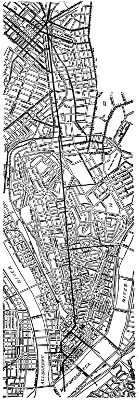
[Pg 847]
Another feature of the subway system which seems to need consideration
is the proposal to run surface cars in it. Obviously, if all the
Pittsburgh Railway cars could be put underground in the business
district, it would be a great advantage, as far as the street surface
is concerned. But of course this would not make it any easier to get
on the cars, because the loading would be restricted to four stations,
instead of being at every street corner. Again, there would be about
sixty car routes to be provided for, and 490 cars an hour, without
allowing for any increase of cars to furnish more seats. The routes and
cars would have to be divided between two tracks, so that half the cars
and routes would be on each track, viz., thirty routes and 245 cars
an hour. This traffic would obviously fill the subway at the outset,
without any room for growth, unless double-deck cars were used. Again,
it is against the new lesson of rapid transit, learned at great cost in
New York and Berlin, that a rapid transit line should have no junctions
and but one destination each way.
The speed proposed for the cars from the East End is very high; for
the running time of ten minutes from Kelley street to downtown would
require an average speed of thirty miles an hour, including the stop at
East Liberty and slowdowns for two junctions. To run at such a speed
would require block signals and automatic safety stops, and would limit
the number of cars to about sixty an hour. To use the subway to its
full capacity, either trains must be run, or else the surface cars must
be limited to the low speeds found in the Mt. Washington tunnel and the
Boston subway.
In a paper before the Engineers' Society of Western Pennsylvania, the
engineer of the subway company spoke of running trains and not surface
cars in the subway, suggesting that in time all the steam railroad
passengers from the east should be transferred to the subway at East
Liberty; all the passengers from the west alighting in Allegheny and at
McKees Rocks, taking a subway built from the business district through
Allegheny and under the Ohio River at McKees Rocks. The loop in the
business district would have two tracks, with all trains running in
the same direction around the circle. This development of the subway,
however, evidently belongs to the future, and the running of surface
cars would appear more within the bounds of possibility.
One of the most serious questions about the subway proposition is
whether it would pay. The promoters answer that they are willing to
take all the risk. But if Pittsburgh really needs rapid transit, can
the city afford to have it depend on any $10,000,000 or $15,000,000
experiment, and wait several years to know the results? A subway, to
clear expenses, has been found to require from fifteen to twenty per
cent annual income on the cost. The cost of subways in this country has
ranged from $1,500,000 to $3,500,000 a mile. The New York subway cost
about $3,000,000 a mile equipped. To make a subway pay as far as East
Liberty, would require a minimum traffic in the heaviest rush hour one
way of ten thousand passengers. It might take twice or three times this
number, according to the cost and the volume of slack hour traffic.
It seems a very grave question if a radiating city like Pittsburgh can
support such a subway as proposed, to say nothing of a system serving
adequately all parts of the city. Subways have usually turned out to be
very poor investments, as many companies have learned to their cost,
in London, Liverpool, Glasgow, Berlin. The New York subway pays only
for about half its length, a considerable part of the dividends coming
out of the surplus obtained from the elevated roads. Boston can afford
subways, because they are mere short links in an extensive system.
Subways have other disadvantages which must be carefully considered.
They might have been flooded downtown in March, 1907. On account of the
cost they can only serve a very limited territory. They are extremely
noisy. In New York, they are almost unendurably hot in summer, and
the air is filled with iron dust. They take long to build. They are
dangerous in case of fire, eighty-seven lives being lost in the Paris
disaster. If deep, as in London, many people do not like to use them,
even with elevators. The London underground roads are facing a very
serious proposition, several already being in a receiver's hands.
If shallow, they occupy or cramp the space needed for pipes, wires,
and sewers, greatly disturbing the proper arrangement of underground
necessities.[Pg 848] They put passengers below ground in a place where the
sun never shines, leaving to heavy traffic the light and air of the
streets. Their signal advantage, on the other hand, is that they remove
the traffic altogether from the street, and do not shut out light and
air from the street surface.[4]
Ordinary elevated roads are certainly not desirable in the business
part of Pittsburgh, because the streets are narrow, the buildings
high; and there is still at times much smoke. There is already quite
an amount of elevated freight structure, black and without ornament.
It is perfectly true that an elevated road can be made practically
noiseless, as notably in Paris and Berlin; and there has been no damage
to property in these cities. The Berlin structure is painted white and
is an ornament to the city; but the streets are much wider there than
in Pittsburgh.
The prospects for satisfactory rapid transit in Pittsburgh do not
appear very good, unless perhaps some form of suspended railway
should meet with approval. A German type which has had eight years of
practical operation at Barmen and Elberfeld, is now under consideration
for Berlin. Whether it would suit Pittsburgh is a question; but it has
some very interesting advantages. It would cost only about a fifth of a
subway's price; so that the same expenditure of money could serve five
times the area,—a vital point with a radiating city.
The cars could cross existing bridges, probably, without interfering
with surface traffic. Studies of routes, structure, and costs make the
suspended appear a type of railway which could thoroughly compete with
the Pittsburgh Railways Company; and if competition is necessary, it
must be of no uncertain kind. Its cars could reach the heights about
the city, without excessive grades, and open up new territory as a
subway system could never afford to. If operated in co-operation with
the existing company, it would allow a large reduction of surface cars
in the business district as soon as opened, and the removal of all
tracks when desired. On the eight mile line in Germany, not a single
passenger has been injured in eight years of operation. The suspended
line, moreover, does not shut in the streets, as does the ordinary two
track elevated structure. With double-deck cars as feeders, it seems to
offer the cheapest, most convenient, and safest means of rapid transit.
It would seem wise, if any rapid transit line is to be built in
Pittsburgh, for the city to construct and control it, as in New York,
Boston, and Paris. The city would merely have to borrow the money, and
could retain control of the road in a way to get adequate service. It
might be desirable to put the operation into the hands of trustees,
who would run the road at a minimum cost and with only a safe margin
of profit, giving the public either the largest extension of rapid
transit lines possible at a five cent fare, or else serving a smaller
territory with a lower fare. The Brooklyn Bridge railway was operated
by public trustees most successfully for a number of years, with a two
and one-half cent fare.
What part the steam railroads will play in the future development of
Pittsburgh depends on their own efforts. Their suburban passengers
would probably find a rapid transit system more convenient, because
they could reach any part of the city quickly for five cents. A
terminal for such passengers, more central than the Union Station,
is one of the probabilities and would afford an artery of no mean
significance, but still without the other advantages of a rapid
transit[Pg 849] line. The interurban business and that along the rivers could
probably be best done by the steam roads, especially if they would run
a frequent and cheap service of electric cars, as is done elsewhere.
The electrification of all the steam lines about the city would be a
great blessing, and the city should urge and encourage the matter in
every way. Till this is accomplished, much nuisance could be avoided
by a shortening of the maximum length of freight trains, which could
greatly reduce the noise and smoke, and, judging from the latest
experience, might be more economical to the roads in the end. The whole
steam railroad situation in Pittsburgh, both freight and passenger, and
the disposition of freight yards need further study, and especially in
comparison with Berlin where the main line has a five minute service
at the slack hours, suburban branches a twenty minute service, and
where the whole system is to be soon electrified at a cost of perhaps
thirty-five million dollars.
Any plans for the future transit of Pittsburgh should take into
consideration, not only the present conditions and arrangement of the
city, but also where the growth ought to be, where the healthiest sites
for houses are, and other broad questions. Transit, city planning, and
housing, are all closely related; and it may be well in concluding to
try to get a wider view of things.
Transit systems have grown up in modern cities because of the needs and
desires of people for moving about more than they did a century ago.
In the old days, when towns were small and the uses to which districts
were put were not specialized as now, people could walk to their
work, or else had space to keep a horse or two. As cities increased
in size and compactness, the keeping of horses had to diminish, and
distances grew, as well as the desires of people to go about more.
Public conveyances consequently came more and more into use; while the
constantly improving facilities, notably electricity, increased the
tendency to ride.
It would appear that the rate of a city's growth in people depends
on the amount of intercommunication, just as the intensity of some
chemical processes depends on the extent to which the different
elements come together. So transit is now regarded as a necessity, and
one which cities are beginning to feel, whatever the basis of ownership
and operation, is too vital to be exploited solely for the gain there
is in it.
Passenger transportation obviously has to meet the following
needs:—First, carrying people to and from work; second, carrying
people about their business during working hours, including shopping;
third, carrying people about on social, educational, and recreative
objects. The best transit system for meeting these needs is obviously
that which conquers space and time most equally for all inhabitants at
the lowest cost in money, convenience, safety and health. Of course
people should not do unnecessary traveling,—walking, writing, and
telephoning being desirable substitutes.
In American cities the economy of walking has been too much lost sight
of, chiefly in the matter of getting to and from work. The largest
demand on transit systems to-day is to carry people to work and back;
and yet, curiously, this ought perhaps to be the least important kind
of travel. For centuries, until a very recent time, everybody walked
to business, and the poorest classes as well as some of the wealthy do
still. The reason why so many have to live at a distance from their
work is not the mere growth of cities, but our universal disregard of
scientific town planning as practiced notably in Germany. We usually
crowd most of our business into one center, and then have to ride a
long way to get enough room for a single house. But congestion on
transit lines is just awakening us to the fact that the common radial
plan for a city is neither wholly necessary nor desirable.
It would look now as though the ideal city is a longitudinal one, with
factories on the leeward side, after the European plan as found in
Vienna and the new city of Letchworth, England; houses on the windward
side away from the smoke; and stores and offices between. The whole
city is narrow enough to enable people to walk across town to[Pg 850] and from
work, their homes being opposite their place of work or business. One
or more high speed longitudinal transit lines would make the length
of the city no greater bar to travel than getting about our congested
business districts which are so often without even adequate surface
transit. The ideal of universal walking to work, were it possible,
would obviously abolish the rush hour travel, the cause of so many of
the worst features of American city transit.
With existing, radial growing cities, it would seem best to try to
replan on the longitudinal system as far as possible, modifying the
ideal to fit topography and other present conditions. A rapid transit
line is the best thing with which to begin the stretching out process
in a city where no such facility already exists. By rigidly limiting
the heights of buildings to the standards so successful in Europe, and
then in some way preserving belts of houses alongside the business
district as it begins to stretch, congestion may at least be checked.
Of course it is impossible at this late day to provide many single
houses within walking distance of a business district, though Boston
has notably done so for both rich and poor with its Back Bay, Beacon
Hill, and the West and North Ends.
But the conditions of Pittsburgh allow no simple alteration to fit the
ideal plan. No single transit line can serve both sides of the Ohio, or
the four shores of the Allegheny and Monongahela Rivers. Again, the
question should be considered very carefully whether people ought to
live too near the manufactories, on account of the smoke and the noise;
and therefore whether the walking principle ought not to be waived in
such a manufacturing region, and all the workers be transported up
on the bluffs or beyond, where the air is purer, where more land is
available for single houses, and where they can have quiet, healthy
homes, making more efficient workers. If the smoke were not still so
abundant, the fast transit lines should best lie along the rivers, with
a belt of houses on the heights above. But as conditions are, the most
desirable locations for houses are away to the east, north, and south
of the business district, and so perhaps these are the regions which
should first be made more accessible to the heart of the city.
The location of rapid transit lines in Pittsburgh obviously needs most
careful study. It does not seem enough to connect East Liberty with the
business district by a straight line, without serving the intervening
territory. The situation needs the broadest study and outlook and the
united judgment of the best minds in the city. A transit solution
cannot be left to any interested company, but needs to be reached by
considering the welfare of all the inhabitants, future as well as
present.
H. V. BLAXTER
ALLEN H. KERR, Collaborator
MEMBERS OF THE ALLEGHENY COUNTY BAR
[Pg 851]
To fifty-nine aldermen is taken practically all the minor litigation
of the four to five hundred thousand persons in Pittsburgh. To them
the law entrusts all the preliminary matters connected with criminal
prosecutions. To the educated public these courts are little known,
perhaps because the amounts involved in litigation are small,—never
over $300,—or because the proceedings are criminal in nature. But to
the majority of Pittsburgh's vast army of foreign born, the squire's
office is the only contact with law or justice. It is here that the
wage earner, the alien, the Slav or the Lithuanian, comes first in
criminal matters; it is here that the ignorant and illiterate enter
their civil suits. This is the court of the people, such as it is.
Viewed thus, the aldermanic system is lifted from insignificance
to rank as a vital question of municipal government. An ancient
English system supplied the model, which aimed to decide small cases
quickly and with substantial justice. But, as the system works out
in Pittsburgh to-day, it for the most part achieves no such end and
is a reproach to the community. For Pittsburgh has been a city too
busy for introspection. A crowded center echoing with the thunder of
steel mills, vast industries giving employment to alien laborers, the
insistent cry of "tonnage" and the absorbing demands of business, have
offered little opportunity for social study or civic experiment. It is
not that Pittsburgh is derelict; her charities are many and generously
supported, but Pittsburgh is busy, very busy, and the public have not
taken time to think. Nowhere is this ignorance of home conditions
more apparent than in the matter of the courts, and especially of the
aldermanic courts which are to be considered here.
Before aldermen, informations or the formal charges of crime are made.
Warrants for arrest issue from their offices. Hearings are held,
the defendant is committed to jail, or bail is allowed. Summary
convictions may be had before them, so that not only property but
personal liberty is subject to their decisions. What this means can
readily be understood when it is known that in 1908, 15,879 persons
were incarcerated in Allegheny county.
To begin with, the whole aldermanic system is an anomaly in the
growth of institutions. It is taken from the middle ages, only partly
altered, cut, and fitted to modern conditions and a freer people. The
origin of the office is obscured in antiquity. In Gothic times they
had conservators of the peace, whose duty was, as the name implies,
that of keeping the public peace; and during the troublous times
when Queen Isabel deposed her husband and put Edward the Third on
the throne, the King, fearing a general uprising, sent out writs of
peace to all the sheriffs, and Parliament ordained that good men and
true be assigned to keep the peace. At the foundation of the Colony
of Pennsylvania, the office of justice of the peace was brought
over from England, and became an integral part of our governmental
institutions. Under successive state constitutions the power of the
aldermen and justices of the peace has been gradually enlarged, and
their jurisdiction greatly widened. Aldermen are elected for a term of
five years. Formerly their jurisdiction was limited to amounts under
forty shillings, but gradually it has been increased to $300. In cases
where the amount involved is less than $5.33, the equivalent of the
old forty shillings, there is no appeal from an alderman's decision.
Litigants for so small an amount are in most instances very poor, and
a hardship is wrought when such cases are wrongly decided. Another
very radical disadvantage of this provision is that it permits the use
of such tribunals for purposes of spite and oppression. A landlord
recently refused to relet a tenement.[Pg 852] An altercation followed which
ended in the tenant's saying that he would get even at the squire's
office. Thereupon he entered suit for five dollars for an imaginary
debt. At the hearing this debt was denied by the landlord. No proof
was offered that it existed; nevertheless the justice promptly awarded
a judgment for five dollars, and, the amount being less than the old
forty shillings, the landlord had no choice but to pay.
The very topography of Pittsburgh has influenced the growth of
aldermanic litigation. The business district is crowded into a small
triangle, hemmed in by two rivers. In consequence the aldermen in the
four wards comprising the business section get a tremendous clientele.
Furthermore the city has been redistricted and in the future there
will be but twenty-seven aldermen, one for each of the new wards,
instead of fifty-nine as heretofore. When it is known that some of the
downtown aldermen make $12,000 a year from fees, under the present
ward arrangement, an idea can be gathered of what will be the income
of the aldermanship under the new districting which throws the heart
of the business area, approximately the first four former wards, into
one new ward. Of course ward lines are important only in the election
of aldermen, for once elected their jurisdiction properly exercised
extends over the whole county. A case may be put in the hands of any
alderman whom the plaintiff may desire.
In appearance the average alderman's office is not prepossessing. A
counter flanked by a railing, a few chairs, a safe and a number of
dockets, compose the usual furniture. The floor is nearly always bare,
generally dirty, while outside the appearance of the office is much
that of any shop desiring customers. Often an electric sign or gaudy
lettering on the building, or other similar device is employed to
make the location of the office conspicuous. With few exceptions, the
offices are on the lower floors, usually opening like a store directly
on the sidewalk. Where the ward boundaries permit, they are put on
the main thoroughfares, sometimes so close together as to be within
sight of one another, which naturally results in the sharpest kind
of competition. The more progressive aldermen indulge in advertising
and it is a common sight to see blotters emblazoned with the name or
the alderman, his address and telephone numbers, distributed among the
downtown offices. Yet these are state judicial offices presiding over
subordinate courts!
Each alderman has a constable who is elected at the same time and in
such ways as makes the office largely political in complexion. In
many offices the alderman and the constable do all the work. But in
the downtown offices there are usually in addition to the alderman, a
docket clerk, a writ clerk, and perhaps two deputies. The constable
is not only the major domo, but usually the business getter of the
outfit. It is he who mingles with the people of the ward and steers
litigation in the direction of his employer. All this is to his
benefit, because, like the alderman, his income is derived from fees.
Such constables have often made as much as twenty dollars a day in the
sections of the city settled by foreigners, but this is not the rule
now, partly because the aliens are less ignorant and partly because of
the influence of many national, fraternal and charitable organizations.
However a conservative estimate of the income of the downtown
constables at the present day would be $3,000.
The business of an alderman is to get customers, try cases, prepare
informations, execute commitments and various other legal documents.
In civil cases, it follows from the very organization and jurisdiction
of aldermanic courts, and the fact that the litigant may choose his
tribunal, that the aldermen are often called upon for legal advice and
opinions even in advance of the actual litigation. Each alderman knows
that if he advises the complainant that he has no case another alderman
will be consulted. If the latter advises suit the costs will go to
him. As an alderman depends for his living on fees from litigation
instituted in his court, it is not hard to find one who will tell you
that you have a good case.
Not long ago a landlady and two boarders,—a man and his wife,—became[Pg 853]
involved in a teapot tempest, during the course of which the landlady
pointed a revolver at her boarders. A squire was consulted, who advised
an information for surety of the peace. The proceeding under an act
of assembly for pointing firearms would perhaps have been proper, but
there was clearly no case of surety of the peace. The case came up
for hearing and after a long dissertation couched in legal verbiage
the squire pronounced his judgment that the case be discharged and
the costs divided. The plaintiff, who was represented by an attorney,
immediately refused to pay and asked the squire what he was going
to do about it (by act of assembly execution cannot issue for costs
alone). The squire was nonplussed, and called in his constable. After a
whispered consultation, he announced that he had reconsidered and that
his final judgment was that the case be discharged and the costs put on
the defendant. By this time the defendant had got her cue. She refused
to pay, and asked the squire what he was going to do about it. Another
whispered consultation followed while the squire scratched his head in
perplexity. Another reconsidered judgment was given, this time that the
case be discharged and the costs put on the county.
Not only do the aldermen give advice concerning prospective cases, but
they solicit business and it is very common for them to hold themselves
out as collecting agencies. Some aldermen who make a specialty of such
work have a printed form reading:
Claim against you for $________ has been put in my hands for
collection. Pay at once and save yourself costs.
If the claim is paid without suit a percentage charge is made for the
service; if the defendant ignores the notice the alderman will enter
suit. In short, we have here the anomaly of a state judicial officer
whose living depends on the business he can drum up, and who can be
both counsel, judge and prosecutor. From this it results that when
a case is brought in an alderman's court, the alderman, the judge,
considers himself in the employ of the plaintiff.
At a recent hearing before an alderman, who is without exception one
of the most upright and efficient in the city, the evidence of the
plaintiff was very uncertain while that of the defendant was clear and
convincing. The squire "reserved judgment," which means that he did not
wish to give his decision in the presence of both parties. The case had
been conducted by an attorney who controlled considerable aldermanic
business, and this attorney not long after reaching his office was
called to the telephone by the alderman who said in substance:
"Now look here Mr.——, if you think you ought to get that money in
that case of yours I will pay it myself, but I really cannot find
for the plaintiff because I honestly think the defendant has a good
defense." Only an incident, but what a flood of light it throws on the
attitude of the alderman toward the plaintiff.
Few cases are decided otherwise than in favor of the plaintiff. Exactly
what proportion can never be known, because our courts have decided
that the dockets of aldermen are private records and not open to
inspection by the public. One judge on the Common Pleas Bench, a man
who has wide experience in such matters, when asked if he thought that
as much as one per cent of the cases are decided other than in favor of
the plaintiff, replied, "No, not nearly." As a matter of fact judgment
is so universally given for the plaintiff that a defendant who has had
any previous experience, does not take the trouble to appear at the
hearing, but if he desires to contest the matter, takes an appeal from
the alderman's decision.
It is a wise requirement of law that a plaintiff must make out his
case affirmatively, proving all the matters essential to constitute
liability on the part of the defendant. It is a matter of common
knowledge, however, that aldermen give judgment on evidence of the
most meager kind. A copy of a bill, its correctness unsworn to,
left with the alderman is a common way of obtaining judgment for
goods sold and delivered. Suits may be entered before more than one
alderman, and in such cases although but one execution may issue, a
defendant can be[Pg 854] harried by threats and a multiplicity of summonses.
In such cases, aldermen and their constables although legally without
power, may when in league with unscrupulous creditors, be the cause
of the greatest injustice. Cases have been known where constables,
although knowing that a levy could not be made, would, nevertheless,
frequently visit the house of the defendant, post notices of sale,
demand admittance in the middle of the night, and in many other petty
ways harass the defendant in the hope of forcing the payment of their
costs. It is well known that much hardship is done in Pittsburgh
through the instrumentality of what are known as "loan sharks," who
lend small amounts at usurious rates of interest, taking as security
assignments of future wages, bills of sale of household furniture,
and other personal belongings. The defendants in such cases, although
they are protected by law, are usually poor and ignorant, have little
knowledge of legal procedure and fall an easy prey to the threats of
such unscrupulous creditors. It can readily be understood how much such
usurers are assisted by unscrupulous aldermen and constables.
Primary in importance to the alderman is the problem of getting his
costs. Not long ago a well-to-do man residing in the residential
section bought some cider from a huckster and ordered some apples.
The cider was left in the barrel and the apples were to be brought
the following day. When they came they were refused because of their
poor quality. The huckster in a rage demanded the barrel in which he
had left the cider, although both the apples and the cider had been
paid for. He was told he could have it in a day or two, as soon as it
could be emptied. He left to seek the advice of a squire who advised
him to make an information for larceny by bailee (the technical term
meaning larceny of goods temporarily in one's possession). He did so
and a warrant was issued for the defendant's arrest. He was arrested
and appeared at the alderman's office with bondsmen. Bail was refused
by the alderman on one pretext and another and the defendant was told
that if he would pay the costs the alderman would see to it that the
whole matter was dropped. Before the hearing the squire had gone to the
defendant's business office and told him that if he would pay the costs
the matter could be fixed. Needless to say, rather than spend a night
in jail while new bail was being secured, the victim paid the costs,
preferring to be mulcted a few dollars than to incur the notoriety and
annoyance of carrying the matter to a higher court.
Under such manipulation it is not difficult to see how large a volume
of litigation may be instituted in the aldermanic courts. Of course
this case is exceptional and there are many aldermen who never seek
business or advise frivolous litigation, but even without it the
volume of business is incredibly large. Some of the downtown aldermen
have had as many as 500 civil cases brought in their courts in a
month. Of course if there is any real controversy involved the case is
appealed, but in practically all the cases the costs are paid either
on appeal or by execution, the law making costs a first lien on the
fund realized. A compilation of the costs paid in three hundred cases
shows the average costs in each case to be $3.74. Formerly these costs
had to be paid before the appeal could be taken, but by a late act an
appeal can be taken without payment of the costs, if satisfactory bail
be given for debt, interest and costs. However, the act works little
benefit, because the alderman is the judge of the sufficiency of the
bail and has it in his power to reject bondsmen until it is quicker
and easier to pay the costs than bother over the allowance of bail. So
that, as a matter of fact, the costs are always paid on appeal. Taking
the downtown aldermen's offices where the cases sometimes number 500
in a month, the income from fees would be about $1,800 a month, which
after allowance for fixed charges would leave a monthly profit to these
downtown aldermen of about $1,000 in civil suits alone.[5]
To these fees, to form some estimate of [Pg 855]the income derived from
some alderman-ships, should be added the costs paid in criminal
cases which an average of one hundred cases taken at random from the
criminal docket of a prominent downtown alderman show to be $4.15
in each case. In criminal cases, if the defendant is discharged the
alderman's costs are paid by the county. This procedure further adds
to the revenue of the office. In 1907 the county paid to the various
aldermen and justices of the peace the sum of $17,884.40 for costs in
such discharged criminal cases, and to sundry officers in such cases
$8,840.05, or a total of $26,724.45. To one alderman alone, having an
office in a downtown section largely settled by Negroes and the poorer
classes, $1,711.55 was paid in 1907 by the county as costs in such
discharged criminal cases brought in his office. For miscellaneous
work, criminal and otherwise, fees are paid in accordance with a
schedule set by a recent act of assembly, that of 1893. Some of the
main items are given below.
| Aldermen's Fees. |
| For information or complaint on behalf of the commonwealth |
$.50 |
| Docket entry on behalf of the commonwealth |
.25 |
| Warrant |
.50 |
| Hearing in criminal cases |
.50 |
| Taking bail in criminal cases |
.50 |
| Entering judgment |
.50 |
| Discharge of jailer |
.35 |
| Hearing parties |
.50 |
| Holding inquisition under landlord and tenant act |
2.00 |
| Entering action in civil case |
.25 |
| Summons |
.25 |
| Entering satisfaction |
.15 |
| Written notice in any case |
.25 |
| Execution |
.30 |
| Transcript of judgment |
.05 |
| Return of proceedings on certiorari |
1.00 |
| Receiving the amount of judgment: |
|
| If not over $10 |
.25 |
| $10 to $40 |
.50 |
| $40 to $60 |
.75 |
| $60 to $100 |
1.00 |
| Assignment and making record indenture |
.50 |
| Marrying each couple and certificates |
5.00 |
| Constables Fees. |
| Executing warrant |
$1.00 |
| Conveying defendants to jail |
1.00 |
| For executing bail piece |
1.00 |
| Executing search warrants |
1.00 |
| For serving subpoena |
.50 |
| For arresting on a capias |
1.00 |
| For notifying plaintiff where defendant has been arrested |
.25 |
| For advertising sale of goods |
1.00 |
| For holding appraisement where exemption is claimed |
4.00 |
| For attending election |
3.00 |
| For travelling expenses in the performance of
any duty required by law, for each mile
travelled |
.06 |
It is evident that the office is lucrative, and lucrative just in
proportion to the ability of the alderman to get customers. The
anomaly extends to every branch of the office,—a state judicial
officer with an income depending on the volume of the litigation
instituted in his office.
It was a wise provision of the Legislature that permitted appeals by
right, rather than by allowance, providing the amount involved is over
$5.33. Practically all cases therefore involving any real controversy
are appealed. A defendant is given twenty days in which to take his
appeal. The procedure is simple, a transcript or copy of the alderman's
record is obtained, the costs paid or bail given for debt, interest
and costs, and the transcript then filed in the higher court where the
case is begun over again just as if it had not been already tried. As
the discretion of the alderman in allowance of bail is a factor, the
costs are generally paid at the time the appeal is taken. In any case,
they must be paid then or when the appeal is disposed of. If they are
not paid at the time the appeal is taken, when the case is disposed of
in the higher court, the alderman's costs are kept out of the amount
realized and may be demanded by the alderman, his transcript being the
evidence from which the higher court determines what disposition has
been made of the costs. Cases have come to the writer's attention where
although the costs were paid at the time of taking the appeal yet the
alderman's transcript has been endorsed, "Costs not paid by defendant."
If such a transcript were filed without the detection of the error,
upon final disposition of the case the alderman would be in a position
to demand his costs a second time from the prothonotary of the higher
court and receive double pay.
Remembering that every case appealed from an alderman is retried,
with costs to be paid over again, it is interesting to consider how
much time is occupied by the Common Pleas Courts in such review work.
In Allegheny there are four Common Pleas Courts. As the courts are
separate and independent, litigation may be commenced in any one of
them. So great has been the litigation in recent years that all these
courts are far behind[Pg 856] in their work, two being at least four years
behind, the others at least two. Taking at random a term,—three
months' business,—in one of the courts which is four years behind, we
find 1,342 docket entries. It would be safe to say that about 1,000
entries would represent new suits, which should in due course result in
jury trials. Of these 322 were cases appealed from aldermen, i. e.
work already done and paid for, to be done over again. In these cases
counting the costs actually paid we have a total of $1,322.08, and
this in one term of one court. There are four terms to each court and
four courts. The time occupied in retrying appeals from aldermen can
be appreciated. In 1897 it was estimated that one-fourth of the work
of the Common Pleas Courts consisted of the re-trial of such appeals
with an aggregate of about $12,000 paid for costs in such cases prior
to their determination in the Common Pleas Courts. From the figures
previously given it appears that the proportion is about the same now
although the increase in the volume of litigation has swelled the costs
to about $15,000.
Taking four consecutive terms, one at each court, we find 667
alderman's appeals in the two courts which are four years behind,
and 105 alderman's appeals in the two courts which are two years
behind. By law an affidavit is required with each appeal that it is
not taken for delay, but the above figures indicate that this oath is
disregarded. So much for civil matters, where only money and time are
involved. It is the criminal side of the alderman's court where liberty
is involved, that arouses greatest sympathy. Summary convictions, or
proceedings under special statutes where the aldermen can impose a fine
and commit to jail on default, and proceedings for the determination
of the existence of the essentials of a crime, comprise the criminal
jurisdiction of an alderman just as it stood in the reign of Edward III
in the fourteenth century.
Criminal proceedings generally are instituted by a warrant of arrest
issuing upon a complaint under oath,—an information. From this
information made before the alderman a warrant issues on which the
accused is taken into custody. A hearing must then promptly be held;
and the alderman decides whether there is sufficient evidence to hold
the defendant for court; if so the prisoner is held for bail if the
offense is bailable, or committed to jail in default. The alderman must
then within five days return a transcript of this proceeding to a clerk
of the Court of Quarter Sessions, this court being the criminal court
of the county. Considerable hardship may be done by the failure of the
alderman to return his record within the five days required by law;
cases have been known where through neglect prisoners have been kept in
jail a month before the matter has been brought to the attention of the
district attorney's office and the alderman made to produce his papers.
It will thus be seen that although the alderman acts in this respect
only as a committing magistrate, yet on his decision rests whether the
prisoner be committed to jail; for although the offense may be bailable
the question of bail in the case of poor people is very material.
The writer has known cases where bail has been set at $1,000 on an
information for assault and battery.
The power to arrest is a very important one which under any
circumstances should be exercised only with sound discretion. One
constable in Pittsburgh arrested a foreigner at night. Having no
warrant he took him to an alderman's office, where he found the
alderman out, and pretentiously used the telephone to locate him, with
no results. Then substantially the following conversation took place:
"Now —— you, I will be the squire myself," taking his place behind
the railing.
"How much money have you?" The prisoner was found to have a few dollars
on his person.
"Well you are fined $—— (the exact amount the prisoner had with him)
and discharged. Now get out."
The fine was pocketed and the prisoner permitted to go. It is probable
that the constable was drunk, but the abuse is only the more apparent.
In another case an educated German was studying manufacturing methods
and[Pg 857] spent much time in the neighborhood of the steel mills. One
evening he saw an alderman's constable, whom he knew by sight, on a
street car handcuffed to a prisoner. With Teutonic curiosity he asked
the details of the case. The constable, who was under the influence
of liquor, beckoned the German over to him and deftly handcuffed him
also. The German, of course, thought the affair a little joke. He was,
however, taken to jail, but refused by the warden, because there was
no warrant for his confinement. The constable then took the prisoner
outside, and when they reached Diamond street asked him how much money
he had. The German really had $600 or $700 on his person, but replied
that he had only a few dollars, producing some bills and small change.
The constable told him he would release him for $3.50. This the German
paid and got his liberty. The latter was leaving the city the next day
and, as he was a steel expert representing a foreign government, could
not possibly remain to prosecute the constable. It is not likely that
such abuses are common, but their existence indicates the possibilities
of abuse of a system which provides for no form of supervision.
There are costs connected with all these criminal matters. These
costs the defendant if guilty is supposed to pay. But the fact that
an alderman entertains a frivolous information does not prevent his
being paid for his work. If the case is discharged the county pays.
If the prisoner is committed and the case ignored by the grand jury
the county pays. The percentage of bills ignored by the grand jury is
sometimes as high as seventy-two per cent. This means that seventy-two
per cent of persons brought before the alderman have either been put in
jail or held for bail on evidence not sufficient for the basing of an
indictment. In all such cases the aldermen are secured in their costs,
and as we have seen in 1907 the costs returned in such discharged
criminal cases to the various aldermen and justices of the peace and
sundry officers amounted to $26,724.45. Taking the year 1907, we find
that for the support of the criminal court the county was put to a
net expense of about $150,000. By law aldermen must pay over to the
county all or sometimes a proportion of fines collected depending on
the special act of assembly. These fines are supposed to be voluntarily
accounted for, and up to very recently very little attempt was made
to test the accuracy of such returns. In 1896, however, the county
controller inaugurated a system of auditing the criminal dockets of
aldermen for the better ascertainment of the county's share of such
fines. The returns that year increased seventy-five per cent and have
been increasing steadily ever since, although in 1907 the total amount
returned to the controller in such cases was but $3,714.20.
In brief the whole aldermanic system is defective. At the threshold
we find an office the income of which is derived from fees, depending
upon the volume of business. Plaintiffs are customers, the more the
merrier. Impartiality is impossible, and decision on merits almost
unheard of. The fee system, which causes the injustice and corruption,
has come down to us from colonial times, a relic of the days when the
public purse was too lean to permit paying salaries to minor judicial
officers. From a wise public economy this fee system has become, with
the growth of the country, a source both of injustice and of extreme
expense to the public at large. It should have been abandoned long ago,
but through the indifference of the public and the political influence
of the aldermen it remains and flourishes.
The second radical defect of the aldermanic system is that the office
is mixed with politics. An effort was made a few years ago to abolish
the aldermanic courts, and it is a matter of history how sudden a death
the movement met at the state capital. One of the judges of the county
bench in discussing the matter recently expressed the opinion that no
act of assembly could be passed to remedy the situation, because of
the political influence of the aldermen. It has been the boast of this
country that the judiciary is not swayed by politics, but here in the
subordinate courts we have a branch of the judiciary so steeped in
politics that[Pg 858] the squire's office as a campaign center and a place of
political organizing rivals the saloon.
Third, we have the almost ludicrous case of judicial officers who
with noteworthy exceptions are not learned in the law, are sometimes
uncouth, generally ignorant, and have made their mistakes, not only
in law, but in grammar, a source of constant lampooning. These are
proverbial. The grave decisions of the higher courts that aldermen are
state judicial officers presiding over judicial courts has a flavor of
irony.
Fourth, the geographical distribution of these courts, and their
concurrent jurisdiction, permit plaintiffs by taking their cases to the
outlying wards to use aldermanic courts for purposes of annoyance and
spite, permit competition among the aldermen, and result in a general
demoralization.
We are driven to three conclusions: that the aldermanic system as found
in Pittsburgh is always extravagant, that it is generally inefficient,
that it is often corrupt.
Were the minor litigation handled by an efficient tribunal, not only
would respect for law among the masses be restored, but the county
courts would be relieved of a considerable portion of their work, and
thus be enabled to clear their crowded calendars. This would remedy at
one stroke an abuse, and solve a problem which occupies the attention
of the whole bench and bar.
Pittsburgh is not alone in this problem. Conditions in Chicago a few
years ago were similar. Their justice of the peace system had outgrown
its justification, had become corrupt and woefully inefficient.
Nothing had been done because of the political power of the justices
and the necessity of an amendment of the state constitution. But the
people took up the problem in a way that brought something about. The
state constitution was amended, a municipal court organized, and as a
result Chicago, in an incredibly short time, got rid of most of the
evils of the old system. The Chicago solution was a municipal court
of a distinctive type. A chief justice and twenty-seven associate
judges with salaries, preside over a court having branches in the
chief centers of the city. The court in its first six months disposed
of 40,610 cases, of which but ninety-two were carried to the State
Appellant Court.
The Pittsburgh problem is that of creating a system along lines
which would serve Pittsburgh as well or better, and which would link
efficiency with expedition, impartiality and economy,—a system which
would obtain immediate justice for the poor and the uninformed, and
would remedy the overworked condition of the county courts. Such a
system would save the public thousands of dollars a year.
FRANCIS H. McLEAN
SECRETARY FIELD DEPARTMENT FOR ORGANIZED CHARITY, CHARITIES PUBLICATION
COMMITTEE
The city of Pittsburgh at the time of this survey possessed six private
relief societies which dealt with more than 1,000 families a year each;
three which dealt with between 500 and 1,000 families, and a Department
of Charities whose cases numbered over 1,000. In addition, relief was
given to a number of individuals by some of the settlements, by the
probation officers, and by private groups. The number relieved or the
amount of material relief were not ascertained and could not be in
less than from one to three years. It has developed also that other
associations, whose original purposes were of a different character,
some purely educational, have had smaller or larger funds to use for
relief. In the summer of 1908 requests for information were sent to 422
churches. Of these sixty-one replied and of this number sixty reported
that they gave relief. The more one went into this investigation, the
more one appreciated the impossibility of concretely recording the
number of organizations[Pg 859] dealing in material relief. Without in the
least attempting to theorize, but drawing the obvious conclusion, it
may be said that Pittsburgh's primary charitable impulses to give to
the poor were being disintegrated because there was no sufficient
relation between the groups and no feeling of joint responsibility.
In presenting a rough picture of the whole charitable field in
Pittsburgh it is doubtless necessary to remind those who read this
that, if the survey had been undertaken in another city, conditions
similar in many respects would have been found. Though in certain
directions better co-ordination would be found, and in certain other
directions developments which are not here present, the fact remains
that in all our cities charitable societies simply "grew." Taken in
the large there are gaping rents and holes, discordant colors and bad
cloth in the fabric of each city's garment. Without the repression of
a single individual impulse of the right sort, the writer seriously
questions whether eventually we shall not have to apply the rigorous
precepts of town planning to the work of proper co-ordination and
systematization of charities.
Coming to medical care and nursing, the city on October 1, 1908, had
fourteen general and seven special hospitals, including two supported
by the city for contagious diseases. Fourteen of these reported a
total property valuation of $6,848,339; nineteen a bed capacity
of 2,268. Thirteen reported their number of free patients for the
previous fiscal year as 10,135, the cost of maintenance of these free
patients as $339,518. The capacity will soon be increased. Twelve of
the above hospitals maintained dispensaries. In addition there were
three dispensaries independent of hospital management. One of the three
reported patients to the number of 1,955 for one year, another 5,647,
the third, a state dispensary for tubercular patients, at the time
of the Survey, had not completed a year's work. A valuation of the
property could not be obtained. Not included above is the tuberculosis
camp maintained by the Department of Charities at the county
institutions at Marshalsea.
Nine agencies provided nurses to visit the homes of the poor. Of these
three were distinct organizations, one only being chartered; two were
carried by settlement house associations, two as departments of church
work, one by a religious order, and one by a school alumnæ association.
So far as observations go the specialized work itself was well done.
Yet the nursing associations may be specifically accused of such
failure of co-ordination that the nurses were constantly crossing one
another's tracks, visiting the same families, instead of having worked
out, jointly, a district plan.
The welfare of children is of course involved in the agencies named
above. In addition there are no less than forty and possibly more
institutions for their care. For the especial oversight of children
within family circle influences, there is the Juvenile Court
Association, two playground associations, and the Children's Aid
Society of Allegheny County. These, and other agencies are described in
the special article on children.
For the joint care of mothers and children there are six fresh air
homes and six day nurseries.
There are ten institutions to provide temporary shelter, principally,
for both men and women. The general intention of these agencies is to
set upon their feet people who are without immediate home ties and so
return them to normal conditions.
Coming to the aged where the fair chance may consist simply in
providing suitable institutional care, we find for them no less than
eight homes, exclusive of the care provided in the city institutions of
Pittsburgh located at Marshalsea and Claremont (formerly a part of the
municipality of Allegheny).
Six rescue homes for unfortunate women next come into the field of
observation.
Outside of the necessary care provided by public moneys, there would
seem to be very little private provision for the care of defectives,
there being for this class only one institution, a home for epileptics.
[Pg 860]
A public wash and bath association, as well as a widows' home
association, provide other forms of self-help to women particularly.
The former furnishes women with tubs and driers to use for the
washes which produce income. The latter lets nineteen houses with a
total of 110 rooms at a small rental to the families of widows with
limited means, thus providing pleasant sanitary quarters in a good
neighborhood. It is significant of the confusion prevailing that even
this last association has developed special relief funds of its own.
A legal aid society has lately been organized.
To this point we have been enumerating associations which, while
possessing social purposes, have embodied in their fundamental aims
some form of direct relief, material or otherwise, to the individual.
There are other agencies purely for social reform which should be
cataloged. These associations are primarily concerned with certain
forms of so-called preventive philanthropy. The Civic Club, the Chamber
of Commerce, the six settlements, the tuberculosis league, the child
labor association, have all dealt with specific social problems,
to say nothing of the endeavors of the Health Bureau in fighting
improper drainage, bad housing and preventable disease and of the
city administration in struggling for a better water supply and the
diminution of typhoid fever.
While both the child agencies and the social reform agencies last
cataloged find their proper positions in other lines of the Survey, it
is necessary that they be included in this bird's eye view of the whole
charity organism.
Drawing closer now to the organism from our bird's eye view, we observe
four plainly marked divisions. The classification here made is not
one which appears in any directory of charities but it is one which
is peculiarly adapted to a survey of a field. A different analysis
would be required for other kinds of study. We find then four lines of
activity: (1) Treatment of Families in their Homes, (2) Neighborhood
Aid, (3) Indoor Relief, (4) Social Aid.
By (1) we refer not only to material relief but also to all other
forms of aid, medical, legal, advisory, in fact to any dealing with
individual families in their homes, whether the treatment be mental,
moral, physical or environmental. It is with this group that this
study deals. By (2) we refer to the satisfaction of the needs of
neighborhoods rather than of individuals: to the general activities of
settlements, of bath houses, etc., so far as those activities are not
manifested in direct civic and social reforms. Of course (3) refers to
all forms of institutional care, temporary or permanent,—for children
or adults. Number (4) refers to all agencies or activities for civic or
social reform. The last three groups are considered in detail by other
contributors to the work of the general survey.
In Pittsburgh as in other cities the philosophy of individualized
charity still holds strongly its position. Individualized charity as
against social charity involves the idea that what one does concerns
only the doer and the "done to." That necessarily associated with
charity is the function of umpire and director has occurred only to
the larger societies. In the three last fields of our classification
everything tends towards organization of a public character. The very
end to be obtained, whether it be to provide hospital care, baths or
child labor legislation, requires the co-operation of many people
and with co-operation and the more or less resultant publicity the
organizers must inevitably sense some sort of public responsibility. In
the treatment of families in their homes, however, no such fundamental
need of publicity exists. Therefore it is that many people, having
perceived human suffering, without thought of the importance of
co-relation, of adequate knowledge, or of umpiring, took the easy means
of giving money and food and clothing without recognition of anything
beyond. Thus, possibly hundreds of individuals and groups are serving
simply as distributors of material things. It is true that one of the
relief associations maintained a registration system by which[Pg 861] people
might learn what others were doing for a family, but the information
was concerned mostly with the giving or withholding of material relief.
More than that, it can scarcely be said that this registration system
was sufficiently advertised or advertised with sufficient continuity.
Even in communities where a charity organization society continuously
advertises its registration system, there is still revealed a wide
crudeness of thought which is crippling to any sort of decent social
progress. In the city where the confidential exchange of information
between societies has been best developed it is a fact that scarcely
more than a score of churches register regularly. By not doing so the
churches everywhere have put themselves in the wrong, they have not
recognized the very sacred and high social function which is involved
and which so vitally concerns the social welfare. For it will be
observed that there is nothing in the recognition of the high social
function which favors the centralization of relief work of any sort.
It means only that there shall be a working out together of the family
problems and an estimation of the remedies to be applied.
Both with the smaller groups and with the larger societies the lack
of co-operation has resulted in rather confused umpiring and in the
application of wrong remedies. For instance it has been revealed that
able-bodied men, with families, have been aided through the public
charities department. What they needed and should have had was the
careful attention of some private society which would bend every energy
to provide work for them. Whatever conditions were responsible for
the unemployment of these men (at a time when there was no particular
industrial depression) there was only one way of treating them so that
their own sense of initiative would not be lost. That was through
one of the several private agencies to provide absolutely necessary
amounts of relief to each man while pushing him into work. But with
certain striking exceptions each one of the agencies was working along
irrespective of the activities of others.
Few societies felt that to be brought in touch with a family should
mean the acceptance of the responsibility for furnishing or securing
the total necessary amount of relief, material or otherwise, which
might be required.
As a field investigator has written:
Previous to the organization of the Associated Charities in
February, 1908, no center of information existed, and there
was practically no attempt at co-operation among the different
relief agencies. Indeed, it was tacitly understood, if not
openly expressed, that families applying for aid to any agency
would go to others. One city official expressed the feeling
when he said, "Of course, they go to other societies; we
don't give them enough to live on." The shape of the city
made communication between the different districts often very
difficult in the days before the telephone, and habits formed
then are not wholly outlived. The main thoroughfares follow
the general direction of the two rivers. These become widely
separated by high hills as they extend back from the business
district on the "Point," and often one must either go a long
way round or climb over to get from one section to another. It
was very easy for a family to have its rent paid by a church,
to get groceries from the city charities, to secure a nurse if
needed, besides miscellaneous aid from one or more societies
and charitably inclined individuals without any one of these
organizations or persons knowing that another was helping.
From May 1, 1908, to September 20, 1908, the Associated Charities
investigated 216 families. Of these thirty were "out-of-town" cases
and twelve were false addresses, leaving 174 cases tabulated for
comparison. The following shows the number of these cases duplicated by
different societies and is probably a fair sample of the overlapping
constantly going on:
| No. of cases helped by |
11 societies |
2 |
| No. of cases helped by |
7 societies |
2 |
| No. of cases helped by |
6 societies |
3 |
| No. of cases helped by |
5 societies |
17 |
| No. of cases helped by |
4 societies |
12 |
| No. of cases helped by |
3 societies |
20 |
| No. of cases helped by |
2 societies |
23 |
| Total |
|
79 |
A more thorough investigation than was possible with the limited
number of workers would have shown that many of these cases were also
receiving aid from one or more churches or individuals.
It should be remembered that this comparatively small list of
duplication, only covers the cases where actual investigations[Pg 862] were
made by the society itself and not the many duplications revealed
in the registering of from 7,000 to 9,000 cases. The reason why no
tabulations were made of these was that, owing to the incomplete
registration, the returns could represent but a very incomplete set of
facts much less than in the case of the families actually seen.
Duplication of relief without thorough investigations, it need hardly
be said, may mean one of two things. It may mean in one instance the
dowering of a family which needs something else than financial aid,
or it may mean, in another, the inadequate dowering which compels
an otherwise decent family to beg from different quarters, thus
inculcating the begging habit. It is not an unjustifiable theory to
advance that it probably meant the one just as often as it meant the
other in the Pittsburgh field because there had not been, previous
to the coming of the Associated Charities, those frank and informal
conferences between workers in the different societies, which alone can
bring about that joint planning for the same families which is not only
economic but just and not only just, but humane.
Every charity organization society in the country can match these
stories of the evils resulting from the lack of a feeling of complete
responsibility, which means inevitably unfair umpiring and often no
direction at all. For how can there be direction when not all that
is being done is known, and when the manner and the character of the
remedies are held secret. The Associated Charities workers do not claim
that with their presence the uncooperative effects disappear as at the
touch of a wand, but that means to bring about complete and, if need
be, joint responsibility for doing the right and complete thing for
each family is furnished through their offices as meeting places and
neutral ground.
The great weakness in the treatment of families in their homes,
other than in medical and nursing care, is in the lack of thorough
knowledge regarding the individual causes of conditions, the individual
characteristics and connections and resources (other than material)
of families, and a planning upon this knowledge. There is no need to
draw illustrations from the Pittsburgh field because they can be drawn
from every city, even where a greater degree of co-operation has been
developed.
There is the instance of the aged mother, once a successful boarding
house keeper, assisted by a society to re-establish herself in this
business though her increasing infirmities doomed the project to
failure. This failure brought not only the mother but her widowed
daughter (herself in poor health) and two children into the direst
of situations. Then it was found that the money had actually been
thrown away because a certain well-to-do-relative in another city had
not been followed up. The clue which led in his direction had been
covered up during a hurried investigation. When he was informed through
correspondence of the situation he immediately made provision for the
mother in his own home and for the temporary care of the others until
the daughter recovered her health.
There is the instance of a man and wife, the man apparently recovering
from tuberculosis. No careful physical examination was made either
of the husband or wife. Various attempts at finding employment for
the husband were made but he began to fail. Then suddenly the wife's
condition became alarming and it was discovered that she was in a more
advanced stage of the disease than her husband. Meantime the couple
had not been assisted in tracing the whereabouts of the husband's
parents, supposed to be well-to-do. In the end, fortunately, the couple
themselves received word from the parents who were in California
prepared to receive the family (which included three young children)
and to provide care for the sufferers and if the worst came to give a
home to the children.
There are the many instances, where material relief has been given to
sickly families and the improper sanitation of the neighborhood or the
imperfect disinfection of the houses, the causes of the conditions,
have not been investigated and rectified.
There are the instances where a family, left as the result of an
industrial accident[Pg 863] without its male bread winner, has not had
the kind of assistance which would enable it to secure the proper
settlement with the particular industrial plant in which the death
occurred.
There are the instances where the wayward boy has not been given the
specialized training which might have turned him into an interested
workman with a constantly increasing salary.
There are the instances where widows have been allowed to carry too
heavy burdens and where, unknowingly, children have been put illegally
to work, through holes in the laws which should be blocked up.
There are instances where with the failure to see the male bread
winners the whole moral and physical condition of the families has
rotted because shiftlessness and intemperance have been allowed to run
riot.
There are the instances where endless evil has developed when the most
hardened of beggars, because of their very vociferousness, have been
permitted to set an example of easy living to the honest and toiling
people in a whole community.
There are the instances where material relief has not been followed by
agencies for the development of a better family life: better cooking,
better home keeping, a larger fund of recreation, more harmony, better
individual development, more thrift. In other words, such a development
that there need not again be descent below normal living.
In Pittsburgh as elsewhere there has been too much reliance upon visits
to the families and upon a superficial sizing up of conditions. As
a result there has been too little development of treatment beyond
the mere giving or withholding of material relief and of medical and
nursing relief. Notable exceptions there are, but on the whole it can
but be said that material relief alone, and that in many instances
by no means adequate, has bulked too large. The same must be said of
outdoor relief everywhere. To-day it requires as much attention for its
right development as any other field of social effort.
It cannot be said that the outdoor relief agencies of Pittsburgh have
been as effective as educators of the community and directors of its
charitable impulses as they would have been with proper co-operation.
On their own initiative they are now putting an amount of effort, and
brains, and heart into the work of co-operation which assures far
more definite results when the new order has established itself. For
instance, it would have been possible, with proper co-ordination, for
the relief agencies to gather a vast mass of data regarding dependency
wrought or deepened by two social evils to which Pittsburgh is prone,
the prevalence of typhoid fever and the number of uncompensated
industrial accidents.
It was not possible for those engaged in this survey to obtain any
satisfactory data as to the approximate number of applications for aid,
due, superficially at least, to these two causes. They have also been
unable to obtain reliably complete data regarding the prevalence of
tuberculosis in the families to which a helping hand has been extended.
Nor could data regarding centers of infection and probable inciting
causes of this disease be obtained. It was not possible to ascertain in
how many instances physically weakened young men and women could trace
as one of the causes of their condition, too early labor for wages. It
was not possible to learn in how many families the mental backwardness
of the children could be traced to physical condition. Nor, it must
again be re-emphasized, do the relief agencies of other cities live
up to their responsibilities in this direction. There have been
many cities visited by the writer where long established charities,
with fairly complete records and with a covering of practically
the whole field, have not held in compact shape the illustrations
to furnish the background which might cause people to hearken more
quickly than anything else. A society, which among other activities,
maintained a tuberculosis committee, was unable even to state the
number of families, with whom it had come in contact, in which cases
of tuberculosis had been discovered. Another city, where there was
tolerably good co-operation, and where there had been considerable
interest manifested in the housing problem,[Pg 864] could not tell from
its records, just where in certain specified neighborhoods the most
unsanitary houses were located. The writer in this case felt personally
responsible so that his position as critic must not be misunderstood.
To put it plainly the Survey has only revealed again that in the
whole field of outdoor relief there must be a deeper realization of
the fact that as umpires in the discrimination of causes, as workers
in the right forms of treatment, and as educators in revealing true
conditions, there is a very heavy responsibility which all who in
any way deal with the dependent or neglected in their homes, must
feel. It is because their work brings them into the homes that the
responsibility is the greater.
Credit is due to the devoted services of many of the workers in
Pittsburgh for their own self-sacrifices in order to do satisfactory
work. They themselves felt the limitations which the environment of
isolation had brought about and they had determined effectively to
break the isolation. They alone know the amount of thoroughly good work
which has been done in the past. Nor must it be forgotten that during
those days of isolation the Association for the Improvement of the Poor
steadily maintained a registration system which was used by not a few
societies. Illustrations of thoroughly adequate treatment along the
lines of material and other relief may be found in this association as
well as of others. The idea of co-operation and adequate treatment was
there but it required development through united action.
Still considering particularly those agencies brought into the families
of the poor because of material needs, we can get a much clearer
picture of the actual policies involved in their work by an examination
of their methods. A description of the modes of procedure of the more
important societies will therefore find its place here:
City Department of Charities: Relief in the homes is given in
groceries, coal and shoes. The method of distribution varies
slightly in the two offices: In Pittsburgh baskets containing
flour, ham, potatoes, coffee, sugar and soap, valued at two
dollars retail price, but costing the department less are given
once in two weeks, while on the North Side orders are given
on local dealers for the same amount, two dollars. Applicants
come to the offices for baskets and stand in line to secure
them; among them children were noticed daily. All the cases
are supposed to be investigated by a visitor, and the findings
reported to the examiner, who decides whether relief shall be
given or not. No systematic re-investigation is made and a case
continues to receive aid indefinitely although as many cases as
possible are dropped at the end of the year.
Society 1: Material relief is given in practically the same
way as by the city charities, though the amounts are not so
uniformly fixed. With exceptions the work however deals largely
with the basic needs of families. Special attention is given
to some tuberculosis cases. There is investigation by field
workers.
Society 2: Only general information possible. Average of
expenditure to each applicant was a little less than two
dollars. Instances were cited of payment of tuition, pensions,
etc., and in one case of the purchasing of a tent and necessary
equipment to enable a young man with tuberculosis to live in
the fresh air. Volunteer investigators.
Society 3: This organization's work included the distribution
of bushels of coal, meals, free lodging, baskets of provisions,
bowls of soup, garments and shoes, blankets, hospital and
medical care, transportation secured, families moved, rent
secured and paid, gas bills paid, Thanksgiving and Christmas
baskets.
Society 4: Another important society confines its work largely
though not entirely to the giving of baskets of groceries and
clothing. Its reports also show expenditures for tuition and
board of orphans, burial expenses, etc. The report for the year
1907 showed the number of families aided to be 355, and the
amount of money spent $6,562. Volunteer investigators.
Society 5: Baskets of groceries, value fifty cents each, are
given each week and one load (twenty-five bushels) of coal each
month. Rent is also paid in many cases "often for months."
Employment is secured whenever possible.
Passing from the general agencies to the church societies (which do
not ordinarily keep records in any city and which therefore are not
included in the consideration of that subject though logically they
should be), we find no complete records of work done on the part of
the sixty-one churches reporting last summer except that twenty-nine
were helping 491 families and that the amount of relief expended
by thirty-four was $7,595.29. Under the head of remarks there were
indications of some diversification from the stereotyped forms of
relief. One church was educating a "bright young girl." One was loaning
money.[Pg 865] But encouraging as these instances might appear they are
offset, by the story of a church worker who had been helping a family
for fifteen years without seeing the husband.
The thoroughness with which treatment is carried out is partially
indicated by the character of the records kept, though good forms may
oftentimes cover poor work.
On the following page are given typical samples of forms used by three
of the more prominent agencies. Below is presented the more exhaustive
standard case record card used by some societies in other cities:
[Pg 866]
I.—Meager blank used by Pittsburgh Department of Public
Charities.
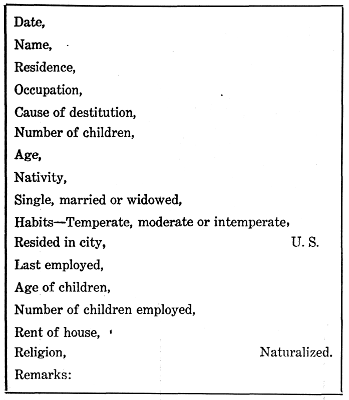
II.—Blank formerly used by Allegheny City Department
of Public Charities,—a much more complete record, abandoned since the
merging of the cities.
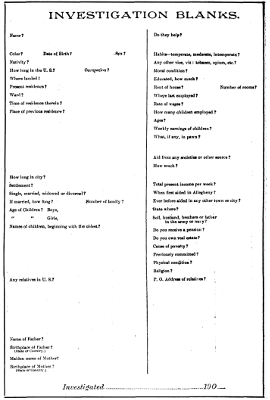
III.—Blank used by private agency.
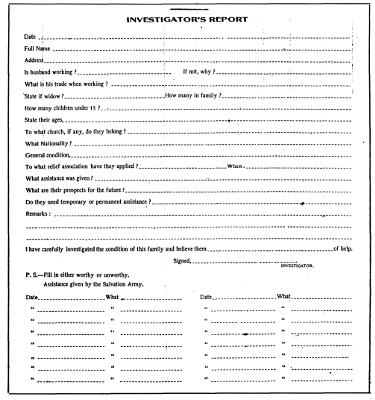
[Pg 867]
The systems pursued by other prominent Pittsburgh agencies are as
follows:
Society A. Names, addresses, number in family, and religion are
noted on blank cards, or written in books.
Society B. Record system not in existence. No paid worker. Only
record of names and amounts.
Society C. Record of cases very meager, consisting only of
names and addresses, with a few items of information, such
as the number of children, whether married, single, widow or
deserted, on cards.
Society D. No systematic records.
Society E. Clear general statements as to money received and
expended but no case records.
In addition to such a record card these societies have so called
continuation sheets on which chronologically are entered all
information or advice obtained and all action taken. It is apparent
that there can be no systematic knowledge of families unless there is
such systematic keeping of records. The separation of families into the
worthy and unworthy can nowhere be found in such records, which reveal
instead the innermost causes, the remedies for the removal of the
causes and the resources, material or otherwise, at hand to effect the
removal. In other words the three fold function; umpire of the fight
itself, determiner of immediate remedies, educator of the community to
give a fairer show in the future, can only be carried out with such
systematic recording.
After three months' effort it was found impossible to furnish any
approximation of the amount spent annually for material and other
outdoor relief in the city of Pittsburgh.
These partial returns were obtained:
| Agency. |
(Spent in their last fiscal year before the depression. |
| 9 (of 10) General Relief Societies |
$78,257.00 |
| City Department of Charities |
52,037.11 |
(8 Mos.) |
| 54 (of 422) Churches |
22,161.00 |
| 4 (of 9) Nursing Societies |
7,223.00[6] |
It is unfortunate, that owing to lack of co-ordination there has been a
confusion of function between outdoor relief and neighborhood agencies.
Many of the latter have possessed distinctly relief funds and have
been relief agencies. It is doubtful if this has been anything but
a disadvantage to them. It has divided their attention between two
totally different sorts of problems, two sorts which require above all
else, concentration. The general isolation of the field has driven
them, in many instances, thus to protect their own neighborhoods
against neglect. But they have been unable in many instances to deal
with these tasks adequately, and their larger feeling of social
responsibility has not enabled them to build up much better plans for
individual care than agencies, directly charged with this burden. They
have been hampered by their own relief efforts and their legitimate
work has suffered thereby.
They have felt much more clearly their responsibilities as umpires
of the social struggle and educators of the social conscience, than
the great bulk of the strictly relief agencies. The confusion of
their function, before mentioned, has been, it would appear, a rather
unfortunate departure which still further muddied a not clear stream.
With reference to the organization of the Associated Charities, it may
be stated that the demand for it came both from the reputable societies
themselves and the business community, the heavy contributors to
charity. Greater harmony of action, greater efficiency in action, these
were the common aims of the coalition. Several attempts had been made
during the past ten years to place the charitable work of Pittsburgh
on an organized basis, but without tangible results until February 21,
1908, when the Associated Charities received its charter. Its office
was opened April 22 and the work of securing the co-operation of
individuals, churches, relief societies and other charitable agencies,
began. The society has grown rapidly along lines of work successfully
followed by similar organizations in 172 American cities. It is
already serving as a center of intercommunication between churches,
social and charitable organizations, institutions and individuals who
are interested in charitable and social service. It has already done
much towards systematizing the charitable work of the city, with a[Pg 868]
view of checking the evils of unorganized charity and of making every
charitable dollar do one hundred cents' worth of charitable work. While
the force and equipment of the new association are necessarily small,
they are growing, and the association hopes to increase its facilities,
so as to keep pace with the rapidly increasing, heavy demand upon it.
The constitution of this organization provides for a central council,
in addition to the usual board of trustees. The council consists of
one delegate elected by each of the charitable, religious and social
agencies which have joined the Associated Charities. Besides these
delegates, the central council includes, as ex-officio members, the
mayor, director of the Department of Charities, director of public
safety, director of public works, superintendent of the Bureau of
Health, and superintendent of the Bureau of Police. The province of
the council is to promote the development of co-operation between
individual societies, to pass upon questions affecting the general
welfare of the poor and the charitable activities of the city. By
October 31, 1908, thirty-one societies were affiliated in the central
council and the registration bureau contained 7,039 records. The bylaws
of the society provide that anything which involves the welfare of
the city or its social conditions may become its concern. Thus as the
servant of the charitable agencies of the city it will often serve as
the rallying point for social advance though it would be the last to
affirm that it will be the only rallying point for the general spirit
of good feeling which is slowly manifesting itself among the social
organizations of the city.
By the presence of this co-operating center, the co-ordination of the
work of the charities of Pittsburgh should bring about:
1. Adequate material relief, when actually required. For not only
will the total amounts necessary for individual families be carefully
considered and worked out by joint committees but the relief may be
gathered from a number of sources, from relatives, friends, employers,
societies and charitably disposed individuals. The society has no
relief fund of its own but its function is to organize relief.
2. The repression of mendicancy and the repression of illegitimate
charitable schemes by the bureaus of registration and information and
in cases of necessity, the prosecution of imposters.
3. The securing of employment, rather than the giving of material
relief, wherever this is possible.
4. The inculcation of habits of thrift and providence, the development
of industrial education.
5. The co-operative treatment of families to bring all members of such
families up to the highest possible mental, moral and physical plane,
not only to conserve the well-being of the individuals themselves but
to prevent the weakening of society by adding in successive generations
to those who are sub-normal (such as weak minded children).
6. Such special or institutional care of the deficient as shall work
towards the same end.
7. The crystallization of the sentiment of the charitable forces of
Pittsburgh, with reference to necessary social reforms.
8. Greater efficiency in the business affairs and records of the
individual societies, thus imparting greater "doing" power to the same
amount of charitable resources, and creating a body of social facts
which can be made the basis for sound public opinion with respect to
the living conditions of the community.
Here then has been the evolution. Individualized impulses developing
specialized organizations in an un-plotted field. The conception
of individual well-doing with no conception of the general social
responsibility. Added to this the growth of more or less unnecessary,
weak, and in some cases fraudulent, charitable enterprises (to which we
have not alluded before) because of the ease with which support could
be obtained in a community generous to a fault. This support gained
too without necessarily bringing with it any sense of responsibility
on the part of the contributors. There is a well corroborated story,
vouched for by a leading professional man of the city, that for years a
woman had collected about $7,500 annually for a fresh air home which
cared for only a few children. The collections continued until he and
others had a private investigation made and discovered the truth. It
is comparatively easy to secure the assent of many men to allow their
names to be used on boards of directors if no service is required. This
is not a bad practice when such men know the responsible directors and
can safely vouch for their actions. But care was not always taken to
ascertain this.
THE PITTSBURGH DISTRICT AND THE HOUSING SITUATION
The direct work of investigation in the field of housing reform,
carried on by the Pittsburgh Survey, has been intentionally limited to
the question of sanitary regulation. That was the first prime need to
be met. The work has been carried on under the supervision of Lawrence
Veiller, the foremost authority on housing reform in this country.
Mr. Veiller was the secretary of the New York State Tenement House
Commission in 1900, first deputy commissioner of the New York City
Tenement House Department, and is director of the Department for the
Improvement of Social Conditions of the New York Charity Organization
Society.
In illustrations and text, no attempt is made to present a review of
the development of model towns in the Pittsburgh District, or the
construction of single and two-family houses. These are matters which
will properly come before committees on building construction and town
planning of the new Pittsburgh Civic Improvement Commission.
Real estate dealers and builders have not been inactive in Pittsburgh;
but the situation is so serious as to demand the development of a
constructive public policy.
It demands such town planning and traction development as will open
up wider suburban areas and relieve congestion. It demands such
radical modification of the tax system, as will put a premium, as in
metropolitan Boston, on home building; rather than a premium, as in
Pittsburgh, on the speculative holding of unimproved land. Pittsburgh
might well be the first city to try out in America the co-operative
building scheme which has gained so much momentum in England, and by
which the shifting industrial worker owns not a house, but stock in a
housing company, which builds wholesale. Such a plan would admirably
supplement the operations of the realty companies and building and
loan associations in housing the growing industrial force of the steel
district, and would offer an opportunity for investment at five per
cent and the public good such as opens in no other direction to the man
of large means and large imagination who would leave his impress on the
Pittsburgh District.
—DIRECTOR PITTSBURGH SURVEY.
Such a condition could not go on indefinitely. The leaders in the
societies themselves insisted upon a better sensing of social
responsibility, which meant simply the better realization of one
principle, co-operation, the signpost to the second stage of growth.
This led not only to the manifold kinds of co-operation made possible
by the formation of an Associated Charities, but to a joining of forces
in other directions.
So the march of social reform goes on, with the charitable agencies of
the city more and more fulfilling their function of rightly estimating
causes and tendencies, of providing the fair chance to the dependent
and defenceless by intelligent, co-ordinated, family treatment, and
of educating the public towards the need of social legislation and
regeneration.
[Pg 869]

OLD PLANING MILL KNOWN AS TAMMANY HALL, TORN DOWN
THROUGH THE ACTIVITY OF THE BOARD OF HEALTH.
Twenty-five families were formerly housed here in 26 rooms.
Building to left continues to be occupied as tenement—10
families and 2 stores occupying 13 rooms. To the rear can
be seen remnant of the planing mill. Three families occupy
three rooms reached through the doors opening off the
gallery.
[Pg 870]
THE HOUSING SITUATION IN PITTSBURGH
F. ELISABETH CROWELL
DEPARTMENT FOR THE IMPROVEMENT OF SOCIAL CONDITIONS, NEW YORK CHARITY
ORGANIZATION SOCIETY
[Pg 871]
Last winter, the Pittsburgh Survey, co-operating with the Bureau of
Health, conducted a special investigation of the housing situation
in Pittsburgh. Its purpose was a general stock-taking from the point
of view of sanitary regulation. Evil conditions were found to exist
in every section of the city. Over the omnipresent vaults, graceless
privy sheds flouted one's sense of decency. Eyrie rookeries perched
on the hillsides were swarming with men, women and children,—entire
families living in one room and accommodating "boarders" in a corner
thereof. Cellar rooms were the abiding places of other families. In
many houses water was a luxury, to be obtained only through much
effort of toiling steps and straining muscles. Courts and alleys
fouled by bad drainage and piles of rubbish were playgrounds for
rickety, pale-faced, grimy children. An enveloping cloud of smoke
and dust through which light and air must filter made housekeeping a
travesty in many neighborhoods; and every phase of the situation was
intensified by the evil of overcrowding,—of houses upon lots, of
families into houses, of people into rooms. Old one-family houses were
found converted into multiple dwellings, showing that Pittsburgh's
housing problem threatened to become a tenement-house problem as well.
To cope[Pg 872] with these conditions was a Bureau of Health, hampered by an
insufficient appropriation, an inadequate force of employes, and in
the large an uneducated, indifferent, public opinion. A report of the
investigation was published, and was used by the housing committee
of the Pittsburgh Chamber of Commerce in its campaign of education
in support of ordinances then before councils. These ordinances were
in line with recommendations of Superintendent James F. Edwards of
the Bureau of Health and the city administration. Councils voted an
increase of $20,000 to the bureau for its work in this field. The force
of employes in the tenement house division was increased from one chief
inspector, three inspectors and a part-time stenographer, to one chief
inspector of experience, ten inspectors, one clerk and one stenographer
on full time. A new system of records was inaugurated and comprehensive
measures were undertaken to obtain the complete census of all
tenements in Greater Pittsburgh. Subsequently, an ordinance was passed
providing for the compulsory registration of tenement houses.[7] Here,
then, has been a long stride ahead in the course of housing reform in
Pittsburgh, which had been inaugurated several years before by Williams
H. Matthews, headworker of Kingsley House, and the leaders of the Civic
Club,—pioneer work which had secured the provisions of the existing
state tenement house law and the creation of a tenement division under
the Bureau of Health.
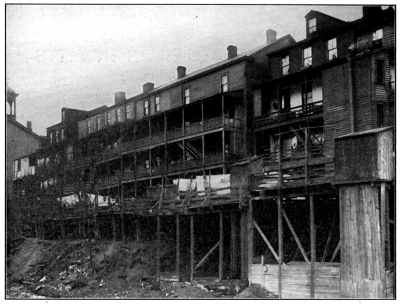
SAW MILL RUN.
Rear view showing dry closets which emptied at edge of stream.
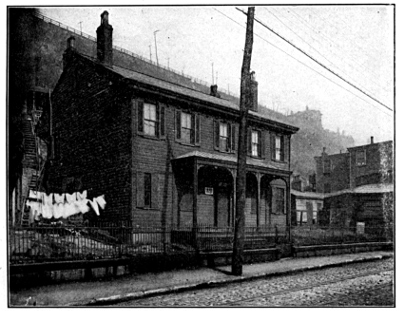
TENEMENT OF OLD DWELLING TYPE.
[Pg 873]
This leads us to the present housing situation in Pittsburgh,—a
situation which should be seen in its right proportions. First, should
be remembered the decades of neglect. The process of cleaning up and
rehabilitation is a ten years' job. The very fact that ordinances
have been passed, a tenement house census taken and fifty thousand
people supplied with sanitary accommodations points the way to the
long, exacting work ahead in devising legislation and enforcing it in
order to bring existing structures up to what may be called the new
Pittsburgh standard. In the second place, the tenement house dwellings
for three or more families are, when all is said and done, but a small
part of the homes of the wage-earning population. The great housing
problem in Pittsburgh is that of the one-or two-family dwelling. Here
is a field where even more exacting sanitary work and regulation must
be done in the ensuing years. In the third place, the mill towns, as
well as the city, present every phase of the evils of bad housing. It
is a district problem, then, for the leaders in Pittsburgh. Finally,
behind all these existing unsanitary conditions demanding regulation,
is the shortage of houses throughout the Pittsburgh District which
will reassert itself with returning prosperity. As a result of the
campaign of last winter, the Bureau of Health is now for the first
time adequately equipped to get at the existing tenement abuses and to
point out the need for more housing accommodations,—new low-rental
houses,—if the work of reducing overcrowding and eradicating disease
breeding quarters is to be carried out on a comprehensive scale.
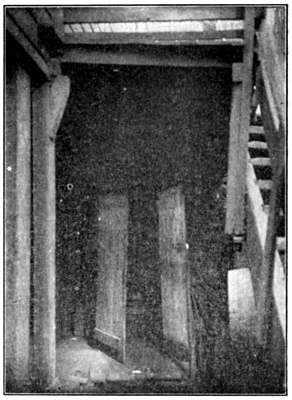
CLOSET UNDER PORCH SHOWN ON SECOND PAGE FOLLOWING.
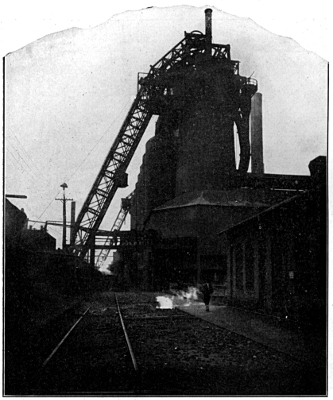
PITTSBURGH.
A tool for producing pig iron in tonnage that beats the world.
[Pg 874]
The tenement house census shows a total of 3,364 tenement houses in
the Greater City, and puts in the possession of the department a body
of facts bearing upon the localization of bad housing conditions
throughout Pittsburgh. This was the first logical step to be taken
toward dealing intelligently and efficiently with the situation. To the
accomplishment of this task the main energies of the tenement house
division have been devoted up to the present time. From every source
in every quarter the cry of "hard times" has been insistent and the
authorities up to the present time have deemed it inexpedient to force
drastic plans for improvement. They have endeavored to keep things
clean, and have insisted upon necessary repairs, but orders relating
to structural changes have been held in abeyance pending a revival of
more prosperous financial conditions. The process of eliminating privy
vaults, however, the most threatening sanitary ill, has been vigorously
continued. Thus far 5,723 vaults have been filled up and abandoned
and 9,323 sanitary water [Pg 875]
[Pg 876]closets for the use of 10,471 families
installed in their places. A census of the first twenty wards shows a
total of 5,793 vaults still in use in these wards alone. No figures
are as yet available for the remaining twenty-four wards of the Old
City,—or the fifteen wards on the North Side.
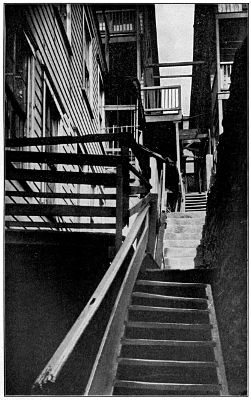
PITTSBURGH: EQUIPMENT FOR HOME LIFE.
Four houses, one behind another, climbing up hillside between streets.
Under the porch to the left were two filthy closets without flushing
apparatus. They were the only provision for five families in the first
two houses.
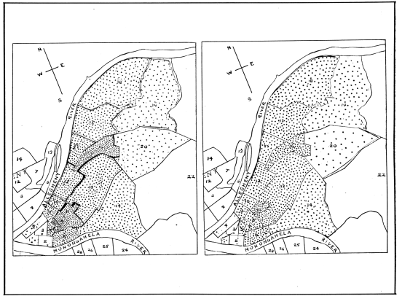
CLEARING THE VAULTS OUT OF PITTSBURGH.
Each dot stands for five vaults.
Illustrated by the first twenty wards.
8,567 vaults as found by present health administration.
The situation to-day: 2,774 removed, 5,793 to go.
Some of the worst plague spots in Pittsburgh have been eradicated
despite the fact that, by veto of the governor of Pennsylvania,
power to condemn insanitary structures was not given to the health
authorities. That much remains to be done is, however, as true as it
was a year ago, as I found on a recent reinspection. "Tammany Hall,"
Pittsburgh's classic example of bad housing is no more. Unable to
vacate by process of law the old planing mill which had been converted
into a tenement, the authorities piled violation notice upon notice
at such a rate that the owner found the old shack a losing investment,
and at last agreed to tear it down. He told me sorrowfully that if
"they" had let him alone until September, he could have made $1,800 on
the place,—an amount sufficient to pay his taxes to the city that was
ruining him. It seemed a pity some method could not be found by which
he might be forced to clean out another choice bit of property which
he was renting,—a long, narrow, two-story brick tenement, where ten
families and two stores are occupying thirteen rooms. The water supply
was a sink in one apartment, and another on the second story floor and
a hydrant in the yard. Here also were the closets which are shared by
seven families, living in the houses adjoining.
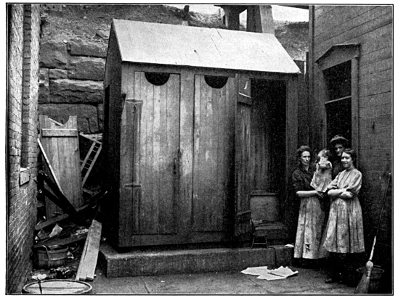
STEWART'S ROW.
Showing proximity of privy vaults to kitchen. Houses dilapidated.
Another familiar eye-sore on Bedford avenue was still standing,—worse
still, [Pg 877]it was rented out, at least in spots,—three families in
the front, and three in the rear buildings,—Negroes and whites.
It looked more dilapidated and dirtier than when I visited it last
winter. The owner was notified over a year ago that the houses must
be repaired and certain alterations made if they were to be occupied
as tenements. She pleaded a heavy mortgage and a dying sister. The
mortgage still holds, the sister is still dying, she is unable to find
a purchaser for the property, and in the meantime two-room "apartments"
are still to be secured for twelve dollars a month, with all ancient
inconveniences:—water to be obtained from a hydrant in the yard, and
shared possibly with eleven families; foul privy compartments also
to be shared with neighboring families, and perchance an occasional
passerby. None but the lowest class of tenants will live in these
to-be-abandoned dwellings, and their continued existence constitutes
a grave danger from a sanitary viewpoint, not only to the immediate
neighborhood, but to the entire city. So long as the law permits such
breeding places for disease, so long will the fight against filth
diseases be a losing one.
Stewart's Row, on West Carson street, as I found it late this fall,
was evidently destined to maintain the standard of the neighborhood in
the matter of bad housing as originally set by its neighbor, Painter's
Row; two wooden rows of two-family houses, rickety, leaking, sheltering
thirteen families; two vaults at the rear, one with contents exposed;
two hydrants the sole water supply; an obstructed drain; the hillside
decorated with a disgusting combination of waste water, garbage, and
rubbish.
Allegheny has added her quota to the problem of housing in Greater
Pittsburgh. The tenement house inspectors in the course of their
census-taking have unearthed more than one example of[Pg 878] rank conditions
on the North Side. In one tenement the ground floor was occupied as a
stable; a cellar revealed the piled up accumulations of years; privy
vaults flourish and household water supply is noticeable chiefly
because of its inadequacy. Over one-fourth of the entire number of
tenements found in Pittsburgh are located on the North Side. According
to the chief inspector at least fifty per cent of these are in a bad
condition.
The Tenement House Department has thus found plenty of work ready at
hand for its inspectors. Of the 3,364 tenement houses enumerated by the
census, nearly fifty per cent are old dwellings originally planned and
constructed to accommodate one family. Frequently, no provision is made
to meet the demands of the additional number of families. Privacy is
destroyed, closet facilities and water supply are inadequate, cellar
and basement rooms are made to do duty as living and sleeping rooms and
there is no protection from fire danger. Of the remaining number of
tenements less than one-half are new-law tenements.
TENEMENT CENSUS.
| Nationality. |
No. of Fam. |
Nationality. |
% of Total. |
| American |
5,831 |
American |
47.41 |
| Polish |
2,054 |
Slavs |
24.64 |
| Hebrew |
1,077 |
Hebrew |
8.76 |
| German |
963 |
German |
7.83 |
| Negro |
597 |
Negro |
4.85 |
| Italian |
443 |
Italian |
3.60 |
| Slovak |
360 |
British |
1.44 |
| Bohemian |
176 |
Misc. |
1.47 |
| Croatian |
165 |
|
100.00 |
| Hungarian |
113 |
| Irish |
104 |
| Syrian |
98 |
| Lithuanian |
67 |
| Russian |
57 |
| English |
50 |
| Greek |
37 |
| Austrian |
31 |
| French |
21 |
| Welsh |
12 |
| Scotch |
11 |
| Swedish |
10 |
| Servian |
8 |
| Finnish |
4 |
| Chinese |
7 |
| Norwegian |
1 |
| Spanish |
1 |
| Turkish |
1 |
| Danish |
1 |
| Tot'l No. of fam. |
12,300 |
—No. of people |
42,699 |
| No. of fam. taking boarders |
1,532 |
—Boarders |
3,200 |
| Total population in tenements |
45,899 |
The accompanying tables show the various nationalities which recruit
tenement dwellers and the share contributed by each. Nearly one-half
are American born; one-fourth are Slavs. Next in numerical importance
are the Hebrews, then the Germans, Negroes, Italians and British.
The remaining scattered groups are included under the heading
"Miscellaneous." Pittsburgh's tenements shelter 12,300 families,
containing 42,699 people; 1,532 families take in boarders and of these
boarders there are 3,200. The total number of people living under
tenement conditions (three or more families to the house), is 45,899.
The welfare of over forty thousand people is dependent then on tenement
house standards and their enforcement in Pittsburgh. This is perhaps
eight per cent of the total population, a small proportion when
compared with New York for instance. The primary housing problem of
the wage-earning population in Pittsburgh, remains then not a tenement
problem in the strict legal sense, but a one- and two-family dwelling
problem. This is the aspect of the situation which Pittsburgh must face
in its entirety if the city is to profit by the experience of older
communities.
"If you think Pittsburgh is bad, you ought to see Glasgow," said one
man. "Look at the tenements in New York," said another. Yet, if the
city's phenomenal growth continues to be equalled by her phenomenal
indifference to the necessity of raising the housing standard for her
least paid laborers, the day may come, and soon, when Pittsburgh will
make a close third to these cities. Because of hard times, vast numbers
of immigrants have left Pittsburgh, and temporarily the rental agencies
have plenty of idle houses upon their lists. These houses throw
light on the situation. Two, three, four, and five-room apartments
are available at an average monthly rental of from two and a half to
five dollars a room in many sections of the city. There are also some
single houses to be obtained for the same price. Over half of these
dwellings are without any modern sanitary accommodations, and many are
in a wretched state of repair. The majority of the houses are in the
most sordid quarters of the city where living is high, at any price.
Certain dwellings are offered especially for foreigners or Negroes,
dilapidation, lack [Pg 879]of conveniences, and an undesirable locality being
distinguishing features of these houses.
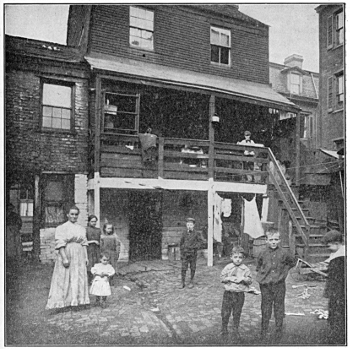
COMBINATION REAR TENEMENT AND ALLEY DWELLING, WEBSTER
AVENUE. NEGROES AND WHITES LIVE HERE.
We label the foreigner as an undesirable neighbor; we offer him the
meanest housing accommodations at our disposal; we lump him with the
least desirable classes of our citizens; then we marvel at his low
standards of living. Give him better, cheaper, houses where he may
have a decent and comfortable home, instead of a mere shelter from the
elements, unwholesome, overcrowded and expensive, and then see what his
standard of living would be.
The natural conformation of the land with its steep declivities, and
its winding, tortuous valleys, has added much to the difficulty of
the housing situation. Adequate transportation facilities would open
up territory on the South and West sides where countless people could
be housed. The trend of the mills away from the city to nearby river
sites, attracted by lower tax rates and unlimited space will offer
further relief and improvement, especially where great employers of
labor, in laying out their plants as at Mariana, and Vandergrift and
Gary take heed of the proper housing and sanitation of the towns that
will grow up about them. As the situation stands to-day, however,
bad housing conditions are multiplying in the surrounding industrial
towns; and they must face the same problem. Its seriousness demands
the formulation of public policies that shall encourage every form of
building operation that will produce sanitary houses at low rentals,
whether they are private homes or company houses of creditable
standard, or dwellings put up by building and loan companies,
commercial builders, or co-operative housing companies, along English
lines.
A Chamber of Commerce report states: "The city of Pittsburgh, along
with its[Pg 880] vast industrial development, has grown so phenomenally
in population during the past ten years that it has been clearly
impossible for the growth in housing accommodation to keep pace.
Careful and comprehensive investigations show conclusively that the
housing facilities of the Greater City have completely broken down,
not only in point of reasonably proper conditions but in amount of
available real estate."
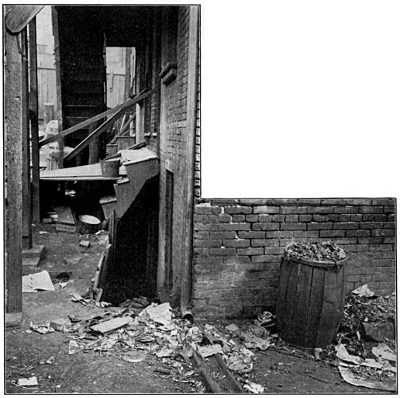
VIEW OF YARD SHOWN OPPOSITE.
Corner of rear buildings. Pump in foreground of picture opposite is the
sole water supply for both rows of houses. Here rubbish is added to
dilapidation.
"We have not the time, nor is it our function to investigate the
housing situation of the city. Let the charitable or philanthropic
agencies make a systematic study of the evils that exist, and we
will gladly lend the support of our influence to any recommendations
which they may offer," said a leading spirit in one of Pittsburgh's
great commercial organizations. To this man the proper housing of the
workingman had a charitable aspect.
"We don't want to go into the housing business. We are manufacturers,
not real estate dealers. We may be forced to build houses in certain
new districts in order to attract and hold labor, but in an old,
settled community let the laboring man take care of himself. We don't
believe in paternalism." I quote the president of a great steel company.
Said a prominent real estate man: "There certainly are other more
attractive investments for private capital than the building of small
houses,—taxes are high, the demand for such dwellings has fallen off
considerably and the returns are uncertain, owing to the difficulty of
collecting rents in times such as these."
And the laboring man says: "I want a decent home at a moderate rental,
within reasonable distance of my work." Can he get it? Rigorous
sanitary work by the health authorities will help. But more than that
is needed.
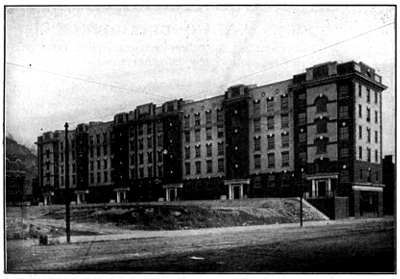
PHIPPS MODEL TENEMENT.
Rebecca Street, Allegheny, October 21, 1908. Four room
apartments rent from $4.25 to $5 a week; three room
apartments from $3.25 to $4 per week. Steam heat, gas
slot meter, sinks and water closets in each apartment.
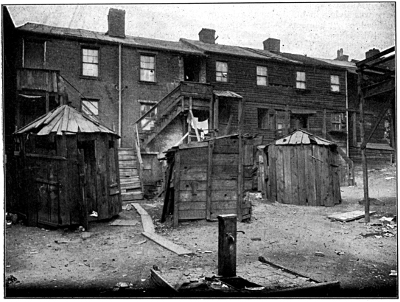
YARD SHOWING BATTERIES OF PRIVY VAULTS AND DILAPIDATED
CONDITION OF STEPS LEADING TO THIRD STORY. TWO ROOM APARTMENTS RENT FOR
$12 PER MONTH.
[Pg 881]
EMILY WAYLAND DINWIDDIE
SECRETARY NEW YORK TENEMENT HOUSE COMMITTEE; FORMER SPECIAL
INVESTIGATOR OCTAVIA HILL ASSOCIATION, PHILADELPHIA
[Pg 882]
One would expect to see bad housing in Pittsburgh as a natural result
of the congested condition of the city, partially hemmed in by
waterways, and of the presence of an increasing population of factory
workers ready to accept whatever living accommodations are available
near their places of employment. Unhealthful homes, however, are
especially dangerous in Pittsburgh, where their influence has been
combined with that of city crowding, and of smoky, gas-laden air and
polluted water. Badly constructed houses and defective drainage are an
evil in the case of the country laborer, but far worse for a Pittsburgh
factory employe.
The tenement, with its usual accompaniments, has been a growing
menace, although it has not yet obtained so great a hold as in many
large cities. In 1900, one-ninth of the total population of the city
was living in buildings now legally defined as "tenements,"—that is,
occupied by three or more families each. Since that time it is said
that the proportion of tenements and tenement dwellers has become
considerably larger.
The city has recognized its dangers and a beginning has been made in
the framing of state legislation and city ordinances to meet them.
The housing and health laws applying to Pittsburgh in many respects
are like those for Philadelphia. There is no department of health, but
there is a bureau of health in the Department of Public Safety, and
similarly a bureau of building inspection.
The powers of the Bureau of Health in relation to housing conditions
are more limited than those of corresponding departments in many
other cities in the lack of authority to vacate buildings unfit for
habitation. The writer had occasion to visit in Pittsburgh a large
ramshackle frame tenement house, insufficiently lighted and ventilated,
dirty and miserably overcrowded. The building, which had originally
been a mill, was obviously unfit for occupation. For some time "Tammany
Hall" had been almost as notorious in Pittsburgh as the infamous
"Gotham Court" was in New York. The whole frame work was so poorly
constructed that it seemed hopeless that the owner would consider
improvements worth while for a building of this character, yet the
Bureau of Health could not have the house vacated, and the tenants
continued to live in their wretched quarters.[8]
Since 1867, one year after its creation, the Board of Health in New
York has had authority to vacate buildings unfit for occupation, and
in 1887 it was expressly included in the law that this power applied
to any building "unfit for human habitation because of defects in
drainage, plumbing, ventilation, or the construction of the same, or
because of the existence of a nuisance on the premises, and which is
likely to cause sickness among its occupants." This provision is still
in force at the present day and has been extended to the Tenement House
Department as well. In the course of a year the latter department alone
vacated between one and two hundred houses. Similar powers are held in
other cities. In Boston and Chicago they are exercised. In Washington
many buildings have been not only vacated, but demolished. Nor is
this authority confined to the largest cities; Jersey City, with a
population 100,000 less than Pittsburgh's, and Rochester, with 40,000
less than Jersey City, both have health boards with full powers in this
regard.
[Pg 883]
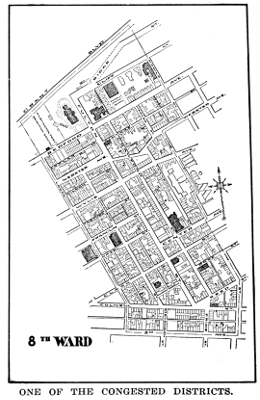
ONE OF THE CONGESTED DISTRICTS.
Apart from this lack, the Pittsburgh Bureau of Health in relation to
existing houses other than tenements, has under state law much the
same general authority and obligations as in other cities. Its duty is
to have nuisances abated and conditions dangerous to health removed.
Specific provisions, however, affecting the proper maintenance of
one-and two-family dwellings are almost entirely lacking, although
these are found in Pittsburgh in much greater numbers than the tenement
houses, and as shown in recent investigations, are greatly in need of
regulation. The state laws contain practically no requirements for
them except in regard to the cleaning of privy-vaults and to plumbing.
There is no city sanitary code. A general state health law of 1895
gives the director of the Department of Public Safety in conjunction
with the Bureau of Health, power to prescribe rules and regulations
for enforcing the provisions of the act, but the power has never been
exercised to frame sanitary requirements for dwelling houses. Dark,
damp cellar rooms, wholly under ground, one "town pump" serving as
the sole water supply for thirteen houses; water-closets in dark
unventilated holes under sidewalks, are examples of conditions found in
Pittsburgh, and not definitely prohibited except in tenement houses.
An ordinance to prevent cellar occupancy and[Pg 884] to provide for the
cleaning up of unsanitary conditions in houses other than tenements was
introduced in councils the past year by the Chamber of Commerce, but it
failed to pass. Such absence of requirements tends seriously to block
the sanitary improvement of the smaller houses. Specific mandatory
provisions make for uniform, fair treatment, requiring as much of one
house owner as of another. They give efficient health authorities a
stronger case in dealing with offenders and make it more difficult for
inefficient ones to evade their responsibilities. A code is needed.
... PROSPECTUS ...
THE TENEMENT IMPROVEMENT COMPANY,
Modeled after the Octavia Hill Association of Philadelphia,
was formed for the betterment of the housing of the poor of
Pittsburgh, for the following reasons:
First. There is no tenement house commissioner in Pittsburgh.
Second. Laws relating to the water supply, sewerage, garbage
collecting, overcrowding and use of houses for immoral
purposes, are either not in existence or not enforced:
Third. There are within a radius of twenty-five miles of
Pittsburgh 35,000 Slavs, 4,000 Bohemians, 30,000 Poles, 10,000
Croatians, 8,000 Ruthenians, 1,000 Russians, 2,000 Servians,
35,000 Italians: these low-class foreigners must of necessity
overcrowd the already congested districts.
Fourth. Conditions such as these make for moral and physical
contagion, intemperance, pauperism, crime, anarchy and the
destruction of the home.
Fifth. This city is already aroused to the necessity of
caring for the children before they become criminals, but
these efforts are of little value unless strengthened by the
influence of decent and respectable homes.
Sixth. Pittsburgh, in proportion to its wealth and prosperity,
has done nothing to improve the housing conditions of the very
poor.
The Purpose of the Company is to buy, build or remodel
tenements in the worst localities, put them in sanitary
condition, install tenants of moral character at the same rents
paid before and have weekly visits of inspection made by women
rent collectors. The Company will agree to manage, on these
same lines, tenement houses for property holders on commission.
FOLDER OF 1893.
The beginning of housing reform in Pittsburgh.
An important ordinance, dealing with one unsanitary feature of the
city, was passed by councils in 1901. This makes it unlawful to
continue the existence of cesspools and privy-vaults on any lot
contiguous to a public sewer. A state law of 1901 prohibited the
construction of a new cesspool or privy-vault on premises where a sewer
was adjacent, and the same prohibition was previously contained in
the plumbing regulations of the Bureau of Health, issued in 1895; but
existing privy-vaults are made unlawful only by the ordinance of 1901.
This provision is of great value. The privy-vault may be tolerated
in country districts, but in small city yards, close to kitchens and
bedrooms, groceries and butcher shops, its dangers are increased a
thousand fold. The risk is especially great where typhoid is prevalent,
as is the case in Pittsburgh, where as far back as the health records
go the disease has been practically epidemic and where up to 1908 the
typhoid rate was higher than in any other city. That the contagion
of typhoid fever is contained in the discharges of the patient, and
that the specific organism may live in these for a long period is
well known, but only in the past decade has the part played by house
flies in the dissemination of the disease been emphasized: "Flies are
attracted to all kinds of filth. A fly after lighting on the discharges
from a typhoid patient thrown into one of the vaults may have on its
legs the specific bacteria and can then carry the infection from place
to place; it may be to the food of the nearest neighbor, or to that in
a nearby street stand or shop, or it is possible it may carry it to a
greater distance."
For house drainage, Pittsburgh has a good plumbing code in its detailed
provisions similar to those in New York and Philadelphia. It is in
the form of a state act, passed in 1901, and responsibility for its
enforcement rests in the Bureau of Health. Besides containing strict
requirements for new work, it gives the bureau certain important powers
with reference to plumbing in existing buildings.
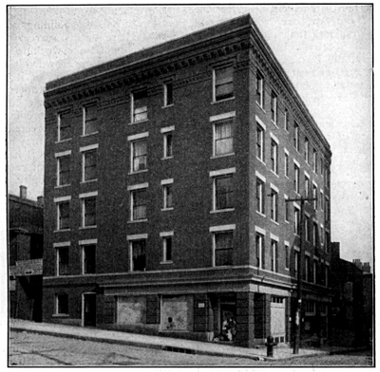
THE FRANKLIN FLATS OF THE TENEMENT IMPROVEMENT OF
PITTSBURGH. THE ONLY MODEL TENEMENT IN THE OLD CITY.
Tenement houses,—that is, buildings occupied by three or more
families,—are the subject of special legislation. Two tenement laws
were enacted in 1903. One applying principally to the maintenance of
tenement buildings is enforced by the [Pg 885]Bureau of Health. It forbids
the use of tenement cellars for living purposes; a cellar being defined
as a "story more than one-half below the street or ground level." It
permits living in basement rooms only when they are eight and one-half
feet high and are properly lighted and ventilated according to the
specific terms of the law, and are not damp or otherwise unfit for
habitation. It requires for every room in existing tenements either
a window equal in size to one-tenth of the floor area of the room,
and opening upon the street or alley, or upon a yard or court, with
a sectional area of not less than twenty-five square feet; or else
a fifteen square foot window opening to an adjoining outside room
in the same apartment. No rooms may be occupied unless they contain
seven hundred cubic feet of air space, nor unless they are eight feet
high from floor to ceiling in every part, except that attic rooms
need be eight feet high in only one-half their area. Overcrowding
is prohibited by the requirement that in any room there must be four
hundred cubic feet of air space for each adult, and two hundred for
each child occupying the room.
In new tenement houses an independent water supply is required for
every suite of rooms; in existing tenement buildings, or buildings
hereafter converted to tenement use, there must be a water supply
on every floor, accessible to all tenants on the floor without the
necessity for their passing through any apartment but their own. The
space under all sinks is required to be left open, without enclosing
woodwork.
A water-closet is required for every apartment in a new tenement
building, except that where apartments consist of but one or two rooms,
one closet for three rooms is sufficient. In existing tenement houses
one closet for two apartments is required, and for existing buildings[Pg 886]
converted to tenement use after the passage of the law, one closet for
six rooms, but not less than one to a floor. Water-closets located
in the yard are permitted where the Bureau of Health considers this
arrangement necessary.
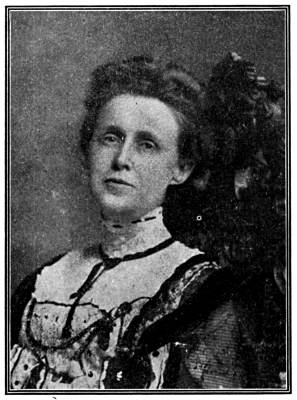
MRS. FRANKLIN P. IAMS.
Mrs. Iams, Miss Kate C. McKnight, E. Z. Smith, and other leaders of the
Civic Club of Allegheny County, have been among the pioneer workers in
housing reform in Pittsburgh.
Cleanliness and good repair of all parts of the house are required.
The keeping of horses, cows, pigs, sheep, goats or poultry in tenement
houses is prohibited, also the use of any part of a tenement house for
a stable or for the storage of anything dangerous to life or health.
The keeping of inflammable or combustible material under any stairway
in a tenement house is prohibited. The act prescribes fines for
violation and makes it mandatory upon the Bureau of Health to employ
one or more special tenement house inspectors to inspect tenements and
see that the requirements of the law are enforced.
The main points of the law are excellent, but it contains an
undesirable feature in placing a premium upon the conversion of
existing buildings to tenement uses. There seems scarcely room for
question that if the working population of the city must be crowded
into multiple dwellings, it is better for it to be into houses
constructed and properly fitted for the purpose. But the law encourages
the squeezing of three or more families into old, ill-adapted houses,
erected for other purposes. A new house may not be built for tenement
uses unless it has a separate sink for every suite of rooms, and a
water-closet for every suite, or where suites consist of but one or two
rooms each, a water-closet for every three rooms; but an old building,
not constructed for the purpose, may at any time be made to serve as
a tenement house if it has a sink and a water-closet on every floor,
regardless of how many families may be occupying the floor, providing
only that there is at least one water-closet for six rooms. A landlord
may lawfully turn an old dilapidated mill into a tenement as in the
case previously cited and provide only two sinks (one in a restaurant)
and a yard hydrant for twenty-five families, but if he wishes to build
a new tenement for this number of families the law requires him to put
in twenty-five sinks.
To aid in the enforcement of the above law there was enacted in 1908 an
ordinance requiring all tenement houses in the city to be registered
in the offices of the Bureau of Health, and providing penalties for
failure to comply.
An act of 1895 established a Bureau of Building Inspection in the city
Department of Public Safety. Officials of this bureau are required
to examine buildings in the course of construction or alteration,
and houses reported in an insecure or dangerous condition. The
superintendent and inspectors, as in other cities, are required
to be men of practical experience in work connected with building
construction, but must not be engaged in such work while holding
office. Plans and specifications for all new construction or extensive
alteration work must be filed with the bureau, and work of this
character may not be carried on[Pg 887] without a permit from the bureau, to
be granted within ten days, when the plans and specifications conform
to law. Where a permit is refused, the party aggrieved may appeal to
a commission, to be appointed by the director of the Department of
Public Safety, and to consist of three persons, either master builders,
civil engineers, or architects; but authority is in no case granted to
this commission to set aside or alter any provisions of the act, or
to require the issuance of a permit for a building to be constructed
otherwise than as required by the act.
Such a fixed law without discretionary powers granted to the building
inspecting officials, or to the Bureau of Appeals, is an important
safeguard to the community. The experience of New York affords
conclusive evidence of the danger of an opposite policy. For example,
previous to 1901, the laws applying to New York fixed a limit to the
percentage of the lot which might be covered over by a new tenement
building, requiring the remainder to be left vacant, in order to
provide proper yard and court space for light and ventilation. But
the superintendent of buildings was granted power to modify this
requirement, and the result was that it was practically nullified. The
New York Tenement House Commission of 1900 examined several hundred new
buildings erected under the law, in the Borough of Manhattan, and found
that only one per cent had the prescribed reasonable air-space. In
theory, discretionary powers have advantages in giving a law sufficient
flexibility to meet varying conditions, but in practice, where granted
to modify reasonable legislation, they place worthy officials in the
difficult position of being obliged to refuse,—in opposition to any
influence that may be brought to bear,—to exercise discretion plainly
permitted to them, and they open to unworthy officials of all grades
innumerable opportunities for corruption and unjust discrimination.
In Pittsburgh the specific provisions in relation to details of
building construction are incorporated in the main in state laws,
but there are also certain city ordinances regulating building
construction. Building requirements affecting sanitation and safety
in dwellings for one or two families, apart from those enforced by
the Bureau of Health and previously referred to, are few in number,
although in Pittsburgh the great majority of the population is housed
in buildings of this character, making the situation a vastly different
one from that in New York, where seventy-one per cent of the families
live in multiple dwellings and the proper control of these is the
important matter.
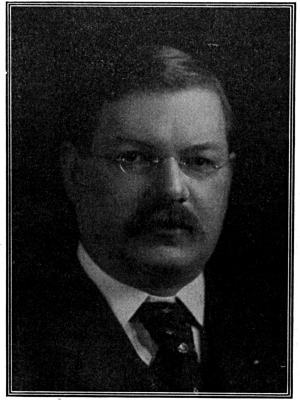
ROBERT GARLAND.
Chairman of the Housing Committee, Pittsburgh Chamber of Commerce.
A few provisions affecting all dwellings, which may be mentioned, are
a requirement that beneath new houses cellars shall extend under the
whole building and be ventilated from both ends, and that in low,
damp, or made ground, the bottom of all cellars shall be covered with
bricks, concrete or asphalt, at least three inches deep. Also every
new dwelling house must have an open space attached to it at the rear
or side, equal to at least 144 square feet clear, unobstructed by any
overhanging structure. Proper rain leaders must be provided to conduct
water from the roof to the ground or sewer, in such a way as to[Pg 888]
protect walls and foundations. There are also restrictions in regard
to frame extensions and frame sheds, provisions for roof exits, giving
means of escape in case of fire, and requirements for strength of
construction.
Comparing Pittsburgh's housing laws with the new building code of
Cleveland, Ohio,—a city with somewhat similar conditions, brings
out striking defects in the former. For example, Cleveland, for new
one-and two-family dwellings, has excellent detailed requirements as
to the percentage of the lot which may be covered by dwellings; as to
the sizes of courts and air-shafts, the provision of intakes to give
a current of air through enclosed courts, the sizes of yards, the
minimum sizes permitted for rooms, and the lighting and ventilation of
rooms and of water-closet compartments and bathroom. Corresponding to
these light and air provisions for dwellings, in Pittsburgh, there is
only the requirement of 144 square feet of yard-space at the rear or
side. There is no law, ordinance or regulation for houses other than
tenements, prohibiting the construction of dark, unventilated rooms and
halls, and of the "culture tube" air-shafts,—which have been the curse
of other cities.
For tenement houses the building requirements are much stricter than
for other dwellings. New houses of this class on interior lots must
have at the rear or side at least twenty per cent of the lot left
open,—on corner lots ten per cent,—as a yard to provide light and
air. This open space must be at least eight feet wide throughout its
entire length. Courts between tenement houses or wings of tenements
may not be less than ten feet wide. All courts and air-shafts, except
vent shafts for water-closets or bathrooms, are required to be open on
one side to the street or yard. Every room in a new tenement must have
a window opening on the street or on the open space described above.
The distance of such a window from the wall or party line opposite
must be at least eight feet. The halls on each floor are required to
have windows to the street or open space, unless light and ventilation
is otherwise provided to the satisfaction of superintendent of the
Bureau of Building Inspection. The requirements for the size of rooms
and of windows, for basement and cellar apartments and for sinks and
water-closets, are the same as in the tenement house health law.
New tenement houses, four stories or more in height, are required to
be fireproof throughout. The same penalties are fixed for violating
the tenement building law as for violation of the tenement health
law. Right of appeal from decisions of the superintendent of building
inspection is granted, as in the case of the general building law.
The act does not require that an official certificate that a completed
new tenement house complies with the law must be issued before the
building is occupied. This important safeguard is entirely lacking.
A visitor not long since was in a new tenement house in Pittsburgh,
occupied by a number of families, with the usual quota of children. The
house had been let and the families had moved in, although the building
was by no means completed, and there were even no balusters on the
stairs, which were entirely open on the side, creating an extremely
dangerous condition, especially on the third floor. In this house,
too, no fire-escapes of any kind had been supplied. The writer has
also seen a number of other new tenement houses fully occupied, but
without any proper means of escape in case of fire,—contrary to law.
The discretion allowed in the tenement building law, in regard to hall
lighting, is another dangerous feature, although less important than
the absence of the certificate requirements.
In addition to the tenement house building law, there are several acts
relating to fire-escapes on tenement houses. A law of 1885 requires
a tenement building three or more stories in height to have outside
iron fire-escapes, with balconies and slanting stairways, except
where the authorities permit some other kind of escape. The number
and location of fire-escapes is not definitely provided. They are "to
be arranged in such a way as to make them readily accessible, safe
and adequate." A law of 1889 requires, in addition, that at least one
window in each tenement house room above the second floor be provided
with a [Pg 889]chain-rope long enough to reach the ground or with any other
appliances approved by the Board of Fire Commissioners. The same act
requires the lighting of tenement house halls and stairways at night
and the burning of red lights at the head and foot of each flight of
stairs and at the intersection of all hallways with main corridors; and
an alarm or gong ready for use and capable of being heard throughout
the building is also required.
It will be seen at once that the wholesale discretionary powers granted
in regard to the enforcement of the above fire-escape provisions make
it easily possible for them to be nullified.
Finally, the removal of garbage, which has an important relation to
the sanitary condition of the houses, is insufficiently regulated in
Pittsburgh. A state act, and subsequent city ordinance, authorize the
Bureau of Health and Department of Public Safety to provide for the
removal of garbage. How frequently it shall be removed is not specified
by law. Specifications of contract are that it be removed daily from
markets, hotels, etc., and three times a week in the closely built up
wards, and twice a week in the outlying wards. Nearly two-thirds of
the annual appropriation for all the work of the Bureau of Health is
expended in paying for this service. The carrying away of ashes and
rubbish has up to the present time in no way been regulated by law. A
step looking in this direction has been taken during the past year,
however. On recommendation of the superintendent of health an ordinance
authorizing a bond issue for the creation of furnaces for the final
disposal of rubbish has been passed by councils and voted for by the
people and specifications relating to these are now being drawn up.
The beginning which has thus been made in the line of recognizing
housing dangers and of framing state legislation and city ordinances to
meet them affords a basis for the development of a consistent public
policy in this field.
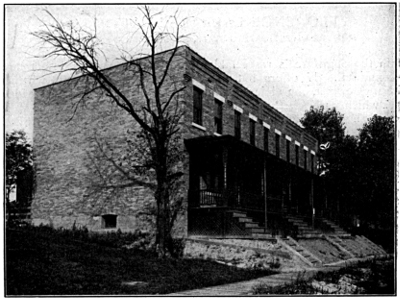
ONE PITTSBURGH TYPE OF ONE-FAMILY HOUSE.
Row of five new one-family brick houses, opposite Fort Pitt
Malleable Iron Works. Five rooms in each house; bathtub and
closet; sink in kitchen. McKees Rocks.
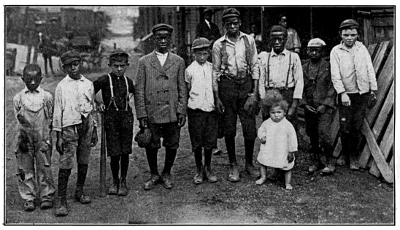
PLAY IN SKUNK HOLLOW. THE BALL TEAM.
SKUNK HOLLOW
A POCKET OF CIVIC NEGLECT IN PITTSBURGH
FLORENCE LARRABEE LATTIMORE
MEMBER INVESTIGATING STAFF, RUSSELL SAGE FOUNDATION
[Pg 890]
The main thoroughfare is respectable and non-committal. It offers but
one clue to the melodrama, the violence and misfortune, which its brick
fronts so innocently conceal. This clue is a narrow, dusty alley-way,
which cuts through the brick fronts, runs back about eighty feet, and
then turns sharply to the left and takes unto itself the name of Ewing
street. Ewing street runs along the edge of a valley called Skunk
Hollow. It pursues a serpentine course between two irregular rows of
shacks,—the one back to back with the preoccupied brick houses, the
other balancing itself uncertainly on the edge of the valley,—and
finally ends in a number of branching foot-paths. This street and Skunk
Hollow below it, both effectively shut off and concealed from casual
inspection by the row of brick houses, are bound up into a pocket
edition of civic neglect.
One cannot tell, without inquiry, whether the shacks on Ewing street
are for horses, cows, or human beings; it is said that the owners
do not care, so long as the rent is paid. But whether it is the
desirability of being in a "dead-head row" commanding a view of the
valley, or the advantage of having a house which while showing but one
or two stories above the street, takes a private drop of one story in
the rear and accommodates itself to the abrupt decline of the cliff,
there is no doubt that the cliff-edge structures are far more popular
than their stunted neighbors across the way. In them one finds the
most desirable clinical material for a study of Pittsburgh's ills,
all in one well packed group of abnormalities. Do you wish to see the
housing problem? You need only follow Ewing street its short length of
a city block and observe. The level of one side of Ewing street and
the characteristic drop of the other, have brought out two typical
forms of Pittsburgh architecture described by a resident small boy as
"squatters" and "clingers." Together they form the nondescript shelters
of a parasitical class of persons, white [Pg 891]
[Pg 892]and colored, unassorted.
In such fantastic and general dilapidation are these rows of unpainted
shelters that some of them are falling to the ground without the
formality of condemnation proceedings. Most of them have running water
in the kitchens; a very few have sanitary toilets and shout the fact on
black and white rental signs. Cellar rooms abound and are often used
as sleeping rooms; in those houses built together into a block they
are windowless. The toilets back of them are in the old boxed battery
style, unflushed, and send their contamination down the grooves of the
slope to Skunk Hollow at the bottom.
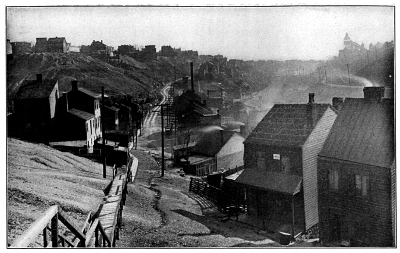
LOOKING DOWN ON SKUNK HOLLOW.
Luna Park is seen on the skyline at the right.
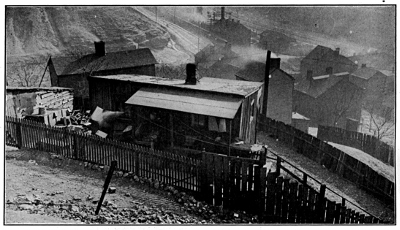
A FIRMLY ENTRENCHED SHANTY, FRONTING ON NO ROAD BUT
GUARDED BELLIGERENTLY BY ITS COLORED OWNER.
The hollow, reached by sewage through winding crevices in rubbish, and
by goats and dogs over hills of tin cans and refuse, is reached by the
people themselves down flights of decaying steps. In the street at
the bottom, a wooden surface drain goes companionably along side by
side with the foot-path. Occasionally a trickling stream from the hill
joins forces with it and the whole falls at last through a basket-drop
into an open sewer. The disheveled exterior which gives Ewing street
the personality of a gang-leader with his hat on one side, is not so
marked in the hollow. The hollow has a kind of sullen reticence. Here
sanitary conditions are, if possible, of graver aspect. It is literally
a cesspool.
In this cesspool is a strong and dangerous community life. Till now you
have been absorbed in the setting of the neighborhood, but now, as you
begin to observe the people who slouch past you, you note that they
correspond to their environments. The rakish aspect of Ewing street,
and the morbid silence of the hollow are reflected in the manners of
their respective inhabitants.
On Ewing street, one of the first houses you visit is reached by a
drop of five or six broken steps, and looks like a bowling alley
shack. It is long, narrow, and has two small windows and a door in the
street end. On the porch is a notorious colored woman, raided out of
the worst houses in Pittsburgh, ready to toss out her fine and pass
on, when temporarily hindered by arrest. Tacked to her piazza is a
sign informing the passerby that religious services are held within,
and pasted around the dilapidated smokestack is the sign "To let."
"Nobody came as long as it was a mission," said the patrolman, "they do
come now. Always booze on Sundays there; nothing but crime." The old
colored[Pg 893] aunty, who owns a little cabin next door in the rear, tells
you later with bulging eyes and darkey gesticulation, that the real
trouble is that the ghost of Charlie Barber who died there two years
ago, comes back nights and by flinging up the windows and banging the
door, breaks up both services and carousels. She says he has driven
most of the colored ladies "plumb spiritualistic" and that "Mrs. K——,
a white, Irish lady in the next house but one, goes to meetings in
the city three times a week and spends so much for collections that
her children have no shoes to wear to school." Sure enough you find
the children shut up in the house; the father, a laborer, out of
work; the mother doing a washing. "Truant officers? What are they?"
she asks. In the back yard of this home lives a red-turbaned colored
scold, owner of a much coveted hydrant upon which four families are
dependent for water. Her house is a fenced-in triangle on a trackless
waste of rubbish. It is to be approached only by original methods. The
neighbors, however, say that it is on "Christian street." They say that
the owner sells out little plots here and there on the hillside for
a hundred or so dollars apiece. Most of the houses are owned by the
tenants, the lots having been sold to them unimproved by old Pittsburgh
estates. Building permits for frame dwellings have been refused,
and, as the owners cannot afford to build with brick they stay on in
shanties too far gone to improve. No sword wielded in defense of a
feudal castle was ever more keen than the tongue of the turbaned owner
of this estate on Christian street as she raises her black fist over
the fence and dares you to swing her gate!
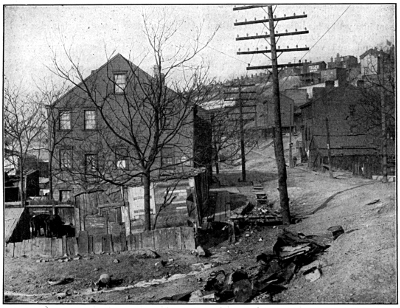
A SKUNK HOLLOW DAIRY.
The cows live in the boarded up shed. The surface drains running beside
the walk, empty into the well from which the people draw water.
Next to her is a burnt-out shell of a four-family house; no attempt is
being made to prop it up or tear it down, and it hangs there towards
the street with [Pg 894]uncertain intentions. The owner will tell you that it
"was fired on a dark night,—not by a friend," and then he will shrug
his shoulders and mutter something about the neighborhood. He sits on
his little stoop all day, this owner does, in his Sunday suit and best
hat, replete with darkey respectability. Crutches are beside him and
his feet are bandaged. Sitting near him, like a jack-knife on the point
of snapping shut, is an old black mammy, her eyes glazed with coming
blindness. She wears Prunella gaiters, a calico gown, and a sunbonnet
with a wide limp frill, and is as much a personification of the old
South as the man is of the new. She points fondly over her shoulder to
her two stuffy rooms, crammed with knick-knacks, and tells you they
must go under the hammer next week unless she can get help. This young
man here would pay her a rent of eight dollars a month for three rooms,
but he is just out of the hospital and unable to work. His leg was
crushed in the steel mill six weeks ago and not one penny has been sent
him yet by his bosses. Both of them are living on credit and hope. The
neighborhood isn't very bad, they say, "although there are some very
disbelieving people in it." But they don't know a better, where folks
would let out to niggers.
So far then we have found instances of bad streets, unsanitary housing,
trade accidents and the race problem.
Then one comes to a house, one story high at the street two at the
rear, which has two rooms opening in front and two toward the hollow.
In these rooms live an Irish widower and his two children of ten and
twelve years, together with a miscellaneous lot of colored people. They
quarrel, and have to be watched by the police.
A step farther we meet a Scottish mill laborer out of work. He proudly
points to the playhouse he has built for his two little girls "to keep
'em off the street." It is set up against the toilet, but that can't be
helped. The mixed family next door pick rags "and carry on" in the shed
hard by. The woman there has "chronic tonsilitis" which is dangerous
for the children. The mother wishes there was some better place for the
children to play.
Up to this point one feels that this is a settlement of mill-ends;
mill-ends of people, living in mill-ends of houses, on mill-end jobs,
if they work at all. It does not seem possible that anyone could come
to live on Ewing street from deliberate choice. With something of a
start one finds, in this row of demoralization, a home just vacated
by a charitable agency for the help of colored children. It was a
temporary home for boys and girls and babies, occupying the ground
floor and basement of a house unsanitary and dark, having no gas, no
running water, and no yard, only a rickety back stoop, offering an
unparalleled view of Skunk Hollow. In a middle room, dark except for
one outer window and one cut through into the back room, slept eight or
ten children two in a bed, feet to feet, boys and girls from infancy to
twelve years. The institution has gone now to a better neighborhood.
This particular house hasn't a bad name; it was the one further down
that was raided last month. Two under-age girls were found there, but
the madam got off with a fine and the girls disappeared. Some other
people of doubtful credentials are moving in; maybe they are good and
maybe not. They are carrying in their household goods now. They do not
look unlike the others of the neighborhood. A thin colored woman stands
off and watches, rocking her baby in her arms. She is seized with a fit
of coughing, and turns into the dark doorway of her shack. One does not
need to follow her to know that she represents one more city problem.
The vantage point for a view of Skunk Hollow seems to be the back
stoops of the clingers on the edge of the basin. Here one becomes aware
that the hollow is a public dumping ground of ashes and tin cans. As
wagons drive up and drop their contents the air itself becomes full of
refuse. An occasional thin stream of water trickling down from where
you stand. This is the Ewing street sewage making its way to the bottom
of the valley.

INSTITUTIONAL CHARITY IN SKUNK HOLLOW.
[Pg 895]
The hollow seems to follow the bed of an old river; it winds away
around a huge hill of gravel where two railroads lie. On a delta
between the railroad tracks, the boys have improvised a playground.
Farther along there is a straggling bunch of houses. You notice a
little girl washing clothes on one of the back piazzas. A little boy
runs out and cuffs her until she runs into the house crying, and a man
comes out and chases the boy. The boy climbs a neighbor's fence and
vanishes. A colored woman and a white woman are seen on the path that
winds through this settlement; they go into one of the houses and shut
the door. An Italian comes out of the same door a minute later, and
walks off down the railway track. The rears of these houses present
another solid line of reeking, broken-down toilets with box vaults,
unflushed, on platforms built level with the rear floor of the houses.
Tucked in between disreputable families of the lowest type are, here
and there, bright faced thrifty Italians. Two families have been
brought to Skunk Hollow from respectable neighborhoods because of the
hard times. In one of their houses renting for nine dollars a month,
the rear room is a ten by six, cubicle, with a two by two window in it
directly opposite and two feet away from the doorway of the toilet.
The air? Well, the window has a solid shutter and when that is closed
the air isn't so bad and keeps out disease. As the mother talks, two
little chained dogs bark at the babies loaded on her arms, and on the
edge of the railing, which prevents the unwary from stepping off the
platform into a landslide of rubbish below, fruit and clothes are
drying, macaroni is soaking, and busybody flies are hurrying from one
thing to another. Any typhoid? Oh yes, the grandmother died with it,
and one of the children had it, but was taken to a hospital and got
well.
Towards the end of Neville street, in the heart of the hollow, we come
to a back yard. The house, for its own reasons, prefers to front on the
railroad. In the yard is a large shed patched with odds and ends of all
sorts of boards, layer upon layer. The people in the house,—most of
whom are "women boarders",—say it is used just to put things in. As a
venture you suggest cows? Yes, there are cows there, three, the milk is
sold for the babies in the neighborhood. The man says the cows "graze
upon the hills around the hollow." He glances at the hills and laughs.
It is true the cows haven't grazed there this summer, and in the winter
it is best for them to be in a warm dark shed.
As we climb back up the stairs in the late afternoon, we meet the lamp
lighter[Pg 896] going down with his ladder. Early? Yes, but it is not well
to go into the Hollow as late as dusk. There are only sixteen lamps
there,—soon lighted, but people have their own reasons for turning
them off and few of them burn till morning. The hollow doesn't wish the
light. At the end of Ewing street, by the alley of entrance, stand two
patrolmen. They are side by side looking meditatively down into the
valley. They are watching for the little boy who climbed the fence.
"He's a Juvenile Court boy named Matthew S——," they say. "He's home
on probation. It's a queer thing about the Juvenile Court, it takes
children away and locks 'em up because the neighborhood's bad, and then
it sends 'em home on probation." These men, without knowing it, were
asking for a single judge for the Juvenile Court. "He promises to do
right," one of them continued, "but they ain't enough probation women
to see that he does keep straight and he's the worst one we've got on
the beat." This one was asking for an adequate number of probation
officers. "Now, do you see that tight, brick house down there beyond?"
they asked. "That's a colored disorderly house,—run for booze. That
little white girl who's washing on them steps goes there all the time.
She stays out nights,—away from home. The father works hard and brings
home all his money; but the woman,—she don't care. Ain't the Juvenile
Court no way of catching the mother? She ought to go to the workhouse."
He was asking for an enforcement of the adult delinquency law. The
conversation ran on and the patrolman told more of the affairs of
Skunk Hollow. He told of speak-easies, and hang-outs of all kinds,
masked under the appearance of small grocery shops. At the foot of
the stairs, he said, an Italian interpreter was found dead within the
year, struck from behind by an Irish-American. The man smoking there
and talking to the little girl over the fence had done it, but there
was no evidence. Two little children belonging to the colored woman who
keeps the disorderly house were playing in the dust. The patrolmen were
letting them stay home until they could get them in a raid. "Where do
you suppose they'll bring up?" one of them said. "The mother won't get
more than a fine and she can pay it."
"Now watch the boys!" said the other. "Here comes a freight." The
train wound slowly into a nest of little boys playing ball. After it
had passed there was not a boy to be seen. "Catching rides" said the
patrolman with an appreciative chuckle. "They'll go round the hill and
come back by way of the main street. Then I'll chase 'em in for playing
where they ain't no right, and back they'll come to Skunk Hollow. I
wish I had some other place to send them." The playground problem again!
On the skyline around the hollow the church spires stood out blacker
than the smoke in which the valley was shrouded. An American flag waved
from the school house on the main thoroughfare, and the fanciful towers
of Luna Park peered jeeringly into this pest hole of neglect. "Shame,
ain't it?" said one of the patrolmen.
FOUR TYPES OF HOUSING ILLS IN MILL TOWNS
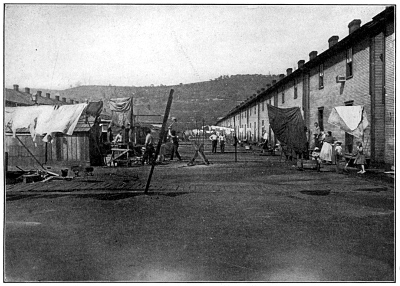
SCHOEN: Box-like rows of company houses with
out-buildings between.
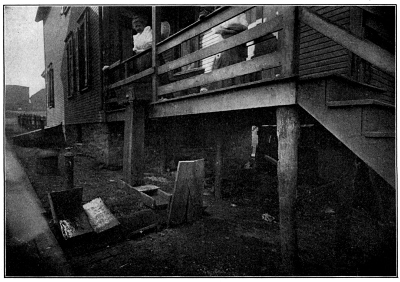
DUQUESNE: Filthy wooden-drain and yard hydrant.
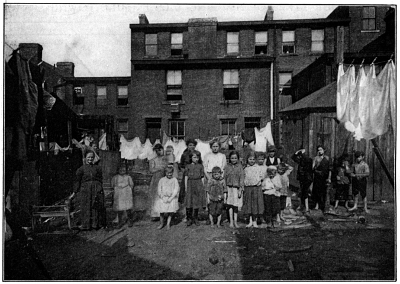
McKEESPORT.
Strawberry Alley, Interior Court of Jerusalem or "Bowery." The hydrant
at the right was in close proximity to octagonal privy structure and
was only water supply for the entire court. On the date the photograph
was taken, the hydrant had been out of business for two days and
tenants had carried their water from another court across the street.
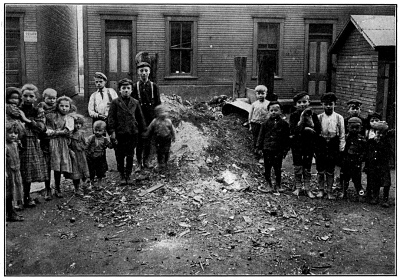
BRADDOCK.
Rubbish in rear yard of Willow Alley; where the children play. Two
hydrants and two vaults are expected to equip thirty apartments.
PAINTER'S ROW
THE STUDY OF A GROUP OF COMPANY HOUSES AND THEIR TENANTS
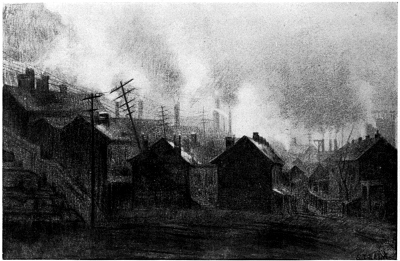
Drawn by Joseph Stella.
PAINTER'S ROW AS IT STOOD IN THE SPRING OF 1908.
[Pg 897]
PAINTER'S ROW
THE UNITED STATES STEEL CORPORATION AS A PITTSBURGH LANDLORD
F. ELISABETH CROWELL
FORMER SUPERINTENDENT, ST. ANTHONY'S HOSPITAL, PENSACOLA, FLORIDA.
[Pg 898]
The United States Steel Corporation owns property on the South Side
of Pittsburgh just beyond the Point Bridge. Here is located the old
Painter's Mill, which is one of the plants of the Carnegie Steel
Company, which in turn is one of the constituent companies of the
United States Steel Corporation; and here, also, stands what remains of
Painter's Row, where the company has housed certain of its employes,
mostly immigrants. When the Carnegie Steel Company took over Painter's
Mill, it renovated the plant so as to turn out the sort and quantity
of output which the Carnegie name stands for. When it took over
Painter's Row, it did nothing. When, a little over a year ago, and
several years after the purchase of the property, I made a detailed
investigation of the place, I found half a thousand people living there
under conditions that were unbelievable,—back-to-back houses with no
through ventilation; cellar kitchens; dark, unsanitary, ill-ventilated,
overcrowded sleeping rooms, no drinking water supply on the premises;
and a dearth of sanitary accommodations that was shameful.
Painter's Row was originally a succession of six rows, some brick,
some frame, built on the side of a hill that slopes from the foot of a
lofty palisade down to the Ohio. Houses and mills immediately adjoin
and tenants are even housed in an old brick building, in another part
of which some of the mill offices are located. Sluggish clouds of
thick smoke hang over the cluster of roofs and the air is full of soot
and fine dust. Noise presses in from every quarter,—from the roaring
mill, from the trolley cars clattering and clanging through the narrow
street which divides mill and rows into two sections, from the trains
on the through tracks above the topmost row and from the sidings which
separate the lowest row from the river bank and which are in constant
use for the hauling of freight to and from the mills.
(The story of Painter's Row should be considered in its
bearings. The United States Steel Corporation is building a
remarkable new town at Gary, Indiana; its subsidiary companies
have promoted house building along original lines, notably
at Vandergrift, Ambridge and Lorain, and the Carnegie Steel
Company has fair, low rental houses at Munhall and elsewhere.
On the other hand, other Pittsburgh corporations own company
houses which have been equally as bad as Painter's Row; and a
similar story could be written of a shack at one time owned
by one of the foremost Protestant churches of Pittsburgh, and
razed to the ground only because the headworker of Kingsley
House had the courage to publish its picture and the name of
the owner.
We have no animosity in singling out one corporation; but
we have a very serious purpose in detailing the facts as to
this row of company houses. There is ground for difference of
opinion from a business as well as a social point of view,
as to whether it is desirable for an industrial corporation
to own and rent homes to its employes. But if industrial
chairmen, presidents and superintendents become landlords,
they must bear the responsibilities of landlords; and only as
the public holds them up to these responsibilities as stiffly
as their stockholders hold them up to dividends, will they
be in position to devise and carry out policies which, as
individuals, we may assume they would act upon. This story
of one high-spirited New England stockholder and 500 company
tenants indicates, moreover, that some investors are willing to
lead the public in such demands.
With the standards it is setting at Gary, the United States
Steel Corporation cannot afford to be responsible for
such conditions as these at Painter's Row, whether in the
Pennsylvania steel district, at its mines in Northern Michigan,
or at its plants in the South. For the Survey to have selected
a lesser, independent company for criticism, would have been to
lay ourselves open to the charge of fear of the big offender;
for us to have found a more humanly destructive group of bad
houses, would have been impossible.
DIRECTOR OF THE SURVEY.)
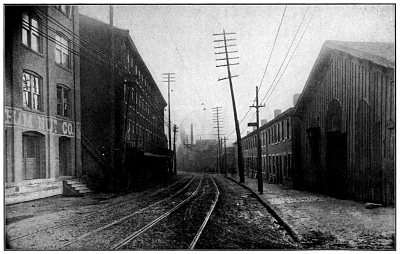
WEST CARSON STREET AT TIME OF FIRST INSPECTION.
Tenements of Painter's Row at left; nine families on first and second
floors without toilet accommodations. One-family houses at right.
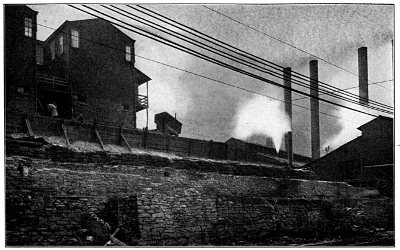
WHERE THE TENEMENTS WERE TORN DOWN.
Present site of row shown in picture on opposite page. Closets and
sinks installed in topmost row, tenants of which formerly had to go 360
steps to get water.
Dirt and noise are inseparable adjuncts to life in a mill district,
deplorable, but unavoidable; but workers in the mills [Pg 899]
[Pg 900]
[Pg 901]
[Pg 902]need not
necessarily be deprived of sufficient light and air such as it is,
and water, and the common decencies of life. In the winter of 1908, I
spent several days in Painter's Row. I watched grimy little children at
play. I talked with the women, the home-makers; I saw men who had been
working on the night shift lying like fallen logs, huddled together
in small, dark, stuffy rooms, sleeping the sleep of exhaustion that
follows in the wake of heavy physical labor. Above all, I sought to
learn how the tenants fared in these three things: ventilation and
water and sanitary conveniences.
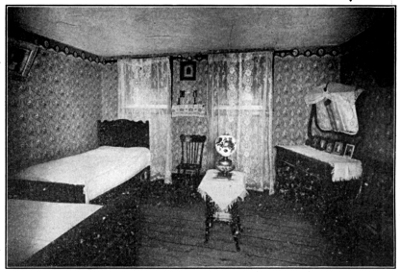
CELLAR BED ROOM.
Windows entirely below passage level, showing how some households
maintain standards against difficulties.
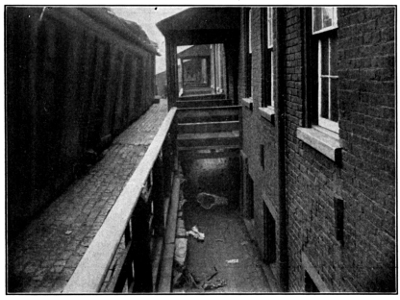
PASSAGE AND AREA.
Showing below at right windows of cellar bed room shown above.
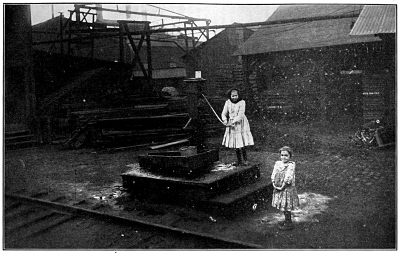
THE "TOWN PUMP."
Drinking water supply for 568 people living in Painter's Row; and for
the operatives in the mill.
In the two rows nearest the river, there were twenty-eight houses
divided from cellar to roof by a party wall, so that the rooms in
each apartment were arranged one above the other; the result was that
there was no through ventilation, and consequently the rooms were
ill-smelling at all times and stiflingly close in summer. There were in
the different rows, twenty-seven cellar and basement kitchens, dark,
unsanitary, ill-ventilated. Besides these, there were six cellar
[Pg 903]
[Pg 904]rooms more than halfway below the ground level, that were occupied
solely as sleeping rooms. The windows of these cellars were small, and
the little light and air that could gain admittance under the best
of circumstances was obstructed by a row of ramshackle sheds which
bordered the narrow area upon which these windows opened. There were
many other gloomy rooms which it would be but repetition to describe.
But the tale of dark, ill-ventilated sleeping quarters would be
incomplete without passing mention of a space under a staircase that
had been walled off and that was entered from a kitchen. Into this
"hole in the wall" a bed had been squeezed by some hook or crook, and
there two boarders stowed their bodies at night. I found the worst
overcrowding in the row at the top of the hill. In one apartment, a
man, his wife, and baby and two boarders slept in one room, and five
boarders occupied two beds in an adjoining room. In another apartment
of three rooms, the man, his wife and baby slept in the kitchen,
their two boarders in a second room; and the third room was sub-let
and occupied as a living and sleeping room by five persons,—a man,
his wife and child and two boarders. This last room was a small one,
containing two beds, a stove, table, trunks and chairs. Once inside,
there was scarcely room to turn comfortably.
Not one house in the entire settlement had any provision for supplying
drinking water to its tenants. Mill water was piped out to the
rows,—an ugly, dirty fluid, which, however tired or thirsty they were,
the people would not put to their lips. I asked the question at every
doorstep and got the same reply. They went to an old pump in the mill
yard,—360 steps from the farthest apartment, down seventy-five stairs.
This "town pump" was the sole supply of drinking water within reach of
ninety-one households, comprising 568 persons.
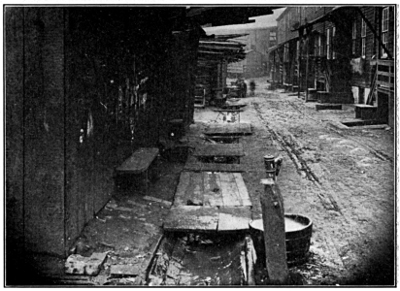
PIPE EMPTYING MILL-WATER INTO OPEN DRAIN BETWEEN ROWS.
The water pumped from the mill was used for cleansing purposes. When
the pressure was low, there was none even of that to be had. In only
two cases was this wash water piped directly into the house. Tenants
in the other houses carried it from bent pipes that emptied into open
drains running between the rows, or into troughs at the end of the
buildings, whence it had to be carried up two or three flights of
stairs if they happened to live in the upper stories. From these same
apartments the waste water had to be carried out and down and emptied
into the drains. The marvel was not that some of the homes were dirty;
the wonder was that any of them were clean,—for against such obstacles
cleanliness was to be secured only at the expense of tired muscles and
aching backs. I talked with one mother whose two rooms on the top floor
were spotless, and whose children were well looked after. Day after
day, and many times a day, she carried the water up and down that her
home and her children might be kept decent and[Pg 905] clean. I looked at her
bent shoulders, gaunt arms and knotted hands. Work aplenty,—necessary
work,—there was and always will be for her to do, but those shoulders
and arms and hands had to strain laboriously over unnecessary work as
well. "God! Miss, but them stairs is bad," she said.
As was said at the beginning, when the Carnegie Steel Company took over
Painter's Mill, it renovated the equipment of the plant; when it took
over Painter's Row, it did nothing.
One row of four houses had waste sinks in the apartments and another
row of one-family houses had a curious wooden chute arrangement on
the back porches, down which waste water was poured that ran through
open wooden drains in the rear yard to the open drain between this row
of houses and the next. A similar arrangement had been made for the
convenience of six families living in the second story of the row of
tenement houses, where two wooden chutes from the porch above carried
the waste water down to the curb at Carson street. They carried other
things besides waste water,—filth of every description was emptied
down these chutes,—for these six families, and three families below
on the first floor had no closet accommodation and were living like
animals. Some families disposed of slops and excreta in the way just
indicated; others used a bucket containing ashes, which was emptied
into a wooden garbage bin on the street at the end of the row of houses.
Officials of the mill company, when this condition of affairs was
pointed out to them, replied that the vault in the rear of this row
of houses was built for the use of these families as well as for the
other nineteen families in these two rows, and that they could secure
a key to a closet compartment by applying for it at the offices. As
a matter of fact these people had never been offered keys and they
volunteered the statement to the investigator that they had no closets.
The vault just mentioned was halfway up the hill between these two
rows of houses. To reach it, anyone living in an end apartment in the
second story front would be obliged to walk half the length of the
second story porch to where the inside stairs led down to the street,
then along the street (for the sidewalk was but two and a half feet
wide, and completely covered with old lumber and debris of every
description), then up a difficult flight of outside stairs, steep
and with narrow treads, then two or three steps on the level, then
more stairs, and so on until one had taken a hundred and eighty-six
steps, sixty-five of which were stairs. This was called "closet
accommodations" for want of a better term.
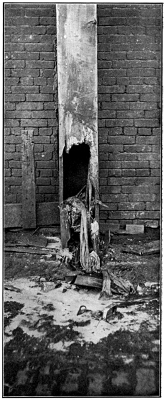
WOODEN CHUTE FROM A SECOND STORY GALLERY, DUMPING ITS
FILTH AT THE CURB ON CARSON STREET.
[Pg 906]
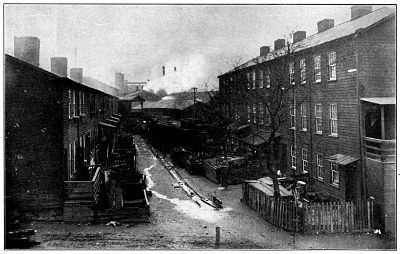
THE LOWER ROWS IN 1907.
Showing frame two-family dwellings between Carson street and the river.
Open drain between the rows; bad surface drainage. Twelve families at
right had no toilets.
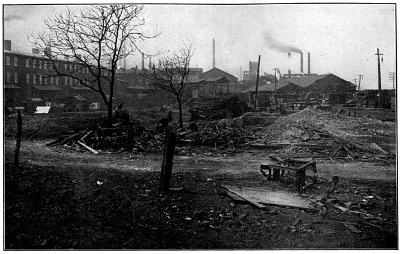
ONE YEAR LATER: THE ROWS TORN DOWN.
[Pg 907]
Equally bad conditions prevailed in the row of houses nearest the
river. Closets for these houses were formerly located across the
railroad tracks on the edge of the bank. During the flood in the spring
of 1907, these were swept away and had never been replaced. The twelve
families living in this row also used buckets and emptied the contents
into the river. One family in the next row of houses claimed that they
had never been given a closet key. In all, twenty-two of the ninety-one
families were living without the first elementary conveniences that
make for sanitation. The full evil of this state of affairs is not
really clear until one remembers that these families were occupying
two-and three-room apartments, nearly all of them having several
children, and anywhere from two to five boarders each.
It is fair to ask, why even immigrant laborers put up with such
conditions? To the minds of the men, for two very good and sufficient
reasons. The houses were near the mill and rents were cheap. The
ledge of land along the foot of Mt. Washington affords few building
sites; and the Painter's Mill section is, perhaps, the extreme example
of the general housing-shortage of the South Side. Men who work in
heat, work ten or twelve hours a day, and work at night alternate
fortnights, want to live near the mill. Especially is this true of day
laborers who work on repair gangs and cleaning-up work, and who may be
called out at any time. This is as true of the mill towns, as of the
working force of such a plant as Painter's Mill, in the heart of the
city. On the other hand, the mill management wants these men there,
for just such emergency calls. The rents in Painter's Row averaged
$2.40 a room monthly,—cheaper by far than these laborers could
secure accommodations from ordinary landlords in many other sections
of Pittsburgh; and that is a dominating consideration to a man with
a family, earning $1.65 a day, or a single[Pg 908] immigrant whose whole
purpose in coming to America is to make money and who will stomach any
personal ills to hold on to it. On the other hand, it must be borne
in mind that these rents aggregated the company over $7,000 a year.
Such an item is a bagatelle in the balance sheet of the United States
Steel Corporation; and it would be foolish to suppose that the rows
were rented out to their employes as a money making scheme. They were
rented out on easy terms to keep laborers within call at any hour of
the day or night, and the fact that Painter's Mill is an old plant and
likely to be abandoned, no doubt influenced the management in holding
the housing property as it stood without rehabilitation. But the fact
remains that these rentals amounted to a sum nearly sufficient to pay
the whole taxes on the Painter's Mill property, mill, equipment, land
and houses.
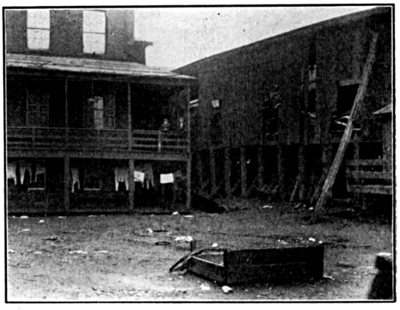
DARK COVERED PASSAGE WAY THROUGH WHICH WOMEN AND
CHILDREN WERE OBLIGED TO GO TO REACH PUMP IN MILL YARD.
To-day, the situation in Painter's Row is very different. Three rows of
houses have been torn down, and radical improvements made to others.
A variety of factors entered into this change and the story is worth
the telling. The evolution of social consciousness is interesting,
whether in an individual or a corporation. The initial factor in such
a development may be one of several,—motives of self-interest, the
weight of public opinion or the letting of light into dark places.
Motives of self-interest did [Pg 909]not suffice to make the Carnegie Steel
Company a good landlord in the present instance. In other words,
the company had not recognized it to be worth while as a business
consideration to house its human machinery with a view of maintaining
such machinery at its highest state of efficiency. Its mills, with
their equipment, were repaired and improved in order to increase the
quality and quantity of their output. But common laborers were too
easily replaced for an effort to be made to conserve their health or
well-being by repairing or improving these houses in which they lived.
If ten men fell out, ten more were ready to step in and fill their
places.
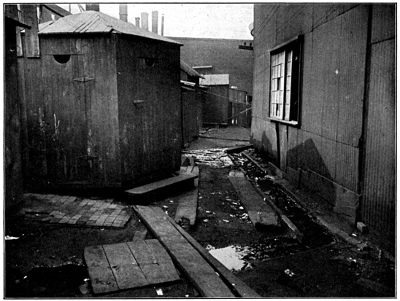
PAINTER'S ROW TO-DAY.
Privy and open drain. Stagnant waste water, garbage, and mill building
of the United States Steel Corporation.
But Painter's Row was not the only instance of bad housing in
Pittsburgh. Other landlords were equally indifferent, and evil housing
conditions were found all over the city. In March, a preliminary report
on general housing conditions in Pittsburgh was published by the
Pittsburgh Survey. One paragraph dealt with conditions in Painter's
Row. The fact that the responsibility for the situation there could be
fixed directly upon one of the great corporations enhanced the value of
the paragraph as a quotable news item, and Collier's Weekly seized
upon it as a text for an editorial. The editorial brought it under
the eye of a New England stockholder whose New England conscience was
stirred. His protest at the United States Steel headquarters in New
York brought from there a communication so favorable to the company
that he felt justified in criticising the editors of Collier's for
their apparently unwarranted statements; and they, in turn, called upon
the Survey to substantiate the quotation. In support of this paragraph,
which was but a few lines long in the published report, the full
details of how things stood at Painter's Row, as I have put them down
here, were transmitted by the editors to the inquiring stockholder. He
was aroused, convinced and in position to[Pg 910] lodge another protest, this
time with the facts behind it. Light had been let in.
Meanwhile, pressure was brought to bear upon the owners of Painter's
Row from a second quarter. The health authorities were insistent that
all houses occupied by three or more families should be altered so as
to conform to the requirements of the tenement house law, thus making
mandatory the installation of sinks and water-closets in such houses.
This also involved the cutting of windows in half a dozen gloomy cellar
rooms in one building, in order to procure the required amount of light
and ventilation, a structural change which would have so weakened
the supporting walls of the building as to have rendered it unsafe.
The windows were not cut, the sinks and closets were not installed;
instead, the building was razed to the ground,—the best possible thing
that could have happened. Two other rows of two-family houses were
also demolished. They were old, ramshackle, frame buildings, not worth
repairing.
Last fall, I inspected Painter's Row for the second time. I found the
noise as incessant, the smoke and dust as penetrating, as nine months
before. The children were as grimy but they were fewer in number,
for as a result of these changes the settlement had been reduced to
twenty-eight families. When I reached the topmost row of houses on the
hillside, my inspection partook of the nature of a triumphal progress.
Some of the tenants remembered me. Gleefully they showed me their sinks
with drinking water in every apartment, and told of the closets that
had been installed in the basement. Every fixture was clean and in
perfect condition,—a refutation of the old argument that such people
unaccustomed to these conveniences in the old country will not care for
them when supplied.
I found a like state of affairs in another building formerly occupied
as a tenement, now housing but two families. Here also sinks and inside
water-closets had been installed.
By so much, then, had life in Painter's Row been made more tolerable.
Two rows of one-family brick houses remained untouched. The families
living in these houses continued to get along without drinking water
on the premises and continued to use outside privy vaults; a few were
occupying cellar kitchens. In one row, waste water and garbage were
still emptied down wooden chutes leading to open drains through the
yards. The result was odorous and unhealthy.
Much had been accomplished, something still remained to be done. The
company which had gone beyond the requirement of the law in some things
still fell short in others. Sooner or later, the health authorities
would force the removal of the privy vaults. The old pump had served
Painter's Row loyally and well, and would continue to serve it as long
as the bucket brigade moved back and forth between these remaining
houses and the mill-yard for their water. Sometimes a little child
trudged along with a great pail half filled. Again, it was the man of
the family, tired after a hard day, who brought in the ration of water.
In a way, that big, grimy pump with its old iron handle and primitive
spoutings, summed up the Painter's Row situation,—of an industry of
great mechanics who could overhaul an old plant and make it pay, but
had not brought water a few paces up the hill, or dropped a sewer a few
paces down to the river below that men and women and children might
live like men and women and children.
LITTLE JIM PARK
LEROY SCOTT
AUTHOR OF TO HIM THAT HATH, ETC.
[Pg 911]
I had taken a car over to Painter's Mill and Painter's Row and got
off at the farther end of the dingy, smoke-hung settlement. I went
through and about the houses which the great Carnegie Company leases
to its workers (with no trouble about collecting the rent, for that
is taken from their wages),—houses so close to the mill, some even
wall to wall with it, that they share almost equally with the mill
its smoke and grime and clangor,—houses which had been as unsanitary
and disease-breeding as any I have ever seen offered the poor even by
hardened slum landlords. And then, after I had gone through the rows of
houses, at the end of the settlement nearest Pittsburgh, I came upon a
sudden contrast. It was an open space, with a portion of it canopied,
and over the canopy this black-lettered sign:
LITTLE JIM PARK
It wasn't much of a park,—just a little bit of ground, in area hardly
more than an average city lot, with a second-hand iron fence around
it, with rough benches, a pavement of tan-bark and a few flowerbeds
bordered with whitewashed bricks. A poor, pitiably insignificant little
place,—yet startlingly pleasant when compared with its surroundings.
On the one side, with a row of dreary houses between, rumbled and
belched the mill; at its back was a littered waste; at its front,
across the street, was a steep hill topped by the ramshackle houses of
Stewart's Row, and this hill was muddy, stubbled over with lank dead
weeds, gullied with foul-looking, foul-smelling streams of waste water
and garbage.
I entered the park, sat down beneath the canopy, and my imagination
proceeded to explain how the park had been established. Its name
was a certain clue. "Little Jim Park,"—that fairly[Pg 912] reeked with
ultra-sentimentality. Some rich woman had been emotionally stirred by
the stories of the cheerless life of tenement children,—the Little
Jims and the Little Rosies; she had chanced to see how especially
cheerless the life of the children of Painter's Row; she had
established the park, and given it as title the more or less generic
name by which tenement children are known to sentiment, "Little Jim."
I had just credited the park to my Lady Bountiful,—had just finished
with Romance,—when Realism sauntered into the park and took the other
end of my bench. He was a working man, whose decent clothes and white
collar told me this was his day off. His coat collar was turned up, his
slouch hat pulled down. One jaw stood out with a quid of tobacco, and
his face was deeply wrinkled. He was perhaps twenty-one.
"Won't you tell me," I asked, "who gave this park to Painter's Row?"
He smiled good-naturedly at me. "Who give it? Nobody give it."
"Then how did you get it?"
"We took it," said he.
"Took it! But the name,——?"
"Oh, we just took that, too."
Here was something new in the park-building line. I drew nearer. "I
wish you'd tell me about it," I asked.
"Sure, I'll tell," said he, and I could detect pride in the park in
both the young fellow's tone and manner. He tossed his quid down upon
the tan-bark. "Used to be a little old church standing here. Little
Jim church they called it, Queer name for a church, wasn't it? Damned
if I know why they named it that. For the last five or six years it
wasn't used at all, and last spring it just collapsed. The Hunkies come
scramblin' over it and carried away all the wood to burn, and what was
left was certainly a mess.
"Well, I don't know just who started the idea,—I guess it was John
Donohue and Jim Leary (they works around the rolls in the mill),—but
pretty soon a lot of us guys had decided it would be great if we could
clear up the place and make a park. So we started at the job, and when
any of us was laid off over at the mill we was workin' here. The iron
fence we got when they tore down part of Painter's Row,—it was just
old junk you know; the bricks 'round the flower beds were some left
over from buildin' a brewery down the street, we just helped ourselves
to 'em; the arch over the gate we made out of an old pipe; the
flag-pole there used to be a pump handle of a barge pump down on the
river,—we swiped that; the ball on top of the flag-pole a carpenter
give us. We chipped in and bought this tent, and we chipped in and
bought a flag. The first one was whipped to pieces by the wind and we
had to chip in and buy another before the summer was over. Then we set
out some flowers, splashed around with some paint and whitewash, and
the park was done. The name of the church seemed sorter to belong to
the place, so we called it 'Little Jim Park.'
"The park was what you might say opened on Decoration Day when the kids
come in and sang and performed. It was a great place for the kids to
play all summer, and a fine place for us to sit around of evenings and
chin and sing. Never had nothin' of the sort here before, you know. But
the big show here at Little Jim Park was Old Home Week, when we had it
all fixed up with buntin' and had it lit up of nights. I guess the park
ain't much to look at just now, for the geraniums have all been took
up, and the fellows are takin' care of 'em in their houses through the
winter. But in summer, when the flowers are out, and things are fixed
up, I tell you what Little Jim Park looks mighty good to Painter's Row!"
Somehow, when he had finished, this little park, a park by the
people, seemed to be a thousand fold more beautiful, a thousand fold
more significant. It and the great mill stood there in striking
contrast; the mill and the houses expressing the indifference of the
company to its human machines, the park the spontaneous expression of a
great native desire, though choked down by long hours and the general
oppressive dinginess,—the up-reaching, outreaching desire of the
people for light, for air, for natural happiness, for development.
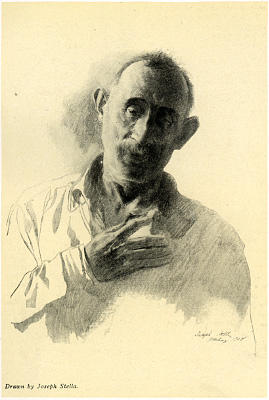
Drawn by Joseph Stella.
PITTSBURGH TYPES.
AN OLD SLAV.
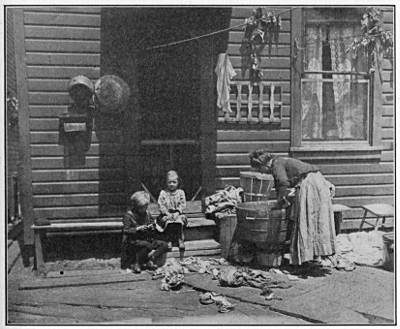
Photograph by Lewis W. Hine.
WASH-DAY IN A HOMESTEAD COURT.
MARGARET F. BYINGTON
FORMER DISTRICT AGENT, BOSTON ASSOCIATED CHARITIES
[Pg 913]
From the cinder path beside a railroad that crosses the level part of
Homestead, you enter an alley, bordered on one side by stables and on
the other by shabby two-story frame houses. The doors of the houses
are closed, but dishpans and old clothes decorating their exterior,
mark them as inhabited. You turn from the alley through a narrow
passageway, and find yourself in a small court, on three sides of which
are smoke-grimed houses, on the fourth, low stables. The open space
teems with life and movement. Children, dogs and hens make it lively
under foot; overhead long lines of flapping clothes are to be dodged. A
group of women stand gossiping in one corner waiting their turn at the
pump,—this pump being one of the two sources of water supply for the
twenty families who live here. Another woman is dumping the contents
of her washtubs upon the paved ground, and the greasy, soapy water
runs into an open drain a few feet from the pump. In the center of the
court, a circular wooden building with ten compartments opening into
one vault, flushed only by this waste water, constitutes the toilet
facilities for over a hundred people. For the sixty-three rooms in the
houses about the court shelter a group of twenty families, Polish,
Slavic, and Hungarian, Jewish and even Negro; and twenty-seven little
children find in this crowded brick-paved space their only playground.
The cinder path has led us to the heart of the sanitary evils of the
steel town. For this court typifies those conditions which result when
there crowd in upon an industrial[Pg 914] district, hundreds of unskilled
immigrant laborers, largely single men, largely country people, who
want a place to sleep for the least possible cash. Most of the petty
local landlords who provide quarters care nothing for the condition of
their places, and regard the wages of these transients as legitimate
spoils.
To determine the extent of such congestion, I made a study of the
twenty-one courts in the second ward of Homestead, where yards,
toilets, and water supply are used in common. In these courts lived 239
families, 102 of whom took lodgers. Even of those who lived in two-room
tenements, a half took lodgers. Fifty-one families, including sometimes
four or five people, lived in one-room tenements. One-half the families
used their kitchens as sleeping rooms. Only three houses had running
water inside, and in at least three instances over 110 people were
dependent on one yard-hydrant for water. These are but fragmentary
indications, but the situation seemed serious enough to warrant an
intensive study, with the help of an interpreter, of these courts.
The background of life in this section is a gloomy one. The level land
forming the second ward, cut off from the river by the mill and from
the country by the steep hill behind, forms a pocket where the smoke
settles heavily. Here, on the original site of the town, gardens as
well as alleys have been utilized for building small frame houses.
The space is nearly covered. In some instances these houses are built
in haphazard fashion on the lots; more often they surround a court,
such as I have described. Though they vary in character, these groups
usually consist of four or six two-story houses facing the street and
a similar number facing the alley. Between these rows is a small court
connected with the street by a narrow passage. Fifty-eight per cent
of the houses have only four rooms, and only four have more than six.
The former class usually shelters two families, one having the two
rooms on the street and the other the two on the court. In summer, to
give some through ventilation to the stifling rooms, doors leading to
the stairway between the front and rear rooms are left open. As the
families are often friends and fellow countrymen, this opportunity for
friendly intercourse is not unwelcome. Indeed, the cheerful gossip
that enlivens wash day, like the card-playing in the court on a summer
evening, suggests the friendliness of village days.
Nothing in the surroundings of these festivities, however, bears out
the suggestion. Accumulations of rubbish and broken brick pavements,
render the courts as a whole untidy and unwholesome. Some of the houses
have little porches that might give a sense of homelikeness, but for
the most part they are bare and dingy. As they are built close to the
street with only this busy court behind, the owner can hardly have that
bit of garden so dear to the heart of former country dwellers. Only,
here and there, a little bed of lettuce with its note of delicate green
or the vivid red of a geranium blossom brightens the monotony. Dreary
as is the exterior, however, the greatest evils to the dwellers in
the court arise from other things, from inadequate water supply, from
meager toilet facilities, from overcrowding.
The conditions as to water supply are very serious. In all the
twenty-one courts only three families had running water in their
houses, and even the hydrants in the courts were not for individual
families. In no court were fewer than five families using one hydrant
or pump, while in exceptional instances there were as many as nineteen,
twenty and twenty-one families. As waste water pipes are also wanting
in the houses, the heavy tubs of water must be carried out as well as
in. In this smoky town a double amount of washing and cleaning must
be done. The wash is a heavy one, and when the weather permits, it is
done in the yard. This addition of tubs, wringers, clothes baskets, and
soapy water on the pavement to the already populous court makes it no
very serviceable playground for children.
The toilet accommodations, while possibly more adequate than the water
supply, are unsatisfactory in consequence[Pg 915] of the lack of running
water. There is not a single indoor closet in any of these courts. The
streets of Homestead all have sewers, and by a borough ordinance, even
the outside vaults must be connected with them. These are, however,
ordinarily flushed only by the waste water, which flows from the yards
directly into them; when conditions become intolerable, the tenants
wash them out with a hose attached to the hydrant. As long as they are
in the yards, this totally inadequate device is apparently the only one
possible. The closets, moreover, which are usually in the center of the
courts only a few yards from the kitchen doors, create from the point
of view either of sanitation or decency an intolerable condition. While
occasionally three or four families must use one compartment, usually
only two families need do so. But even this means that often they are
not locked and that no one has a special sense of responsibility, in
consequence of which they are frequently filthy. It is not perhaps
surprising that this state of affairs is tolerated by people who have
lived on farms and were used to meager toilet facilities; but the
discomfort and danger here are infinitely greater than in the country,
and here the conditions are remediable.
The overcrowding within the houses shown by the accompanying chart
makes the water and toilet conditions more unendurable. Half the
families who do not take lodgers and eighty-five per cent of those who
do, average more than two persons to the room,—a number indicative,
generally, of conditions which do not permit moral or physical well
being.
Families Classified as to Average Number of
Persons per Room.
| Number of persons per room |
1 |
2 |
3 |
4 |
5 |
5 plus |
| Families without lodgers, total, 137. percentage |
13.8 |
35.7 |
38 |
9.7 |
1.4 |
1.4 |
| With lodgers, Total 102, percentage |
5.8 |
8.8 |
42 |
30.4 |
6.8 |
5.8 |
Let us consider first the causes of such congestion in so small a town,
next its nature and results, and finally the possibility of improvement.
Three factors are involved in producing this state of affairs, the
growth of the mill and town, the low wage of the laborer, and his
ambition. The mill has developed fast, and in spite of improved
machinery has rapidly increased the number of its employes. In 1892,
at the time of the strike, 4,000 men were employed; now nearly 7,000,
exclusive of the clerical force. Moreover at each addition to the size
of the mill, homes are destroyed to give it place. And further, the
steep slopes of a hill hinder the growth of the town. Although suburbs
are gradually building beyond this hill, car-fare is an item to be
considered when a man earns $1.60 a day, and as there have not been,
except during the hard times of 1908, a sufficient number of cheap
houses for rent, the people accustomed to small quarters have crowded
together along these alleys. The lowest paid workingmen are naturally
the ones that inhabit them. Of 220 men, eighty-eight per cent were
unskilled workers receiving less than two dollars a day. This figure
is usual among the Slavs, since of the 3,602 employed in the mill,
eighty-five per cent are unskilled.
That the greatest overcrowding is in the families taking lodgers, shows
a general tendency to economize in this way rather than by crowding the
family into too small a tenement. The three dollars a month which the
lodgers pay for their room might seem a small return for the labor and
loss of privacy of home life; but in more than three-quarters of the
families taking lodgers the income from them covered the rent, while in
one-fifth of the families it was twice the rent or even more.
This tendency to economize even at the loss of home life, induced
primarily by low wages, has a further cause in the ambition of the
Slavs to own a home in a better locality, or to buy a bit of property
in the old country to which they may some day return. Again and
again in explaining why they took lodgers these excuses were given,
"Saving to educate the children", "The father does not earn enough
to support the family", "Taking boarders in order to start a bank
account". Thrift, it would seem, is not a virtue to be recommended
indiscriminately. Figures as to overcrowding are in themselves but a
lifeless display; when you see them exemplified in individual homes
they become[Pg 916] terribly significant. I entered one morning a two-room
tenement,—the kitchen, perhaps twelve by fifteen feet, was steaming
with vapor from a big washtub on a chair in the middle of the room.
Here the mother was trying to wash, and at the same time to keep the
elder of her two babies from going into a tub full of boiling water
standing on the floor. On one side of the room was a huge, puffy bed,
one feather tick to sleep on and another for covering; near the window
a sewing machine, in the corner an organ,—all these besides the
inevitable cook stove whereon in the place of honor was cooking the
evening's soup. Asleep upstairs in the second room were one boarder and
the man of the house. The two other boarders were at work.
Can you picture the effect on the mother of such a home, the overwork
for her, the brief possibility of rest when the babies come? Yet
it is even more disastrous to the children. And, as appears in the
accompanying chart, many of the families who take boarders are families
with children.
| No CHILDREN |
WITH LODGERS FAMILIES |
WITHOUT LODGERS FAMILIES |
| 0 |
30 |
███████████████ |
24 |
████████████ |
| 1 |
30 |
███████████████ |
46 |
███████████████████████ |
| 2 |
25 |
█████████████ |
26 |
█████████████ |
| 3 |
10 |
█████ |
22 |
███████████ |
| 4 |
7 |
████ |
15 |
████████ |
| 5 |
0 |
|
7 |
████ |
The situation brings serious results both to the health and the
character of the children. The overworked mother has neither time nor
patience for their care and training. As half of the families use the
kitchen for sleeping, there is a close mingling of the lodgers with the
family which endangers the children's morals. In only four instances
were girls over fourteen found in the families taking lodgers, but
even the younger children learn evil quickly from the free spoken men.
One man in a position to know the situation intimately, spoke of the
appalling familiarity with vice among the children in these families. A
priest told me that he preached to the women against this way of saving
money, but as long as wages are low and the good ambition to own a
home or have a bank account can find no other way of fulfilling itself,
it is difficult to persuade them to give it up.
The crowding and other ills have also serious physical consequences.
The birth rate and the deaths of children under two, show that while
among the Slavs in the second ward a child died for every three that
were born, among the other population of Homestead one died for
every six that were born. Against many of these deaths was the entry
"malnutrition due to poor food and overcrowding." Sadder still is the
case of those wailing babies who do survive and begin life with an
under-vitalized system ready for both the disease and the dissipation
that attend weak bodies and wills.
Outside of the crowded tenement rooms where are the many children to
play? In investigating the conditions in one narrow court, I opened a
door into a low shed where the entrails of a chicken lay on the floor.
It was foul and dark and I turned away in disgust, but the bright
little boy beside me piped up cheerily, "Oh that's our gypsy cave." A
sorry region, surely, for a child's imagination to rove!
[Pg 917]
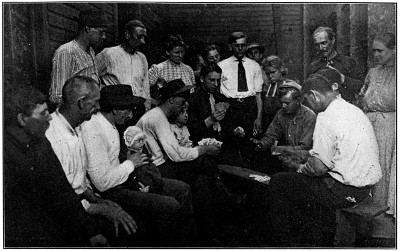
Photograph by Lewis W. Hine.
EVENING SCENE IN A HOMESTEAD COURT.
[Pg 918]
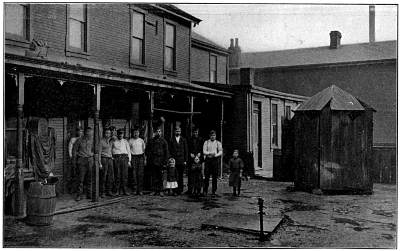
Photograph by Lewis W. Hine.
SLAVIC COURT, HOMESTEAD.
Showing typical toilet and water supply; also a few of the boarders in
these houses.
[Pg 919]
The congestion in Homestead must be considered not only from the
standpoint of the family and the child, however, but of the single man.
His problem is no small one. In the figures for the mill we find that
30.5 per cent of the total number of Slavs are unmarried. This large
group, in the period before they send back for a wife or sweetheart,
must find some sort of a home. While some are scattered in families and
create the lodging problem we have been considering, others live in
groups over which a "boarding boss" presides. In West Homestead, for
example, in about twenty houses there were three hundred Bulgarians,
among whom at the time of the depression there were only three women.
These scattered houses hidden away on the outskirts of the town housed
a group of happy, industrious men, all ambitious to hoard their money
and return to the old country as men of property. They cared little how
they lived so long as they lived cheaply. One of these homes consisted
of two rooms one above the other, each perhaps twelve by twenty feet.
In the kitchen I saw the wife of the boarding boss getting dinner,
some sort of hot apple cake and a stew of the cheapest cuts of meat.
Along one side of the room was an oilcloth covered table with a plank
bench on each side, and above a long row of handleless white cups in a
rack, and a shelf with tin knives and forks on it. Near the up-to-date
range, the only real piece of furniture in the room, hung the "buckets"
in which all mill men carry their noon or midnight meal. A crowd of
men were lounging cheerfully about talking, smoking and enjoying life,
making the most of the leisure enforced by the shutdown in the mill. In
the room above, double iron bedsteads were set close together and on
them comfortables were neatly laid. Here besides the "boarding boss"
and his wife and two babies, lived twenty men. The boss, himself, was a
stalwart Bulgarian who had come to this country several years ago, and
by running this house besides working in the mill, had accumulated a
good deal of money. The financial arrangements of such an establishment
are simple. The boarding boss runs the house, and the men pay him
three dollars a month for a place to sleep, for having their clothes
washed, and their food cooked. In addition an account is kept of the
food purchased, and the total is divided among the men at each pay day.
The housewife purchases and cooks what special food each man chooses
to order: beef, pork, lamb, each with a tag of some sort labeling the
order, and all frying together. A separate statement is kept of these
expenses for each boarder. Such an account for a group of men in a
small Slavic household may prove of interest.
The family (which consisted of a man, his wife, his brother, and three
children, eleven, eight, one, and four boarders), occupied a house of
four rooms, one of them dark, for which they paid a rent of fourteen
dollars. The man, though he had been in this country about twelve
years, was still earning only $10.80 a week with which to meet the
needs of his growing family. One-half the cost of the food was paid by
the boarders including the brother, amounting for each man to about
$1.06 a week. For the whole family, the expenditure was as follows:
flour and bread, $2.03; vegetables, $1.06; fruit, $.56; milk, eggs,
etc., $1.98; sugar, $.49; sundries, $.73; meat, $5.78; a total of
$12.63. Besides this the boarders ordered "extras," and the following
table for a month expresses the men's individual likings:
Expenses for the Month.
|
Pamhay. |
Baker. |
Drobry. |
Pilich. |
Timko. |
| Beef |
|
.87 |
|
1.20 |
.48 |
| Pork |
3.71 |
.92 |
2.14 |
3.04 |
2.30 |
| Veal |
|
.90 |
| Eggs |
|
|
|
.10 |
.05 |
| Milk |
|
.21 |
1.90 |
| Cheese |
.10 |
.19 |
|
.09 |
.05 |
| Fuel |
.15 |
.25 |
.25 |
| Total |
$3.96 |
$3.34 |
$3.04 |
$4.43 |
$2.88 |
This made the average total expenditure about $8.02 a month for each
man. Adding $3 a month for room and washing, the total expense each
is about $11. These men make from $9.90 to $12 a week. It is obvious
therefore that a large margin remains for saving or indulgence, after
clothes are provided. They are thus able if they will to send for wife
and children, to fulfill their duties to aged parents, or to provide
for their own future.
While this program is an economical one, it by no means furnishes to
this great group of homeless foreigners a normal life. Though some
expect to return and others to send for their families when they have
made their fortunes, all for the time being are in a strange country
with neither the pleasures nor restraints of home life.
To those who have no family at home or no desire to save, the
temptation to spend money carelessly is great. Unfortunately the
saloons get a large tribute. On pay Saturday, the household usually
clubs together to buy a case of beer and drink it at home. These
ordinarily jovial gatherings are sometimes interrupted by fights, and
the police have to be called in. One officer, who had been on the
force for nine years, said that while in general these men were a
good-natured, easy-going crowd, and in all his experience he had never
arrested a sober "Hunkie," when they were drunk [Pg 920]there was trouble.
The punishment usually inflicted for their disorderly conduct is of
course, a small fine, which has little or no effect. It is indeed
currently said that the bigger the fine the better they like it, as
they feel that it indicates increased importance.
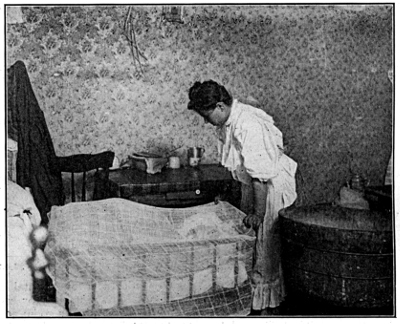
A CONTRAST—I.
Photograph by Lewis W. Hine.
CLOSE QUARTERS. ONE ROOM AND THREE IN THE FAMILY.
It is not surprising that excesses exist in a town which offers so
little opportunity for wholesome recreation, and whose leaders have
failed to realize any obligation toward the newcomers. The Carnegie
Library represents the only considerable effort to reach them. The
clubs are open to the Slavs. Aside from a class in English, however,
they are not adapted to non-English speaking people. Even the Slavic
books which the library bought for their benefit are seldom used. I
found that a number of the influential Slavs in Homestead did not
know that these books were in the library; therefore I judge that one
reason why they are not used is a lack of proper advertising. That
the building is on the hill away from their homes, that it has an
imposing entrance which makes the working man hesitate to enter, and
that certain forms must be gone through before books can be secured,
or the club joined,—these things have doubtless acted as deterrent
influences. However desirous the management of the library may be to
reach them, the Slav's ignorance of our language and customs will keep
many from ever getting inside. If a library is really to reach the
foreign population, it must not wait for them to come to it; it must
go to them. A simple reading room opening right into the courts where
the people live, where they could drop in after the day's work, find
newspapers and books in their own tongue, and where the Americanized
Slav could reach his newly-come brethren, teaching them both English
and citizenship, would become an important center of influence.
For though these people are in many respects aliens, they are not
unwilling to accept American standards. The quickness, for example,
with which the women adopt our dress, reveals an adaptability which
might find expression in more important ways. That they are glad when
they can afford it, to have really attractive homes, is shown by these
pictures. They are the homes of two families from the same place in the
old country, one a newcomer, the other one of the "oldest inhabitants"
of the Slavic community.
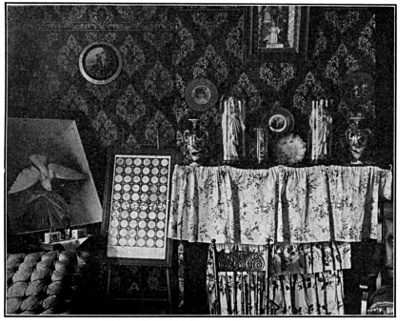
A CONTRAST—II.
Photograph by Lewis W. Hine.
INTERIOR OF HOUSE OF WELL-TO-DO SLAVIC FAMILY.
[Pg 921]
In the first instance, as the man earns but $9.90 a week, rent must
be kept low if other bills are to be paid and a little provision made
for the future. It is hard enough in a one-room tenement, though the
furniture includes only absolute necessities, to keep all one's crowded
belongings in order. On wash day morning, when this picture was taken,
there are extra complications. On the whole, therefore, the home will
be seen to be as neat as circumstances permit. The bright pictures on
the wall manifest a desire to make it attractive.
The other picture, a "front room" with its leather covered furniture,
is in a five-roomed house which the family owns. The vivid-colored
sacred pictures relieve the severity of the room; and they reveal a
dominant note of Slavic life, for if happiness is to stay with the
family, the priest must come yearly to "bless the home." The family
who came many years ago, has by slow thrift accumulated the means to
obtain this house. And though the mother, who is now a widow, still
takes boarders, the family has in general the standards of Americans.
This instance I introduce because it is well to recognize that low
standards are not necessarily permanent. When Slavs do buy their homes,
the size and attractiveness of them indicates that the unsanitary
surroundings and crowded quarters of early days were simply tolerated
until the ambition could be attained. With a house on the outskirts of
the town, a garden about it, and a glimpse of the larger out-of-doors,
they begin to feel that the dreams of their emigration have come true.
Only the few however have fulfilled the dreams and it is back in the
squalid courts that we find the typical problems of every industrial
center that has felt the tide of immigration. The Homestead community
has so far shown a general indifference to the problems which its
industry creates. The mill demands strong, cheap labor, but concerns
itself little whether that labor is provided with living[Pg 922] conditions
that will maintain its efficiency or secure the efficiency of the next
generation. The housing situation is in the hands of men actuated only
by a greed of profit. The community, on the other hand though realizing
the situation, does not take its responsibility for the aliens in its
midst with sufficient seriousness to attempt to limit the power of
these landlords.
The Slavs themselves, moreover, are people used to the limitations of
country life, and are ignorant of the evil effects of transferring the
small rooms, the overcrowding, the insufficient sanitary provisions
which are possible with all outdoors about them, to these crowded
courts under the shadow of the mill. And, as we said, their ambition
to save and buy property, here or in the old country, is a further
incentive to overcrowding.
Summing up the results of the indifference of the community and the
ignorance and ambition of the Slavs, we find a high infant death rate,
an acquaintance with vice among little children, intolerable sanitary
conditions, a low standard of living, a failure of the community to
assimilate the new race.
As we waited in one of the little railroad stations of Homestead,
a Slovak came in and sat down beside a woman with a two year old
child. He made shy advances to the baby, coaxing her in a voice of
heartbreaking loneliness. She would not come to him, and finally her
mother took her away. As they went, the Slovak turned sadly to the rest
of the company, taking us all into his confidence, and said simply,
"Me wife, me babe, Hungar." But were his family in America, it would
mean death for one baby in three; it would mean hard work in a little,
dirty, unsanitary house for the mother; it would mean sickness and
evil. With them in Hungary, it means for him isolation, and loneliness,
and the abnormal life of the crowded lodging house.
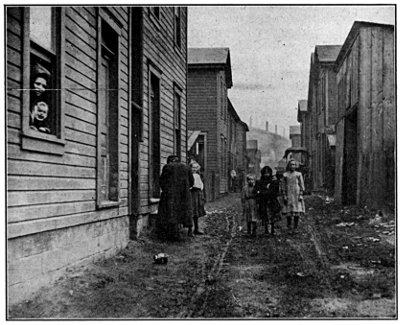
Photograph by Lewis W. Hine.
BUCH ALLEY.
Showing conditions in the unpaved alleys.

[THESE SILHOUETTES REPRESENT 622 DEATHS IN 1907 FROM
TYPHOID FEVER IN PITTSBURGH.]
THIRTY-FIVE YEARS OF TYPHOID
THE FEVER'S ECONOMIC COST TO PITTSBURGH AND THE LONG FIGHT FOR PURE
WATER
FRANK E. WING
ASSOCIATE DIRECTOR PITTSBURGH SURVEY; SUPERINTENDENT CHICAGO
TUBERCULOSIS INSTITUTE
One convincing and startling feature of the Pittsburgh Civic Exhibit
in November was a frieze of small silhouettes three inches apart
stretching in line around both ends and one side of the large hall in
Carnegie Institute in which the exhibit of the Pittsburgh Survey was
installed. The frieze was over 250 feet in length, and the figures were
distributed in correct proportion by age and sex. They represented six
hundred and twenty-two persons in all, the death-toll from typhoid
fever in Pittsburgh during the year 1907. Accompanying this frieze,
placed prominently over the doors where everyone could read them, were
duplicates of the following sign in large display letters:
If the Death Rate Had Been 25 per 100,000, still
considerably greater than that in Albany, Ann Arbor, Ansonia,
Atlantic City, Binghamton, Boston, Bridgeport, Brockton,
Cambridge, Canton, Detroit, Fall River, Hartford, Jersey City,
Lawrence, Lowell, Milwaukee, New York, Rochester, St. Paul,
Springfield, Syracuse, Worcester, and a score of other cities
having a fairly pure water supply, but 114 of these persons
would have died and the line would be only 2/9 as long.
Who is Responsible for this Sacrifice?
And next to this placard was another sign, showing in comparative
columns the amount of typhoid fever in Pittsburgh during the four
months that had elapsed since the opening of a great municipal
filtration plant, compared with the amount for the same months of the
previous year; for example ninety-six cases in October, 1908, as
against 593 in October, 1907.
The typhoid problem in Pittsburgh in its larger cause has always been
a water problem; in its consequences it has become one of the city's
biggest social and economic problems; in its solution, it has been
tied up with all the politics of a boss-ridden city. The story of
filtration is the story of the navigation of an unwieldy craft through
a tempestuous channel. Buffeted by cross winds of public opinion, its
sails battered and torn by squalls of commercial opposition and abuse,
guided now to the right and now to the left by frequently changing
pilots, a plaything for the waves of councils, its booty coveted by
buccaneers of each political faction, filtration and its freightage of
health (or contracts) has been a prize over which the elements in the
municipal life of Pittsburgh have battled hard and long. The docking of
this craft in safety and security is one of Pittsburgh's greatest civic
achievements; its protracted passage is her most enduring disgrace.
In handling the question of typhoid in Pittsburgh, we must then, deal
with three distinct themes: water, economics, and politics.

Silhouettes are not here classified as to age, sex and
occupation.
[Pg 923]
I.—WATER. THE MENACE.
The publicly supplied drink of Pittsburgh has been river water and
whatever that river water contained. Prior to the opening of the new
filtration plant last summer, that part of the city known as "old
Pittsburgh," comprising the first twenty-three[9] wards, received its
water supply from cribs in the bed of the Allegheny River at Brilliant
Station, about seven miles above the city. Water taken from these cribs
(and since 1905 from an artificial channel of sheet piling along the
shore) was pumped into reservoirs on Herron Hill and Highland Park, and
then turned unfiltered into the water mains for distribution to the
shops and residences throughout the city.

With the exception of two or three wards, which receive a company
supply of filtered water, that part of the city known as the South
Side, comprising wards twenty-four to thirty-six, and ward forty-three,
formerly the Borough of Sheraden, receives its water from the
Monongahela direct, and from the Ohio direct, just below the junction
of the Monongahela and the Allegheny. The former city of Allegheny,
the present North Side, was supplied directly from the Allegheny River
from two sources; first from the Allegheny at a point near Montrose,
about eleven miles up the river, and second from another point on the
Allegheny near Sixteenth street. This latter source of supply was
discontinued on March 5, 1908.
[Pg 924]
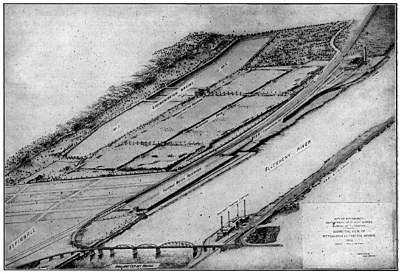
THE NEW FILTRATION BASINS.
[Pg 925]

The Allegheny and the Monongahela Rivers are turbid at all times,
and after a rain or in the spring, so muddy that a platinum wire
cannot be seen more than a quarter of an inch from the surface. In
addition to this, investigations have shown that the rivers commonly
carry in solution the soluble chemical products of the mills along
their shores,—organic and inorganic, acid and alkali; oils, fats,
and other carbon compounds; dead animals,—rats, cats and dogs;
flesh-disintegrated and putrescent; as well as the offscourings of
iron and steel mills, tanneries and slaughter houses, and similar
industries. But this is not all. Seventy-five up-river towns,—with
an estimated population of 350,000 inhabitants,—in the Allegheny or
tributary valleys; and in the Monongahela a long string of towns,
Swissvale, Homestead, Braddock, Rankin and McKeesport, all furnish
their supply of common sewage as a further contamination of the already
dirty water with its long list of disease-breeding bacteria.
These conditions have existed since Pittsburgh came into prominence as
an industrial center. Typhoid has been endemic. The duration of this
"plague" in Pittsburgh, unbelievable though its sufferance may appear
in view of the facts already given, is a matter of history and record.
For thirty-five years, up to the beginning of 1908, the city was in
the grip of a scourge which has been in the words of the most recent
treatise on typhoid[10], "one of the black records in the sanitary
history of our country." Here and there clamorous, indignant voices
were raised against it; but public sentiment had become so callous that
it only spasmodically and halfheartedly demanded the carrying into
operation of a tardy system of filtration. In the meantime, those who
could not afford to buy distilled or spring water, continued to drink
this filth.

With what result? For the last twenty-five years, an average death
rate of 102.3 per 100,000 population; since 1889 never below 107;
for the last nine years an average of 130; and last year, the year
of the completion of Pittsburgh's filtration plant, 131.5 deaths and
1,115 cases for every 100,000 inhabitants. A black record this, in
the face of uncontrovertible evidence from other cities, both in this
country and abroad, that the purification of the water supply should
blot out at least seven-ninths of the typhoid fever. In contrast with
Pittsburgh's high mortality, the average for other large American and
European cities since 1898 may be seen from the following list:
|
| Pittsburgh | 130.0 |
| Allegheny | 104.4 |
| Washington | 59.0 |
| Philadelphia | 54.7 |
| Baltimore | 35.3 |
| San Francisco | 30.5 |
| St. Louis | 30.3 |
| Chicago | 27.3 |
| Boston | 24.5 |
| New York | 18.2 |
| Paris | 17.4 |
| London | 11.7 |
| Vienna | 5.2 |
| Berlin | 4.2 |
|
The very even distribution of typhoid in Pittsburgh,—another
indication pointing to infected water as the chief cause,—is seen in
the map on page 927, on which each dot represents a case of typhoid
within the year,—July 1, 1907, to June 30, 1908, the period covered by
the main part of this study.
The second map shows the relative mortality, by wards, for the same
period.
The following chart shows the relative rise and fall from year to year
in cases and deaths during the past twenty-five years, and is based on
estimates of population provided by the United States Census Bureau.
The morbidity figures are taken from the United States census prior to
1901, and from the Pittsburgh Bureau of Health records following that
year.

Previous to 1883 very little attempt was made to compel physicians
to report typhoid cases to the Pittsburgh Bureau of Health; hence no
reliable morbidity records are available up to that time. But in the
year 1882 an ordinance was passed requiring such reports to be made.
It is very certain that several years elapsed before a majority of the
cases was actually reported, and even at the present time[Pg 926], in spite of
prosecutions and a more enlightened sentiment, many cases never reach
the bureau. Yet the number of cases actually reported in Pittsburgh
proper, since 1883, reaches the astounding total of 54,857. In other
words, within the past twenty-five years, one person to every six of
the total population has had an attack of typhoid fever.

But even more telling in its significance is the fact that out of
these 54,857 reported cases, 8,149, or 14.8 per cent died as a result
of their illness. Over eight thousand men, women and children were
sacrificed here in Pittsburgh in the last twenty-five years to a
disease known by modern science to depend for its very existence upon
lax methods of handling food, drink and waste. Over eight thousand
graves have been dug, half of them (4,069) since February 6, 1899,
more than nine years ago, when the report of Pittsburgh's Filtration
Commission, advising the necessity of a pure water supply, was placed
in the hands of the Pittsburgh councils. In life, these eight thousand
people, standing single file, four feet apart, would form a line six
and one-sixth miles long, extending from the court house in a straight
line to the Filtration Plant; or from the Point Bridge down the Ohio as
far as the Borough of Emsworth.
II.—THE COST.
In order to establish a sure ground for estimate as to the economic
drain of this disease upon this community, a concrete study of the cost
of typhoid in six selected wards of Greater Pittsburgh was undertaken
by the Pittsburgh Survey. The sections of the city chosen are fairly
representative of living conditions among the wage-earning population.
Wards 8 and 11, in what is commonly known as the Hill District,
represent a congested quarter made up largely of Russian Jews,
Austrians and Italians, with a considerable number of Americans and
American Negroes. The residents of these two wards are chiefly employes
of the small trades and the sweating and stogie industries, clerks,
factory hands, common laborers, etc., who are rather below the average
scale of earning capacity. They number about 22,000 for the two wards
and among them there were forty-four per cent of the cases studied.
Wards 25, 26 and 27 are on the South Side. Their total population is
about 33,000; mill hands, mostly of Slavic origin, occupy those parts
of these wards bordering the Monongahela River, and a better-off class
of Americans occupy the hilltops overlooking the river. The wards
would, therefore, represent a rather uneven population, as based on
nationality or wage scale, but were not a large factor in this study,
as only eight per cent of the case[Pg 927]s covered were found in these wards.
[Pg 928]
Ward 21, the other section selected, is in area one of the largest in
the city, lying to the east in what is known as the Homewood District.
The population of this ward is about 26,000, living mostly in good
homes, with occasional poorer dwellings along the railroad and in
some of the "runs." In the main, they represent a high wage or small
salaried class. From this section, the other half of the cases studied,
about forty-eight per cent was taken.
The period covered by the investigation was one year, beginning July 1,
1906, and ending June 30, 1907. The field work was done by Miss Anna
B. Heldman, visiting nurse of the Columbian School Settlement, whose
personal acquaintance with many of the families of the Hill District,
and whose six or eight years' experience in caring for typhoid patients
in this same neighborhood, enabled her to secure in detail many facts
that might have escaped a person less familiar with the district or the
families concerned.
An analysis of the cases thus studied, shows that there were either
reported to the Pittsburgh Bureau of Health, or known to the
investigator, but not reported, 433 cases of typhoid fever in wards
8 and 11, 94 in wards 25, 26, and 27, and 502 in ward 21—a total of
1,029 in these six wards within the one year studied. These cases
occurred in 844 families. Miss Heldman, five months after the close of
this year period, was able to locate but 338 of these families, the
remainder having either moved out of the state, or been lost track of
by people living in the neighborhood.
There were 2,045 individuals in these 338 families, or an average of
6.4 persons per family. Of this number, 448 individuals, or 22 per cent
had typhoid fever within the year. Out of these 448 cases, there were
26 deaths and 422 recoveries, an exceptionally low percentage of deaths
to cases.
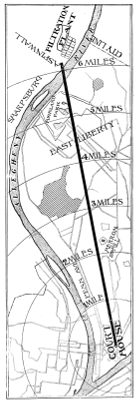
Line representing 8,149 people who have died from
typhoid fever in Pittsburgh since report of Filtration Commission in
1899 advising necessity of pure water. Standing in marching order,
single file, four feet apart, they would make a procession six miles
long.
[Pg 929]
Of the 448 patients, 187 were wage
earners, contributing all or part of their earnings to the
family income. As a result of their illness, these 187 wage earners
lost 1,901 weeks' work, or 36.6 years. This averaged over ten weeks
per patient, and represented an actual loss in wages of $23,573.15.
In addition, other wage earners lost 322 weeks' work while caring for
patients, thereby losing $3,326.50 in wages, and bringing the total of
wages lost to $26,899.65.

The other large item of cost is that of expense for care and treatment
of patients. Ninety cases were treated in hospitals for all or part
of the time, as pay patients, half-charity, or full-charity cases.
To meet these hospital expenses, $2,332.00 was paid to hospitals by
full-pay patients themselves, and $1,834.50 was paid the hospitals
by either individuals or charitable organizations for the care of
half-pay patients, making the total cost of caring for 90 hospital
patients $4,166.50. This is an understatement, because it omits the
contribution of the hospitals themselves to the care of half-charity
and full-charity patients. If figures were available, there should
be added the amount represented by the difference in the money paid
to hospitals and the actual cost of maintenance, presumably another
$1,800.[11]
The expenses of the remaining 358 patients cared for in their homes
amounted to $12,889.90 for doctors' bills, $1,965.50 for nurses,
$2,640.60 for medicines and drugs; $1,810.10 for milk, $629.20 for ice,
$861.50 for servants made necessary by the illness of those naturally
caring for the home, and $1,204.45 for other expenses, of which the
largest single item was the cost of a trip to Colorado and return at
the doctor's orders, for a patient threatened with tuberculosis. The
total of these expenses was $22,000.35.

The funeral expenses of the 26 patients who died, amounted to
$3,186.00. It may be argued that sooner or later funeral expenses
must inevitably be met, and that they should not, therefore, be
charged against this account. Under the circumstances, however, these
expenses were premature, and were directly chargeable to typhoid fever.
Consequently, it has seemed fair from the point of view of this study,
to include them. The grand total loss in wages and in expenses thus
outlined was $56,252.50.
Further analysis shows that the average loss in wages per patient among
the 187 wage earners was $126; that the average cost per patient in
loss of wages and expenses for the 446 patients was $128; and that the
average cost in loss of wages and expenses for each typhoid death among
the 448 cases was $2,164.
Consider the losses in these wards in their bearing upon the city as a
whole.
There were 5,421 cases of typhoid fever in Greater Pittsburgh in 1907.
If the cost to each patient was $128, typhoid fever cost the city that
year $693,888 in expenses and loss of wages alone. There were 622
deaths from typhoid fever in Greater Pittsburgh during the same period.
If we put the value of these lives lost at so low a figure as $4,000,
an additional loss of $2,448,000 was sustained. Or in round numbers
$3,142,000 was the minimum economic loss to the community of Greater
Pittsburgh, due to typhoid fever alone in the year 1907. This is a
conservative estimate, in view of recent values placed on deaths from
tuberculosis.[12] The two and a half million dollar death item might be
doubled without overstating the case.

When it is considered that typhoid fever has been almost constantly
prevalent within the city limits, with practically no abatement,
for the past thirty-five years, it requires only a little applied
mathematics to calculate the probable enormity of the money loss to
the community, through the ravages of this disease alone, year after
year. Was it not time for it to stop? In the face of over a $3,000,000
loss last year, $5,450,000 was not more than the city could afford to
pay for the filtration plant that is purifying the drinking water.
Nor was it extravagance for the mayor and city councils to grant
the superintendent of the Bureau of Health an increased staff of
tenement house and milk inspectors, to make it possible to clean up
other sources of infection, and hasten the time when typhoid fever
in Pittsburgh shall constitute a no greater menace than in any other
well-kept American city.
I have used the term "economic cost" of typhoid fever with reference
to Pittsburgh families. The mere phrase carries with it no knowledge
of all those family readjustments and inconveniences, the distress
of mind and unalloyed misery that must be considered before we can
form any adequate idea of what such sickness holds for a wage earning
population. Were it necessary to measure the result of typhoid fever
only in cold cash, it would be a relatively easy task. In the first
place there are the thousand and one makeshifts and re-establishments
that must be reckoned with in order to get a clear idea of what
typhoid means to those poorer families, where, without the invasion of
sickness, the business of getting bread is a constant struggle. In a
family consisting of a man, wife and three children, the sixteen year
old daughter, who had not been very strong, contracted typhoid. At the
end of sixteen weeks in bed and thirty-two weeks out of work, she had
developed a marked case of tuberculosis. Not being strong enough to go
back to her former employment, she secured work in a bakery where she
was subsequently seen coughing as she wrapped up bread for customers.
The father of this girl, during her sickness, was keeping six cows on
the premises and selling milk to customers living in the neighborhood.

The twenty-year-old wife of a Hungarian laborer had a six weeks' old
baby when she came down with a slow case of the fever. She remained at
home for a week with no one but herself to do the work and care for
the baby. The husband, who did not realize the cause of her weakness,
gave her a beating each day when he came home, because he thought her
lazy. He made her carry up coal for the fires until she became so
delirious that he could not keep her in the house. She was then sent to
a hospital and the baby given to friends. The woman died in a week and
the baby two weeks later.
A family of five, consisting of father, mother and three little
children, cooked, ate and slept in one uncurtained room. The mother and
four year old girl were taken sick at the same time. The girl occupied
an Arbuckle coffee box, with a pillow and pillow-case for a mattress,
and the man's overcoat was her only covering. The mother slept in the
only bed, furnished with a mattress and one small comforter, and shared
it at night with the father, the baby and their six year old girl, who
lay across the foot of the bed. The girl was in danger of contracting
pneumonia from exposure. A family of seven occupied a store and kitchen
on the first floor and two rooms upstairs. A small bedroom was the
only one which had a fireplace; and the entire family slept there; the
mother (who had typhoid), in the only bed, and the father and five
children in a row on the floor.
In another family, the six year old boy had the fever, and was found
lying on an improvised bed, his little dog tied[Pg 931] beside him. The mother
had rested the ends of two boards in a china closet at one end of the
kitchen, and on a chair at the other, so that she might care for the
patient, do the cooking and attend to the baby at the same time. By
this make-shift, the father was able to keep at his work.

One family, consisting of father, mother and five children, managed
ordinarily with a bed for the parents, a child's bed for the eight
year old girl, a two-third size bed for the eighteen and sixteen year
old daughters, and a cot for the fourteen year and ten year old sons,
one sleeping at each end. First the mother and one of the boys were
taken sick, and during the early part of their illness, no one was
disturbed. But within a month, and before the first two patients got
well, the four other children came down with typhoid, making six in
the family sick together. Then the father slept on the floor and the
sick mother got out of her bed to give place to two of the children,
she, herself, sleeping at the foot of the bed until one of the children
became delirious. After that she moved to the foot of the two-thirds
bed. In the day time she had no place to lie down, and sat all day in a
chair until she became so weak that she could hardly walk. Occasionally
she helped her husband who did the cooking and cared for the patients,
by paring potatoes and doing other small work about the kitchen. No
one had time to keep the kitchen sink clean, and the accumulation of
vegetable matter became so filthy that it had to be reported to the
Bureau of Health. With family income cut off, and with nothing saved,
the family would have been penniless had it not been that the doctor
made his bill moderate; the family was trusted for groceries, milk
and ice; friends gave about twenty dollars in cash, and Columbian
Settlement furnished bedding and the services of a visiting nurse. The
mother did not fully recover for about six months. The father, who
suffered a good deal from loss of sleep and exposure while caring for
the patients, contracted a cold. This developed into a serious case of
asthma from which he died.

To these and many similar families there were more serious results
than the debts incurred. A school girl's unrecovered health, a stogie
roller's reduced speed, a blacksmith's and a tailor's loss of strength,
a case of tuberculosis developed, a boy become a truant, a family
broken up and deserted, a baby's death,—all are of tremendous concern
as items in the annual wear and tear of the city's potential resources.
They are items of "economic cost" that cannot be handled by the
statistical method. They are, after all, the real human finger marks
that typhoid leaves when its clutches are loosened.
Such a showing, then, of actual economic and personal loss as this
study of six Pittsburgh wards brought out, is offered as a final
leverage to those who in other American cities may be endeavoring to
dislodge inertia and clear their water supplies. This investigation
of typhoid fever, however, as it was found in the households of the
wage earners of Pittsburgh, had its immediate practical bearings. The
sanitary facts it brought out showed unequivocally the necessity for
ridding the city of other sources of infection at the same time that
the water supply was cleared.
There was evidence that many of the after cases in the families
studied, were due to conditions existing entirely apart from the water.
Reports on housing conditions in Pittsburgh show that a favorable
laboratory for the growth and dispersal of germs exists in the city's
unsanitary dwellings. Insufficient water supply renders cleanliness
almost impossible. Overcrowding means increased possibilities of
infection through contact with food and drink in the combined family
kitchen, pantry, dining-room, and[Pg 932] bedroom. Pittsburgh's thousands of
open privy vaults afford ideal conditions for the spread of disease by
flies and other insects, and by personal contact. Such plague spots as
Saw Mill Run, with its string of double-and triple-decker rear privy
vaults discharging on the banks of a stream which are flushed off only
when the water rises after a rain, afford further examples, deplorable
and disgusting.

How much of the Pittsburgh typhoid has been due to direct contagion
from such conditions as these, can only be inferred at the present
writing. In line with the general question of contagion, and secondary
cause, however, our data afford some clews. They show that in forty of
the families studied, the first case was followed in from ten days to
one or two months by other cases, seventy-six cases in all, in addition
to the original forty. It shows further that in at least eighteen of
these families, one or more of the following conditions existed: Family
crowded into one or two rooms; home dirty and poorly kept; the person
who cared for the patient also doing the family cooking; well and sick
members of the family sleeping in the same room and often in the same
bed; privy vaults in exceedingly bad condition, and often stopped up
and overflowing with filth. In one family, consisting of man, wife,
four children and three lodgers, crowded into two dirty rooms, a three
year old boy was taken sick in October. The mother did the family
cooking and cared for the patient. The cesspool in the yard which was
in bad condition was used by two families. Another member of the family
became ill November 3, and the mother came down on December 19. There
were seven cases in this one courtyard within the year.
In another instance a man, wife, and nine children were living in three
rooms. The sixteen year old son was taken sick on June 20 and was sent
to the hospital. Then in July came the thirteen year old daughter for
whom her mother cared at home. The mother also did the family cooking.
The father, mother and eleven year old son all slept in the same room
with the patient. All three of them followed within a month, and
another son twelve years old, was taken sick in August.
In another family of eight, the sink in the kitchen and the toilet
in the yard were in a very filthy condition. The mother and one son
were taken sick in August. The sick and the well slept together in the
crowded bedrooms. In November four more members of the family came
down with the disease, on the sixth, ninth, eleventh and fifteenth,
respectively.
Let the reader judge for himself whether or not, in the face of these
facts, it can be expected that filtered water alone will solve the
problem.
The Pittsburgh Typhoid Fever Commission is a recognition of these
facts, and a recognition also from a national and scientific point
of view, that probably never again in the history of any large
American city will there be such a favorable laboratory in which to
study the epidemiological facts of typhoid fever both before and
after filtration. The commission was appointed in April, 1908, by
Mayor Guthrie; is made possible by a grant from the Russell Sage
Foundation, and by the co-operation of the bureaus of health and water,
which offered the free use of their laboratories for analytical and
administrative purposes. Dr. James F. Edwards is chairman, and the
membership includes Dr. Dixon of the State Board of Health, Prof. Wm.
T. Sedgwick of the Massachusetts Institute of Technology, and Dr. E. S.
Rosenau, of the Public Health and Marine Hospital Service, who has been
directing the elaborate governmental investigations into typhoid in the
District of Columbia. The following report is made (January[Pg 933] 1) by Dr.
E. G. Matson, of the Pittsburgh Bureau of Health, executive officer of
the committee.

The work of the commission to date has consisted of a minute
investigation of all cases of typhoid which have appeared
since May 1, 1908, including the sanitary condition of their
living and working places. Investigations have also been made
into neighborhoods where there appeared to be fewer cases
than the average of the city, the milk supply, and the water
supply, both public and private. It is remarkable that not even
the smallest outbreak has been traced to milk. A particular
feature of the study of water supply is that in connection
with the acidity of the Monongahela and the eastern affluents
of the Allegheny and its effect upon the sewage discharged
by an enormous town population into them. So far typhoid has
declined greatly in Pittsburgh since January, 1908, as compared
with the average or even the minimum of previous years. This
decline has naturally been a subject of great interest though
it is too soon to give the results of investigations. We have
ascertained that this decline has been shared by the towns on
the lower Allegheny, which have hitherto been supposed to be
the most important source of our epidemics. During November
and December, which would represent the first months of the
filtered water period, typhoid has been reported from the
filtered water area at the rate of the most favorable American
cities, and in Allegheny, which receives nearly the same water
unfiltered, at about twice this rate.
III.—THE STORY OF THE LONG FIGHT FOR PURE WATER.
And now we come to the story of the long fight for pure water in
Pittsburgh. The irony of the situation is, that there should ever have
been a long fight in a city which has since 1863 publicly recognized
the danger of impure water, the significance of which has almost
continually been brought before the people by press and platform
alike, for the past fifteen years. The story of the whole filtration
movement cannot be separated from the story of the struggle for
supremacy of contending factions in the dominant political party. And
the result,—excess typhoid with its terrible cost,—becomes part of
the penalty the city has had to pay for such corruption as the present
graft proceedings in councils are bringing to light.

The situation at the beginning of the filtration movement in 1895-96
was this: One of the strongest political machines in the history
of municipal government was in absolute control in Pittsburgh. It
mattered not who was elected mayor; he had no responsible power.
Heads of departments were appointed by outgoing councils. This meant
that department heads held over, and used their power to re-elect as
in-coming councilmen the outgoing councilmen who had elected them.
Moreover, councils were controlled by the ring.[13] In this way the
political machine was self-perpetuating. The directors of public
works drew specifications for public improvements; councils awarded
contracts; and it is a matter of notorious record that the well-known
firm of which one of the ring leaders was a member usually secured the
contracts.
The municipal election in February, 1896, was hard and bitterly
fought. George W. Guthrie headed the reform party as candidate for
mayor. According to one authority the majority of ballots cast were
for Guthrie, but when the count came in officially a few days after
election, the ring had won. With the mayor, both branches of councils,
and the director of public works all of the dominant party, the
carrying out of their ante-election pledges so far as filtration was
concerned would seem a matter of course.
True to these pledges, a resolution for the appointment of a Filtration
Commission, to include the mayor, the president of each council, and
eight citizens,—making eleven in all,—passed [Pg 934]City Councils on June
8, 1896, and was approved by the mayor on June 10.

The commission was promptly appointed and set to work to make a
thorough investigation into the relative merits of various methods of
filtration and water supplies in use in cities of the United States and
Europe. Allen Hazen, a leading expert on filtration, was employed for
the first phase of the investigation, and Prof. William T. Sedgwick
of the Massachusetts Institute of Technology, eminent as a sanitary
expert, investigated the typhoid situation in the city. Morris Knowles,
C. E., was appointed resident engineer in local charge of all items of
experiment and investigation. Various members of the commission visited
European and American cities to study filtration methods; extended
bacteriological and analytical studies of the Allegheny River water
were made; small, slow, sand filter beds and standard make mechanical
filters were set up at the experiment station to test the relative
merits of each as applied to Allegheny River water; and nothing was
left undone as a means of arriving at a sound conclusion. Over two and
a half years elapsed between the appointment of the commission and the
rendering of its report.
The report, which was very elaborate, was presented at a joint session
of councils on February 6, 1899, and showed that the members of the
commission were united in their belief that, all things taken into
consideration, a slow, sand filtration plant should be constructed.
In accordance with its recommendation steps were immediately taken
for the issue and sale of bonds to provide the necessary funds, a
public election for this purpose being held on September 19, 1899. The
appropriation ordinance for the year 1900 contained "No. 100; for the
purpose of extension and improvement of water supply and distribution,
including the filtration of such water supply, and providing and
furnishing meters to be used in connection therewith ... $2,500,000."
The ordinance authorizing the controller to issue bonds for the
purpose as above specified was passed by Select Council in March, and
approved by the mayor April 3. So that prior to May 1, 1900, a fund of
$2,500,000 became available, and the prospect for the prompt erection
of the plant would have been bright, but for the fact that during the
four years since 1896 certain changes in the attitude of the members
of the ring toward one another had taken place, that were destined
to involve further complications. One member (Magee) had aspirations
toward the United States Senate. In this he encountered opposition from
the other end of the state, and in the struggle for state supremacy
that followed, Pittsburgh was left largely to another member of the
ring.

In the early part of 1900 E. M. Bigelow, who for a long time had been
director of public works, had a row with this leader (Flinn) over
certain matters of public work. The result was that on June 11, 1900,
the ring-controlled councils threw Mr. Bigelow out of office and
elected as director of public works a man more friendly to the ring.
This break between Flinn and Bigelow was the beginning of the long
series of events that retarded the filtration movement for at least
four years.
Bigelow was now "out." The new director of public works, appointed
by councils was acceptable to the ring that was "in"; so was the
membership of councils. The question with Bigelow was, naturally, how
to get back into office. This is the way he accomplished his desire.
The ousted director had a brother, who, it is said, had an old grudge
against the ring.[Pg 935] He went to Harrisburg and prevailed upon the
State Legislature to grant Pittsburgh a new charter, abolishing the
office of mayor and substituting that of recorder, this office to be
filled by the governor until April, 1903, when the regularly elected
recorder would come into office. The charter also gave the recorder
much larger powers than the mayor had previously enjoyed, among them
the appointment of heads of departments and the right to enter into
contracts hitherto the prerogative of councils alone.

As might be expected, the newly appointed recorder soon exercised the
authority vested in him by the terms of the new charter, and on June
11, 1901, removed the head of the department of public works again
installing Mr. Bigelow in that important position, just one year after
he had been removed by councils.
It must be remembered that while Mr. Bigelow had again secured the
directorship of the Department of Public Works, there had been no
change in councils, which were still enrolled on the side of the
ring. While councils could not now stop the preparation of plans and
specifications for the proposed filtration plant, they could make a lot
of trouble in other ways; and so they did.
There are contradictory statements at this time as to just how much
progress had been made on plans during the year that Mr. Bigelow was
out of office. One side claims that "sixty per cent of the plans had
been drawn"; the other said, "only part of the plans." At any rate,
within six weeks Mr. Bigelow removed the engineer who had served under
his immediate predecessor, appointed as resident engineer Morris
Knowles (who was later appointed chief engineer of the newly created
Bureau of Filtration), and directed him to start work on plans for the
filtration plant.
At the same time councils proceeded in an attack on the director for
alleged delay in the preparation of plans; and on November 11, 1901,
presented a report to its filtration committee declaring Mr. Bigelow
entirely responsible for all the delay in the preparation of plans
and specifications, adding that these delays had been "gross and
inexcusable." This report was accompanied by a resolution ordering
Director Bigelow to furnish within ten days, to the filtration
committee, for its approval, all the plans and specifications for the
work lying north of the Western Pennsylvania Railroad, directing him
further to proceed with the utmost diligence to the completion of the
plans and specifications for the remainder of the plant, and to submit
the same to the filtration committee on or before December 2, 1901. The
report and resolution were adopted by both councils on the day of their
presentation. The real motive for this attack is readily inferred.

In the meantime the opposing faction had been working with the
governor, and after a notorious meeting at the Duquesne club, the
governor was prevailed upon to remove his first appointed recorder, on
the pretext that he had displaced several old soldiers from office,
and to appoint another recorder in his place,—this time a man upon
whom the machine could rely. At the close of the letter of removal, the
governor added a now famous postscript, "I was not bribed."
With the appointment of the new recorder, Bigelow was again forced out
of the office of director of public works. This put the ring again in
full control, with even greater powers than it had before. A year and
a half had elapsed since the $2,500,000 became available, and all that
the people had to show for it were eighty-five acres of land, part of
the plans and specifications completed, and over 600 more deaths from
the scourge of typhoid fever.
The next move was made within ten days after Director Bigelow's
dismissal, when another ordinance for the letting of[Pg 936] the contract was
introduced. It quickly passed both councils and received the recorder's
approval. By this ordinance the contract was not to exceed $1,500,000
and was to be for the construction of "so much of the filtration plant
as is shown upon the drawings and description in the specifications, as
and to be known as contract No. 1."
Under this ordinance the new director advertised for bids, which were
received and opened. It appeared that the lowest bid was made by the T.
A. Gillespie Company, at about $1,292,000. The director and recorder
were preparing to let this contract for part of the work to the
Gillespie Company, and it looked as though the faction of the ring now
in the saddle would win the stakes.
But they had not reckoned all the odds. The opponents of the ring,
in this two-sided hold-up game, brought out another winning card. It
was in the person of John P. Edgar, a citizen of Steubenville, Ohio,
but the owner of property in the thirty-seventh ward, Pittsburgh, who
entered suit in the United States Circuit Court at Pittsburgh for an
injunction to restrain the recorder and director of public works from
awarding the contract. The case was argued before Judge Buffington on
March 3, 1902, W. B. Rodgers and George W. Guthrie appearing for the
plaintiff, and Thomas D. Carnahan, city solicitor, for the city. Suit
was based on the allegation that no estimate had been presented to
councils for the whole cost of the improvement, and that the letting
of this partial contract would be in violation of the new charter,
which required that before any contract for public improvement could
be entered into, such an estimate for the entire cost must have been
presented. The city solicitor showed that an estimate had been made
of the entire cost, but this estimate had not been made public or
submitted to councils. Mr. Rodgers maintained that this estimate must
be submitted to councils and approved by them. He and Mr. Guthrie
also claimed that the contract should embrace the completion of the
work. On March 13, 1902, Judge Buffington issued the injunction prayed
for. The court held that the estimate of the whole cost, required by
the charter, must be made to councils and become a matter of public
information, and that such an estimate had not been made.

The machine was temporarily blocked, but five days after the injunction
had been granted, the recorder instructed his director of public works
to have blueprints, plans and estimates of the entire filtration
system ready to present to councils at as early a date as possible,
thus starting the necessary legal steps for placing a new contract.
Within a month these plans and estimates, involving an expenditure
of $3,635,500, were prepared and submitted to councils, and three
ordinances for the letting of contracts were presented. The increase
over the first estimate was explained as due to an increase in the
number of services to be metered, and to a general increase in the cost
of materials.
These three ordinances were indefinitely postponed, however, in
councils, because more money for the construction of the plant under
the increased estimate was not available.
The next hold-up came from the city controller, who on May 1, 1902,
sent the following letter in duplicate to Recorder Brown and Director
McCandless:
In view of the uncertainty attending the proposed filtration of
the water, and the doubt as to the ultimate disposition of the
matter by councils, this department desires to notify you that
on and after May 10, no indebtedness against that appropriation
for any purpose, except for labor or supplies previously
furnished, should be incurred, as, under the decision of the
court, there is now no authority for any expenditure for
filtration purposes.
In the meantime, about April, 1902, and all through that summer,
advocates of a mountain water supply were at[Pg 937] work. At the same time
changes in councils threw out of the Filtration Committee members
favoring sand filtration and elected opponents of the plan to its
membership. The result was that on July 21, 1902, an ordinance was
brought forward authorizing the Filtration Committee to prepare, in
conjunction with the superintendent of the Bureau of Water Supply, or
some other competent engineer designated by the director of public
works, estimates showing the entire cost of the installation of the
proposed sand filtration plant. Early in January, 1903, this resolution
had passed both councils. It was, however, vetoed by the recorder on
the ground that it was unnecessary, the Department of Public Works, he
held, having already furnished full estimates, in good faith, and being
ready to assist councils further in any manner that might be suggested.
The recorder added in his veto: "If the purpose of this resolution
is ultimately to defeat the proposed plan of sand filtration and
substitute therefor a system of mechanical filtration, I am unalterably
opposed to it." An attempt to pass the resolution over the recorder's
veto was made, but it failed for lack of the necessary three-fifths
vote.

In the meantime an ordinance was presented authorizing a public
election for a bond issue large enough to cover the difference between
the amount of money then available and the amount required under
the increased estimate. All that came of this was an inquiry by the
sub-committee to which it had been referred as to whether the new
estimate included coverings for the filter beds, and whether the South
Side was to be given filtered water. After ten months' further delay,
this sub-committee reported that the estimate did not provide for
covered filter beds and that it made no provision for the South Side.
Another year and a half had elapsed, with 650 additional deaths from
typhoid fever; 1,250 to date.

In April, 1903, by the election of Mayor Hays, the Bigelow faction
again came into power and Mr. Bigelow was reappointed director of
public works. Councils reorganized. A reform, or Bigelow man, was
elected to the presidency of councils, control of committees was
secured, and by the middle of 1903, the Bigelow faction was again in
full power.
By this time the South Side was demanding filtered water. The new
estimates presented by Director Bigelow in September, 1903, included
ten filter beds for the South Side, and the raising of the pumping
capacity for the first twenty-three wards by twenty million gallons,
and included also, new machinery and boilers for the Brilliant pumping
station, and a fifty-inch steel main across the city to supply the
South Side and the Monongahela River wards of the old city. These
brought the total new estimate up to over seven million dollars.
The time between September 21, 1903, and January 12, 1904, was
required to get a resolution through councils and approved by the
mayor, authorizing the finance committee to employ three experts, Col.
Alexander M. Miller of Washington, John W. Hill of Philadelphia, and
Rudolph Herring of New York, "to verify and make a report on or before
March 1, 1904, to the committee on finance, as to the correctness of
the estimates made by the director of public works."
Under this resolution the experts were employed and went to work. In
the meantime, councils had received a petition from the Pittsburgh
Section of the American Chemical Society, urging the establishment of a
sand filtration plant; also a resolution of the Civic Club of Allegheny
county, and a resolution of the permanent civic committee of the
women's clubs of Allegheny county, urging sand filtration at an early
date.
[Pg 938]
During 1903 there were 450 deaths from typhoid fever.
On February 27, 1904, the filtration experts made their report
recommending a receiving basin, three sedimentation basins, a clear
water basin, and forty filter beds. They also recommended sand
filtration and covers for filter beds, but cut down the capacity of the
various parts of the plant sufficiently to reduce the estimated cost by
$700,000.
On March 31, 1904, the Bureau of Filtration in the Department of Public
Works was created for the purpose of constructing these important works.
No further opposition of a serious character was met, and in July of
that year a second bond election for $5,000,000 was held and passed
by a vote of nearly two to one. These bonds were issued in September;
plans and specifications for the enlarged plant were prepared as soon
as possible; bids were advertised; and the contract was let on March 4,
1905.
With the final award of the contract the fight for pure water was
practically won. Director Bigelow again stepped out of office in 1900
with the election of a mayor independent of either Republican faction;
but the work of pushing the plant forward to completion was carried
on by the Guthrie administration under the efficient supervision of
Directors Clark and Shepherd, and Superintendent Knowles; so that by
October, 1908, the plant was supplying a good quality of filtered water
to the first twenty-three wards,—the old city.
The settling of the pending litigation between the city and the
Monongahela and other private water companies on the South Side,
together with the taking over of that property by the city was all that
remained to be done before filtered water could be supplied to that
part of the city.[14]
In the meantime the North Side (Allegheny City) still has unfiltered
water. Immediately after Allegheny was annexed to the Greater City
in December, 1907, steps were taken to pave the way for filtered
water there. $750,000 was appropriated for ten extra filter beds
on city-owned land adjoining the plant, and their construction is
now under way. Their use for the North Side involves extra pumping
facilities, however. A plan to bring the old Allegheny pumping station
at Montrose down to Aspinwall for this purpose was recently blocked
by members of councils from the North Side. Satisfactory explanation
for this action does not seem to be forthcoming. The reason alleged
was that its removal would throw some of the men out of a job. In
the meantime Allegheny continues drinking unfiltered water with
no immediate prospect of relief, and the same sort of political
influence that delayed filtration in the old city so long, seems to be
accomplishing similar results on the North Side.
In conclusion, let me apply the economic facts brought out in the first
section of this article, to the four years of unnecessary delays in the
construction of the filtration plant, from April 3, 1900, to April 29,
1904. They must be considered in making up the whole bill of the city
in the cause of pure water.
During all this time, more than $2,200,000, on which the city was
paying three and one half per cent interest, was lying in the banks
favored by the administration, bringing the city but two per cent;
and the death rate from typhoid fever was the highest of any of the
large cities in the United States. But for this delay the plant might
have been brought to completion on January 1, 1904, or at least as
far advanced as it was January 1, 1908, and four years,—1904, 1905,
1906 and 1907,—of excess typhoid fever might have been avoided. Not a
startling statement, perhaps, on the face of it. But consider seriously
what these four years of excess typhoid fever have meant to the people
of Pittsburgh in deaths and economic cost. I have told you of but half
of the people of six wards out of forty-three, one year out of four. In
1904, with an estimated population of 352,852, there were 503 deaths
from typhoid in Pittsburgh. Cities with a fairly pure water supply
do not have over twenty-five deaths annually per 100,000 population
from typhoid. Had Pittsburgh's typhoid fever[Pg 939] death rate in 1904 been
twenty-five per 100,000, there would have been but 88 deaths instead
of 503, and the grim total of 415 lives would not have been blotted
out. By allowing $2,000 as the cost in loss of wages and expenses for
each death (a little under the actual costs in the concrete study of
economic cost already given), and allowing our previous minimum of
$4,000 as the value of each life, the total excess deaths in 1904 alone
from lack of pure water was a loss to the community of $2,490,000.
There were 425 unnecessary deaths in 1906, and a wastage of $2,550,000;
289 unnecessary deaths in 1905, and a wastage of $1,734,000; 415
unnecessary deaths in 1904, and a wastage of $2,490,000. In the four
years the community lost $9,000,000,—over $4,000,000 more than the
cost of the filtration plant. And in those four years, 1,538 lives were
unnecessarily sacrificed.
There are those who will say, and perhaps rightly, that Pittsburgh's
filtration plant of to-day is the magnificent triumph of construction
that it is, only because of those years of delay in shaping the final
plans; that while those who fought the measure tooth and nail for
so many years did not have that purpose in mind, yet the set-backs
they were able to accomplish, have made in the end for a larger,
better, more efficient and more far-serving plant than could have been
possible, had the first plans been carried hastily to completion. Such
may be the case. If so, let the people be thankful that the cause of
pure water triumphed ultimately over a lethargic public sentiment,
selfish political purposes, and municipal shortsightedness. Let them
at the same time remember at what cost to themselves and to their city
the fight was won. And let the plant itself stand as an object lesson
of tardy justice, and a monument to those hundreds of lives that paid
the penalty unwillingly and unknowingly of being part and parcel of an
unaroused municipal conscience.
GROSS NUMBER OF TYPHOID CASES, 1885 TO 1907.
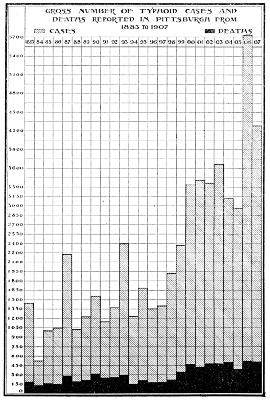
SAMUEL HOPKINS ADAMS
[Pg 940]
Starting at the lowest level, let us formulate our initial axiom
in terms of dollars. A sound man can do more work than a sick man.
Therefore he can make more money. A sound city can do more work than
a sick city. Therefore, in the long run, it can accumulate more
wealth. Public health is a public asset. This is a truth which, in
her single-minded purpose of commercial and industrial expansion,
Pittsburgh long ago forgot, if, indeed, she ever stopped to realize it.
Consequently, at a time when all the other great American cities have
organized their forces thoroughly and are waging battle, with greater
or less scientific skill, against that most potent of all destroyers,
the germ, this mighty aggregation of half a million human beings has
only just declared war, and has barely established its outposts. After
two years of preparation to meet conditions which have been half a
century in forming and solidifying, Pittsburgh's little regular army of
defence now faces the most complicated problem of municipal betterment
to be found in American hygiene.
A health bureau performs a defensive and protective function. Its
intelligence department must keep it apprised of every manifestation
on the part of the enemy; and it must rally to the threatened point
to check the advance before it be too late, whether the emergency be
a school epidemic of diphtheria, or a localized onset of typhoid. It
must maintain a jealous watchfulness over the food and water supplies
that are brought into the city, lest with them shall come the invading
diseases. And its statistics of death and disability must point out for
repair, the breaches made in its walls by the never-ceasing onslaught.
Such a sanitary garrison has little rest, and no respites, for the
besieging germ never sleeps.
The date of Pittsburgh's last annual health report is 1899. That fact
is crammed with meaning. Strategically it means that for nearly a
decade the sentries have all been asleep at their posts. Politically
it has meant that those responsible for the administration of the city
were too lethargic, too ignorant, or too indifferent to disturb that
profound Rip Van Winkleism. Civically it means "Who cares!", and that
companion gem, "What's the use?". Between public indifference, private
selfishness, and political inertia, the germ has pretty well had its
own sweet way with Pittsburgh, and the city's annual waste of life
from absolutely preventable disease has been a thing to make humanity
shudder, had it been expressed in the lurid terms of battle, holocaust,
or flood, instead of the dumbly accepted figures of tuberculosis,
typhoid, and infant mortality.
Presumably, before this article gets into print, the Pittsburgh
health report for the year 1907 will have been issued. What laborious
exhumation of dilapidated statistical skeletons that report represents,
I have not space to explain here. The important and significant point
is that the authorities are at last at work, and energetically,
under the leadership of a skilled sanitarian, Dr. James F. Edwards,
superintendent of the Bureau of Health. It would be pleasant to add
that Dr. Edwards goes into action with his hands free; pleasant, but
quite untrue. On the contrary, he is bound and hampered to an extent
that would devitalize the efforts of any but the most patient of
enthusiasts. His forces are not under his own control, since under
the Pennsylvania system he is at the head, not of a department, but
of a[Pg 941] bureau of the Department of Public Safety, administered by a
layman. The law gives him no power to choose or discharge his own
subordinates within the limits of the civil service; all that he can
do is to train and educate such of them as most need it, when they
come to him. He has no specific supervision or control over public or
charitable institutions, those prolific culture-beds of contagion. Even
the Municipal Hospital for Contagious Diseases has been taken out of
his hands and put under other management. He cannot condemn a building
inimical to the public safety, nor can he revoke a milk license. He
cannot abate a nuisance without going to court for it. And, lest the
powers of his bureau should wax too great and impinge upon individual
privilege, old laws have been raked up and carefully interpreted to
restrict the scope of its work. Yet in spite of all this, wonderful to
say, the efforts of the bureau seem to have made an initial impress
already on the death rate, and, even more important, to have gathered
to its support some tangible force of public opinion.
"Seem to have made," I say, because figures in this connection are
largely a matter of conjecture. Basis for any detailed comparison
between present and past, is lacking. What is certain, however, is
that the sanitary forces are doing work which must inevitably have
its effect in life-saving in the future; and the efficacy, if not the
qualitative result, of that work is hopefully apparent. The first
attack was made on a condition of affairs which would have disgraced
a country village, the prevalence of unprotected outhouses, scattered
over the length and breadth of the landscape; not only lurking in the
slums, but peering from the proud eminence of hilltops down upon the
homes of wealth and elegance below.
Through the agency of flies in summer and of wind or heavy rains in
winter, these relics of communal barbarity spread filth and contagion
through the city. How many of them existed at their maximum will never
be known. There are still six thousand survivors, but the number is
being reduced daily. Proceeding under an ordinance which declares
them illegal, Dr. Edwards began his campaign modestly. Opposition he
foresaw, but he waited to keep it, as far as might be, sporadic, and
to prevent it from concentrating. In the year 1905 only forty-six
of these nuisances had been abolished. In 1906, six hundred of them
fell. Thereupon the sensitive nerve of property rights thrilled the
alarm throughout the commercial body. Reform was threatening rental
profits; was becoming "radical," and "destructive." People with pulls,
real or imagined, rushed to councils with demands for the repeal of
the ordinance. But here an unexpected ally appeared. Destruction of
the old meant construction of the new and modern, with much accruing
increment to the plumbing trade. Therefore these shrewd business
sanitarians hastened before the committee with lawyers and arguments,
and so effectually backed up the case of the Health Bureau, that
the repeal project was killed then and there. In the enthusiasm of
well-won victory plumbers' supplies soared heavenward, with the result
of bringing the unfortunate property owners down upon the Bureau of
Health in agonized droves, begging for protection from the masters of
the situation. Thereupon the bureau quietly allowed an extension of
time, until the enthusiastic plumbers, somewhat chastened, saw the
point and came nearer to earth in their prices; after which the process
continued, and has been continuing, with accelerated progress. For
the issue had now been decided. The proprietors of noisome property
had lost the first skirmish. In 1907, 7,755 notices were served on
recalcitrants, and 3,590 privies were abolished. By the end of 1910,
Dr. Edwards hopes to have relegated these nuisances to a purely
historical status.
Encouraged, the Bureau of Health sought from the Legislature the power
to condemn unsanitary dwellings. At present, in order to destroy
property prejudicial to the public health, the bureau must go to
court and prove the conditions unsanitary,—a cumbrous, expensive,
and uncertain process. It is not long since a presumably upright and
intelligent occupant of the bench held that a house which leaked so
badly[Pg 942] that the floors were rotted and the plaster peeled from the
walls could not, on that account, be adjudged unsanitary. The bill
passed the Legislature, prescribing condemnatory powers, with a proviso
for court review and damages to the owner if the condemnation should be
found unjustified. Governor Stuart vetoed the bill on the ground that
it was too sweeping. If the local undertakers haven't passed a vote of
thanks to the governor, they have missed a gracious opportunity. What
would have been the one most effectual check upon the city's mortality,
the wiping out of those death-in-life conditions of housing which make
for tuberculosis, the active contagions, and above all the undermined
vitality represented in Pittsburgh statistics under every division
from general debility to suicide,—that the gubernatorial veto has
effectually blocked. So certain large and small owners of slum property
have an extension of immunity for their rentals drawn, at the worst,
from premises where they wouldn't house their pigs,—particularly if
they designed to eat the pigs afterward.
Evil housing conditions are almost invariably reflected in the
mortality figures of tuberculosis. Yet Pittsburgh's given death rate
from tuberculosis is low; hardly half the normal rate for American
cities, in general: so low, indeed, that I doubt whether any sanitarian
would give implicit credence to it. Similarly, the death rate from
pneumonia and bronchitis is suspiciously high. For example, in 1907
there were a quarter as many deaths attributed to bronchitis, as to
consumption, an incredible assumption. Dr. Matson, who is in charge of
the bureau's statistics, has decided, with a wisdom born of experience,
to regard fatal cases of bronchitis as belonging, statistically, in
the pneumonia column; so I shall lump the two diseases. In the first
eight months of last year (which is as far as the monthly figures have
been supplied to me) there were but 565 deaths set down to tuberculosis
in all forms, whereas the pneumonia and bronchitis totals aggregated
upwards of 1,100. This is a condition which, so far as I know, has
never been paralleled in any American city. The inference is inevitable
that deaths, which should properly be ascribed to the great white
plague, are reported by physicians under other heads. This is due,
usually, to the influence of the decedent's family, who fear to lose
their places if it be known that there is "consumption in the house,"
or who will perhaps, forfeit the insurance money if the true cause of
death appear on the records. Very wisely Dr. Edwards is proceeding, not
upon local certificates, which may lie, but upon universally recognized
facts, which cannot; and is planning an exhaustive tuberculosis
campaign. In this campaign will be concentrated the local official
health force, the Pittsburgh Tuberculosis League, and the local
dispensary of the State Board of Health, all working in conjunction
with a special Tuberculosis Commission now in process of organization
by the city government.
At present the consumptive poor of Pittsburgh have a small, practically
a negligible chance of life. The great, rich, busy city that slowly
kills them, has no means to care for them while they are dying. There
is no municipal tuberculosis hospital. To be sure, Marshalsea, outside
the city, can care for some thirty victims; but they are taken there,
usually, only when they are too weak to resist effectually. For
Marshalsea is the Poor House. And there is inbred in the American an
indestructible, illogical, pathetically self-respecting something which
makes the term "Poor House" a poison to his soul. Live he might, within
those walls. He prefers to stay outside and die. The late Dr. Charles
Harrington of the Massachusetts department, wisest and most human of
health officials, said to me once in one of his characteristic bursts
of impatience with the stupidity of Things as they Are:
"If I had the choice to make between naming a refuge for the helpless
sick 'Poor-house' or 'Sure-Death,' I'd choose 'Sure-Death' every time.
You could get more people to go to it."
Marshalsea doesn't save many of the consumptives who come to its gates.
Non-consumptives it does save, indirectly, since it removes from a
susceptible environment, a certain number of spreaders of infection.
Private effort does its altruistic[Pg 943] but minute best in Pittsburgh;
the Tuberculosis League has a hospital in which it can take care of
fifty to sixty patients. And the State Board of Health relieves the
situation a little by maintaining one of its admirable tuberculosis
dispensaries in the city, with a staff of visiting nurses; and sends a
few hopeful cases to its sanatoriums. Perhaps 100 victims of the plague
can be cared for in proper institutions. There are to-day in the city
probably 3,000 sufferers in a sufficiently advanced stage to be a peril
to all with whom they come into contact. At a very moderate estimate
three-fifths of this number are unable to afford proper home care, and
of this three-fifths (all of whom will die, barring the few that can be
accommodated in the hospitals) probably one-third,—again my estimate
is conservative,—could be saved under proper conditions. That is,
Pittsburgh of the mighty mills, Pittsburgh of the heaped-up millions,
Pittsburgh of the rampant industrialism which has spread its influence
to the far corners of the world, stands by helpless while six hundred
lives are going out needlessly, not because they might not be saved,
but because there is no place in which to save them. Nor is this the
worst; since, in the slow process of dying, these victims will radiate
the poison to hundreds, directly; indirectly to thousands, who are now
well, strong, and unsuspecting the inevitable doom. What can the Health
Bureau, the officially constituted army of defence, do to remedy this
condition? Nothing. That is the answer which goes over the telephone
wires, once, twice, half a dozen times a day, to people who ask for
advice for helpless cases of consumption. I suppose that the sorriest
duty of a health official, is to deny the application of some man upon
whose life depends the support of other lives, for a fighting chance to
get well and do his work in the world. Ask Dr. Edwards, oh comfortable
resident Pittsburgher, how often he has had to do the very thing in the
last year. It may give you new light on your civic responsibilities.
Not so often will that hopeless response be made in the future. The
united forces, drawn together by the forming Tuberculosis Commission,
will make it their first business to provide some refuge of increasing
adequacy, for those who are now distributing the infection. Meantime,
though there is little to be done for those already stricken, the
city is being covered, district by district, by the visiting nurses
of the league, of the State Dispensary and of the Health Bureau, soon
to be re-enforced by five special nurses from the commission, and
all training and instructing the consumptive in those measures of
prevention which safeguard the people about him from contracting the
disease.
One-third of all who die in Pittsburgh, die without having anything to
say about it. That is, they die under five years of age. One-fourth
of all who die, die without having anything to say about anything.
That is, they die under one year of age. Most of these deaths are
preventable, being the outcome of conditions which, humanly speaking,
have no right to exist. Chief among the causes is bad milk. Pittsburgh
uses 40,000 gallons of milk per day, coming from a wide radius in
both Pennsylvania and Ohio. Before the present administration, this
vitally important merchandise received rather less attention than the
corner-stand vending of collar buttons. At the beginning of 1906 the
Bureau of Health had one lone milk inspector. He collected samples,
and, if one may judge by the brief records of analyses, he didn't
imperil his own health by over-assiduity in the job. Dairy inspection
was an unthought-of phase of activity. In August, 1906, two more
inspectors were acquired and began, by prosecutions, to do some work
in the matter of discouraging the use of formaldehyde. There was even
some inspection of stores and adjacent dairies. Now the bureau has six
men in the milk division, two of whom are dairy inspectors and one a
veterinarian, and all of whom do conscientiously the work the city
pays them to do. Two more have been arranged for, with which addition
Dr. Edwards believes he will have a sufficient force to inaugurate
a higher standard of supply. Unfortunately there is no official
standard, though an ordinance is being prepared establishing bacterial
and temperature requirements.[Pg 944] Unfortunately, too, the law has been
interpreted to mean that the Bureau of Health must issue licenses on
demand; and that it cannot revoke these licenses. What has been done
thus far is chiefly in the line of educating the dairymen and dealers.
Dr. Edwards admits frankly that, while he regards pasteurization as a
make-shift only, he believes that it will be necessary for a time to
accept the deteriorated quality of milk consequent upon pasteurization,
for the sake of destroying the pathogenic bacteria with which the
supply swarms. Analyses made last summer showed an average of a million
bacteria per cubic centimetre. The limit of reasonable safety is
usually set at half that number.
As for conditions as they existed at that time in certain local
dairies, I can do no better than quote from the report of Dr. Goler,
the health officer of Rochester and an international authority on milk
supply:
Go out to one of those dairies near the country club which
supplies milk to some of the families living in the best
localities and see the conditions under which milk is produced
for the future citizens of the state and the nation. A dirty
one-room house that once did duty as an out-house, supplied
with water by a hose, a few old tubs in which cans, bottles
and utensils are washed in cold water, and where all the waste
flows into a vault beneath the foundation of the house. A damp,
dark, old stable festooned with cobwebs, without drainage,
where all the liquid refuse finds its way through cracks in the
floor to the space beneath the structure, and where, on filthy
floors, in some cases raised but one poor plank above the
common floor of the stable, the swill-fed cows stand and give
milk for some of the babies of Pittsburgh aristocracy, whose
parents are willing to pay the munificent sum of eight cents a
quart for the product.
Visit cow stable after cow stable within easy motor ride from
Pittsburgh, and the conditions of filthiness prevailing in the
stables are only exceeded by the depth of manure and mud in the
barnyards.
The conditions of the cows, cans, utensils and barnyards at the
distant points from which the city draws its milk may be judged
by the fact that they pasteurize the milk before bringing it to
the city and pasteurize it again before it is sent out from the
dairy.
Dairy inspection, it is fair to say, has recently ameliorated the worst
of these conditions. Increasingly careful supervision of the retail
milk dealers, and constant inspection of the less cleanly stores,
which has discouraged many of them out of existence, tend to minimize
the danger of contamination of milk at the other end of the line. There
is, however, an additional peril in the well-water supply often used to
wash cans and bottles.
The milk-inspection force faces a situation outlined in the latest
complete figures (not yet in print); those for 1907, which show a total
infant mortality of more than a thousand from diseases inferentially
due to bad milk. The poorer quarters of the city where prices rule at
six or seven cents a quart, exhibit the heaviest figures, and there is
the typical rising curve of the mortality line in hot weather. Last
summer that curve, while still unpleasantly in evidence, was noticeably
modified. Education of mothers of the slums was largely responsible.
The Bureau of Health put a corps of six special nurses in the field who
went about from house to house, instructing mothers in the hygienic
care of their children, and working in conjunction with the Pittsburgh
and Allegheny Milk and Ice Association, one of the most efficient
charitable enterprises in the city. Probably the infant mortality for
the whole year of 1908 would have been low but for the winter epidemic
of measles, which killed more victims than scarlet fever, diphtheria,
smallpox, chickenpox, and all the other active contagions put together.
Now the city, having learned a costly lesson in the seriousness of this
too commonly disregarded disease, quarantines for it. It is perhaps,
hardly ingenuous to include smallpox in the foregoing comparison,
as that disease is now a practically negligible quantity. Since the
epidemic of 1903 Pittsburgh has been the best vaccinated of American
cities. Wherefrom depends a corollary for the consideration of the
anti-vaccinationists, that for two years there has not been a death
from this loathsome and unnecessary infection in the city, nor has a
single original case developed.
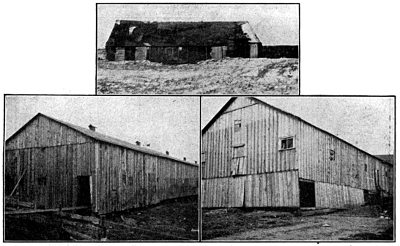
DISEASE-INCUBATORS.
Some Pittsburgh cow-stables which lower the standards set by
progressive producers.
We are prone, in this country, to study the public health too much
in terms of death rates, and too little in the character of the
survivors. Applying this latter test to the children of Pittsburgh's
slums, we shall find cause to [Pg 945]wonder whether, in a sense, the deaths
are not too few rather than too many. Would it not be better for the
unfortunate and innocent victims themselves, and certainly for the
community at large, that this puny, helpless breed of hunger, filth,
and misery which creeps about the city's man-made jungles, should
succumb in infancy to the conditions that bred but cannot support
them? For there are certain phases of existence in which a high death
rate is less to be feared than a high birth rate. Anti-race-suicide
has a fine, rotund ring, as it issues from the presidential lips. But
President Roosevelt has never, I take it, been in Mulberry Alley, or
Our Alley, or a certain unnamed court off Washington street that wafts
its stenches into the boulevard below, or any one of a score of other
hopeless thoroughfares which might give him pause in the promulgation
of his doctrine.
Nor are conditions of life here in the city's choked up center greatly
worse than in the "runs" which diversify the landscape of the newer
parts of the city; damp, heavy-aired, steaming canyons, into which the
poorest classes have been pushed; over the rim, and "off the earth,"
as it were. There they live, pasty women and weazened children, in
the heavy air, polluted, as like as not, by the stenches from the
creeks which are little else but open sewers. One such little isolated
population I found, in a huddle of houses, under a towering steel
bridge, faithfully reproducing, in what was practically open country,
the deadliest living conditions of the crowded center of population.
To return to the central slums, there are whole districts which might
well (were it of any avail) be placarded, as are certain New York flats:
No Room Here For Children.
Settlement workers know the truth about this matter. Here are the words
of one of them:
"Not one child in ten comes to us from the river-bottom section without
a blood or skin disease, usually of long standing. Not one out of ten
comes to us physically up to the normal for his or her age. Worse than
that, few of them are up to the mental standard, and an increasing
percentage are imbecile."
What can a Bureau of Health do to
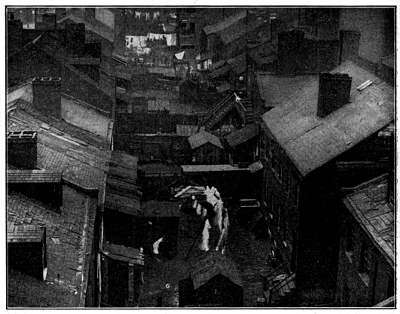
(By permission of the Pittsburgh Bureau of Health).
WHERE HUMAN LIFE IS CHEAP.
[Pg 946] alleviate such a status? Nothing:
the problem is too big for official solution. Either a sense of
responsibility on the part of the mill owner toward his employes
who must live near the mills will start a housing movement that
will do away with the present outrageous rentals for disgraceful
accommodations, or an aroused public conscience will, by one means
or another, make a clean sweep of these pest holes. Or, a third, and
ugly alternative. London's East End is open for the inspection of
travelling Pittsburghers. There they may see in its fullness the crop
of pauperism, dependence, and degeneracy which is bred in the third and
fourth generations, of conditions no worse than their own average, and
not so bad as their own worst.
As an escape from the slum there is the school. Here again Pittsburgh
is in the dark ages of hygiene. Every public school is a law unto
itself. The principal, always a layman, and not unusually an ignorant
one in health matters, decides when a pupil shall be isolated for a
contagious or suspicious ailment. Is it surprising that a short time
ago a certain skin disease infected an entire institution, or that eye
and scalp ailments are often widely diffused among the scholars? From
an inspection of buildings and pupils Dr. Goler draws these conclusions:
The school buildings are in many cases crowded, dark, dirty,
often of three stories, and bad fire risks. The condition of
the children in these schools good and bad, rich and poor,
may be shown by the large proportion having defective teeth,
reduced hearing, imperfect vision. An excessively large number
of them are mouth breathers, partially so because they are
unable to breathe through their noses in the smoky air of
Pittsburgh, and a very considerable number are below stature
for weight of that determined for the average child. In a large
percentage, the defects of teeth, nose and throat, bring them
below the physical normal. These are the children that wear out
in childhood.
[Pg 947]
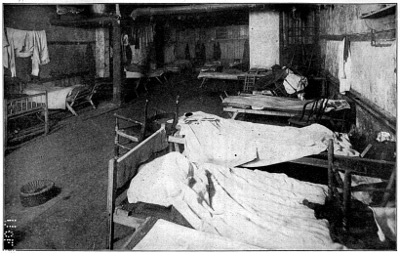
PSEUDO-RELIGIOUS 10-CENT LODGING HOUSE.
In cellar of river-front building; flooded out every year. Dilapidated,
unsanitary and unventilated, this and similar lodging houses were
breeding place of disease. Closed by Bureau of Health, following
investigation and report for Pittsburgh Survey, by James Forbes,
mendicancy expert of the New York Charity Organization Society. A
lodging house code has since been established.
[Pg 948]
In no manner of justice, can the Bureau of Health be held to account
in this matter. In co-operation with the Civic Club, settlements,
physicians and school principals, Dr. Edwards sought to establish a
medical inspection of public schools, such an inspection as would,
for example, undoubtedly have checked almost at its inception the
disastrous onset of measles of last year. But the measure never got
past the legal department of the city administration. In view of the
present conditions in the schools, Dr. Goler's closing and pregnant
suggestion has a special force:
"Ought not the Pittsburgh schools to be closed and the
children repaired?"
Semi-public institutions in Pittsburgh are quite independent of
hygienic control or inspection. This seems to me one of the crying
evils of the present status. Let me give a few examples: An inmate
of an institution for children was infected by another child who had
virulent skin disease and soon afterward he became totally blind. This
was a repetition of a past experience of the same institution in which
a child contracted trachoma within the institution walls, is totally
blind in consequence and a charge upon the state.
Last spring an institution was found in charge of a matron whose
special qualification for her care of very young children was
experience. She had had ten of her own, all of whom died of intestinal
disease and rickets in early childhood. She was feeding the little ones
in her care on coffee and other food suited only to robust grownups.
Every child in a certain charitable institution, a short time ago,
was suffering from skin and scalp disease. Lack of arrangements for
effective isolation, in case of contagious disease, is more common than
provision for isolation. A refuge for fallen women has, naturally,
a large percentage of inmates suffering from venereal disease. The
women of one refuge work in the laundry which gets a certain amount
of outside trade. Among other things it washes towels for a hotel.
Contraction of gonorrhea or syphilis from infected towels or garments
is a well-recognized medical fact. A laundry with infected women on its
working force cannot but be a public peril.
Grim facts are piling up on the records of the Pittsburgh Tuberculosis
Dispensary as to advanced cases of tuberculosis among the little
charges of charitable institutions.
Instances such as these might be multiplied. As in the case of the
public schools the authorities are helpless. Even over the city's
own institution, the Municipal Hospital, the Bureau of Health has no
control. It has been transferred to the Bureau of Charities within the
last year. It receives only contagious diseases, and is too small for
the requirements in time of epidemic, having proper accommodation for
only eighty, with a crowded capacity of 125. Dr. Booth of the Bureau
of Health, who acts as visiting physician by special appointment to
the Bureau of Charities, tells me that up to 1905 the plant was housed
in buildings erected in the seventies. The furnishings were beds and
bedding from the fire and police departments, regarded as being no
longer fit for use by the city's paid servants, and therefore proper
charity for the city's helpless sick. Two years ago, Dr. Booth put
an end to this system by burning the last consignment of furnishings
(for reasons principally entomological); and announcing that he would
admit to the hospital no more equipment, discarded as unfit by the
police and fire forces. Now the plant has its own furnishings. The
building is modern but of an obsolete and unsatisfactory type, and has
not sufficient grounds for its convalescents. All the other hospitals
in the city are private institutions. There is no co-ordination
of hospital work among them, and their distribution is such that
localities where there are the most ambulance calls are without easily
available hospital plants.
To sum up, these are some few of Pittsburgh's immediate needs, if it is
to fight its battle successfully for fewer deaths and a better living
product:
Autonomy of the official health authorities[Pg 949] (preferably a department
of health, not a bureau) under the executive and administrative control
of a physician or sanitarian.
A tuberculosis hospital for advanced cases which are now spreading
infection throughout the city. More visiting nurses and more sanitary
inspectors. Eventually a hospital for the incipient cases that can be
saved.
Municipal collection and disposal of the rubbish which accumulates
everywhere, seriously hampering efforts to make the city hygienically
clean and which must now be removed at private expense.
A general hospital of sufficient size, proper equipment, and adequate
surroundings.
Some reasonable division and co-ordination of effort on the part of the
private hospitals.
Authority to condemn and destroy unsanitary buildings.
Authority to condemn and destroy, upon its entrance to the city,
or upon discovery within the city limits, unclean, infected, or
adulterated milk, and to refuse and revoke milk licenses. Establishment
of a standard for milk.
Medical inspection of schools and school children.
Medical and sanitary inspection of hospitals, and of all public or
semi-public chartered institutions.
These authorizations to be embodied in a city code. At present the
health officials work almost wholly under the state law.
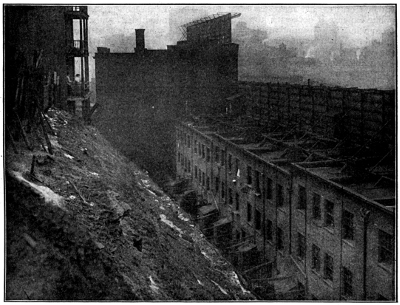
GERM HATCHERIES. THESE FRONT ON THE GRANT BOULEVARD.
What is Pittsburgh going to do about it? Though the foregoing rather
general survey may suggest pessimistically "the little done, the
undone vast," yet there is not lacking, in the view, definite promise
as well as progress. Many and diverse agencies are helping the cause.
The monthly reports of the bureau keep a public, which has for years
been in a [Pg 950]state of Egyptian darkness as to the how and wherefore
of its mortality, fully informed. A Civic Improvement Commission has
been appointed by Mayor Guthrie, one of the sub-committees of which
will deal with needed hygienic reforms. The Chamber of Commerce has
appointed a special committee to co-operate with the Health Bureau for
the betterment of housing conditions, and another to aid in improving
the milk supply. For the protection of the communities downstream, a
sewage disposal plant has been voted; and badly needed it is, as is
shown by the fact that, at the present writing, two thousand people
are ill in the suburb of Bellevue, from drinking water polluted
by Pittsburgh's sewage. The Allegheny County Medical Society has
constituted a committee on public instruction in health matters; also
a milk commission. The Tuberculosis Commission will soon be in the
field with its broad campaign. Municipally there has been an important
step forward in the establishment of a disinfection corps which
sterilizes and makes safe, at the public expense if necessary, the
premises from which a consumptive has been removed. Anti-tuberculosis
education by the various corps of visiting nurses is extending into
every corner of the city that harbors a dangerous consumptive. The
state school commission has recommended medical inspection of schools.
City ordinances providing for milk standards, and rubbish disposal,
are in prospect. The Bureau of Health, only a short time ago a rusted
and ineffectual machine fed by incompetents from other departments,
has, under its new head, developed an esprit de corps, and is now
welded into a compact, dependable organization. And this organization
will constantly have a supply of better trained men to draw upon, since
the University of Pittsburgh and the Carnegie Technical Schools have,
at Dr. Edwards's suggestion, arranged for special courses in sanitary
engineering and practical hygiene.
Yes; Pittsburgh is awake to the needs of the situation. But the
true test is yet to come. Thus far it has been but the laying out
of the lines of battle and a few preliminary, and, on the whole,
victorious skirmishes. For when hygienic and sanitary reform impinges,
in its advance, as it needs must, upon the private purse of some,
the political purposes of others, and the industrial and commercial
license of the whole, then will come the tug of war. Then, according as
shortsighted selfishness shall prevail over, or succumb to, civic pride
and patriotism, the victory will be to the germ or to the city.
[Pg 951]
[Pg 952]
Life Insurance satisfies the conscience, eases the mind, banishes worry
and gives old age a chair of contentment.
Metropolitan Policies are the Standards of Life Insurance Excellence
Metropolitan Life Insurance Company
1 MADISON AVENUE, NEW YORK
(Incorporated by the State of New York. Stock Company.)
TYRREL PRINT, NEW YORK.
[Pg 953]
IT IS SUMMER IN
California, Arizona, Mexico,
Texas, Louisiana,
You can
Motor, Drive, Ride, Fish, Hunt, Bathe, Climb, Coach, Canoe, Yacht, Golf,
Every Day in the Year
Points in these States best reached via the
Southern Pacific Sunset Route
THE NATURAL WINTER GATEWAY
THE OPEN WINDOW ROUTE
Rock-Ballast Roadbed—Automatic Block Signals—Oil-Burning
Locomotives—Superior Equipment.
Ten days' Stopover at New Orleans on all Tickets.
For free illustrated pamphlet address: L. H. NUTTING, G. E. P. A.,
349 Broadway, New York, or Southern Pacific Agent at
CHICAGO,
120 Jackson Blvd. |
NEW ORLEANS,
Magazine St. |
BOSTON,
170 Washington St. |
PHILADELPHIA,
632 Chestnut St. |
|
SYRACUSE,
212 W. Washington St. |
BALTIMORE,
29 W. Baltimore St. |
Please mention Charities and The Commons when writing to
advertisers.
Transcriber's Notes:
Simple spelling, grammar, and typographical errors were
corrected.
Multiple underscores indicate a long gap in the sentence.
End of the Project Gutenberg EBook of Charities and the Commons: The
Pittsburgh Survey, Part II: The Place, by Various
*** END OF THIS PROJECT GUTENBERG EBOOK CHARITIES AND THE COMMONS ***
***** This file should be named 46025-h.htm or 46025-h.zip *****
This and all associated files of various formats will be found in:
http://www.gutenberg.org/4/6/0/2/46025/
Produced by Richard Tonsing, Barbara Tozier, Bill Tozier
and the Online Distributed Proofreading Team at
http://www.pgdp.net
Updated editions will replace the previous one--the old editions
will be renamed.
Creating the works from public domain print editions means that no
one owns a United States copyright in these works, so the Foundation
(and you!) can copy and distribute it in the United States without
permission and without paying copyright royalties. Special rules,
set forth in the General Terms of Use part of this license, apply to
copying and distributing Project Gutenberg-tm electronic works to
protect the PROJECT GUTENBERG-tm concept and trademark. Project
Gutenberg is a registered trademark, and may not be used if you
charge for the eBooks, unless you receive specific permission. If you
do not charge anything for copies of this eBook, complying with the
rules is very easy. You may use this eBook for nearly any purpose
such as creation of derivative works, reports, performances and
research. They may be modified and printed and given away--you may do
practically ANYTHING with public domain eBooks. Redistribution is
subject to the trademark license, especially commercial
redistribution.
*** START: FULL LICENSE ***
THE FULL PROJECT GUTENBERG LICENSE
PLEASE READ THIS BEFORE YOU DISTRIBUTE OR USE THIS WORK
To protect the Project Gutenberg-tm mission of promoting the free
distribution of electronic works, by using or distributing this work
(or any other work associated in any way with the phrase "Project
Gutenberg"), you agree to comply with all the terms of the Full Project
Gutenberg-tm License (available with this file or online at
http://gutenberg.org/license).
Section 1. General Terms of Use and Redistributing Project Gutenberg-tm
electronic works
1.A. By reading or using any part of this Project Gutenberg-tm
electronic work, you indicate that you have read, understand, agree to
and accept all the terms of this license and intellectual property
(trademark/copyright) agreement. If you do not agree to abide by all
the terms of this agreement, you must cease using and return or destroy
all copies of Project Gutenberg-tm electronic works in your possession.
If you paid a fee for obtaining a copy of or access to a Project
Gutenberg-tm electronic work and you do not agree to be bound by the
terms of this agreement, you may obtain a refund from the person or
entity to whom you paid the fee as set forth in paragraph 1.E.8.
1.B. "Project Gutenberg" is a registered trademark. It may only be
used on or associated in any way with an electronic work by people who
agree to be bound by the terms of this agreement. There are a few
things that you can do with most Project Gutenberg-tm electronic works
even without complying with the full terms of this agreement. See
paragraph 1.C below. There are a lot of things you can do with Project
Gutenberg-tm electronic works if you follow the terms of this agreement
and help preserve free future access to Project Gutenberg-tm electronic
works. See paragraph 1.E below.
1.C. The Project Gutenberg Literary Archive Foundation ("the Foundation"
or PGLAF), owns a compilation copyright in the collection of Project
Gutenberg-tm electronic works. Nearly all the individual works in the
collection are in the public domain in the United States. If an
individual work is in the public domain in the United States and you are
located in the United States, we do not claim a right to prevent you from
copying, distributing, performing, displaying or creating derivative
works based on the work as long as all references to Project Gutenberg
are removed. Of course, we hope that you will support the Project
Gutenberg-tm mission of promoting free access to electronic works by
freely sharing Project Gutenberg-tm works in compliance with the terms of
this agreement for keeping the Project Gutenberg-tm name associated with
the work. You can easily comply with the terms of this agreement by
keeping this work in the same format with its attached full Project
Gutenberg-tm License when you share it without charge with others.
1.D. The copyright laws of the place where you are located also govern
what you can do with this work. Copyright laws in most countries are in
a constant state of change. If you are outside the United States, check
the laws of your country in addition to the terms of this agreement
before downloading, copying, displaying, performing, distributing or
creating derivative works based on this work or any other Project
Gutenberg-tm work. The Foundation makes no representations concerning
the copyright status of any work in any country outside the United
States.
1.E. Unless you have removed all references to Project Gutenberg:
1.E.1. The following sentence, with active links to, or other immediate
access to, the full Project Gutenberg-tm License must appear prominently
whenever any copy of a Project Gutenberg-tm work (any work on which the
phrase "Project Gutenberg" appears, or with which the phrase "Project
Gutenberg" is associated) is accessed, displayed, performed, viewed,
copied or distributed:
This eBook is for the use of anyone anywhere at no cost and with
almost no restrictions whatsoever. You may copy it, give it away or
re-use it under the terms of the Project Gutenberg License included
with this eBook or online at www.gutenberg.org/license
1.E.2. If an individual Project Gutenberg-tm electronic work is derived
from the public domain (does not contain a notice indicating that it is
posted with permission of the copyright holder), the work can be copied
and distributed to anyone in the United States without paying any fees
or charges. If you are redistributing or providing access to a work
with the phrase "Project Gutenberg" associated with or appearing on the
work, you must comply either with the requirements of paragraphs 1.E.1
through 1.E.7 or obtain permission for the use of the work and the
Project Gutenberg-tm trademark as set forth in paragraphs 1.E.8 or
1.E.9.
1.E.3. If an individual Project Gutenberg-tm electronic work is posted
with the permission of the copyright holder, your use and distribution
must comply with both paragraphs 1.E.1 through 1.E.7 and any additional
terms imposed by the copyright holder. Additional terms will be linked
to the Project Gutenberg-tm License for all works posted with the
permission of the copyright holder found at the beginning of this work.
1.E.4. Do not unlink or detach or remove the full Project Gutenberg-tm
License terms from this work, or any files containing a part of this
work or any other work associated with Project Gutenberg-tm.
1.E.5. Do not copy, display, perform, distribute or redistribute this
electronic work, or any part of this electronic work, without
prominently displaying the sentence set forth in paragraph 1.E.1 with
active links or immediate access to the full terms of the Project
Gutenberg-tm License.
1.E.6. You may convert to and distribute this work in any binary,
compressed, marked up, nonproprietary or proprietary form, including any
word processing or hypertext form. However, if you provide access to or
distribute copies of a Project Gutenberg-tm work in a format other than
"Plain Vanilla ASCII" or other format used in the official version
posted on the official Project Gutenberg-tm web site (www.gutenberg.org),
you must, at no additional cost, fee or expense to the user, provide a
copy, a means of exporting a copy, or a means of obtaining a copy upon
request, of the work in its original "Plain Vanilla ASCII" or other
form. Any alternate format must include the full Project Gutenberg-tm
License as specified in paragraph 1.E.1.
1.E.7. Do not charge a fee for access to, viewing, displaying,
performing, copying or distributing any Project Gutenberg-tm works
unless you comply with paragraph 1.E.8 or 1.E.9.
1.E.8. You may charge a reasonable fee for copies of or providing
access to or distributing Project Gutenberg-tm electronic works provided
that
- You pay a royalty fee of 20% of the gross profits you derive from
the use of Project Gutenberg-tm works calculated using the method
you already use to calculate your applicable taxes. The fee is
owed to the owner of the Project Gutenberg-tm trademark, but he
has agreed to donate royalties under this paragraph to the
Project Gutenberg Literary Archive Foundation. Royalty payments
must be paid within 60 days following each date on which you
prepare (or are legally required to prepare) your periodic tax
returns. Royalty payments should be clearly marked as such and
sent to the Project Gutenberg Literary Archive Foundation at the
address specified in Section 4, "Information about donations to
the Project Gutenberg Literary Archive Foundation."
- You provide a full refund of any money paid by a user who notifies
you in writing (or by e-mail) within 30 days of receipt that s/he
does not agree to the terms of the full Project Gutenberg-tm
License. You must require such a user to return or
destroy all copies of the works possessed in a physical medium
and discontinue all use of and all access to other copies of
Project Gutenberg-tm works.
- You provide, in accordance with paragraph 1.F.3, a full refund of any
money paid for a work or a replacement copy, if a defect in the
electronic work is discovered and reported to you within 90 days
of receipt of the work.
- You comply with all other terms of this agreement for free
distribution of Project Gutenberg-tm works.
1.E.9. If you wish to charge a fee or distribute a Project Gutenberg-tm
electronic work or group of works on different terms than are set
forth in this agreement, you must obtain permission in writing from
both the Project Gutenberg Literary Archive Foundation and Michael
Hart, the owner of the Project Gutenberg-tm trademark. Contact the
Foundation as set forth in Section 3 below.
1.F.
1.F.1. Project Gutenberg volunteers and employees expend considerable
effort to identify, do copyright research on, transcribe and proofread
public domain works in creating the Project Gutenberg-tm
collection. Despite these efforts, Project Gutenberg-tm electronic
works, and the medium on which they may be stored, may contain
"Defects," such as, but not limited to, incomplete, inaccurate or
corrupt data, transcription errors, a copyright or other intellectual
property infringement, a defective or damaged disk or other medium, a
computer virus, or computer codes that damage or cannot be read by
your equipment.
1.F.2. LIMITED WARRANTY, DISCLAIMER OF DAMAGES - Except for the "Right
of Replacement or Refund" described in paragraph 1.F.3, the Project
Gutenberg Literary Archive Foundation, the owner of the Project
Gutenberg-tm trademark, and any other party distributing a Project
Gutenberg-tm electronic work under this agreement, disclaim all
liability to you for damages, costs and expenses, including legal
fees. YOU AGREE THAT YOU HAVE NO REMEDIES FOR NEGLIGENCE, STRICT
LIABILITY, BREACH OF WARRANTY OR BREACH OF CONTRACT EXCEPT THOSE
PROVIDED IN PARAGRAPH 1.F.3. YOU AGREE THAT THE FOUNDATION, THE
TRADEMARK OWNER, AND ANY DISTRIBUTOR UNDER THIS AGREEMENT WILL NOT BE
LIABLE TO YOU FOR ACTUAL, DIRECT, INDIRECT, CONSEQUENTIAL, PUNITIVE OR
INCIDENTAL DAMAGES EVEN IF YOU GIVE NOTICE OF THE POSSIBILITY OF SUCH
DAMAGE.
1.F.3. LIMITED RIGHT OF REPLACEMENT OR REFUND - If you discover a
defect in this electronic work within 90 days of receiving it, you can
receive a refund of the money (if any) you paid for it by sending a
written explanation to the person you received the work from. If you
received the work on a physical medium, you must return the medium with
your written explanation. The person or entity that provided you with
the defective work may elect to provide a replacement copy in lieu of a
refund. If you received the work electronically, the person or entity
providing it to you may choose to give you a second opportunity to
receive the work electronically in lieu of a refund. If the second copy
is also defective, you may demand a refund in writing without further
opportunities to fix the problem.
1.F.4. Except for the limited right of replacement or refund set forth
in paragraph 1.F.3, this work is provided to you 'AS-IS' WITH NO OTHER
WARRANTIES OF ANY KIND, EXPRESS OR IMPLIED, INCLUDING BUT NOT LIMITED TO
WARRANTIES OF MERCHANTABILITY OR FITNESS FOR ANY PURPOSE.
1.F.5. Some states do not allow disclaimers of certain implied
warranties or the exclusion or limitation of certain types of damages.
If any disclaimer or limitation set forth in this agreement violates the
law of the state applicable to this agreement, the agreement shall be
interpreted to make the maximum disclaimer or limitation permitted by
the applicable state law. The invalidity or unenforceability of any
provision of this agreement shall not void the remaining provisions.
1.F.6. INDEMNITY - You agree to indemnify and hold the Foundation, the
trademark owner, any agent or employee of the Foundation, anyone
providing copies of Project Gutenberg-tm electronic works in accordance
with this agreement, and any volunteers associated with the production,
promotion and distribution of Project Gutenberg-tm electronic works,
harmless from all liability, costs and expenses, including legal fees,
that arise directly or indirectly from any of the following which you do
or cause to occur: (a) distribution of this or any Project Gutenberg-tm
work, (b) alteration, modification, or additions or deletions to any
Project Gutenberg-tm work, and (c) any Defect you cause.
Section 2. Information about the Mission of Project Gutenberg-tm
Project Gutenberg-tm is synonymous with the free distribution of
electronic works in formats readable by the widest variety of computers
including obsolete, old, middle-aged and new computers. It exists
because of the efforts of hundreds of volunteers and donations from
people in all walks of life.
Volunteers and financial support to provide volunteers with the
assistance they need, are critical to reaching Project Gutenberg-tm's
goals and ensuring that the Project Gutenberg-tm collection will
remain freely available for generations to come. In 2001, the Project
Gutenberg Literary Archive Foundation was created to provide a secure
and permanent future for Project Gutenberg-tm and future generations.
To learn more about the Project Gutenberg Literary Archive Foundation
and how your efforts and donations can help, see Sections 3 and 4
and the Foundation web page at http://www.pglaf.org.
Section 3. Information about the Project Gutenberg Literary Archive
Foundation
The Project Gutenberg Literary Archive Foundation is a non profit
501(c)(3) educational corporation organized under the laws of the
state of Mississippi and granted tax exempt status by the Internal
Revenue Service. The Foundation's EIN or federal tax identification
number is 64-6221541. Its 501(c)(3) letter is posted at
http://pglaf.org/fundraising. Contributions to the Project Gutenberg
Literary Archive Foundation are tax deductible to the full extent
permitted by U.S. federal laws and your state's laws.
The Foundation's principal office is located at 4557 Melan Dr. S.
Fairbanks, AK, 99712., but its volunteers and employees are scattered
throughout numerous locations. Its business office is located at
809 North 1500 West, Salt Lake City, UT 84116, (801) 596-1887, email
business@pglaf.org. Email contact links and up to date contact
information can be found at the Foundation's web site and official
page at http://pglaf.org
For additional contact information:
Dr. Gregory B. Newby
Chief Executive and Director
gbnewby@pglaf.org
Section 4. Information about Donations to the Project Gutenberg
Literary Archive Foundation
Project Gutenberg-tm depends upon and cannot survive without wide
spread public support and donations to carry out its mission of
increasing the number of public domain and licensed works that can be
freely distributed in machine readable form accessible by the widest
array of equipment including outdated equipment. Many small donations
($1 to $5,000) are particularly important to maintaining tax exempt
status with the IRS.
The Foundation is committed to complying with the laws regulating
charities and charitable donations in all 50 states of the United
States. Compliance requirements are not uniform and it takes a
considerable effort, much paperwork and many fees to meet and keep up
with these requirements. We do not solicit donations in locations
where we have not received written confirmation of compliance. To
SEND DONATIONS or determine the status of compliance for any
particular state visit http://pglaf.org
While we cannot and do not solicit contributions from states where we
have not met the solicitation requirements, we know of no prohibition
against accepting unsolicited donations from donors in such states who
approach us with offers to donate.
International donations are gratefully accepted, but we cannot make
any statements concerning tax treatment of donations received from
outside the United States. U.S. laws alone swamp our small staff.
Please check the Project Gutenberg Web pages for current donation
methods and addresses. Donations are accepted in a number of other
ways including checks, online payments and credit card donations.
To donate, please visit: http://pglaf.org/donate
Section 5. General Information About Project Gutenberg-tm electronic
works.
Professor Michael S. Hart is the originator of the Project Gutenberg-tm
concept of a library of electronic works that could be freely shared
with anyone. For thirty years, he produced and distributed Project
Gutenberg-tm eBooks with only a loose network of volunteer support.
Project Gutenberg-tm eBooks are often created from several printed
editions, all of which are confirmed as Public Domain in the U.S.
unless a copyright notice is included. Thus, we do not necessarily
keep eBooks in compliance with any particular paper edition.
Most people start at our Web site which has the main PG search facility:
http://www.gutenberg.org
This Web site includes information about Project Gutenberg-tm,
including how to make donations to the Project Gutenberg Literary
Archive Foundation, how to help produce our new eBooks, and how to
subscribe to our email newsletter to hear about new eBooks.
